70025 WESTERN STAR - 70026 POLAR STAR - 70027 RISING STAR - 70028 ROYAL STAR - 70029 SHOOTING STAR - 70030 WILLIAM WORDSWORTH - 70031 BYRON - 70032 TENNYSON - 70033 CHARLES DICKENS - 70034 THOMAS HARDY - 70035 RUDYARD KIPLING - 7003 BOADICEA - 70037 HEREWARD THE WAKE - 70038 ROBIN HOOD - 70039 SIR CHRISTOPHER WREN - 70040 CLIVE OF INDIA - 70041 SIR JOHN MOORE - 70042 LORD ROBERTS - 70043 LORD KITCHENER - 70044 EARL HAIG - 70045 LORD ROWALLAN - 70046 ANZAC - 70047 - 70048 THE TERRITORIAL ARMY 1908-1958 - 70049 SOLWAY FIRTH - 70050 FIRTH OF CLYDE - 70051 FIRTH OF FORTH - 70052 FIRTH OF TAY - 70053 MORAY FIRTH and 70054 DORNOCH FIRTH...
I'm blown away by the level of support from fellow rail enthusiasts in building this site. Their willingness to participate in its construction with no prospect of financial gain, just the satisfaction of being involved, is bloody marvellous.
 Starting in May 2013, Derek's input has been a massive undertaking and there have been times when the pair of us - just two bungling old geezers with a mutual love for trains and railways - were on our arthritic knees by the sheer size of it all.
Starting in May 2013, Derek's input has been a massive undertaking and there have been times when the pair of us - just two bungling old geezers with a mutual love for trains and railways - were on our arthritic knees by the sheer size of it all. And now here we are with three finished pages…or are they?
The interest shown by modellers has spurred Derek to suggest a series of articles on the 'Britannias' that will be of particular interest to model makers...
Watch this space!
 Since taking early retirement, Derek's knowledge of all things power-driven led him to making a start on correcting the many anomalies he found in books and magazines regarding the BR Class 7MT Britannias. Derek's research has taken him more than 6 years and his findings now run into three page on this site. This is in complete contrast to his original reservations. He commented - 'Whilst the first group of Britannias Nos 70000-70024 are indeed very interesting, and in some cases diverse, the history of the final batch of engines Nos 70045-70054 is somewhat mundane by comparison, and so whilst I feel confident of filling a page with information on the first batch it would be tricky to give the same result for the remaining engines. This is because the list of modifications diminished as they were put into the
Since taking early retirement, Derek's knowledge of all things power-driven led him to making a start on correcting the many anomalies he found in books and magazines regarding the BR Class 7MT Britannias. Derek's research has taken him more than 6 years and his findings now run into three page on this site. This is in complete contrast to his original reservations. He commented - 'Whilst the first group of Britannias Nos 70000-70024 are indeed very interesting, and in some cases diverse, the history of the final batch of engines Nos 70045-70054 is somewhat mundane by comparison, and so whilst I feel confident of filling a page with information on the first batch it would be tricky to give the same result for the remaining engines. This is because the list of modifications diminished as they were put into the  building programme and only half of these changes were required on later batches. Nevertheless there are many more photos of these later builds, primarily because enthusiasts began to realise that extinction was on the horizon, so perhaps the additional photos will remedy the imbalance...'
building programme and only half of these changes were required on later batches. Nevertheless there are many more photos of these later builds, primarily because enthusiasts began to realise that extinction was on the horizon, so perhaps the additional photos will remedy the imbalance...' Well, Derek made a very valid point and I take my hat off to him for undertaking the task. I'm sure his meticulous research will become a valuable source of reference on the Internet...
For the benefit of the first-time visitor perhaps a brief summary of the introduction of the BR Standard Class 7 Pacifiic locomotives is the best way to start...
 Upon nationalisation of the 'Big Four' railway companies in 1948, the Railway Executive of the British Transport Commission (BTC) announced its preference for developing future steam motive power rather than dabbling with unproven diesel traction. This led to the Locomotive Interchange Trials of 1948, supervised by RA Riddles, then member of the BTC's Railway Executive, who, along with ES Cox was responsible for the design and construction of twelve new classes to be numbered in the 70-80,000s and 92,000s in the fleet.
Upon nationalisation of the 'Big Four' railway companies in 1948, the Railway Executive of the British Transport Commission (BTC) announced its preference for developing future steam motive power rather than dabbling with unproven diesel traction. This led to the Locomotive Interchange Trials of 1948, supervised by RA Riddles, then member of the BTC's Railway Executive, who, along with ES Cox was responsible for the design and construction of twelve new classes to be numbered in the 70-80,000s and 92,000s in the fleet. In 1951, the 'Britannia' Class 7MT Pacific became the first of twelve new British Railways Standard types to appear. Designed at Derby and built at Crewe, with sections designed at Brighton, Doncaster and Swindon, the basic ethos was simplicity in construction, lower coal consumption, and longer mileage between classified repairs. The following is a step-by-step account of the 55 locomotives in the class as follows: 1st batch: 70000-70024, constructed between January and October, 1951; 2nd batch: 70025-70044, constructed between September 1952 and October 1953, and the 3rd batch: 70045-70054, constructed in 1954.
(Below) Derek's in-depth analysis of the BR Class 7 'Britannias' includes a description of the various modifications carried out on each locomotive during their careers; to assist visitors identify the sections described this 'click-on' numbered guide is inserted at several points in the text down the page.

Built at Crewe, completed 15th September 1952 to Order No E483/228 Lot No Swindon 403. Withdrawn 23rd December 1967. Stored at Kingmoor, cut up at GH Campbell of Airdrie, January 1968.
ALLOCATIONS: Firstly to Cardiff Canton (86C), except that she did not arrive there; instead she went to Rugby Testing Station, and remained there until well into 1953, which was said to be May 1953. After a long stint at Cardiff, 70025 moved across to Aston MPD (21D) in the Birmingham area, during September 1961, and joining up with 8 other Britannias there, 6 of them also from the Western Region, and all making the move at the same time. The next move for 'Western Star' was to Crewe North MPD (5A), dated May 1963, arriving at the same time as 70000 'Britannia', no less, and after a stay of just over two years, she moved again, going to Crewe South (5B) in June 1965, then on to Llandudno Junction (6G) at the end of February 1966. This move proved to be very short indeed (8 weeks only) because she was back at Crewe South (5B) in April 1966, and in no time at all she was moving again, on to her final resting place, Carlisle Kingmoor (12A), being dated in September 1966.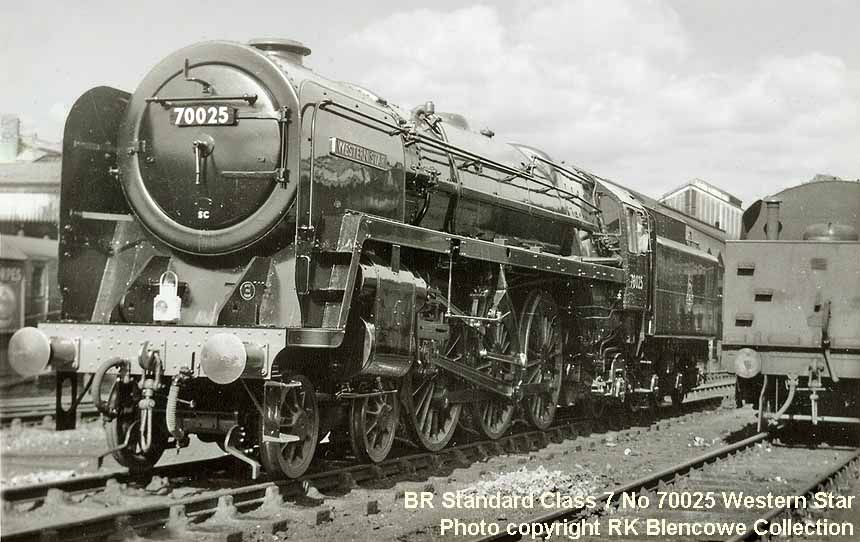
(Above) 70025 Western Star looks a vision of loveliness at Crewe Works in September 1952; a freshly-finished and highly varnished ready-for-the-road 'Britannia' 4-6-2 Pacific. 70025 was destined for the Western Region, but her arrival was delayed due to a spell spent at Rugby Testing Station (as mentioned above); the loco was completed just under a year after 70024 due to steel shortages. Built with Western Region lamp irons (item 2): two raised sand box lids (item 16) on each side: Western Region Automatic Train Control equipment (item 20), with Battery Box and relevant pipework: front regulator rod support bracket (item 5) and plain Coupling Rods (item 14) which was part of the Axle modifications. As can be seen from the photograph 70025 was constructed without a tender step (item 10) and without the little cover plate to the mechanical lubrication unit (item 18); also the flexible cab sheets (item 9) were not thought to be a requirement as yet.
(Below) Measuring 47" long, with the front repainted though unpolished, a nameplate from BR Standard Class 7 Britannia 4-6-2 No 70025 Western Star went under the hammer for £10,800 at a Great Central Railwayana Auction on 11 October 2014. The 'Western Star' name was previously carried by a GWR Broad Gauge engine and later by a Star Class 4-6-0. No 70025 went new to Rugby Testing Plant on 13 September 1952 and its first shed in May 1953 was Cardiff Canton where it remained for eight years. Its later sheds were Aston, Crewe North, Crewe South, Llandudno Junction and Kingmoor from where it was withdrawn during the week ending 3 December 1967 and sold for scrap to Campbells at Airdrie. Click HERE to visit the excellent GCRA website which contains details of forthcoming auctions and results of past auctions.

MODIFICATIONS: 70025 was completed almost 12 months after 70024 'Vulcan'; this delay was due to an acute shortage of steel following on from World War 2, however this interim period gave the Works an opportunity to apply the modifications found to be necessary during the service period of the earlier engines. These amounted to 6 items: item 6 - the low dome of the boiler (which was only applied to Nos. 70000 to 70006 anyway); item 21 - the front vacuum pipe was shortened (from 70019 onwards); item 17 - the hollow axles were treated and the wheel bearings seated correctly; item 16 - the sand box lids were raised from new; item 8 - the reverser recuperating spring was contained from new; item 5 - the steady bracket was fitted to the forward rod of the regulator from new. Early in 1953 the tender step (item 10) was added, this gave added security to the fireman when adding water to the tank, also the flexible screen (item 9) was fitted at this time, helping to prevent draughts at the back of the cab.
At this juncture I should mention that the tender step (item 10) fitted to 70025 was of the LMR type (reference to above notes) and not, as might be expected, the Western Region (ie Swindon) variety, which had more support in the centre of the step than Crewe's version, ie support at either end only. These were seen to change from time to time or, at least, the tenders were changed when going through Works, although 'Western Star' did manage to keep the LMR type step all the way through its service history..
(Below) Seen at Preston Station, 70025 (ex-Western Star) is brewing up nicely on a cold damp day in December 1965 and, having just left Crewe Works, she will be up to the task in front of her with an 'up express - and NOT a 'down' train as described in the original caption. My thanks to Arthus Missira for pointing out the error. Worthy of note is the large reservoir on the boiler walkway, which was part of the AWS equipment (item 20) fitted just three years earlier.
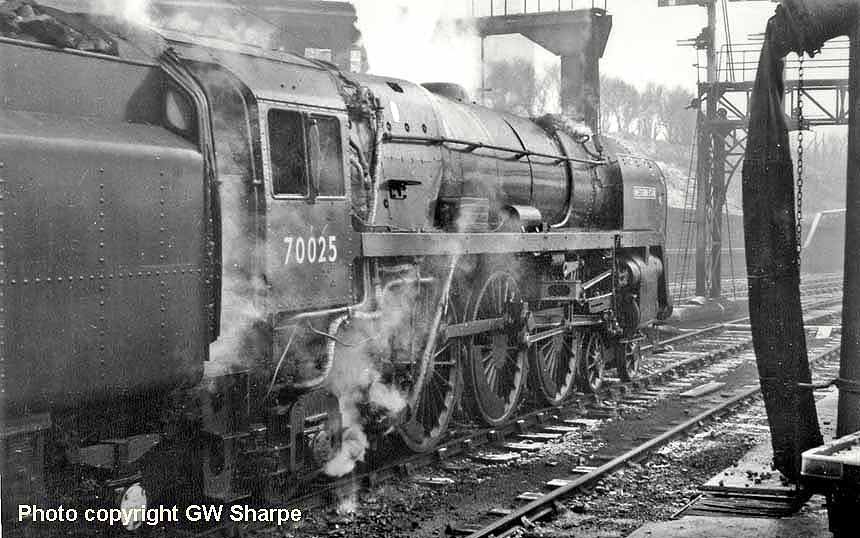
70025 had no more modifications done until going into Swindon Works at the end of April 1957 for a General Overhaul, which is reported to have taken 6 months to complete. During this time, the boiler was lifted, the Smoke Deflectors (item 3) were modified to Swindon specifications (six handholds, brass lined), the front step (item 1) updated, the new British Railways logo (item 11) was applied to the tender, and the
 Exhaust Ejector (item 4) was fitted with a solenoid valve, and repositioned lower down on the boiler, to try to improve the steaming of the locomotive, as Swindon viewed the situation at the time.
Exhaust Ejector (item 4) was fitted with a solenoid valve, and repositioned lower down on the boiler, to try to improve the steaming of the locomotive, as Swindon viewed the situation at the time. When transferred away from the Western Region all the locos, including 70025, had the solenoid valve removed, but the Exhaust Ejector unit (item 4) was left in situ, and in most cases, remained so. Likewise, the ATC (Automatic Train Control) (item 20) and its relative parts were removed, but 70025 had the BR version, the AWS (item 20), fitted at Crewe at the end of 1962. It transpired that a total of 14 Britannias did not have the AWS equipment fitted, and of these, 12 were ex-Western engines, also 70025 did not have a speedometer (item 13) fitted, not ever, and was one of 14 locos that was not so equipped, showing yet again how non-standard the Britannias had become. All the Britannia class locomotives were built with a LNER type Return Crank (item 15), and 70025 did manage to retain hers right to the end, thus becoming only one of 7 to do the same, whereas all of the other 48 engines lost theirs in preference to the LMS version, this being easy to spot, because the crank was affixed with 4 bolts.
The reason for the change from the original to the LMS type was that cracks were said to appear in the former, and with at least 2 locomotives the original was modified, then the LMS type was changed back to the LNER version of the return crank, but more of that later. A large proportion of the class were receiving speedometers (item 13) between 1960 and 1962, even though they had appeared on new builds in 1954, but 70025 was one the 12 engines that failed to receive one, and, rather oddly, 10 of these were previously Western engines. Up to the end of 1963, not too much had changed visually on 'Western Star' since its major overhaul at the end of 1957, she kept the plain coupling rods (item 14) right to the end, the support bracket (item 7) on the regulator rear rodding had been fitted in December 1962, the lamp irons (item 2) on the buffer beam had been changed to LMR type, from the WR version, although the top iron was still the side-on bracket that was fitted when built in 1952. When seen in 1964, 70025 would have lost her lining to the paintwork (item 12), but was still sporting her nameplates, for most of this year, at least, whilst on the offside running plate a rather large reservoir had been fitted, which was part of the AWS system equipment (item 20), and was in addition to the usual battery box on that side. During the following year, the nameplates were removed, the lamp irons (item 2) were repositioned, and the lubrication operating rods (item 18) had been shortened, giving more oil to the cylinders and valves via the (GWR) mechanical lubricators, positioned just below the running plate.
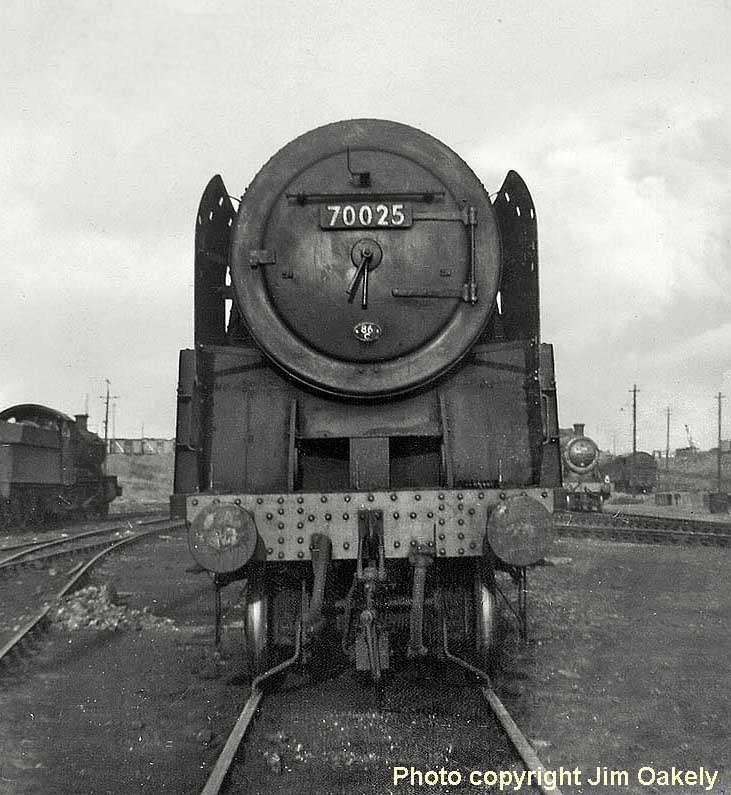
(Above) 70025 'Western Star' is captured by Jim Oakley in the yard at Cardiff Canton MPD (86C), and obviously in a dire state externally, which is a very long way from her usual condition. But these are troubled times for the Britannias, as the GWR Kings have been transferred to the Welsh Capital, dated from September 1960, and they were only allowed to travel eastwards, so they were soon taking over the London trains, such as 'The Red Dragon', whereas the Pacifics would be used from Swansea, and sometimes the Kensington Milk train over to Whitland. 70025 is stationed on one of the 4 'dead' roads to the east of the turntable, and is flanked by what appears to be 2 moguls; the engine to the left is on one of the two 'live' roads coming on to turn around; the Main Line is to the right; the wagons to the left would be pushed onto the coal stage in due course for disposal. Date is 11th September 1960.
SIGHTINGS: 70025 'Western Star' was first seen, apart from Crewe Works itself, at Rugby Testing Station for steaming capability tests, which were carried out between 31st October 1952 and the 20th February 1953, giving a grand total of 79 test runs, and also making a brief television appearance. From Cardiff Canton she was soon put to work on the regular trips to London Paddington, and was seen at Paddington Station, dated July 1953 on a return train to South Wales, with a headcode '169', and as clean as ever. 70025 was also used on the, so called West and North trains, being seen on a Swansea to Manchester express at Pengam in South Wales, dated June 1953. A brief return to Rugby Testing Station was made from 25th to 27th November 1953 for 5 more runs on the rollers, and then it was back to the likes of 'The Red Dragon' and the 'Pembroke Coast Express'. She was also viewed at Severn Tunnel Junction Station on a West to North passenger express service, dated May 1958, but was not seen to be in her usual tip-top condition, as was the case, when seen at Paddington, leaving for South Wales, dated August 1959, her paintwork was decidedly 'work-stained'. After the arrival of 6 GWR 'King' class at Cardiff Canton MPD in September 1960, the Britannias were eased off some express trains, and 'The Red Dragon' service became a regular King duty, and with this in mind 70025 could be seen on a train going west of Cardiff, to Swansea, or on the 'Kensington Milk' duty, which terminated at Whitland, and the engine would return with the Milford Haven fish train. This was also the case when engines were due for 'shopping', and had high mileages, they could be used on 'C' class trains, or be utilised between Swansea and Cardiff, giving way to another Britannia class, to take the train on to Paddington. After moving on to Aston MPD (21D), in the Birmingham area, her duties would be less taxing, being a mix of passenger turns to Manchester, and North Wales, etc. and parcel trains along the West Coast Main line. 70025 was seen at Abergele, on the North Wales coastline, with a freight train, during June 1963, being shedded at Crewe North MPD (5A) at this time, and looking in very fine condition indeed, contrary to many classmates, as virtually no cleaning was done in the early 1960's, unless the engine was due to haul a special or enthusiasts train. In June 1964, 'Western Star' was espied at Cravens Arms Station hauling a pigeon special on the North and West route, from Heysham, close to Lancaster, in Lancashire, down to Weymouth on the South Coast, and was captured in very poor external condition. Also 70025 was seen at Preston Station, in December 1965, with a train for Glasgow, and now without nameplates, removed for safekeeping, but with well painted substitutes. Generally speaking, during the period 1964 to the end of 1967, the whole Britannia class eked out an existence, with mainly parcel and freight trains, with a sprinkling of passenger turns here and there. One exception to that trend was the sight of 70025 at Oxenholme, storming southwards with a Glasgow to Euston passenger express, having stepped into the breach when the allotted diesel locomotive had failed.
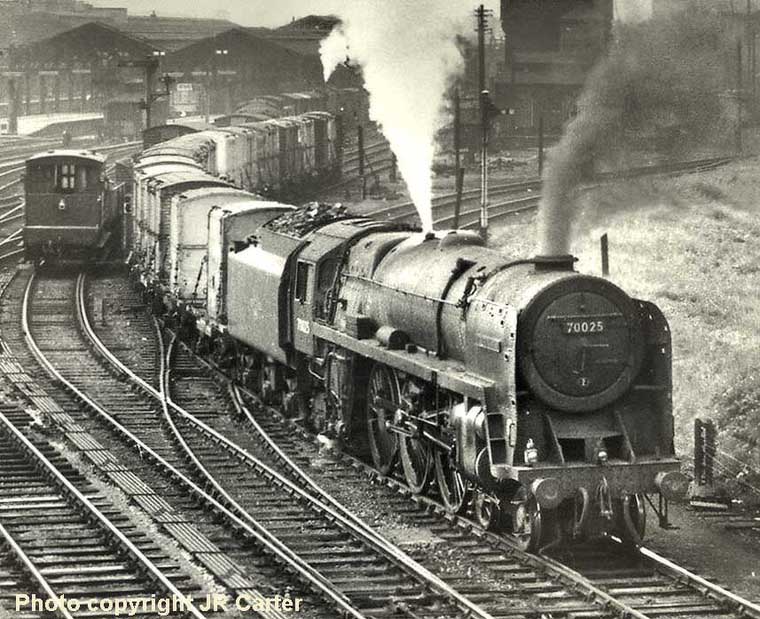
(Above) 70025 was fitted with AWS (Automatic Warning System) as late as December 1962, so this photo at Chester by Jim Carter would be from 1963. The Battery Box (for AWS) and round vacuum reservoir can be seen on the offside running plate. 70025 was the first of the second batch, thus modified in many ways compared to the initial locos of the class; axles, raised dome cover, shorter vacuum pie, support bracket on the regulator front rod, and two raised sand box lids either side now standard.
(Below) Seen at Carlisle Kingmoor on 27th August 1967, 70025 is carrying the power classification '7' over the cabside number; this was generally the only one used, although '7P' was seen on five locos from 1961, and 70004 was seen to sport '7P6F' in 1954 before Crewe duly removed it. There is no lining at all on the cab, or indeed anywhere on the loco, clear signs of austerity. On the left of the image can be seen 3 'horizontal' rods, varying in size and usage; the top one is the leading regulator rodding, leading onto the heat exchanger, between the boiler and smokebox; the middle 'rod' is simply the rear part of the handrail; the lower and largest 'rod' being the reverser, operated by the driver to operate the cylinder valves on both sides of the loco, by means of quite complex levers and also a heavyweight cross-shaft.

Built 7th October 1952 to Order No E483/228 Swindon 403, 70026 became the second engine of the second batch of Britannias, all constructed at Crewe Works. The cost of building at this time was £22,734, an increase of 10% over the first batch of engines built. 70026 was withdrawn on the 14th January 1967.
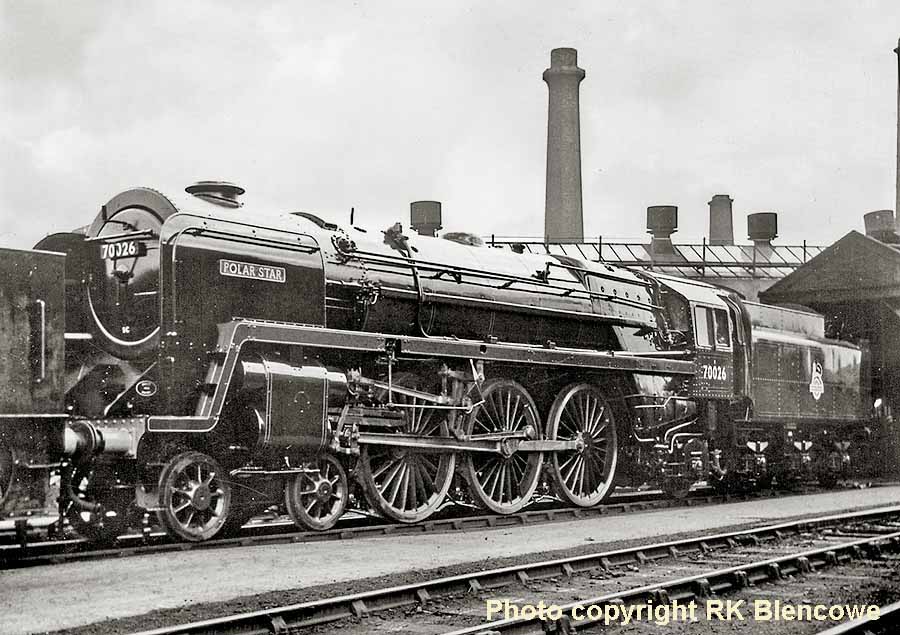
(Above) Fresh off the assembly line, 70026 Polar Star was photographed by RK Blencowe in October 1952, her glistening paintwork seemingly barely dry. She is awaiting delivery in the works yard at Crewe, where all the Britannias were constructed; fitted with Automatic Train Control equipment (item 20), with accompanying battery box and relevant pipework below the cab; also fitted with WR type lamp irons (item 2) and cab sheet (item 9), but no tender step (item 10); nevertheless looking ready for work on the Western Region based at Cardiff Canton MPD (86C).
ALLOCATIONS: Firstly to Cardiff Canton (86C), where 70026 spent almost five years before moving on to Aston MPD (21D) in the Birmingham area during September 1961, as did five other Western Region Britannias from Cardiff. The next move was to Holyhead MPD (6J), leaving Aston in April 1963, and staying in North Wales until May 1965, before moving to Stockport Edgeley MPD (9B), where 'she' joined forces with 70004 'William Shakespeare' and 70015 'Apollo'. This was to be the last allocation for 70026, as she was withdrawn from Stockport on the 14th January 1967, kept in store until April that year, and dispatched to Cashmores of Newport, being cut up during May 1967.
MODIFICATIONS: 70026 wasn't completed until 12 months after 70024 'Vulcan'; the delay was due to an acute shortage of steel following on from World War 2. But that said, the interim period did give the Works the opportunity to apply the modifications that been found to be necessary during the service period of the earlier engines. These amounted to 5 items: item 9 - the flexible screen was fitted at this time, helping to prevent draughts at the back of the cab; item 17 - the hollow axles were rectified and the wheel bearings seated correctly; item 16 - the sand box lids were raised from new; item 8 - the reverser recuperating spring was contained from new; item 5 - the steady bracket was fitted to the forward rod of the regulator from new. Allied to these changes, we should note that the lamp irons (item 2) were of Western Region type; the plain
 couplings (item 14) were added as part of the Axle repairs; and the Automatic Train Control equipment was fitted. Early in 1953 the tender step (item 10) was added, this gave added security to the fireman when adding water to the tank.
couplings (item 14) were added as part of the Axle repairs; and the Automatic Train Control equipment was fitted. Early in 1953 the tender step (item 10) was added, this gave added security to the fireman when adding water to the tank. 70026 continued to perform without any visual modification being done, until seen in July 1956 following the 'Milton Derailment' accident repairs (see Service Record below), when the Exhaust Ejector unit (item 4) could be seen with a solenoid valve fitted and cabling back to the cab; also the conduit piping from the ATC (item 20) battery box was now routed along the lower edge of the boiler walkway, and into the front of the engine (before the accident the piping was attached to the chassis frame).
At this time Swindon were contemplating changing the smoke deflectors (item 3), but initially reset them, then altered the curvature of the deflector sheet, and finally carried out the full Swindon modification, seen from February 1957. Obviously this was quite some time after the fatal Milton accident, and 70026 was not the first locomotive to be changed: 70023 'Venus' was seen from the 18th January 1957 with 6 brass-lined cut-outs on each deflector sheet, and only 9 engines were treated in this way.
On her next visit to Swindon Works, 70026 had the Exhaust Ejector unit (item 4) modified further; the whole assembly was positioned lower, with alterations to the relevant pipework required to accommodate the new position. The new British Railways emblem (item 11) was not applied to 70026 until May 1958, along with the front step (item 1) modification, this being only 1 of 3 engines to have the step applied after the alteration of the smoke deflectors: the other two being 70023 and 70027 (also Western Region engines at the time). The LNER Return Crank (item 15) was not ever changed on 70026, nor did 'she' have fitted the AWS equipment (item 20), after the ATC (WR) apparatus was removed, in September 1961. Also in 1961 the rear regulator rod support bracket (item 7) was fitted along with the power warning plates (item 19) being added; also the speedometer (item 13) was fitted in January 1962, after a works visit to Crewe. In 1964, in line with most other engines, 70026 lost her nameplates, and the lamp irons (item 2) were repositioned to comply with safety rulings.
(Below) Following Light Intermediate repairs at Crewe Works, 70026 Polar Star heads through Condover, south of Shrewsbury with a running-in turn. 70026 now has a tender step fitted (item 10) to aid the fireman's safety when adding water to the tender. The date is November 1954, just twelve months before her involvement in the fatal crash at Milton near Didcot in 1955.

SERVICE RECORD: 70026's career began at Cardiff Canton in October 1952, being immediately assigned to the London Paddington expresses; especially 'The Red Dragon', not a difficult route, but she was often seen hauling 15 coaches through the Severn Tunnel without any problems of note. 70026 entered Swindon Works for repairs on nine occasions, and Crewe four times, covering a recorded 69,440 miles in 1953, also logging 68,620 miles for 1955, but ending that year in a catastrophic state following the fatal accident at Milton on the 20th November 1955.
The Milton accident cost the lives of 11 passengers who were travelling on a day excursion from Treherbert in South Wales to London Paddington. Of the 293 passengers aboard the train, eleven perished, 157 were injured, 62 of whom were detained in hospital, including the driver and a ticket collector.
The train set off from Treherbert in the Rhondda Valley at 08.30am and reversed at Cardiff General, where 70026 Polar Star took over, manned by a Canton crew, and departed Cardiff at 10.00am, seven minutes late. On this day, being a Sunday, permanent way engineers occupied the track at four locations - the Severn Tunnel; Lliswerry; Wantage Road and at Milton. The Severn Tunnel working meant that the train was routed via Gloucester, which in turn caused the train to encounter engineers carrying out track repairs at Lliswerry near Newport. It was here that the locomotive's Automatic Train Control operated and began application of the train's brakes, but the warning was acknowledged by the fireman (not allowed in the Rules) and thus cancelled. Further along the route bridgeworks were being carried out at Wantage Road in the Vale of the White Horse, Oxfordshire, and again the train slowed to the required 15mph to pass safely through the hazard. From this point the train is said to have accelerated to 40mph before reaching Steventon, a quarter of mile prior to the main line ATC ramp protecting the Milton distant signal.
At Milton, two miles to the west of Didcot, permanent way engineers were working on the line, and the driver of 70026 was required to slow the train to 10 mph and cross over onto a goods loop. However, the driver had not read this fact from his weekly working notices and approached the loop at an estimated 50 mph with dire consequence. Both locomotive and first five coaches left the track and fell down the 18 foot embankment whereas the remaining five coaches were derailed but stayed upright, thankfully.
(Below) Milton Mayhem: a schematic plan of the crash site at Milton, showing the position of 70026 and the coaching stock making up the ten-coach train. This modified map is reproduced courtesy of Profile Publications' booklet 'Loco Profile No 12 BR Britannias'.
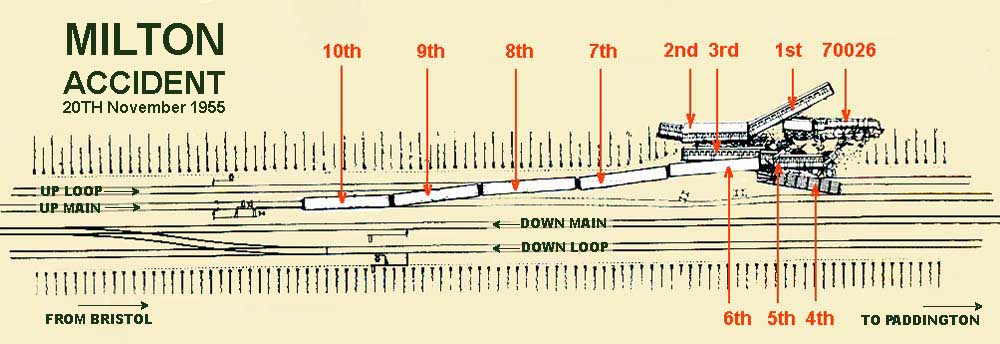
A subsequent inquest into the accident was held in March 1956, conducted by Brigadier CA Langley, an Inspector of Railways. The driver told the enquiry that his view of the road ahead was made more difficult by the handrails on the smoke deflectors and also by the position of the exhaust ejector which was situated on the left-hand side of the locomotive (driver's side). At this juncture it should be added that GWR Locomotives were designed as right-hand drive, and therefore most GWR signals were positioned to allow for this, whereas the BR Standards were of left-hand drive design. The driver stated that he could not clearly see the oncoming signals, because they were set to the right of the track, and their approach was on a slight right-hand curve.
Brigadier CA Langley formed the opinion that the handrails contributed to the accident and recommended their removal in his report. He also stated that the exhaust ejector should be repositioned as soon as possible on all Western Region Britannia locomotives. However, Brigadier Langley did ask the driver why the fireman was not looking out for the signals, as he was better positioned? The driver replied that his fireman had an issue with the exhaust steam injector at this time, and was trying to get some water delivered up to the boiler; he also added that the fireman was not familiar with the route. In addition to this it was established that many crews were unfamiliar with the Britannia class locomotives because they had only been allocated to Cardiff for three years.
The inquest did not receive a satisfactory answer to the question of the Automatic Train Control equipment which was working earlier on the same trip and found to be in working order after the accident. Why had the crew not heard the warning horn? The driver was of the opinion that the system had simply failed, although subsequent checks after the crash found the equipment to be satisfactory. The point of this being that the ATC would have stopped the train had not someone acknowledged the warning signal thus cancelling the brake operation.
Brigadier Langley blamed the driver who, in his opinion, had not properly looked out for signals, and had not properly read his weekly notice listing all engineering work. The inquest also criticised the guard for not applying his brake, when he knew that the train should be slowing down, but in fact was not doing so. Also the signalman was criticised for not having a secondary flagman positioned in front of the crossover point, as the trains (eleven had passed through) were entering the goods loop.
The Inspecting Officer made six recommendations in his report: more thorough cleaning of the ATC equipment fitted to the engines; a visual indicator to be fitted in the cab; handrails to be removed from smoke deflectors; the exhaust ejector should be repositioned lower down on the boiler; signals to be gradually resited and finally - passenger trains should not be allowed into a goods loop unless instructed to do so.
Actual damage to 70026 was not critical and following repairs Swindon the locomotive was put her back in service, but strangely the smoke deflectors had not been altered! She re-entered works for light service and checking of the accident repairs, but again left without the handrails being changed or removed. However it was noticed that the deflector sheets themselves had been bent quite sharply inwards from about two-thirds up and the exhaust ejector had been reset in a lower position. The smoke deflector modification (item 3) was not completed until 25th February 1957, when the offending handrails were substituted by six handholds per sheet. It is a known fact that Crewe Works did not agree with the findings of the inquest, and actually never did modify any smoke deflectors, as all were done by Doncaster and Swindon Works, totalling 25 units and 14 units respectively.
Following this entire sorry episode, 70026 returned to Cardiff Canton and began duties on the London trains once again; she entered Swindon Works early in 1958 for a major overhaul including a boiler change, this being changed again two years later. 'Polar Star' had two changes of tender, but kept the WR type step (item 10) throughout her career. 70026's recorded mileage was 53,300 miles in 1958 and 44,730 miles in 1959, though this dwindled to 25,550 miles in 1960 due to a four month period spent at Swindon Works during that year. Generally speaking, the annual mileages recorded for 70026 - and that of all the Britannias after this time, became much lower as more diesels were being employed on passenger turns throughout all four Regions.
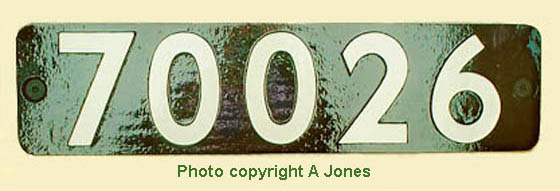
(Above) The genuine numberplate from engine number 70026 Polar Star. It was carried on the locomotive from new in 1952 until early 1965. Photo copyright A Jones.
SIGHTINGS: 70026 'Polar Star' was seen when new in 1952 at Crewe Works, and was observed at Cardiff on 30th May 1953 hauling the up 'Red Dragon' with 13 coaches and sporting the old-style headboard, however an extra Coronation crown was affixed to the top to commemorate the Coronation of Queen Elizabeth 2nd three days later; indeed 70026 was again entrusted with the up 'Red Dragon' on that day, not only carrying the adorned headboard but also sporting white painted buffers, and looking quite superb. In April 1954 70026 was observed at Rumney on a Swansea to Manchester express, train ID No 795, and looking in the usual very clean condition. Early in 1956, 70026 was pictured outside Swindon Works, awaiting major repairs following the Milton Crash, and she was seen again outside Swindon Works in October 1960, but this time in ex-works condition awaiting a reunion with her tender. However, with the arrival of the GWR Kings at Cardiff Canton, the general condition of the Britannias took a decidedly downward turn, and 70026 would no longer be seen at her best. 'Polar Star' was pictured in very reasonable condition awaiting her next turn of duty at Willesden MPD during April 1962, and also in spotless condition at Crewe following overhaul in July 1963.

(Above) Captured by RK Blencowe, 70026 Polar Star is ready for the next day's work at Cardiff Canton (86C), and is showing the opted modification for the Smoke Deflectors (item 3) decided by Swindon for its Western Region Britannia engines. The modification was recommended during the inquest into the fatal Milton crash back in March 1956, the primary aim to improve the sighting of WR signals for the driver. The picture was taken in February 1957, and at that time all 15 Western Region Britannias were allocated to Canton, the final one being 70021 Morning Star from Laira (83D) on 26th January. Also of note, 70026 is sporting the old BR emblem and no front step (item 1) modification as yet.
(Below) Fast-forward a few years and 70026 Polar Star is seen at Swindon shed with 'extra adornments'; the date is February 1960, this being her last full year allocated to Cardiff Canton MPD (86C). Most modifications have now been carried out, including the front step (item 1) and new BR emblem (item 11) on the tender. The whitish markings over the offside cylinder are caused by steam vapours escaping from the exhaust joint just above.
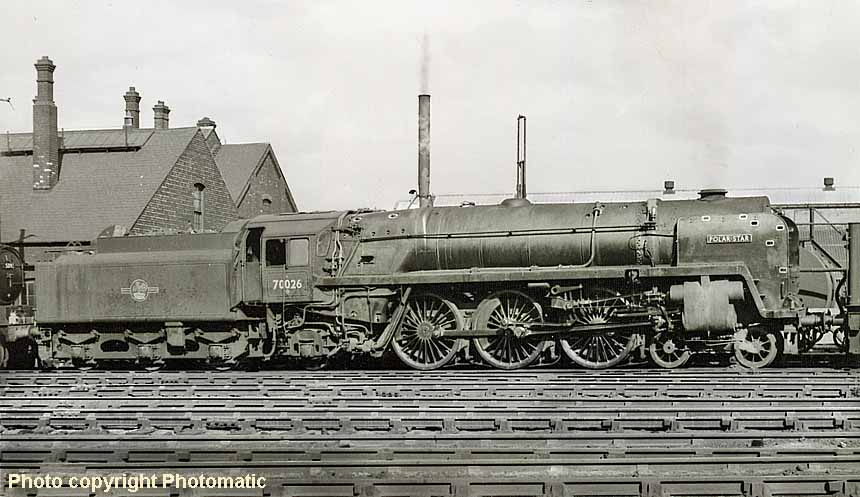
Programme was authorised on the 17th November 1949; built at Crewe and completed on 24h October 1952, to Order No E483/228 Swindon 403, costing £22,734. Withdrawal was on Saturday 1st July 1967 from Carlisle Kingmoor. The additional part of the order number added refers to Swindon's request to fit Western Region lamp irons and the Automatic Train Control equipment with in-frame pipework. This raised the cost of construction slightly, compared to the LMR Britannias.
ALLOCATIONS: After testing at Swindon, 70027 was duly delivered to Cardiff Canton depot (86C) and soon put to good use on the top-link expresses to Paddington. When the transition from steam to diesel-traction began, the twelve Cardiff Canton Britannias were moved on and 70027 was reallocated to Aston shed (21D) in Birmingham in September 1961 for a period of 20 months. Then, following a common path, Holyhead depot (6J) became its next home for nearly two years until February 1965; this was followed by a move to Crewe North (5A) where it joined 26 other classmates there, all of which moved virtually en-bloc onto Crewe South MPD (5B) when Crewe North closed to steam at the end of May 1965. As with many other Britannias at this time, the engine was moved from one depot to another and back again; 70027 found favour at Llandudno Junction (6G) from February 1966, but only for two months before making a return to Crewe South shed during April 1966. This move lasted a very short 5 months before its final move to Carlisle Kingmoor MPD (12A), the last resting place of so many engines. However, it should be pointed out that the record of 70027's shed allocations contain many anomalies within the four points of reference that I use, and therefore I've had to take the unprecedented step of calculating an average of all these to give a creditable result. As a consequence this statement should not be taken as definitive…I should also stress that after more than fifty years there is a distinct possibility that 70027's movements may not be traceable or even available.

(Above-Below) Sincere thanks to Paul Chancellor of Colour rail for this image of three of the recently acquired five Britannia Pacifics at Cardiff Canton MPD in February 1953. Engines 70027 Rising Star, 70028 Royal Star and 70029 Shooting Star can be viewed at the east end of the yard, while 70026 Polar Star is not in sight and the fifth locomotive 70025 Western Star was away at Rugby Testing Station. Quite visible are the train headcodes of '795' and '796' on 70029 and 70027 respectively, which suggest workings to the North West of England, while 70028 would most certainly be on a London run. The large buildings in the background were the carriage storage sheds and at ground level beyond the 3 Britannias, can be seen the roof of the ash shelter; this was a part of the earlier yard improvements, which included the extensive walkway and the new coal stage. (Below) Photographer RC (Dick) Riley's due diligence in recording most accurately the locations and dates of his many photographic forays to different parts of the country, has helped tremendously in many ways to establish a correct timetable of the myriad of modifications that beset the Britannia locomotives. This shot of a rather grubby 70027 Rising Star in the vast yard at Old Oak Common depot, displays very well the plates around the sand box lids, also the cable running back to the cab from the solenoid on the exhaust ejector. The image is dated October 1957 and shows the coaling stage ramp on the left and piles of spent ash to the left, while the ironwork on the ground is the remnants of the ash shelter; this was erected around 1942 to hide from view telltale signs of burning ash from enemy aircraft during WWII.Click HERE to visit the Transport Treasury website
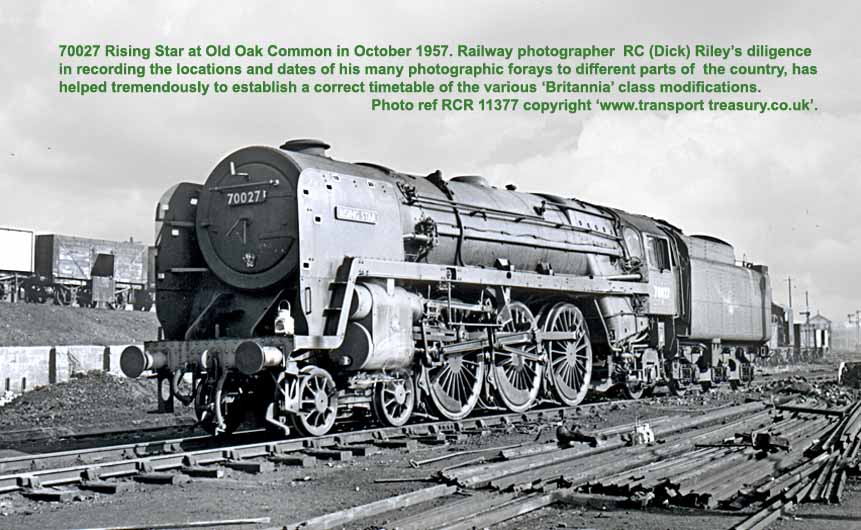
MODIFICATIONS: 70027 Rising Star was constructed a little more than 12 months after 70024 'Vulcan'; this delay was quite simply down to a post war shortage of steel, which was due in part to many other railway locomotives being built during 1951, but that said, the delay period gave the Works the opportunity to apply the modifications that had been found to be necessary during the service period of the first batch of engines. These amounted to 4 items: most importantly item 17 - the hollow axles were plugged and the wheel bearings seated correctly; item 16 - all the four sand box lids were raised from new; item 8 - the reverser recuperating spring was contained from new; item 5 - the steady bracket was fitted to the forward rod of the regulator from new. Along with these changes, we should note that the lamp irons (item 2) were of Western Region type; the plain coupling rods (item 14) were added in conjunction with the Axle rectifications; and the Automatic Train Control equipment (item 20) was fitted, from new by Swindon Works, in conjunction with Crewe Works. The original tender was a BR1A type, slightly heavier than a BR1 version, and had a capacity of 5,000 gallons of water, fitted with a WR type step (item 10) and a raised dome, with only five of this design being constructed. Because of the changes employed in the construction of 70027, the engine's appearance changed little during the first four years of service, except for a unique alteration to the sand box lids which was seen for the first and only time, in that a metal backing plate was added to each of the four lids to aid filling with sand. From November 1956 to late April 1957 the locomotive was in Swindon Works and received much modification; the engine was numerically the third to have modified smoke deflectors (item 3) and all were of the WR type with six brass-lined oblong handholds to each sheet; also the new BR emblem (item 11) was applied to the sides of the tender. Also a solenoid valve was added to the exhaust ejector (item 4) unit with added cabling back to the cab giving better control over its operation to the driver; also on the engine's next visit to Swindon Works, during 1958, the whole assembly of the exhaust ejector (item 4) including the solenoid, was repositioned further down the boiler, with Swindon citing that the driver's view forward was impaired. It was not until the next visit to Swindon Workshops that the original front steps (item 1) in front of the smokebox were changed, in August 1959. This was unusual with the Britannia Class, as only 3 engines had the step modification after the smoke deflectors were altered, with all of these being WR locomotives. At the same Works visit the LNER return crank (item 15) was replaced with the LMR version. The next scheduled Works visit was done at Doncaster Workshops, with Swindon saying that they had too much work on at that time, in May 1961. It was rare to see any power warning plates (item 19) on a Western Region Britannia, but Doncaster had fitted some to 70027, with the plates around the sand boxes (item 16) now being removed. Also once the engine had left the WR the ATC equipment was stripped off and the locomotive never received the AWS equipment; the LMR version of automatic train braking. Surprisingly the speedometer unit (item 13) was not fitted to this Britannia, one of 12 engines that did not receive one in service and one of 9 locomotives that were not fitted with either the AWS or a speedometer.

(Above-Below) Following the arrival of 70027 with a morning express from South Wales, the Cardiff Canton Britannia is captured by C M & J M Bentley being admired by interested passengers on platform 8 at the wonderfully evocative Paddington Station. The splendidly clean engine has had minor adjustments since the previous picture; the lubrication operating rod has been shortened, the ATC piping has been reset differently and the full version of the front step is now fitted. (Below) John Hodge captured this shot of BR Standard Pacific 70027 Rising Star at Cardiff Canton depot on 28th November 1959; the locomotive is being prepared to take over the morning train from Neyland to London Paddington, train reporting number '048'. The immaculately turned out engine is a credit to Canton shed staff who continued to look after their Britannias very well, even after seven years of service. The brass-lined handholds are prominent on the smoke deflectors, as are the unique backing plates to the sand boxes seen on the boiler walkway.

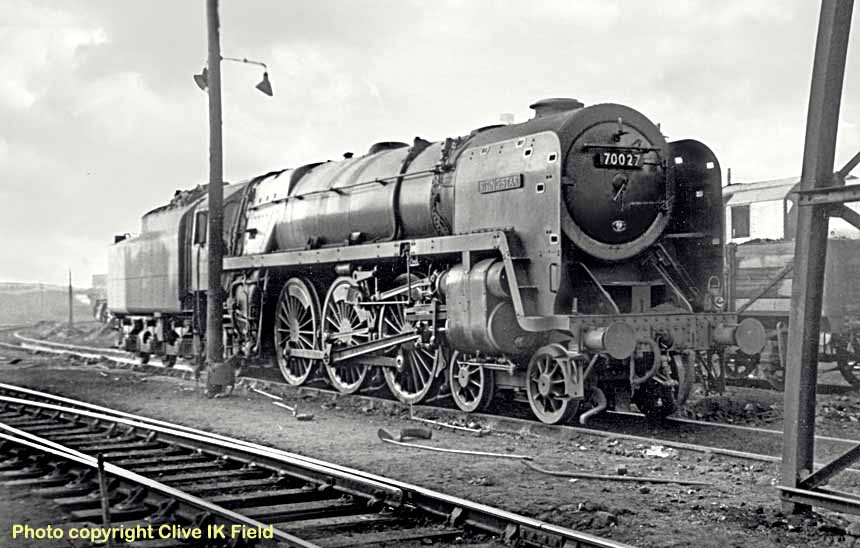
(Above-Below) Another fine image from Clive IK Field brings us this view of Cardiff Canton MPD yard where 7P6F 70027 Rising Star stands awaiting its next duty in company of an ex-WD locomotive and a Western
 Region engine. The condition of the Britannia in early 1960 leaves a lot to be desired and seems to show that standards have slipped or staff levels have dropped somewhat, with spent ash left on the front of the engine and six irons left lying on the floor alongside. (Below) This WR Britannia is a long way off the beaten track! A rare photograph, courtesy of the Colour Rail Archives, captures a newly-outshopped Britannia 70027 Rising Star at Boston Station in Lincolnshire. During the summer of 1961 Swindon Works could not cope with the workload hence the locomotive was shopped at Doncaster Works instead. The Cardiff allocated locomotive has now been fitted with power warning plates, rare for a Western Region Britannia, and the sand box backing plates have been discarded. Note also the strange angle of the single headlamp on the WR type lamp iron; this was caused by the fitting of a standard LNER lamp which is incompatible, as the WR lamp iron faces to the left, not straight ahead (see inset). Click HERE to visit the Colour Rail website.
Region engine. The condition of the Britannia in early 1960 leaves a lot to be desired and seems to show that standards have slipped or staff levels have dropped somewhat, with spent ash left on the front of the engine and six irons left lying on the floor alongside. (Below) This WR Britannia is a long way off the beaten track! A rare photograph, courtesy of the Colour Rail Archives, captures a newly-outshopped Britannia 70027 Rising Star at Boston Station in Lincolnshire. During the summer of 1961 Swindon Works could not cope with the workload hence the locomotive was shopped at Doncaster Works instead. The Cardiff allocated locomotive has now been fitted with power warning plates, rare for a Western Region Britannia, and the sand box backing plates have been discarded. Note also the strange angle of the single headlamp on the WR type lamp iron; this was caused by the fitting of a standard LNER lamp which is incompatible, as the WR lamp iron faces to the left, not straight ahead (see inset). Click HERE to visit the Colour Rail website.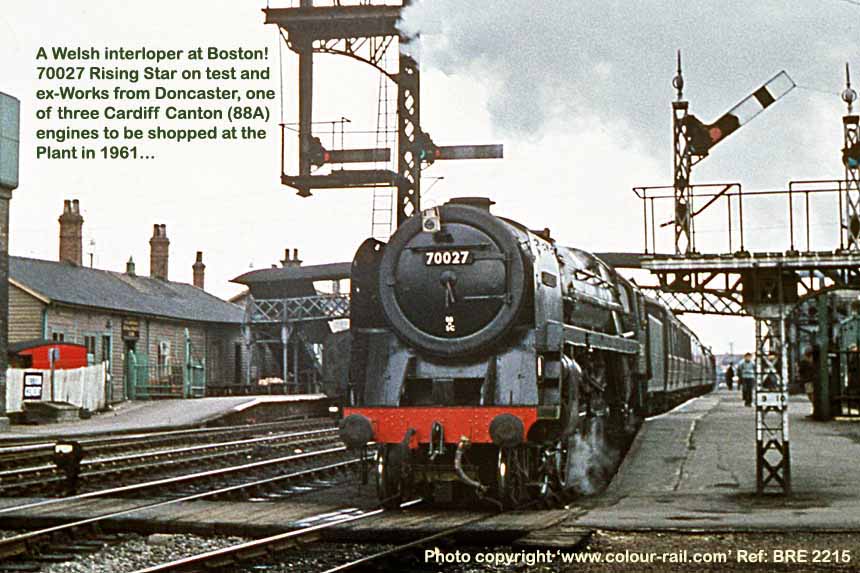
SERVICE RECORD: 70027 was quickly put to work on the 'Red Dragon' and other Cardiff General to London Paddington trains of the period, plus it worked the 'Pembroke Coast Express' on commencement of the service in 1953. 70027 was the second Britannia to arrive at Cardiff Canton where it was well received, well maintained and kept in immaculate condition for the top-link London jobs; this only lapsed when the engine became due for maintenance, at which point the locomotive would be utilised west of Cardiff until it returned from 'shopping' at Swindon. The Britannia was recorded as travelling 69,500 miles in 1953, a slightly lower 59,200 in 1954, though this figure was affected by two Works visits, whereas the following year's poor return of 55,000 miles was not directly affected by any such downtime. No figures are available for 1956 or 1957, but a rather average figure of 52,700 miles was logged for 1958, followed by an even lower figure of 40,400 for 1959, however this included a full 5 months spent at Swindon. The next year 70027 covered 51,500 with no apparent repair time to allow for, however the figure cited for 1961 was an extremely low 17,200 miles, but there were a number of key reasons for this; when it was due 'shopping', possibly April, Swindon Works had too much work in front of them, so the Britannia was dispatched to Doncaster for eight weeks. Soon after returning to Cardiff Canton, 70027 was relocated to Aston (21D) where the depot was still reckoning on how best to deploy their sudden influx of a new engine types. The recorded Workshop visits are 4 for Swindon, 3 to Crewe and the rare single appearance at Doncaster Workshops mentioned above.

(Above-Below) Aston-allocated Britannia 70027 Rising Star is pictured heading a Western Division express from Crewe station on 23rd April 1962. The profusion of white-painted highlights on all points around the front were quite typical of Aston depot, as the staff took kindly to their new engines; 7 ex-Western Region Britannias arrived there in September 1961 along with a couple from Longsight in Manchester. In all, 12 ex-WR Pacifics saw service at the West Midlands shed, with a grand total of 22 different Britannia engines working from there, some on short stays, some for much longer and six of the class returned for a further allocation. (Below) From the large Archives of Rail Photoprints, we have this very strong image by Colin Whitfield of BR Standard 70027 Rising Star at Warrington late in 1962. The Aston (21D) allocated engine does not compare favourably with its time at Cardiff Canton, but it has good tyres and is reasonably tidy with many items to note; the top lamp iron is missing, no speedometer (ever) nor any AWS equipment fitted, also now has a LMR type of step on the tender and the Works build plate is now missing from the frame. Click HERE to visit the 'Rail Photoprints' website.
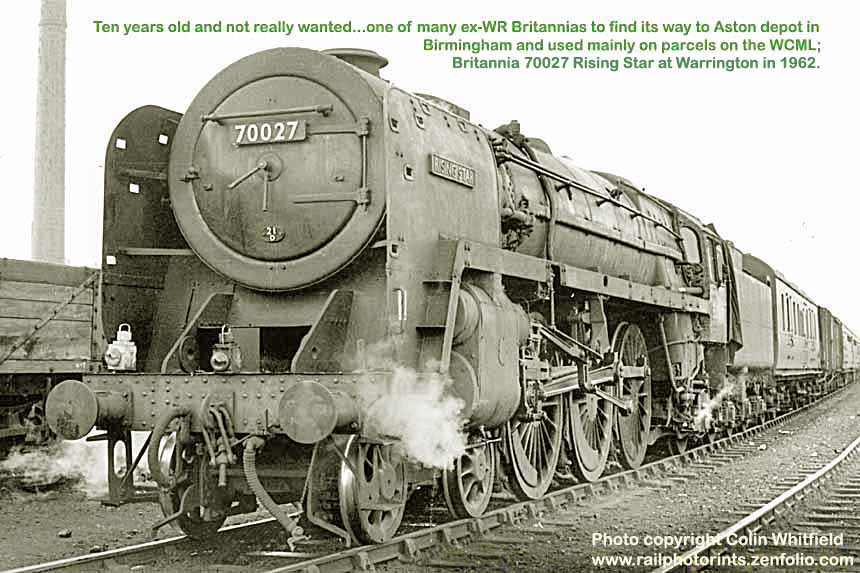
SIGHTINGS: Few early pictures of 70027 Rising Star have emerged, but an immaculately turned-out engine was captured leaving Cardiff General Station with the 'Up' Red Dragon express in June 1953; 70027 had been seen earlier on the same train, but with a 'crown' fitted over the top of the 'Red Dragon' headboard to mark the forthcoming Coronation of Queen Elizabeth ll. During 1955 the engine was seen at Swindon Station in Wiltshire with a down express for South Wales; the loco looked in good clean condition, with the recently fitted plates around the sand boxes, to assist the crew in adding the sand. Following recent repairs at the Swindon 'Factory' an exceedingly clean Britannia, now with the smoke deflectors altered to Western Region type, was viewed at Cardiff Station, fully coaled, fully steamed and ready to leave with the mid-day departure for London Paddington on Saturday 11th May 1957. Two years later the engine was espied traversing Goring troughs with an afternoon express from Paddington to Swansea in September 1959, and it was noticeable that the front step (item 1) had been fully modified. After relocating to the LMR at Aston depot, 70027 was photographed at Bescot MPD sporting a wealth of white embellishments on the front, including the smoke deflectors; clearly the staff at Aston had taken to their new engine with some pride. In 1964 the engine was a resident at Holyhead, but looking in a work-worn condition when viewed at Birmingham Snow Hill station at the head of a mixed freight for the south; this was typical of the period. In March 1967 the now nameless Britannia was pictured with a Bradford to Leeds express leaving Shipley at Guiseley Junction on the Aire Valley route.
DISPOSAL: Withdrawal took place on Saturday 1st July 1967 from Carlisle Kingmoor. The engine was thus stored until 16th November 1967 then transferred to Motherwell Machinery and Scrap Company of Wishaw for cutting up (Under construction)
Programme was authorised on the 17th November 1949; built at Crewe and completed on 27h October 1952, to Order No E483/228 Swindon 403 costing £22,734. Withdrawal was on Saturday 16th September 1967 from Carlisle Kingmoor. The additional part of the order number added the Swindon Works request to fit Western Region lamp irons and the Automatic Train Control equipment with in-frame pipework; this raised the cost of construction slightly, compared to LMR Britannias.
ALLOCATIONS: 70028 was among the first five Britannias to be allocated to Cardiff Canton MPD (86C) in South Wales where it enjoyed a long stint of almost nine years; this was broken by a short spell of four weeks spent at Exmouth Junction depot (72A) in May 1953 to cover for the temporary withrawal of the Southern Region's Pacifics due to axle problems. After moving away from Cardiff Canton, 70028's career went from the sublime to the ridiculous: starting in September 1961 the locomotive was transferred to Aston shed (21D), then to Longsight depot (9A), then back again to Aston, returning to Longsight for a second time, and then back again to Aston and yet again to Longsight in September 1962; all within the space of twelve months!
70028 continued to move around the depots, beginning with Willesden MPD (1A) from May 1963 then on to Crewe North depot (5A) in September. Following closure of 5A in June 1965, 70028 moved to Crewe South depot (5B) followed by a spell at Llandudno Junction shed (6G) at the end of February 1966, but this lasted only two months before returning to Crewe South depot for a little under five months, prior to finally making its way north to Carlisle Kingmoor MPD in September 1966 where it managed to last another twelve months before succumbing to the inevitable.
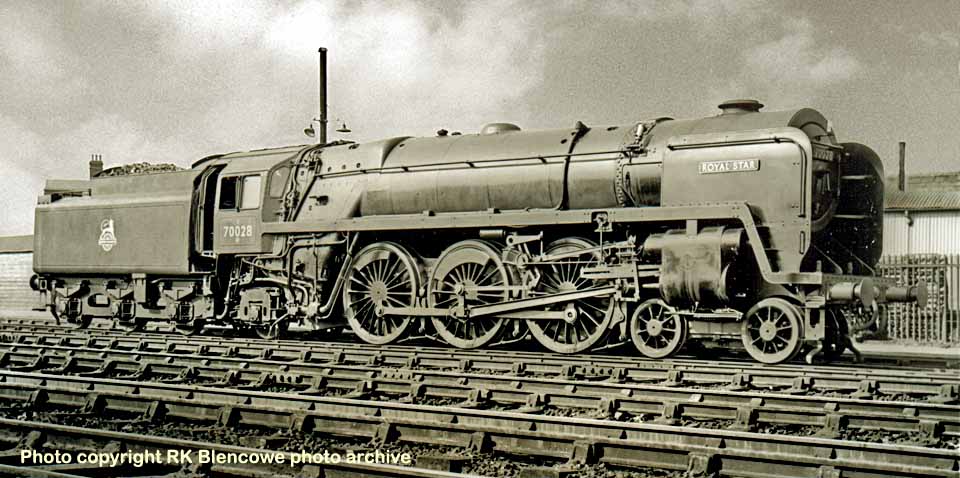
(Above-Below) This view from Rod Blencowe shows a very presentable Britannia Pacific 70028 Royal Star in the yard at Swindon Works date unknown, though it is most likely to be the occasion when the engine received a Light Casual service in April 1953. The WR's 'red spot' indicating a weight restriction is attached to the cabside, but there isn't any evidence of an extra lamp iron from the locomotive's loan period to the Southern Region, therefore the image was taken before May 1953. (Below) Rod Blencowe's fine photograph of 70028 Royal Star at Cardiff General exemplifies the effort put in by both shed staff and cleaners at Cardiff Canton depot in respect of their Britannia locomotives; the locomotive is certainly not ex-Works, for the date is July 1957 and its last visit to Crewe Works for shopping was the previous October. Of note is the missing cylinder head cover, the wad of cleaning cloth on the boiler walkway and the SR lamp iron on the nearside smoke deflector stay, a legacy of its visit to the SR's Exmouth Junction depot (72A) in May 1953. 70028 is awaiting the arrival of the London-bound 'Red Dragon' from Carmarthen which it will take charge of for the remainder of the journey to the capital.
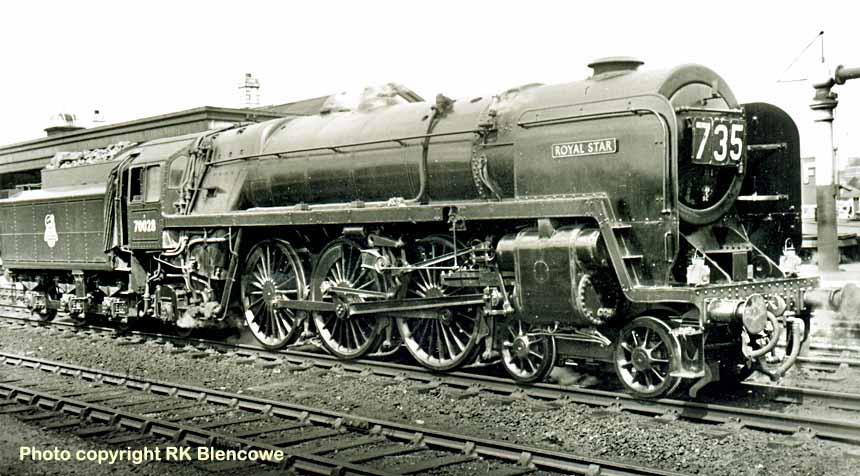
MODIFICATIONS: 70028 was completed a little more than 12 months after 70024 'Vulcan', this was quite simply down to a post war shortage of steel, but that said, the delay period gave the Works the opportunity to apply the modifications that had been found to be necessary, during the service period of the first batch of engines. These amounted to 5 items: item 9 - the flexible screens were fitted at this time, helping to prevent draughts at the back of the cab; item 17 - the hollow axles were plugged and the wheel bearings seated correctly; item 16 - all the four sand box lids were raised from new; item 8 - the reverser recuperating spring was contained from new; item 5 - the steady bracket was fitted to the forward rod of the regulator from new. Along with these changes, we should note that the lamp irons (item 2) were of Western Region type; the plain couplings (item 14) were added in conjunction with the Axle repairs; and the Automatic Train Control equipment (item 20) was fitted, from new. The tender step (item 10) was most probably fitted from new, but no photograph has come to hand to prove that was indeed the case. The original tender was a BR1A type, slightly heavier than a BR1 version, and had a capacity of 5,000 gallons of water, fitted with a WR type step (item 10) and a raised dome, with only five of this design being constructed. The first General Overhaul is recorded as September 1956 at Crewe Works, when the front step (item 1) was modified and the original LNER return crank was changed for the LMSR type; also of note was the regulator rear rod steady bracket (item 7) was added and at some stage close to this date, Swindon Works added a solenoid valve to the exhaust ejector unit (item 4). Swindon Works carried out the next overhaul, dated up to October 1958, and this brought about a change to the smoke deflectors (item 3) to LMR 2 design, showing two backless circular handholds, the same as fitted previously to 70017 and 70020. Also at the same visit the lubrication operating rod (item 18) was shortened, the new BR emblem (item 11) was applied to the sides of the tender and the exhaust ejector unit (item 4) was lowered to aid forward vision. 70028 Royal Star was back at Swindon Works from late May to late October 1960 and was seen after with a different tender step (item 10), in other words the engine had lost its BR1A design tender with a Western Region step and now had a BR1 type tender with a London Midland step fitted on the sloping sides. A speedometer unit (item 13) was never fitted to 70028; the regulator rear rod bracket (item 7) was left off at this time and was never refitted, also once the engine had left the WR the ATC equipment was stripped off and the locomotive never received the AWS equipment; the LMR version of automatic train braking. The power warning flashes (item 19) were rarely seen on a WR Britannia and this was the case with 70028, as they were not seen until the engine moved to Aston shed later in 1961, followed by the change from WR lamp irons (item 2) to LMR irons, which faced forward.
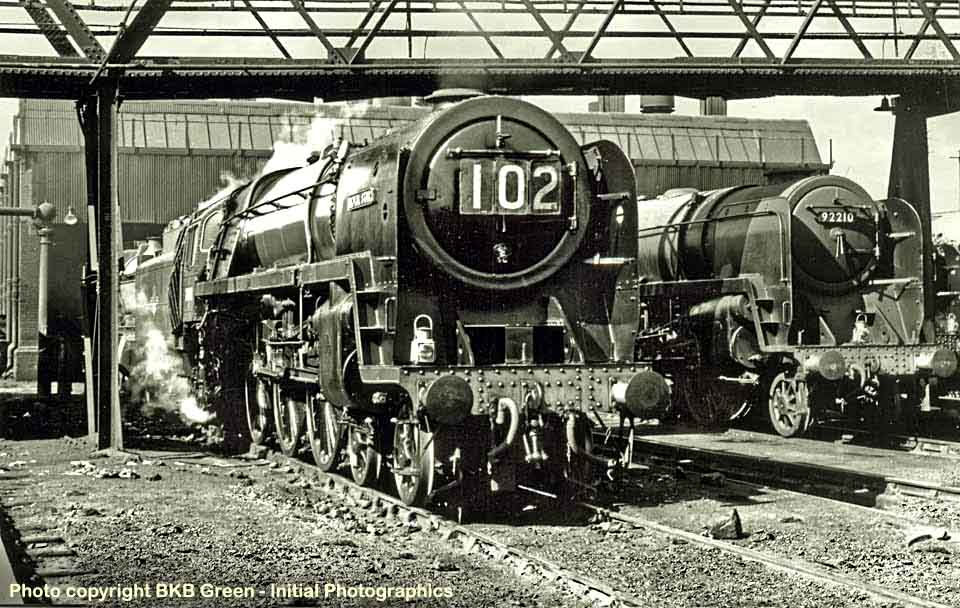
(Above-Below) A very well presented picture by BKB Green for Initial Photographics shows Britannia Pacific 70028 Royal Star being prepared for the road at Cardiff Canton MPD in September 1959; the Britannia shares the company of a recently recruited Class 9F 92210 and a pair of former-GWR engines on either side. The picture is framed by the 1935-built footbridge which extended all the way across the yard and allowed staff a safe passage to and from the coaling stage on the south side. (Below) By way of a change we have a splendid colour shot by Stuart Sanders of 70028 Royal Star, albeit performing a mundane task as it waits impatiently at Bletchley with a fitted freight bound for London in April 1962. The Longsight allocated engine had recently spent four weeks at Crewe Works and it is noticeable that the WR lamp irons have been replaced, but the WR's route restriction 'red spot' is still visible on the cabside below the loco number.
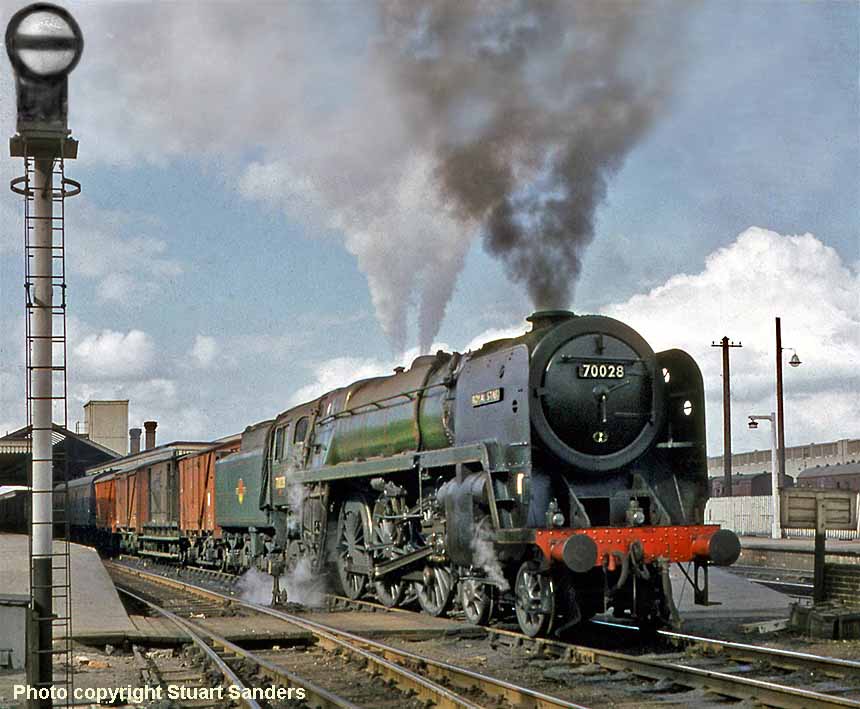
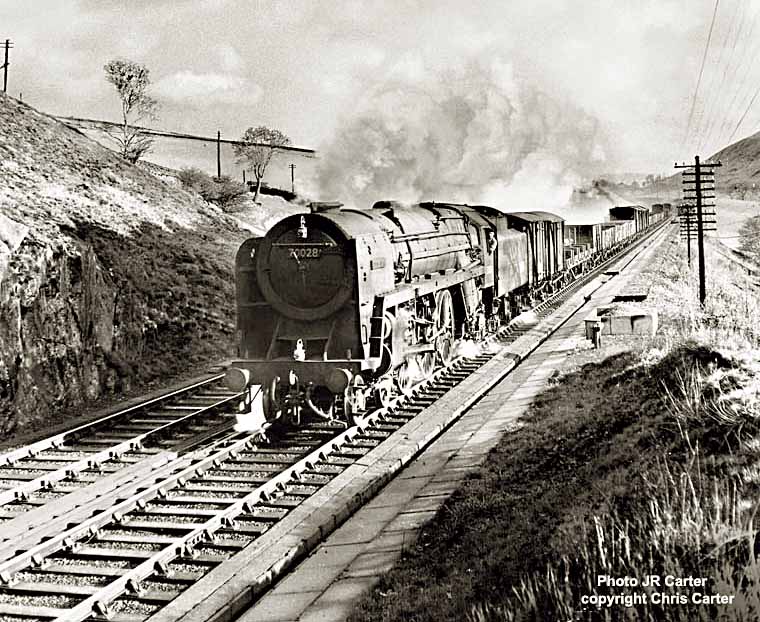
(Above-Below) This striking image of a workmanlike 70028 Royal Star was captured by the marvellous Jim Carter; the engine is making good progress heading south with an early morning freight over Dillicar troughs in the Lune Gorge. The best days were over for the 7MT locomotive and sightings of the ex-Cardiff Canton engine running through the Severn Tunnel with the 'Red Dragon' to London Paddington seem like an age ago. (Below) A reasonably tidy, but rather grubby Britannia 70028 Royal Star is captured by Paul Claxton passing a line of BR insulated meat container wagons at Crewe in November 1963. The ex-Western Region engine was a resident of Crewe North at this time, having recently moved from Willesden depot, joining 17 other classmates at 5A. A fine selection of Paul's photographs can be found on Page 46 HERE, which includes links to Mike Claxton's excellent 'Rail Pictorial' website....a visit is highly recommended.
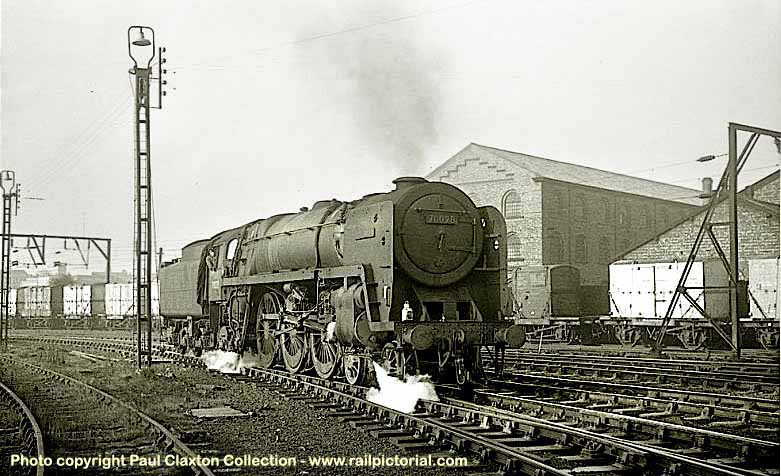
SERVICE RECORD: 70028 was very soon put to work at Canton shed on the 'Red Dragon' and other South Wales expresses to London; this included the 'Pembroke Coast Express' when the service commenced in 1953. Unfortunately the Britannia was recorded as failing on the 'Red Dragon' in July 1954, but no other details are available. In his excellent book: 'British Pacific Locomotives', published by Ian Allan Ltd., Cecil J Allen has recorded a log of the run for 70028 hauling the up 'Red Dragon' with the normal thirteen coaches, and noted that London was reached ahead of schedule, although this was frowned upon by the train's restaurant car manager!...the timing of the journey to the capital was worked out to allow passengers time to enjoy their meals in comfort. Before very long the engine was selected to go to Exmouth Junction for a loan period while the Southern Region Pacifics were taken out of service; in the event this lasted from 26th May to the 20th June 1953 during which time 70028 was found to be a competent engine by SR crew men. 70028's recorded mileages reflect high figures for the first three full years; 57,000 miles, then 65,000 for 1954 and 60,000 for 1955. But the following two recorded years of 1958 and 1959 showed 53,000 miles and 47,000 respectively, although during this time the Britannia was shopped for just over 4 months in 1958 and again for 3 months during 1959, so on average the figures show a good return. However, the figures available for the years 1960 through to 1963 reveal that 70028's mileage was adversely affected by the arrival of a small number of the King class 4-6-0s at Cardiff Canton, which took over the 'Red Dragon' expresses; and then, after leaving South Wales, its constant moving around from shed to shed on the LMR.
Recorded Workshop entries show six visits to Crewe Works, while a further four trips were made to Swindon Works for maintenance and repairs. 70028 was in Swindon Works from May to September 1960 as were five other Britannias, plus 70029 entered works twice in the same year, so that from the twelve available, six engines were out of commission and one wonders if this was because a proportion of the King class were due to be allocated to Cardiff Canton depot. The Britannia was a surprise late choice for the Derby Works Open Day in 1966, possibly because the engine was very recently ex-Works.
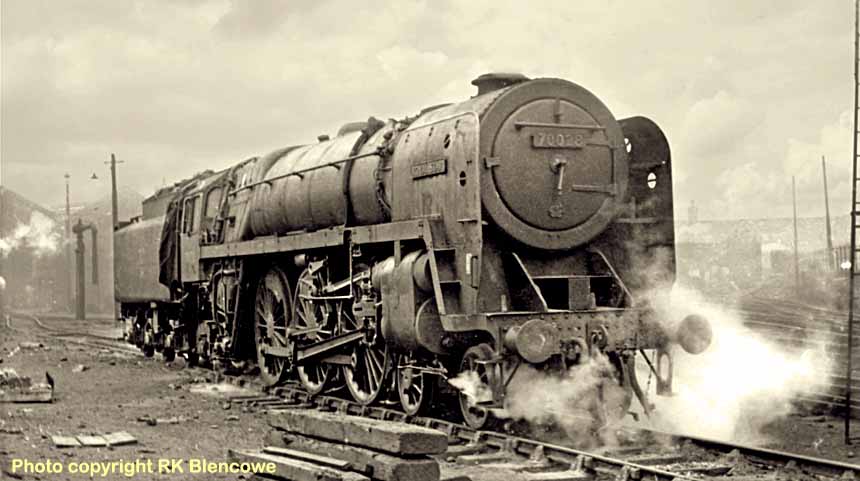
(Above-Below) The sad demise of the steam locomotive is all too apparent from this shot of Crewe-based Britannia 4-6-2 70028 Royal Star amidst the debris-strewn yard at Carlisle Kingmoor MPD (12A) early in 1965. The engine looks to be in a very bedraggled state at this time, but records suggest that the Britannia had not visited the Workshops since March 1962 although that would be corrected in August 1965 at Crewe Workshops, where the ex-WR locomotive was constructed. In total 50 Britannias were, at one time or another, allocated to Carlisle Kingmoor MPD (12A), but on this date there were just 16. (Below) A quite smart-looking Britannia rests at Ulverston Station, as Crewe South-based 70028 (formerly Royal Star) waits for the starting signal to continue the journey on towards Carnforth in October 1965. The main station building is on the left. The little platform to the right of 70028 is where the TPO from Whitehaven used to pick up the mail during the late 1980s…my thanks to Ian Henderson for additional information. For the record, 1965 is the same year that Ulverston-born Stan Laurel (1890) passed away, giving rise to the unveiling a statue in the town to commemorate Hollywood's finest comedy duo, Laurel and Hardy, in 2009.

SIGHTINGS: The first sighting of the Britannia was, in fact, when on loan to the Southern Region, the locomotive was viewed leaving Salisbury for Waterloo Station in June 1953; most notable was the handrail of the offside smoke deflector had suffered a very heavy knock creating a sharp kink in the tubular section of the rail. 70028 was seen at Old Oak Common early in its career as a top-link express engine, having brought a morning express from Cardiff; noteworthy was the absence of a 'red spot' on the cabside which was the Western Region's way of indicating weight restrictions; also the extra Southern Region lamp irons were still in position from the loan period between May and June in 1953.
Later that same year, a gleaming, immaculate engine rolled towards the Cardiff General station to take over a London train, and what a credit to the team of cleaners at Canton who had prepared the locomotive in that way, obviously the shed staff favoured the Britannia engines and gave them much time and effort. During the summer of 1956, 70028 was captured on film at Acton West Junction hauling the 'Capitals United Express' past the large goods yards just west of Old Oak Common depot. Then in April 1959 a very smart looking Britannia was viewed hauling a Cardiff-Manchester train comprising a mix of LNER, LMSR and WR coaching stock at Pengam Junction, just east of Cardiff; the engine was snaking its way across three lines to avoid engineering work on Rumney Bridge further to the east. It was also noticed that besides having the smoke deflectors and the front step modified, the exhaust ejector unit had been moved down and the ATC pipework was now visible on the edge of the boiler walkway after refitting at Swindon Works. Following a long period in Swindon Works in 1960, No 70028 was seen with LMS type steps on the rear of the tender which were kept until withdrawal in 1967. A sparkling ex-Works locomotive was pictured leaving Manchester Piccadilly (formerly-London Road) for the south in April 1962, but just a relatively short time later in December that year, a badly stained and neglected locomotive, with a heavily damaged front buffer plate was seen at Lostock Hall depot.
In 1963, the Britannia was borrowed from the Western Division and seen heading south at Sandy on the East Coast Main Line and also at Belle Isle approaching Kings Cross Station, thus during its service life No 70028 was observed hauling express trains into no fewer than five London termini: Paddington, Waterloo, Marylebone, Euston and Kings Cross. The locomotive was also observed in ex-Works condition, with painted buffer faces (but a not-so-clever home-made number plate on the smokebox) at the Derby Works Open Day in September 1966.

(Above) A bedraggled-looking 7MT Britannia No 70028 heads a van train south from Preston's platform 2 on the avoiding lines at the west side of the station in 1967; in the distance is Preston 1A signal box which straddled the single-line Preston Dock branch that emerged on a steep 1 in 29 gradient into the middle of the station. Preston Dock has subsequently become the focus of the Ribble Steam Railway, opened in 2005 in the heart of Preston's historical industrial docklands.
DISPOSAL: Withdrawn on Saturday 16th September 1967 to Carlisle Kingmoor yard, stored until January 1968 and then transferred to J.McWilliams of Shettleston to be cut up, from January 1968. Shettleston is a suburb ofGlasgow, being just over three miles to the East of the City Centre.
Programme was authorised on the 4th January 1951; built at Crewe and completed on 8th November 1952, to Order No E483/228 Swindon 403 costing £22,734. The additional part of the order number relates to the request by Swindon Works to fit Western Region lamp irons and the Automatic Train Control equipment with in-frame pipework; this raised the cost of construction slightly compared to the LMR Britannias. 70029 was withdrawn on Saturday 21st October 1967 from Carlisle Kingmoor.
ALLOCATIONS: 70029 Shooting Star was the final BR Britannia to be allocated to the Western Region, making 15 Pacifics in total; after completion of trials the engine joined classmates 70025 to 70028 at Cardiff Canton depot. Its residency at 86C lasted until September 1961, albeit this was briefly interrupted by a one month loan to the Southern Region at Exmouth Junction shed (72A) to cover for SR Pacifics in June 1953. Aston depot (21D) was next in line; this lasted for a little over three years followed by a brief spell at Carlisle Kingmoor (12A), then Carlisle Upperby depot (12B) for two years before returning to 12A in December 1966 where it served its last eleven months before ultimate retirement.
(Below) BR Standard 7MT No 70029 'Shooting Star' is pictured at Caldicot, approaching to the Severn Tunnel from the Welsh side. Of special note is the additional Southern Region lamp iron fitted at the offside front in May 1953; this caused the headlamp to be set further back compared to the other. This scene from April 1954 reflects the excellent regard that Canton had for their small stud of Britannias and shows the fireman at ease having set his fire right for the three mile climb out of the tunnel to Pilning. Behind the cameraman is Caldicot Halt Station, while the two bracket signals behind the train control the lengthy goods loops, the first added in 1901, the second in 1942 to help cope with heavy wartime traffic.

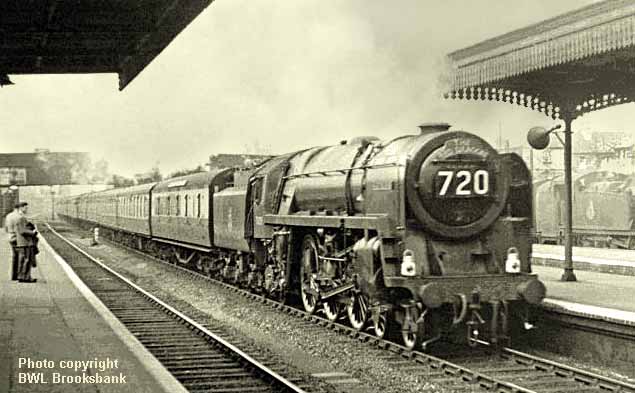
(Above-Below) The sumptuous sight of a Brunswick Green-liveried Britannia sweeping through the suburban station at Slough must have stayed long in the memory. Here 70029 'Shooting Star' makes progress towards London Paddington at the head of the 'Red Dragon' in April 1955. The beautifully prepared engine is a credit to the staff at Cardiff Canton depot; the additional Southern Region lamp iron on the nearside deflector stay was fitted during its brief loan to Exmouth Junction shed (72A) to cover for the SR Pacifics during summer of 1953. (Below) Steam days at Newport Station on 10th October 1958. Newport was one of the busiest railway stations in Britain, with about 250 trains daily, two-thirds of which consisted of freight traffic originating from the South Wales coal mines located in the Eastern and Western
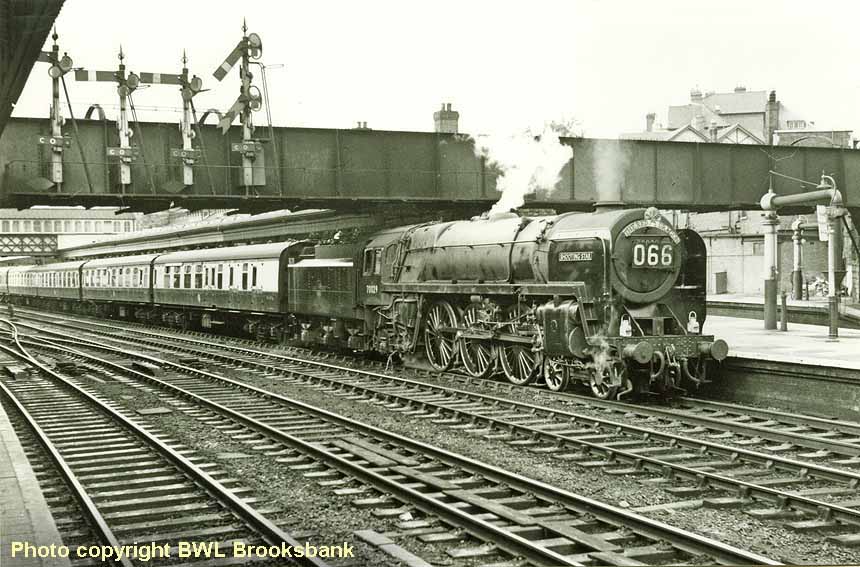

(Above-Below) In 1956 Cardiff Canton's stock of Pacifics increased threefold from five to fifteen, but this was reduced to twelve in 1958 when Nos 70015, 70017 and 70021 were transferred to the Midland Division based at Trafford Park to assist with services to London St Pancras while electrification of the West Coast Main Line was in progress. Cameraman Alec Swain took this photo of a well-cleaned 70029 Shooting Star at Canton shed in April 1959; note the LMS type tender step, the new BR emblem incorrectly facing to the front and the cover missing from the cylinder head, possibly awaiting spares. Keeping company with 70029 is local engine GWR 'Hall' Class 6958 Oxburgh Hall, soon to be withdrawn plus 'Castle' Class 4-6-0 No. 5010 Restormel Castle from Old Oak Common depot and a 'County' Class 4-6-0, none of which were ever allocated to Cardiff Canton, albeit regular visitors to the shed. (Below) On a rather grey July day in 1960 RJ Buckley captured this lovely scene at Cardiff General station of BR Standard Britannia 70029 Shooting Star awaiting the arrival of the early morning train from Fishguard Harbour which the engine will then take on to London Paddington. The train reporting number A58 was part of the new train identification system devised to help signalmen distinguish an approaching train. The system was meant to start in 1959, but due to a shortage of 250 frames and 1,500 plates required, it wasn't fully operational until June 1960; the 'A' denoted a train to Paddington and class '1' referred to an express passenger train, duplicated here by the headlamp code on 70029's buffer beam. The tender has an LMS type step and now has the correct version of the BR emblem applied.
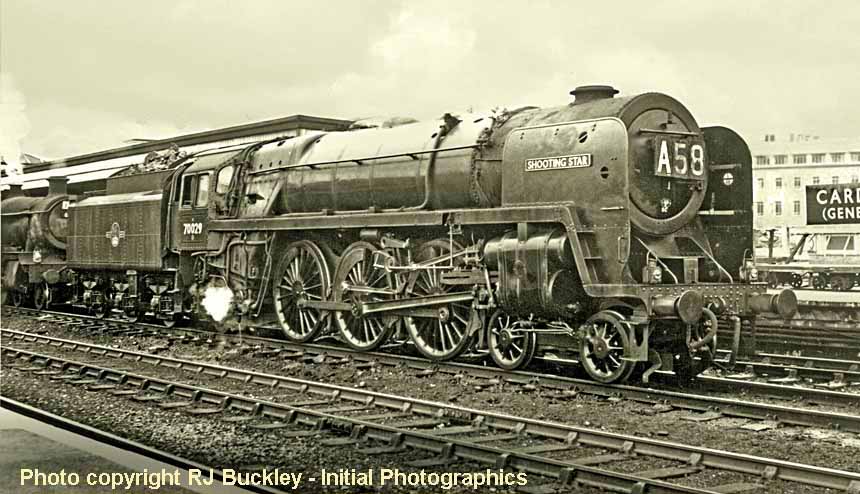
MODIFICATIONS: As mentioned on the opening line above, almost two years elapsed from the initial build authorisation to actual completion, thus many changes were implemented during that time; this comprised the Axle repairs (item 17) which included the four plain coupling rods (item 14), plus the tender step (item 10) was fitted and a steady bracket for the front regulator rod (item 5). The only noticeable early changes to 70029 was the flexible cab sheet (item 9) which was added to prevent draughts between the cab and the BR1A type tender; this work was completed by Swindon Works in May 1953, plus extra lamp irons were added that same month by the Southern Region to accommodate their disc headcode system. Much later, in October 1956, the exhaust ejector (item 4) was fitted with a solenoid, with the cabling back to the cab as fitted by Swindon Works to try to improve the steaming of the Britannia; this work was carried out following complaints from Western Region crewmen. The next scheduled maintenance was done at Crewe Works and included a full platform front step (item 1), the new BR emblem (item 11) added to the sides of the tender and the original LNER return crank (item 15) was substituted with a LMR type with four bolts fixing the crank to the centre drive wheel. At the same time the rear support bracket for the regulator rod (item 7) was fitted and the nearside lubrication rod (item 18) was shortened to try to deliver more atomised oil to the valves and cylinder. 70029 was coupled to a BR1A tender from new, which allowed room for 5,000 gallons of water and 7 ton coal capacity, and was readily recognisable by virtue of the tall raised dome over the water pick-up and the Western Region version of the tender step, i.e. more weld points (see page 90 for full explanation). For a period of almost two years throughout 1959 and 1960, 70029 had the more usual BR1 type of tender (off 70024 Vulcan) which was fitted with a similar high dome, but having the LMR type step rather than the more open Western Region version. The locomotive reverted back to the BR1A tender for the remainder of its service. 70029 was one of the five engines fitted with the LMR 2 Type smoke deflectors (item 3); these had the two single cut-outs without backing cups, unlike the LMR 1 type as fitted to 63% of the engines affected by the change. When all of the twelve remaining Britannias were ousted from Cardiff, the ATC equipment (item 20) was removed and the additional solenoid fitted to the exhaust ejector unit was reclaimed. The pipework for the ATC was fitted in-frame from new, but this was renewed in 1958 along the full length of the boiler walkway then when the AWS (the LMR version) system was added by Crewe Works early in 1963, the relevant pipework ran only as far as the lubrication pump, from where it was routed quite differently. 70029 was never fitted with a speedometer (item 13), but it did receive the power warning plates (item 19) in 1961 after its transfer to Aston depot where the engine worked in areas of the newly-erected overhead electrified wires. The ex-GWR lamp irons (item 2) were changed by Aston depot to LMR types over the buffer beam, but the one fitted at the top of the smokebox was left in position, and remained so until October 1964 when the lamp irons were repositioned. Meanwhile the extra lamp iron fitted by the Southern Region during its 1953 loan period was still clearly visible on the nearside front lower deflector stay.
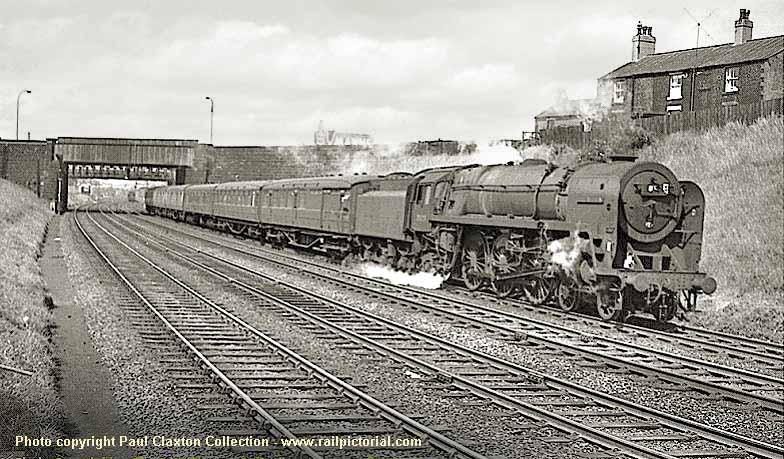
(Above-Below) In July 1962, Paul Claxton encapsulates a rather untidy Britannia Class No 70029 'Shooting Star' passing Skew Bridge near Preston with a semi-fast express to Birmingham comprising a mixed bag of coaching stock, including a Gresley Coach Brake End immediately behind the tender. The engine has rather lost its initial sparkle that was very evident when it first moved to Aston depot 10 months earlier…possibly the novelty of their Pacific engines has waned for the running staff. (Below) Just five months before closure of the ex-Lancashire and Yorkshire Railway depot at Blackpool Central in November 1964, Paul Claxton captured this image of Aston (2J) allocated BR Standard Pacific 70029 'Shooting Star' brewing up for its next duty, in company with 'Black 5' 45421 and two class 31 Diesels. It is worth noting that the original GWR type lamp iron still remains above the train identification code on the smokebox door and the foreground shows the broken brickwork highlighting the dereliction of the depot that was rebuilt only six years prior.
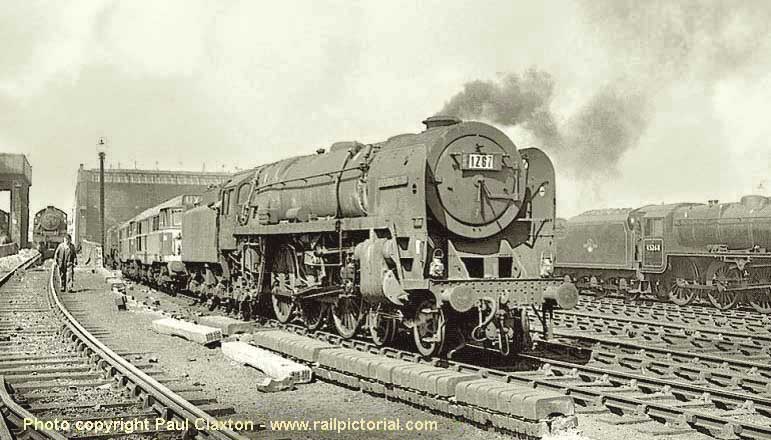
SERVICE RECORD: 70029 joined forces with three other Pacifics at Cardiff Canton depot (86C) where they were regularly employed on the top-link South Wales expresses to London Paddington. At the time 70025 'Western Star' was performing load tests at the Locomotive Testing Station at Rugby, leaving only 70026 'Polar Star', 70027 'Rising Star' and 70028 'Royal Star' operational. The subsequent return of 70025 in May 1953 increased Canton's allocation to five of Pacifics, but this number was short lived following a request by Southern Region Executive Committee for the loan of seven Britannias to help fill in the gaps of its fleet due to the removal of the SR Bulleid Pacifics from service for axle examinations. Both 70029 and 70028 were duly called upon to work from Nine Elms and Exmouth Junction sheds respectively during which 70029 hauled the famous 'Bournemouth Belle' Pullman express train from Waterloo. The loan period on the SR lasted 26 days therefore all five Cardiff Britannias were able to regroup in readiness for the WR's 1953 summer services. 70029 Shooting Star was a regular performer on the 'Red Dragon', taking over the 07.30 train from Carmarthen at Cardiff to form the 10am departure to London Paddington, returning with the 3.55 to Cardiff - a train later named the 'Capitals United Express' in 1956. All the runs made between Cardiff and London involved the use of the four mile long Severn Tunnel which was inclined at 1in 100 for three miles, including the approach to the tunnel on the English side and 1 in 90 on the Welsh side of the tunnel. Recorded mileages were of good average with almost 70,000 logged for its first full year and an average of 58,000 miles for the years 1954 to 1959, but falling to 35,500 miles in 1960 though this was partly due to the four months it spent out of service and under repair. Five visits to Swindon 'Factory' were recorded with a further five trips noted to Crewe Works for repairs and maintenance.
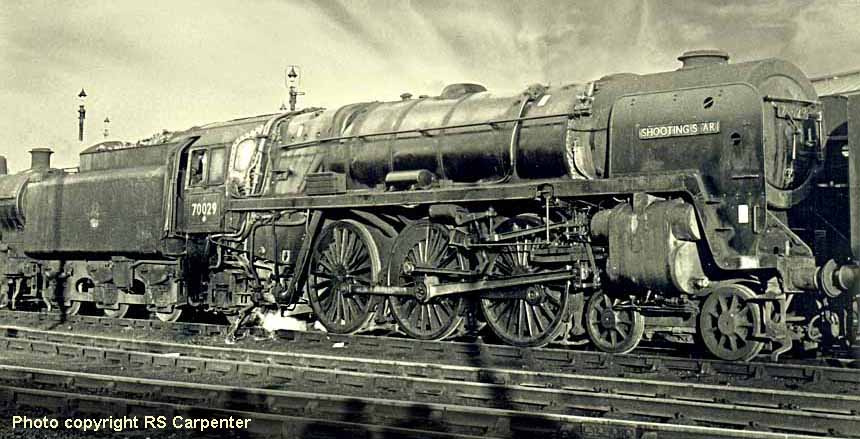
(Above-Below) The low winter sun casts long shadows of attendant cameramen at Carlisle Upperby Motive Power Depot as they photograph BR Standard 70029 'Shooting Star' being prepared for another outing in November 1964. The additional vacuum reservoir for the AWS braking system is prominent on the boiler walkway; this cylindrical fitment is very reminiscent of the type used to good effect on the earlier 'Patriot' Class. It would appear that some spirited enthusiasts have done some rapid, but strenuous cleaning of the locomotive as shown by the sheen on the boiler lining. (Below) The original loco shed at Patricroft in Greater Manchester was constructed in 1884 and the 10-straight track shed was added in 1903; this can be seen behind a 'down at heel' Britannia Pacific 70029 'Shooting Star' being turned in readiness for a return to its home shed of Carlisle Upperby (12B) in November 1964. The engine only received the AWS equipment the previous year and now has the lamp irons repositioned, but it still retains its original nameplates. Local man WD Cooper captured many similar scenes right up to the end of steam.
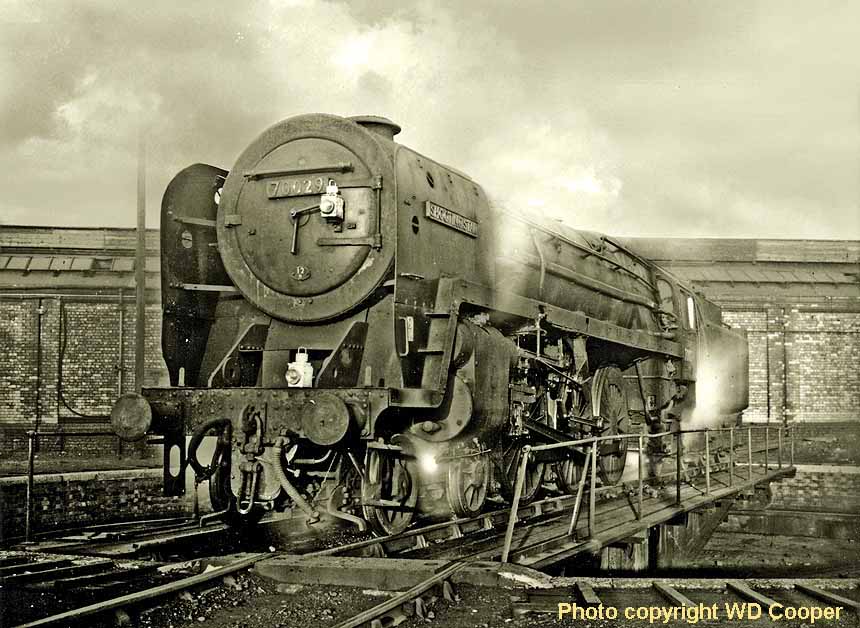
SIGHTINGS: 70029 Shooting Star was seen at Cardiff Canton depot, flanked by classmates 70027 'Rising Star' and 70028 'Royal Star'; three new charges being prepared for their relative duties, with 70027 and 70029 showing reporting numbers indicating trains to the Northwest which the Britannias would take as far as Shrewsbury. As mentioned above, during its short spell on the SR, 70029 was a regular sight at London Waterloo Station for almost four weeks from the end of May 1953; the locomotive hauled the 'Bournemouth Belle' Pullman train on more than one occasion and was observed at Southampton Central Station ready to depart with the afternoon train back to Waterloo; at least three extra lamp irons had been fitted to accommodate the Southern Region's extensive number of white disc headcode displays. Upon returning to the WR, both Britannias soon settled down to work the top-link trains into Paddington; 70029 was seen in September 1955 departing the Great Western terminus with the 'Red Dragon' displaying the reporting number '173' destined for Carmarthen, but the engine would most likely come off at Swansea, certainly as no extra coal has been added to the tender, as was the normal practice for the Cardiff Britannias. 70029 Shooting Star was seen hauling the 'Red Dragon' in 1956 and the new redesigned headboard was on show, sporting a 'rampant red lion' at the centre of a semi-circular cast-iron plate displaying the title name on a cream background. Also a dedicated set of chocolate and cream BR Mk 1 coaches were newly built in 1956 solely for use on the restaurant express from Carmarthen to London Paddington.
A very enterprising overhead image was captured of 70029 being turned at Ranelagh Bridge yard in November 1957, showing a reporting number '174' indicating a Swansea destination, now sporting a full front step and having a new BR logo on the tender, but incorrectly facing to the right. In addition to the South Wales-London expresses, Cardiff Canton's Britannias were well used on the West to North services, such as Swansea/Cardiff to Manchester/Liverpool, which the Pacifics hauled as far as Shrewsbury where they were replaced by a London Midland engine. After such a trip In September 1959, '70029' was viewed at Shrewsbury MPD showing a reporting number of '952', displaying a lack of cleaning and the loss of the cover for the right-hand cylinder head, exposing the many studs to the elements. Such are the vagaries of the BR Standard modifications that we should not be much surprised by any odd changes, but '70029' was showing the two support brackets (items 5&7) on the regulator rods when viewed at Ranelagh Bridge in August 1958, then with just one fitted in 1960, but then both were back in unison after repairs at Crewe early in 1962. In April 1960, 70029 'Shooting Star' was observed at Pontsarn, just west of Cardiff, hauling the Paddington to Fishguard Harbour express, with connections by boat to Cork in Southern Ireland. This was the normal return train for the engine that took the 'Red Dragon' express to London. Prior to the exodus of the Britannias from their South Wales home in 1961, a grubby 70029 was photographed in the shed yard in front of the straight shed at Canton (now 88A); the loco was facing west indicating that it had run up a high mileage since its last maintenance, thus it was scheduled for the shorter run to Swansea rather than London. In June 1962, a begrimed 70029 was pictured working a southbound freight on the 1 in 98 incline of Lancaster Bank; by this time the engine was allocated to Aston depot, easily recognisable by the silver 'highlights' on the smokebox. Over the subsequent five years, however, relatively little was seen of the engine and you could almost say that the Britannia was 'camera shy', but it was seen in good condition whilst working a northbound freight of loaded hoppers at Ribblehead in April 1967.
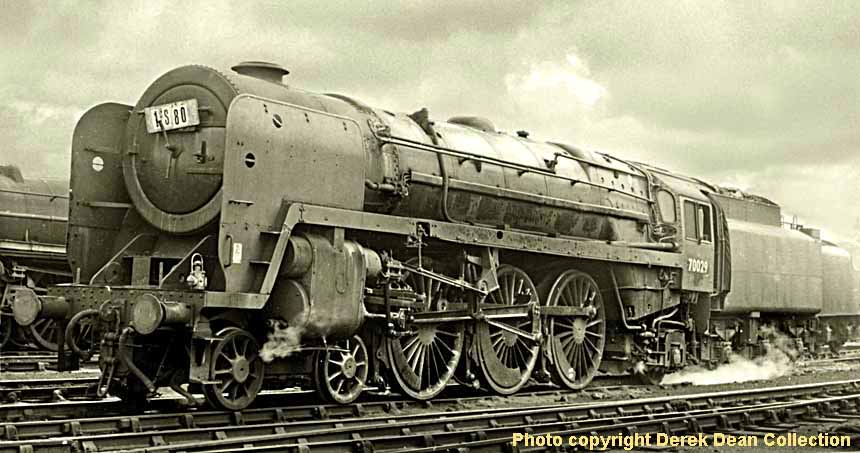
(Above) In the early part of 1966, a very presentable Britannia 7MT 70029, albeit now devoid of nameplates, stands at Carlisle Kingmoor depot, coaled and ready for another duty; this was one of the 25 Britannias allocated to 12A at this time. The inherent Western Region signs are still to be seen; the exhaust ejector remains in the lower position and the smoke deflectors show the Swindon version (LMR 2) consisting of two backless cut-outs, and the tender remains a BR1A type.
DISPOSAL: Withdrawal took place on Saturday 21st October 1967 from Carlisle Kingmoor. The engine was placed in store until the end of February 1968 before being transferred to J.McWilliams of Shettleston for scrapping in March 1968. Shettleston is a suburb of Glasgow, being just over three miles to the east of the city centre. (still under construction)
Built at Crewe Works, completed on 19th November 1952, to Order No E483/228, costing £22,573. Withdrawn on 25th June 1966 from Wigan. Disposal took place on 24th August 1966.
ALLOCATIONS: 70030 was moved around a great deal in his early days, although two moves were loan moves. First allocated to Holyhead MPD (6J) for just five weeks, he then moved to Longsight MPD (9A) for three short weeks, before a loan period beckoned at Leeds Holbeck MPD (20A). This lasted just three weeks and so by 7th February 1953 he was back at Longsight shed again.
The next move on the agenda was to Dover MPD (74C) in order to assist the Southern Region while the Merchant Navy class were stopped for axle fault checks; this loan lasted six weeks from 4th May 1953 to 20th June 1953, after which 70030 was back at Longsight for a third time, but after a month he was allocated to Norwich Thorpe MPD (32A) from 21st July 1953 until 14th September 1958, followed by a move to Yarmouth South Town shed (32D) for a short time until returning to Norwich MPD on 25th January 1959. On the 11th June 1961 70030 moved to March MPD, joining 18 other Britannias that had first worked on Great Eastern metals. The next move for 70030 was to Crewe North MPD (5A) on 6th July 1963; this lasted for a period of nearly two years up to closure of 5A to steam and he moved to Crewe South MPD (5B) on 19th June 1965. Finally 70030 was allocated to Carlisle Upperby MPD (12B) situated on the west bank of the River Petterill, where he completed his career.

(Above-Below) Two stunning images from the Archives of Rod Blencowe - Rod's email address can be found at the foot of the page. The first shot shows 70030 William Wordsworth ready for the off at London Victoria station on a Boat Train working to Dover. As mentioned above, No 70030 was sent from Longsight shed (9A) on loan to the Southern Region in early May 1953. The loco looks in a poor condition externally, but is soon put right by the cleaning gang at Stewarts Lane MPD (Below) as can be witnessed in this image of a relatively new 'William Wordsworth' at Folkestone in May 1953. 70030 was loaned to the Southern Region in the wake of the Bulleid Pacific engine's axle failure, hence 70030 is sporting a Stewarts Lane (73A) shedcode and extra lamp irons to accommodate the route identification discs as used by the Southern Region. The loco is being turned in readiness for hauling a Boat Train on the return journey to London Victoria.
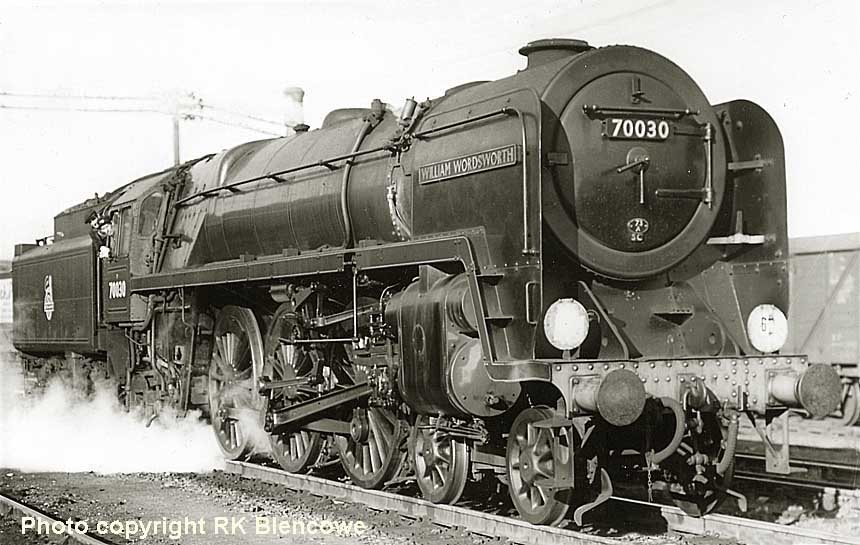
MODIFICATIONS: 70030 was completed 13 months after 70024 'Vulcan', this was quite simply down to an acute shortage of steel following on from World War 2, but that said, the interim period gave the Works the opportunity to apply the modifications that had been found to be necessary during the service period of the previous engines. These amounted to 5 items: item 9 - the flexible screen was fitted at this time, helping to prevent draughts at the back of the cab; item 17 - the hollow axles were 'plugged' and the wheel bearings seated correctly; item 16 - the sand box lids were raised from new and were now three in number; item 8 - the reverser recuperating spring was contained from new; item 5 - the steady bracket was fitted to the forward rod of the regulator from new. Allied to these changes, we should note that the lamp irons (item 2) were of LMR type; the plain couplings (item 14) were added as part of the Axle repairs; and the tender step (item 10) was added from new also.
The balance weight on the centre drive wheel is smaller than on previous engines; covering seven wheel-
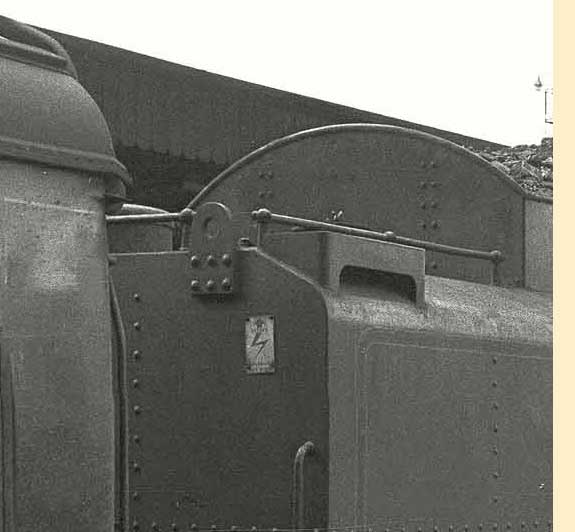 spokes instead of eight as previously seen. Also the modified sand boxes - now three instead of the previous two - allowed for easier routing of the pipework, and therefore better delivery of the sand to the drive-wheels. The original tender step (item 10) was of the Western Region type (see inset left) which I believe was intended for 70029's tender, but appeared on 70030 instead, and subsequently changed with that of 70006 Robert Burns while the two were in Doncaster Works together. Thus from November 1956, 70030 was seen with the LMR type tender step, which he kept throughout.
spokes instead of eight as previously seen. Also the modified sand boxes - now three instead of the previous two - allowed for easier routing of the pipework, and therefore better delivery of the sand to the drive-wheels. The original tender step (item 10) was of the Western Region type (see inset left) which I believe was intended for 70029's tender, but appeared on 70030 instead, and subsequently changed with that of 70006 Robert Burns while the two were in Doncaster Works together. Thus from November 1956, 70030 was seen with the LMR type tender step, which he kept throughout.The full front step (item 1) modification was seen when 70030 emerged from Doncaster Works on 30th November 1956; followed by a change to the smoke deflectors (item 3) to LMR 1 type, and a new British Railways emblem, both seen on the 13th May 1958. Subsequently the AWS (item 20) equipment was added to 70030 while under repair at Doncaster Works during January 1959; also the power warning plates (item 19) were fitted for safety reasons. Later on, in May 1960 the speedometer unit (item 13) was added during a Doncaster Works visit; and could be seen after 1964 with the lamp irons (item 2) moved to new positions, again for safety reasons involving the overhead live-wires, which by now was fitted all over the railway system. The LNER Return Crank was not required to be changed during the service history of 70030; also the regulator rear rod support bracket (item 7) made its appearance later on in 1963, and was most likely fitted when away at Crewe Works during October of that year.
SERVICE RECORD: 70030 William Wordsworth began his career working from Holyhead MPD (6J) along with 70031, 70032 & 70033, but it was said that the seven ton coal capacity of the BR1 tender was insufficient to haul the 'Irish Mail' express up to London and return to Holyhead. Thus he was loaned to Leeds Holbeck MPD (20A) and from here 70030 performed on two brake performance tests; the first on Sunday 18th January 1953, when 70030 hauled forty loaded 16-ton coal wagons coupled to a goods brake van and a dynamometer car on the Midland main line. The second test was done on Sunday 1st February 1953 in similar fashion, utilising thirty-five loaded 16-ton coal wagons, again on the Midland main line towards London.
Soon after these events, 70030 was loaned out to the Southern Region, operating from Dover MPD (74C) as initial cover for the loss of the Merchant Navy Class 4-6-2 Pacific 35020 Bibby Line, which had succumbed to Axle failure at speed at Crewkerne Station. The loan lasted until all the Merchant Navy Class had been checked and returned to service; the date being 20th June 1953, a loan period of six weeks. But shortly after, 70030 began his stint on the Great Eastern Region being allocated to Norwich, and soon saw service on such trains as 'The Broadsman' and 'East Anglian'. William Wordsworth entered Doncaster Works on at least seven occasions, and was seen in Crewe Works four times for repairs and upgrades.
Recorded mileages for 70030 were; 1953 - 69,600 miles; 1954 - 72,410 miles; and 1955 - 75,420 miles. The 1955 figure is not excessive, but it is a good average for a Britannia class on Great Eastern metal; also taking into account a four week period spent at Crewe Works and Sundays being rest days normally, then the average mileage for the remainder of the year was 1,800 miles per week.
70030 continued to give good service from Norwich shed, without any known defects affecting his availability, continuing on express passenger trains and night freights. After allocation to March MPD (31B), he continued on some passenger jobs, but hauled more and more parcels and freight turns. He was then seen in open storage for more than four months until transfer to Crewe North MPD (5A) during July 1963. 70030 now had less than three years of service remaining and increasingly less work was found to keep the locomotive occupied; also the exterior condition deteriorated rather rapidly.
(Below) This view of Ely Station looking SW towards Cambridge and London on the ex-Great Eastern London to Cambridge and Norwich main line was taken by Ben Brooksbank; 70030 William Wordsworth heads the 09.09 Liverpool Street - Cambridge - Norwich - Yarmouth (Vauxhall) express on 16th August 1958. Note use of white discs and not headlamps, and the somewhat aged coaching stock.
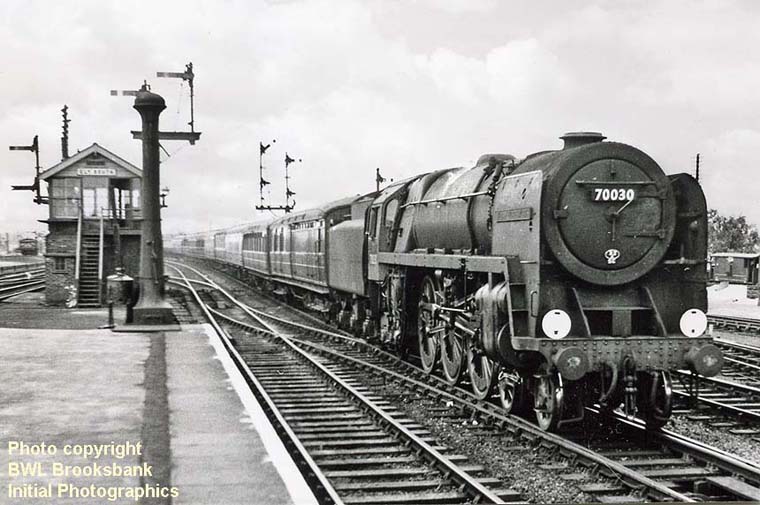
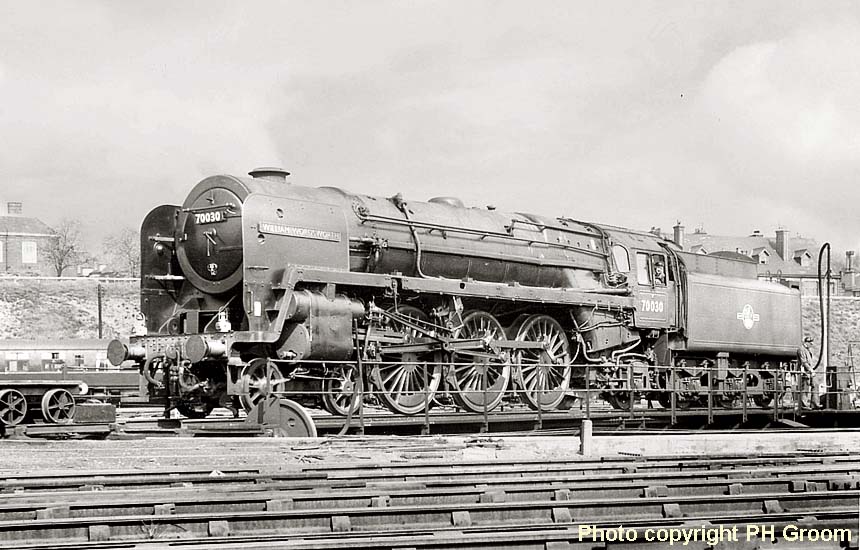
(Above) This fine image was taken by Peter Groom and shows 70030 'William Wordsworth' being turned on the vacuum-operated turntable at Norwich Thorpe MPD on 10th April 1961. The loco now displays a speedometer, AWS equipment, and very clean paintwork. The shedcode is clearly still 32A for Norwich MPD; 70030 did not move on to March MPD until June 1961.
SIGHTINGS: 70030 was first viewed at Crewe Works in pristine condition and safe to say a 'never to be seen again condition', with short lamp irons (item 2) and noticeably, no shedcode; while in February 1953 (three months old) he was seen enduring a braking test on the midland main line, hauling loaded coal wagons. The next sighting came about due to transfer to Dover MPD, covering for the withdrawn 35020 'Bibby Line', 70030 was pictured hauling an express from Dover Marine bound for London Victoria, at Shortlands Junction, in Kent. 'William Wordsworth' was then seen in ex-works condition, standing out from the crowd at Liverpool Street station, in December 1956, and having undergone a change in appearance; the front step (item 1) was now a fully modified type to assist the fireman in placing a headboard onto the top iron position. When next seen at London Liverpool Street station, in October 1958, 70030 had newly fitted smoke deflectors (item 3) designed to LMR 1 type, the most commonly seen variety (25 out of 39 altered), and seen with the new British Railways emblem on the tender, and altogether looked very smart. In direct contrast to that our next view sees 70030 in a very shabby state, backing out of Liverpool Street station in June 1959, proving that no time could be found to do any cleaning in the busy summer months. Few pictures of 70030 show him on a named express, but on Thursday 24th March 1960 he was seen with the 'Essex Coast Express' headboard in Stratford yard in readiness for the job ahead. All images following this show a very run-down condition, with no care or cleaning done at all; seen at March in open storage - with a number of other Britannias - in summer of 1963; viewed on Carnforth shed with a thick layer of soot all over the engine in 1964; and pictured at Oxley MPD, in Wolverhampton, in 1965 and seen in very poor condition, though typical for the period.
(Below) Another fine Rod Blencowe Archive image, this one captures 70030 William Wordsworth at rest at March MPD (31B) in Cambridgeshire. Unwanted, uncared for and unused for several months, No 70030 is pictured in June 1963 awaiting dispatch to Crewe North shed to restart earning some revenue. Of note are the buckled front end and the missing 31B shedplate.
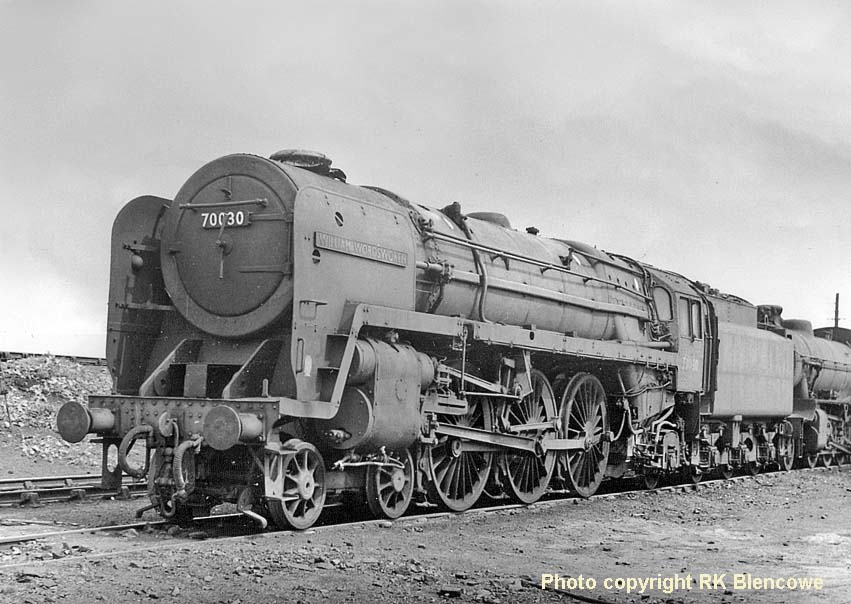
Programme authorised 4th January 1951, built at Crewe Works and completed on 29th November 1952, to Order No E483/228, costing £22,573. Withdrawn on 11th November 1967 from Carlisle Kingmoor.
ALLOCATIONS: Byron was initially allocated to Holyhead MPD (6J), but was found wanting as far as coal capacity was concerned and was moved on to Longsight depot (9A) after only 8 weeks, A brief sojourn to Trafford Park shed (9E) in September 1960 for just 5 months, interrupted what would have been over eight years of continuous service to Longsight, before transfer to Aston shed (21D) in Birmingham during September 1961, lasting until April 1963 at the Midlands shed. After spending 19 months there, 70039 was moved around a lot, as were many of the Class, finding favour at Willesden (1A) until January 1965, when transfer to Crewe North (5A) came about. Crewe Works was the 'birthplace' of the Britannias, but no allocations were granted to either 5A or 5B (Crewe South) until late in 1959 and then a total of 34 of the Class were shedded at Crewe North at various times and 26 of these moved to Crewe South when the former closed to steam. A stay of only one month allocated at 5B was followed by a spell of 17 months at Carlisle Upperby (12B) then ultimately to Carlisle Kingmoor (12A) in December 1966, lasting eleven months in service there before withdrawal came about.
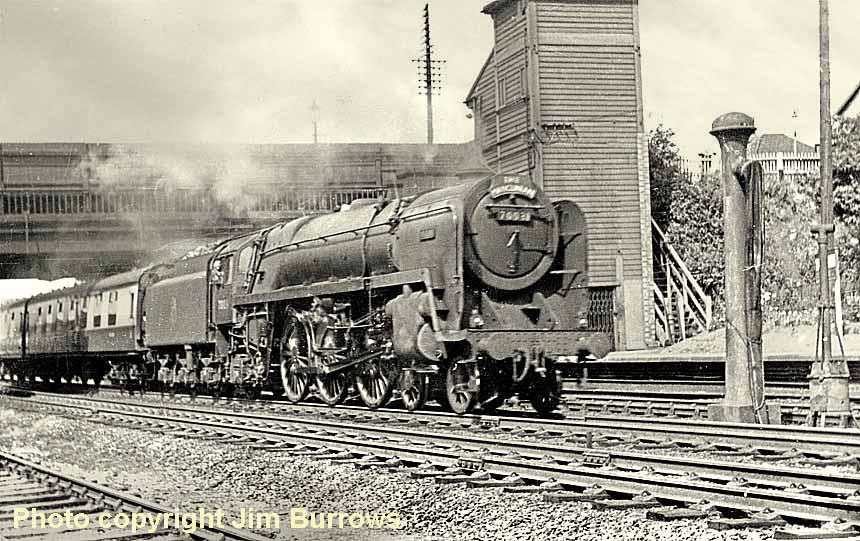
(Above-Below) An early shot of 7MT Class Britannia 70031 Byron by John Burrows, as the rather work-stained engine roars under the Birmingham to Derby line at Tamworth Low Level Station hauling the Manchester-London Euston 'Mancunian' in 1954. This most famous of trainspotting venues was favoured by many schoolboys for viewing the top expresses on the West Coast Main Line, while keeping an eye out for on any movement on the Midland Main Line, with many Jubilee Class engines making their way to Derby and Sheffield. (Below) A well-framed image from E R Morton, surely one of the best and well-known railway photographers of his generation, depicting well-groomed 7MT Britannia 70031 Byron rushing through the now closed station at Madeley in Newcastle-under-Lyme with the Up 'Mancunian'. The station closed to passengers in February 1952, but the station messroom continued to be used from 1962 for BR staff on local colliery trains in the area.
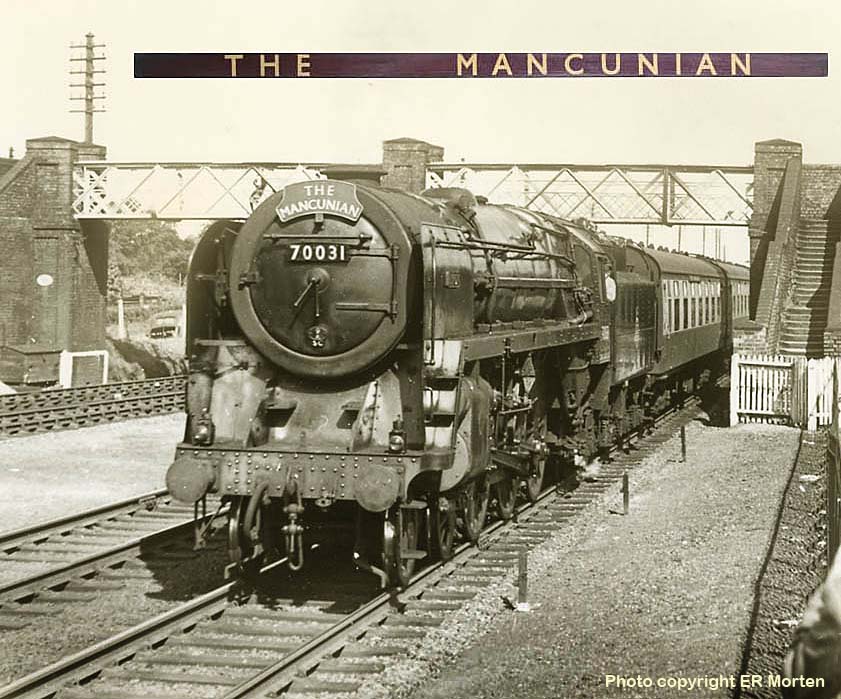
MODIFICATIONS: 70031 Byron was completed almost 14 months after 70024 'Vulcan', because of a real shortage of steel following on from World War 2, but that said, the interim period gave the Works the opportunity to apply the modifications that were found to be necessary, during the service period of the other engines. These amounted to 4 items: item 17 - the hollow axles were 'plugged' and the wheel bearings
 seated correctly; item 16 - the sand box lids were raised from new and were now three in number; item 8 - the reverser recuperating spring was contained from new; item 5 - the steady bracket was fitted to the forward rod of the regulator from new.
seated correctly; item 16 - the sand box lids were raised from new and were now three in number; item 8 - the reverser recuperating spring was contained from new; item 5 - the steady bracket was fitted to the forward rod of the regulator from new. Along with these changes, we should note that the lamp irons (item 2) were of LMR type (short); the plain couplings (item 14) were added as part of the Axle repairs; and the tender step (item 10) was added from new also, but rather strangely this was of Western Region design having more integral support. The three sand boxes gave better results because the pipework was simplified and allowed for easier delivery to the drive wheels.
First seen modification for 70031 was the cab sheet (item 9) which appeared in late 1954. At the same time the original plain coupling rods (item 14) to the rear of the locomotive were switched to the fluted variety as seen on first batch engines in 1951 and most unusually they remained the same right the way through to scrapping of the engine. This was followed by the need to change the LNER return crank (item 15) to the LMR type; this was recognisable by its four-stud fixing on the centre drive axle and was changed by Crewe during November 1956.
Byron was a London Midland Region Britannia from the outset and remained so throughout its service life, which is why the smoke deflectors (item 3) were not altered or changed in any way.
SERVICE RECORD: 70031 Byron would have been initially used on 'The Irish Mail' trains from Holyhead to London Euston, but was found to have insufficient coal supplies to comfortably complete the journey. However, whilst operating from Longsight MPD in Manchester, the runs to London were found to be no problem and certainly there were no steep inclines to overcome, no long drags to surpass, but the Britannia worked side by side with Royal Scots doing the same turns and therefore was deemed no better than the 4-6-0s by many of the crews. That basically summed up the effect of the Britannias on the London Midland Region...they were newer locomotives, but only performed to the same levels as many of the 4-6-0 Royal Scot Class engines to which the crews were more familiar to firing and driving.
70031 is recorded as averaging 60,000 miles for the six years from 1953 to 1958 inclusive, with many of those spent hauling the 'Mancunian' and many similar trains. The engine was always maintained by Crewe Works and made at least ten recorded visits there, which reflected on its good availability and reliability in service.

(Above-Below) A lovely view from Gordon Coltas, depicting Britannia 70031 Byron powering away from Rugby with the Up 'Mancunian' from Manchester London Road to London Euston, a journey made many times by this Longsight-based engine, having spent more than eight years there. The locomotive has recently left Crewe Works, so is still very clean and is sporting a full front step, with a change from all plain coupling rods to plain at the front, but the fluted variety to the rear. (Below) Rod Blencowe presents us with a classic shot of 70031 Byron at rest at London Euston Station after arrival from Manchester London Road at Christmas 1960. The engine has just sounded off that lovely chime whistle and maybe anxious to move off platform 2, but with some carriage doors remaining open the crew continue to keep company with the Type-4 'Peak' class on platform 1.
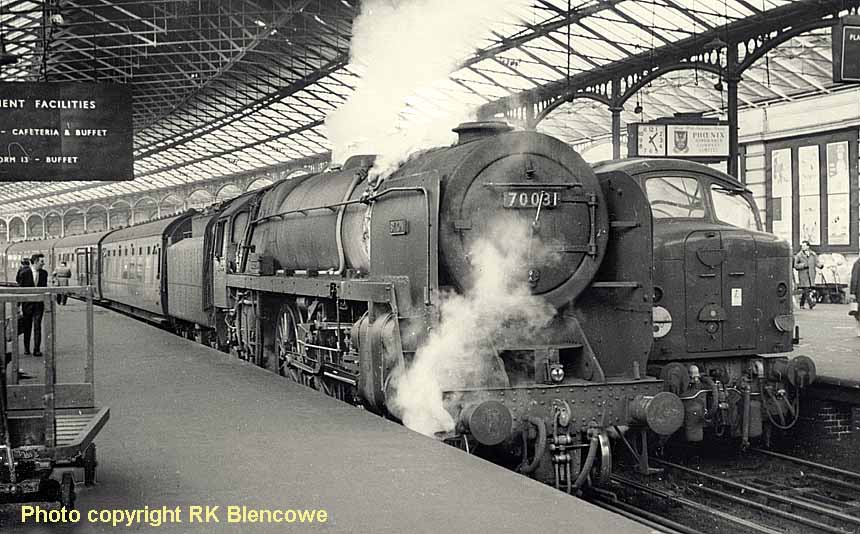
SIGHTINGS: 70031 Byron was mainly photographed hauling 'The Mancunian' along its route to London, or in Euston Station itself, and without exception was depicted as completely in control of the job, but also seen as a work-stained, battered and uncared for engine that had seemingly never seen a cleaner's cloth in all its years in service. One excellent image shows 70031 in recent works condition and with a smart rake of MK1 coaches, waiting at Birmingham New Street Station, in 1955, to return to Manchester London Road Station. The backdrop to the photo shows the old features of New Street; the Queens Hotel, striking, yet stark; the old passenger footbridge still in situ and the familiar Stanier tank engine on a local to Four Oaks, to the northeast of Birmingham. Byron was also seen in quite reasonable condition at Nuneaton heading North with an express from the capital, coping well with 13 coaches on, during April 1958 and showing that the nearside lubrication rod had been shortened to increase the rate of delivery of oil to the cylinder. Our next view of 70031 shows how down-at-heel, downright dirty and somewhat knocked about a steam engine could become, and this only six months after a General Overhaul at Crewe; the engine was heading an express train from Rugby Station to the South. In 1967 the locomotive was seen on two separate occasions double-headed, which was not often required, firstly at Wigan coupled with 70045 (formerly Lord Rowallan) on a long parcels van train and then moving through the Lune Gorge attached with a 4-6-0 Black Five heading a long freight. Finally we see 70031 without any nameplates, but with a false numberplate, shifting vans at Bradford Forster Station in readiness for hauling a parcels train, dated April 1967.

(Above-Below) Another gem from the Paul Claxton Collection shows Class 7MT Byron at Aintree on Grand National day 1962, having brought many excited punters from Birmingham New Street Station to Aintree Racecourse on Saturday March 31st. The locomotive is unusually clean and may well have been prepared by shed staff for this excursion nominated '1Z60', one of many such trains heading for Aintree on such a sporting occasion. The race was won by 'Kilmore' ridden by famous jockey and future National Hunt trainer, Fred Winter. (Below) This is another wonderful image from the camera of engineman Jim Carter, who had the opportunity to record the passing of steam from the footplate for posterity. Britannia 7MT 70031 Byron is viewed at Chester General Station in the summer of 1962, moving off the station and backing down to the shed to refuel. The locomotive from Aston depot in the Midlands has been well prepared by the shed staff, and still has more than five years of useful service left before its demise.
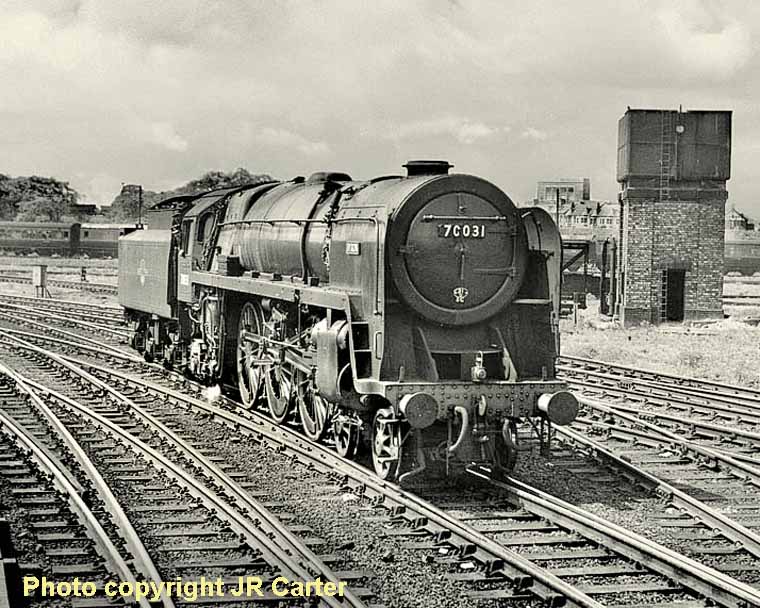
DISPOSAL: 70031 was withdrawn from service on Saturday 11th November 1967, stored at Carlisle Kingmoor yard until the end of February 1968 and then transferred to J.McWilliams of Shettleston to be cut up in March 1968. Shettleston is a suburb of Glasgow, a little over three miles to the east of the City Centre.
Built at Crewe and completed on 10th December 1952, to Order No. E483/228 costing £22,573. Withdrawal was on 30th September 1967 from Carlisle Kingmoor.
ALLOCATIONS: As the listings show, 70032 was a London Midland engine throughout, although Carlisle Kingmoor and Upperby were once of the Scottish Region, by the time the engine was allocated there they were both under LMR control. A stuttered start from Holyhead MPD (six weeks) was followed by a long sojourn in Manchester working the West Coast Main Line to Euston from Longsight shed (9A), until February 1960 when it moved to Trafford Park Loco (9E), but only for just twelve months. Willesden MPD (1A) was the next venue for over three years, up to October 1964 when a move to Carlisle Kingmoor shed (12A) was very soon followed by a transfer across to Upperby (12B) for a period of just more than two years until returning to 12A in December 1966 to finish his service.

(Above) From the large Archives of Rod Blencowe, an image of Britannia 4-6-2 No. 70032 Tennyson, shown easing its train into the terminus at London Euston in August 1953; meaning that the Longsight engine was less than 12 months old and though looking in good mechanical condition, the external state of the engine suggests that the Manchester depot had no cleaners to call on.
(Below) A dramatic capture by CM & JM Bentley reflects a distinctly 'down-at-heel' Britannia No 70032 Tennyson at Crewe after hauling an extra express from London on a cold and murky day early in 1962. The Willesden allocated engine was always a LMR locomotive and as such was not treated any differently to the rank and file Royal Scot class, hauling like for like express trains such as 'The Comet' from Manchester to London Euston.

SERVICE RECORD: 70032 Tennyson was well used in the first year of running, clocking up a creditable 72,000 miles, although that was the highest figure and further years were 52,000 or 64,000 depending on time out for Works visits. So that 70032 was a steady reliable performer, summing up the locomotive to a tea, nothing spectacular, but getting the job done week in and week out. The mainstay of the runs to London was hauling 'The Mancunian' express service from Manchester London Road to Euston, which 70032 would have hauled many times between 1953 and 1960.The ensuing transfer to Trafford Park shed, also in Manchester, meant that 70032 Tennyson was now earning revenue on the Midland lines, but was still routed from Manchester to London on many occasions, but that would have been Central Station instead of London Road and St. Pancras in place of Euston. Also 70032 would have appeared on 'The Thames-Clyde Express' service, and 'The Palatine' on many occasions, substantiating the belief that the Britannia class would have carried more 'Titled-Train' headboards than any other class of locomotive. Tennyson visited Crewe Works a recorded 14 times and did not enter any other different workshops, which would explain why the smoke deflectors were not altered at all (one of 16 Britannias that were not changed). A recorded run from London St. Pancras to Leicester in 1960 showed that 70032 overturned a five minute delay early in the trip to arrive three minutes early at Leicester Station, with speeds over 90 mph recorded on a stretch of eight miles, with a top speed of 99 mph at Flitwick in Bedfordshire.
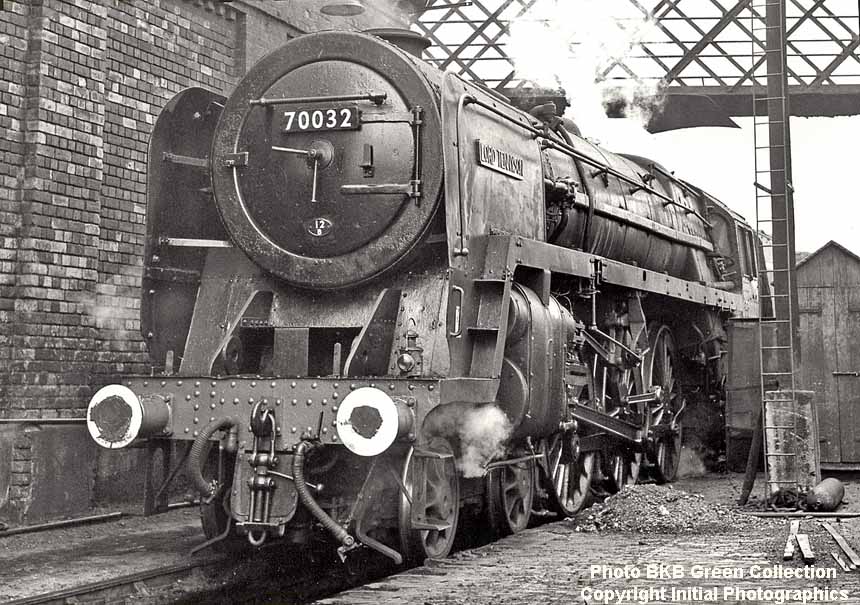
(Above) A good close-up shot from BKB Green for Initial Photographics, showing 70032 at rest at Carlisle Upperby MPD adjacent to the brick built coaling stage, in September 1965. Although the 'Tennyson' nameplates were removed in early 1965, some very good 'Lord Tennyson' plates were made and well fitted by enthusiasts in readiness for a number of Railtours that were planned during 1965, 1966 and 1967 including a number of Scottish Rambler Tours and 'The Granite City'. The ex-Scottish Region shed was formerly an eleven track straight shed which was replaced by a completely concrete open roundhouse structure in 1958.
(Below) Another fine image from Rod Blencowe showing Britannia 4-6-2 No. 70032 (formerly Tennyson) approaching Carlisle Station with a 'Summer Special' possibly a Glasgow to Blackpool extra on a warm day in 1965, with no hint of any exhaust from the locomotive and many 'heads and hands' in view from the carriage windows, it would seem to be very much warm.

MODIFICATIONS: 70032 was completed 14 months after 70024 'Vulcan'...the final engine constructed in the first batch; this was quite simply down to an acute shortage of steel following on from World War 2, but that said, the interim period gave the Works the opportunity to apply the modifications that were found to be necessary during the service period of the earlier engines. These amounted to five modifications: item 9 - the flexible screens were fitted at this time, helping to prevent draughts at the back of the cab; item 17 -
 the hollow axles were 'plugged' and the wheel bearings seated correctly; item 16 - the sand box lids were raised from new and were now three in number; item 8 - the reverser recuperating spring was contained from new; item 5 - the steady bracket was fitted to the forward rod of the regulator from new. Allied to these changes, we should note that the lamp irons (item 2) were of LMR type (short); the plain couplings (item 14) were added as part of the Axle repairs; and the tender step (item 10) was added from new also. The three sand boxes gave better results because the pipework was simplified and allowed for easier delivery to the drive wheels.
the hollow axles were 'plugged' and the wheel bearings seated correctly; item 16 - the sand box lids were raised from new and were now three in number; item 8 - the reverser recuperating spring was contained from new; item 5 - the steady bracket was fitted to the forward rod of the regulator from new. Allied to these changes, we should note that the lamp irons (item 2) were of LMR type (short); the plain couplings (item 14) were added as part of the Axle repairs; and the tender step (item 10) was added from new also. The three sand boxes gave better results because the pipework was simplified and allowed for easier delivery to the drive wheels. The first seen modification for 70032 was the front step (item 1) which appeared in late March 1956 after another visit to Crewe Works, which were generally every two years for major work items. Early in 1958 70032 was back at Crewe for modification of the LNER return crank (item 15) to the LMSR type and was seen with the new British Railways emblem on the tender. During his next visit to Works in September 1959, 70032 Tennyson was fitted with the AWS equipment (item 20) with the pipework positioned 'in-frame' and not down the outer edge of the boiler walkway as seen on a lot of other Britannias. The only remaining modifications to follow were the power warning plates (item 19) in 1960; the speedometer (item 13) during September 1961; the lamp irons (item 2) were repositioned in 1965; and finally the original tender (BR 1) was swapped for a larger BR1D type in the early part of 1967.
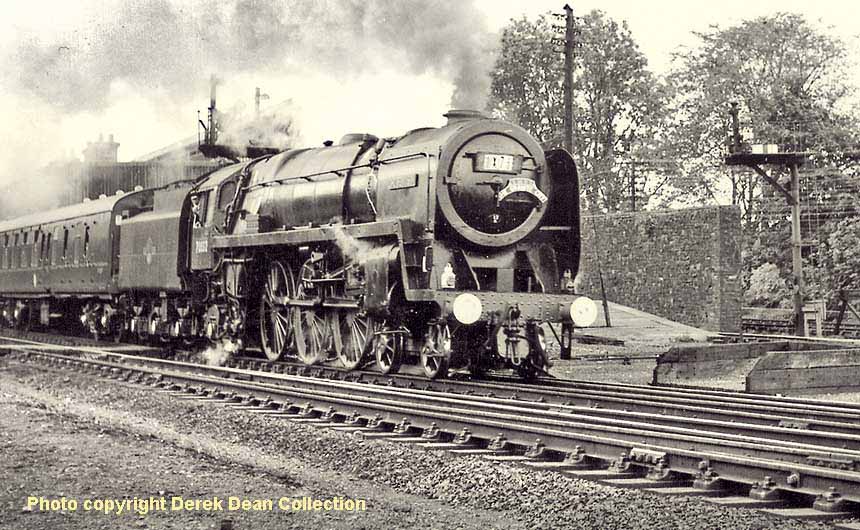
(Above-Below) Well groomed Britannia 70032 'Lord Tennyson' is pictured passing Oxenholme Station en route from Preston to Carlisle with the second leg of the South and West Railway Society Special to Aberdeen, which was set to include haulage by an A4, A2 and V2 amongst others. The tour was given a headboard of 'The Granite City' as seen here and used the Waverley Route to reach Edinburgh and on to Aberdeen, returning via Newcastle and York and finally Kings Cross. The engine was prepared at Lostock Hall MPD, just south of Preston Station. (Below) Another splendid image from the Paul Claxton Collection, this one showing Britannia 4-6-2 70032 Tennyson still with nameplates in position, but looking rather woebegone and worn down, at rest at Carlisle Kingmoor (12A) the last outpost for many of this class of locomotive. The year would be 1964, when there were a total of 23 Britannias on the strength at Carlisle, all looking uncared for and most in need of money being spent on them.

SIGHTINGS: 70032 Tennyson was a familiar site on the West Coast Main Line; as such few photo images have surfaced from which we can select some notable workings. First capture reflects the locomotive sweeping through Nuneaton Station with the inevitable London express and the Britannia was still very new, so was looking in fine fettle. Later in the year 70032 was viewed slowly negotiating the points whilst entering London Euston terminus with 'The Mancunian' express train, showing an engine in good health, but clearly lacking any cleaning and showing slight damage to the off side front corner of the locomotive. During 1954, 70032 was seen on shed at Camden in company with a Princess Royal Pacific, both being readied for their respective return journeys back up to the northwest.
Although the engine had been through Crewe Works in March 1956, Tennyson was to be seen in very poor external condition barely three months later coasting through Blisworth Station, but was in command of the 14-coach train heading to London. In late 1960 the Britannia was viewed awaiting departure from Leeds City Station with the up 'Thames-Clyde Express' working this important train service, which began back in 1927.
In 1961, 70032 was variously seen hauling a fish train through Roade Station; then at rest in Willesden shed yard in April and, most unusually, working an engineers' train at Northampton, engaged in bridge repairs, just two days after release from Crewe Works, and so was in immaculate condition.
Later on the nameplates were removed for safekeeping, but when the engine was selected for a number of Rail tours in 1965, a very good set of nameplates were fitted and these were 'LORD TENNYSON' instead of the original. The engine was cleaned to a fault, the paintwork was refreshed, the buffers were painted white and a special headboard was also made creating a very well presented train.
DISPOSAL: This was made from Carlisle Kingmoor to J. McWilliams of Shettleston in March 1968, after five months of storage at Carlisle.
Construction programme was authorised on the 17th November 1949: built at Crewe and completed on 13h December 1952, to Order No. E483/228 costing £22,573. Withdrawal was onSaturday 30th September 1967 from Carlisle Kingmoor.
ALLOCATIONS: As the shed allocations show, 70033 was a London Midland Region engine throughout its career, and its shed allocations followed a very similar path to that of 70031 and 70032. A stuttered start from Holyhead MPD (6J) of just six weeks was followed by a long stint at Longsight depot (9A) for seven years. It moved to Trafford Park (9E) from the beginning of February 1960 before being transferred to Willesden (1A) at the start of January 1961 until the close of 1962. 70033 then moved to Llandudno Junction (6G) for a short seven weeks; back to Holyhead MPD (6J) for twelve weeks and then a second spell at Willesden in late May 1963. This was followed by the almost obligatory move to Crewe North depot (5A) in September 1963; this lasted until the shed closed to steam in June 1965 and 70033 proceeded to Crewe South shed (5B) for a very short time before moving onto Carlisle Kingmoor MPD (12A).
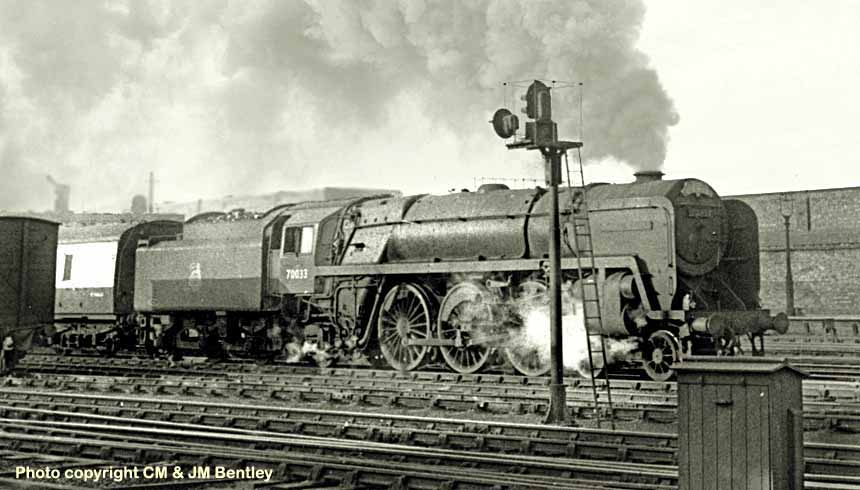
(Above-Below) Inaugurated in September 1932, the Manchester (London Road)-London Euston 'Comet' express last ran as a titled train on Friday 7th September 1962. The name 'Comet' was derived from 'Cottonopolis' (Manchester) and 'Metropolis' (London) and so has little to do with outer space, as one might presume. This shot shows a relatively-new Britannia 70033 Charles Dickens departing Crewe Station with the southbound 'Comet' in 1954. (Below) Seen speeding through the station at Lichfield Trent Valley in June 1958, Britannia 70033 Charles Dickens leans into the curve with a returning Windermere Express. Note the freshly-ballasted fast lines running through the centre of the station; these will very soon pass beneath the high-level lines that connected Birmingham New Street and Burton-on-Trent via Walsall. The locomotive looks to be in fine condition, with no escaping steam and only the cab sheet spoiling the overall image slightly, but it was obviously a very warm day; note the top window vents are wide open on the leading carriage…on such days the cab must have been very hot indeed.

MODIFICATIONS: 70033 was completed 14 months after 70024 Vulcan; this was quite simply down to the post-war shortage of steel, but that said, the interim period gave the Works the opportunity to apply the modifications that were found to be necessary during the service period of the earlier class members. These amounted to 5 items: item 17 - the hollow axles were 'plugged' and the wheel bearings seated correctly; item 16 - the sand box lids were raised from new and were now three in number; item 8 - the reverser recuperating spring was contained from new; item 9 - the flexible screens were fitted at this time, helping to prevent draughts at the back of the cab; item 5 - the steady bracket was fitted to the forward rod of the regulator from new. Allied to these changes, we should note that the lamp irons (item 2) were of LMR type (short); the plain couplings (item 14) were added as part of the Axle repairs; and the tender step (item 10) was added from new also. The three sand boxes gave better results because the pipework was simplified and allowed for easier delivery to the drive wheels. First seen modification for 70033 was the front step (item 1) which appeared in early April 1956 after a visit to Crewe Works, which generally occurred every two years for major work items. 70033 did have two recorded trips to Crewe Works in 1956 and at one of these visits the nearside lubrication operating rod (item 18) was shortened to give better oil feed to the cylinder, piston and the valves. The original LNER return crank (item 15) was changed to the LMR version, which was identifiable by four studs retaining the crank lever, when 70033 next visited Crewe Works in July 1957; also the new BR emblem (item 11) made an appearance on the tender and the regulator rear rodding (item 7) was fitted with a steady bracket to try to eliminate vibration in service. At the next visit to Crewe Works the Automatic Warning System (item 20) was fitted, somewhat belatedly, in April 1959 and even later still the speedometer unit (item 13) was added during its next trip to Crewe Works, in September 1960. Because the Britannia was always a London Midland engine, the smoke deflectors (item 3) were never altered, as Crewe management never believed that the action was necessary, also 70033 was not seen with power warning plates (item 19) until after transfer to Willesden depot (1A), in February 1961, because that was the first time the locomotive would have to pass under electrified wires. The lamp irons (item 2) were moved to comply with Health and Safety issues in November 1964 and the nameplates were removed in late 1965.
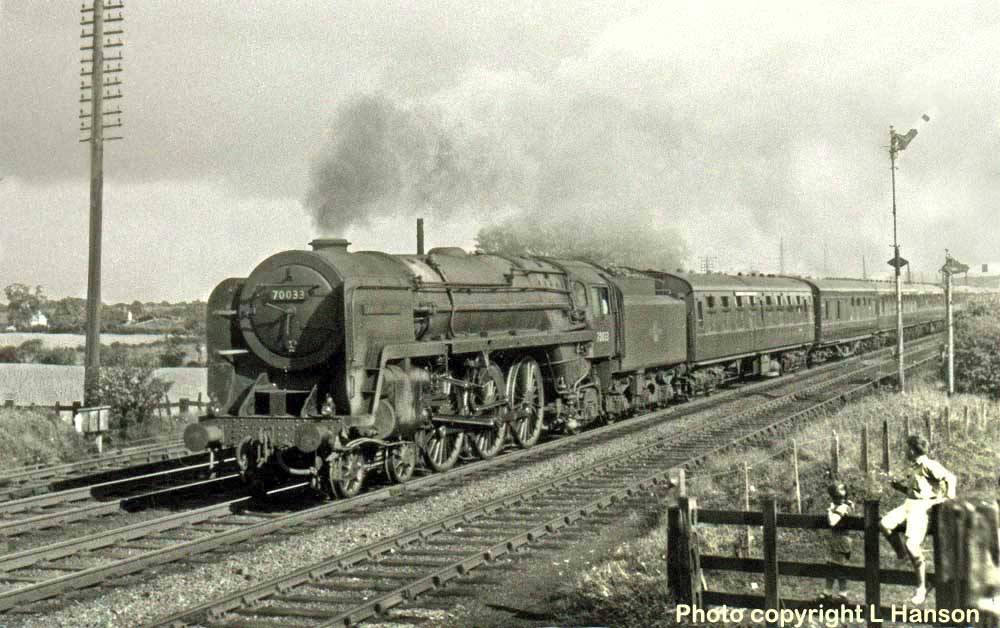
(Above-Below) Under clear signals, Britannia 70033 Charles Dickens heads the up 'Mancunian' express past Gayton loops near Blisworth in August 1958; at this time the locomotive was still allocated to Longsight MPD (9A). This lovely image by Les Hansen captures the delight of two boys, who have maybe been fishing for tiddlers in the nearby cut. (Below) Powering a heavy express up Camden Bank from a standing start at Euston Station was no easy task in steam days, but this fine image from HF Wheeller is not what it appears; the Britannia 70033 Charles Dickens is actually banking a train of empty coaching stock out of the station, hauled by a 2-6-4T. When HF Wheeller took this photo in June 1959 the locomotive was still allocated to Longsight shed (9A) and had recently been through Crewe Works, hence its fine condition and newly-fitted AWS equipment.

SERVICE RECORD: Just a short period of time was spent at Hoyhead depot (6J) where it was used on North Wales Coast expresses to London, however the 7 ton coal capacity of the BR1 tender was found insufficient to complete the round trip of 525 miles to and from the capital, and all four of Holyhead's Britannias - Nos 70030, 70031, 70032 and 70033 - were reallocated elsewhere. 70033 Charles Dickens was soon put to good use at Longsight shed (9A) on the WCML's Manchester-London service, a distance of just under 190 mile; indeed in a good week the locomotive could cover 1,140 miles of six trips up and down to London. However, the five Longsight Britannias were not seen as much of an improvement over the Class 7P 4-6-0 Royal Scots, which, incidentally were coupled to tenders with a 9 ton coal capacity. This basically summed up the effect of the Britannias on the London Midland Region - yes, they were newer locomotives, but they only performed to the same level as the Royal Scots which the crews were familiar with. Recorded mileages did average 59,000 for the years worked at Longsight, with the highest figure shown for 1959, at 67,000 miles.
All maintenance was carried out by Crewe Works and 70033 recorded twelve visits there, which is why 70033 was one of the 19 engines not to have the smoke deflectors modified. 70033 hauled the 'Mancunian' on many occasions, plus the 'Palatine' and 'Comet' between Manchester and London on other journeys. After transfer away from Manchester it is very doubtful that the engine carried another titled headboard, so the service history turned out to be rather ordinary and mundane, certainly unspectacular.

(Above-Below) This is a lovely image from the late Alan H Bryant of a very smart-looking Britannia No 70033 Charles Dickens restarting a Manchester (London Road)-Euston express from Stockport Edgeley in the summer of 1959. The ridge-and-furrow platform canopies were a prominent feature of the station for many years until electrification of the Manchester-Crewe line in 1961; one noteworthy change is the removal of the third upper quadrant signal from the right-hand side of the gantry, possibly in 1957. Meanwhile the locomotive has suffered a heavy knock on the offside front; also 70033 has been fitted with the AWS system as indicated by the large battery box on the boiler walkway, plus a backplate is visible beneath the buffer beam to prevent the screw coupling swinging and damaging the new Automatic Train Warning System receiver fitted behind it. This photo can be found on the excellent 'Rail Photoprints' website…click HERE to view the company's superb photo archive, highly recommended. (Below) An excellent capture of ex-Works Britannia Pacific 4-6-2 70033 Charles Dickens on Willesden MPD (1A), its home shed at this time in June 1962 until the end of the year; the shed also housed 70004 William Shakespeare, 70021 Morning Star and 70042 Lord Roberts during the same period. The large LNWR depot boasted both a roundhouse and 12 track straight shed; 25 Britannias were allocated there at one time or another, the first being 70017 Arrow which arrived in December 1960.

SIGHTINGS: 70033 went largely unnoticed by many photographers and few early views of 70033 seem to be available, but the locomotive was catured arriving at London Euston in a work-worn condition with the mid-morning 'Mancunian' on Saturday 1 October 1955. Nearly two years later, at Chelford in April 1957, the Britannia looked in superb condition when photographed with the 12-coach 'Mancunian' to London Euston; by this time the full front step had been fitted. In November 1958 the Britannia was espied awaiting the right away at Birmingham New Street at the head of the northbound 'Pines Express', and looking every inch the part. 70033 was seen in a very presentable condition beneath William Baldwin's massive trainshed at St Pancras terminus, having arrived with the 07.40 train from Nottingham to London on Sunday 31 July 1960; the engine had been borrowed from Trafford Park especially for the occasion. Pictured in a smart condition coupling up to carriage stock at Birmingham New Street Station, 70033 was working an ECS train following a recent visit to Crewe Works in February 1961. A down-at-heel locomotive, on loan from Willesden depot, was pictured entering Ashby Magna in August 1963, with a semi-fast train from Marylebone to Nottingham Victoria. When 70033 was allocated to Crewe North depot, the engine was photographed on the shed turntable at Patricroft in a most deplorable condition, even allowing for the fact that the date was 1964.
(Below) A wonderfully evocative image from 1963 displaying a rather grubby Britannia No. 70033 Charles Dickens on shed at Patricroft (9H) in Manchester. This was the 'old' building containing 8-tracks, built in 1885 and rebuilt in 1957, whereas the larger 10-track shed was built in 1903, both being closed in July 1968 and subsequently demolished. The remarkable close-up picture of 70033 affords us a detailed view of the smoke deflectors and retaining stays, the front step assembly and the short lamp irons, LMS style. Also in good view are the stepping plates on the buffers and the heavy plate below the buffer beam which affords protection to the AWS pick-up assembly situated just behind the plate.

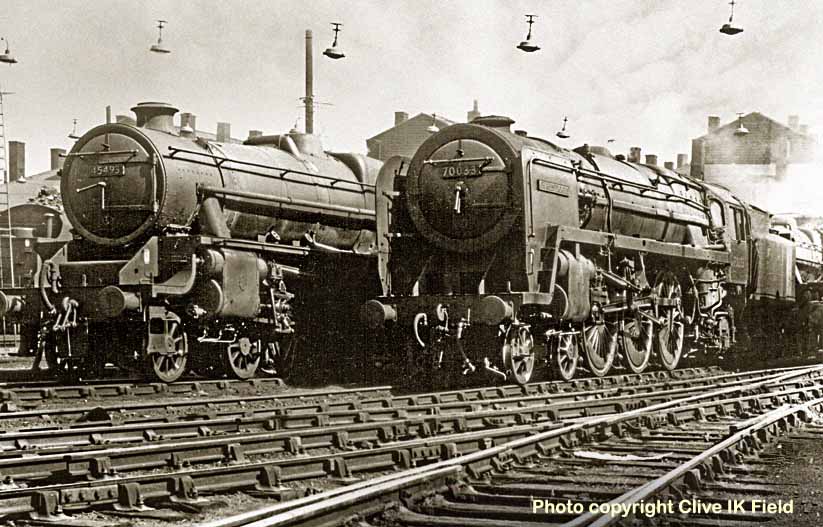
(Above) A good strong image of 7MT 70033 Charles Dickens sharing the company of many former-LMS types in the yard at Willesden depot in May 1963. The Britannia was having its second spell at the shed, although only for a short four month period. A prominent feature of the shed was the suspended lighting across the large yard; the shed closed in September 1965 with demolition occurring in December 1966.
(Below) A fine photograph by Dave Canning of 70033 Charles Dickens with a cross-country express at Southampton early in 1965. All modifications are seen to be done by this time and the nearside lubrication rod is now quite short in order to increase the oil delivery rate to the cylinders; the locomotive still retains its nameplates though not for much longer.
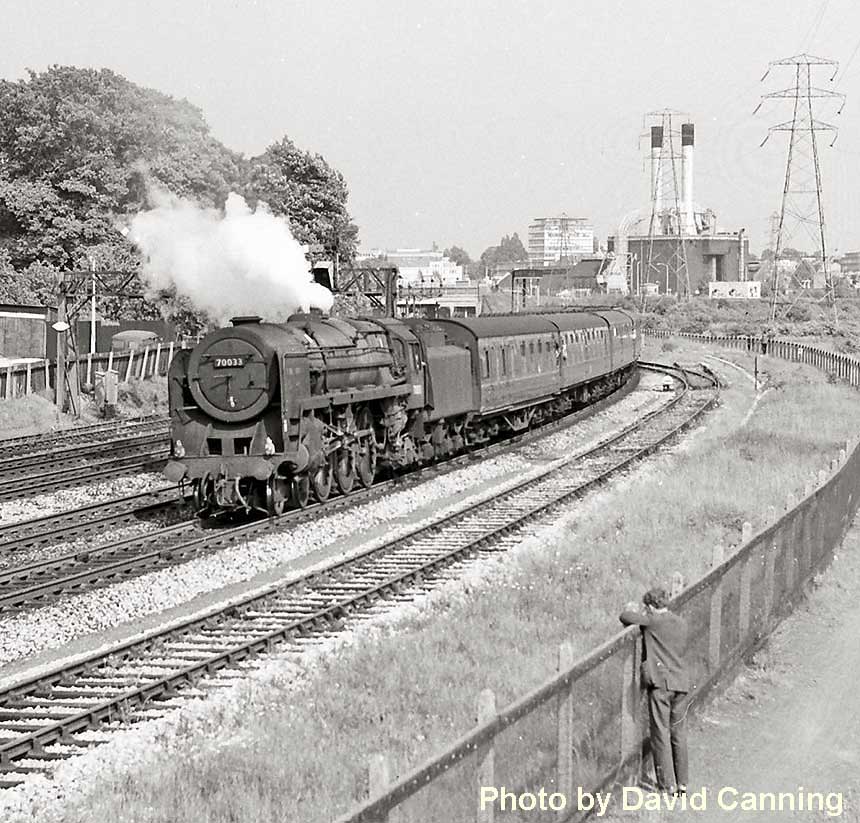
DISPOSAL: Withdrawal was on Saturday 30th September 1967 from Carlisle Kingmoor after storage and was disposed of by G.H. Campbell of Airdrie during April 1968. (still under construction)
Programme authorised 4th January 1951, built at Crewe Works and completed on 20th December 1952 to Order No E483/228 at a cost of £22,573. Withdrawn on 6th May 1967 from Carlisle Kingmoor.
ALLOCATIONS: Along with the four preceding 'Britannias' Nos 70030-33, 'Thomas Hardy' began service working from Longsight MPD (9A) in Manchester, but was soon on the move to Stewarts Lane Depot (73A) during a five-week loan spell on the Southern Region from 16th May 1953. His return to Longsight was very
 short-lived, however, as the loco found favour at Stratford MPD (30A) from July 1953. This move began a long stint on the Eastern Region, moving to Norwich (32A) in January 1959 then to March (31B) in June 1961, before returning to the London Midland Region at Willesden shed (1A) on 24th March 1963.
short-lived, however, as the loco found favour at Stratford MPD (30A) from July 1953. This move began a long stint on the Eastern Region, moving to Norwich (32A) in January 1959 then to March (31B) in June 1961, before returning to the London Midland Region at Willesden shed (1A) on 24th March 1963. Next move for 70034 was to Crewe North shed (5A) from 20th June 1964 until it closed to steam in May 1965 whereupon he joined the throng at Crewe South shed (5B), but for only two months before relocating to Newton Heath MPD (26A). 70034 finally moved to Carlisle Kingmoor shed (12A) in May 1966 and spent his final year in service there before condemnation.
(Below) Dated May 1955, this fine image by Ben Brooksbank shows 70034 Thomas Hardy at Liverpool Street station almost ready to depart with the evening boat train for the Hook of Holland, stopping only at Harwich Parkeston Quay station. The Britannia was one of 14 engines allocated to Stratford MPD (30A) at this time and is in typical summertime condition: no time available for the cleaning of locomotives. The picture affords an excellent view of the weak type front step that Stratford fitted to their Pacifics, an extra plate added in addition to the original design. Also of note are the Southern Region lamp irons on the smoke deflector stays and the centre lamp iron which is very short (compare with K Long image below).
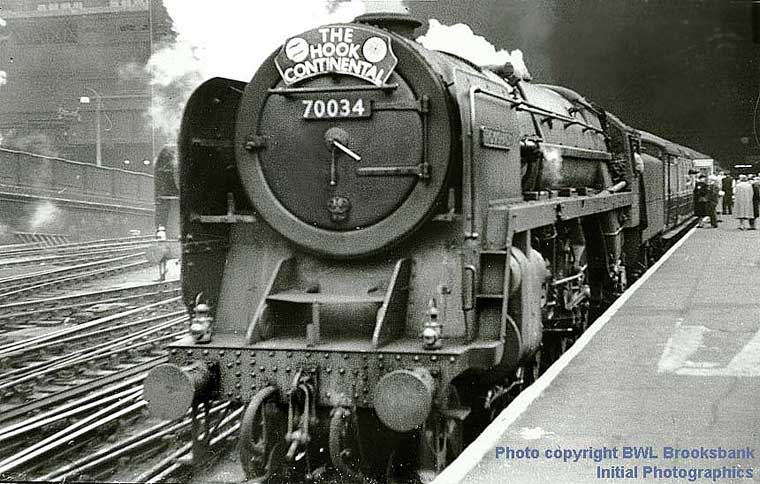
MODIFICATIONS: 70034 was completed 14 months after 70024 Vulcan; this was due to an acute shortage of steel following World War 2, but this interim period did give the Works the opportunity to apply several modifications that had been found necessary during the service period of the earlier 'Britannias'. These amounted to 5 items: item 9 - the flexible screen was fitted at this time, helping to prevent draughts at the back of the cab; item 17 - the hollow axles were 'plugged' and the wheel bearings seated correctly; item 16 -
 the sand box lids were raised from new and were now three in number; item 8 - the reverser recuperating spring was contained from new; item 5 - the steady bracket was fitted to the forward rod of the regulator from new. Allied to these changes, we should note that the lamp irons (item 2) were of LMR type; the plain couplings (item 14) were added as part of the Axle repairs; and the tender step (item 10) was added from new also.
the sand box lids were raised from new and were now three in number; item 8 - the reverser recuperating spring was contained from new; item 5 - the steady bracket was fitted to the forward rod of the regulator from new. Allied to these changes, we should note that the lamp irons (item 2) were of LMR type; the plain couplings (item 14) were added as part of the Axle repairs; and the tender step (item 10) was added from new also. The balance weight on the centre drive wheel is smaller than on previous engines; covering seven wheel-spokes instead of eight as previously seen. Also the modified sand boxes - now three instead of the previous two - allowed for easier routing of the pipework, and therefore better delivery of the sand to the drive-wheels.
The LNER Return Crank was not required to be changed until very late in the service history of 70034; also the regulator rear rod support bracket (item 7) was not ever fitted, which was rare, but was the case on a few engines. During service from Stratford shed, 70034 was fitted with a weak-type step in 1955, which was then changed to a full modification step (item 1) in March 1957; the smoke deflectors' mod (item 3) was seen from April 1959, along with a new BR emblem (item 11) on the tender and also the AWS equipment (item 20) was fitted at the same time. The speedometer unit (item 13) was not fitted until late August 1961, by which time 70034 was more likely to be hauling freight than passenger turns; and also the power warning plates (item 19) were applied for safety reasons. Very late in 1966, or possibly early in 1967, 70034 received a BR1D tender from one of the withdrawn Britannias, and was also seen with the LNER Return Crank (item 15) modified to the LMSR version, and yet was withdrawn early in May 1967.
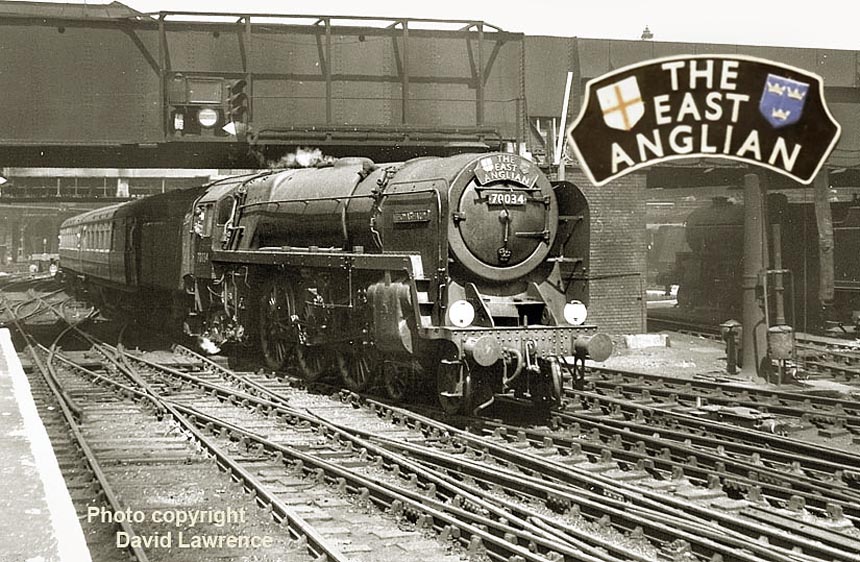
(Above-Below) Seen entering Liverpool Street station is Britannia No. 70034 Thomas Hardy hauling the up 'East Anglian' express from Norwich City during the period when Stratford were fitting a 'weak step' to augment the original design in order to assist the crew in the fitting of the many headboards that were used on a daily basis on Great Eastern lines. (Below) Another wonderful image from the archives of Rod Blencowe reflects 70034 Thomas Hardy at Stratford shed being prepared for another trip on 'The Hook Continental' boat train service from London to Harwich Parkeston Quay on a day in September 1957. Seen in pristine condition 70034 now has a full front step modification and a short lubrication rod (item 18) which would have been shortened to provide more atomised oil to the valves and cylinder; also gives a good view of the 3 raised sand box lids (small square boxes) on the boiler walkway. Incidentally, if anyone requires traditional photographic prints of Rod Blencowe's shots, or any other photographic services, Rod's email address can be found at the foot of the page.

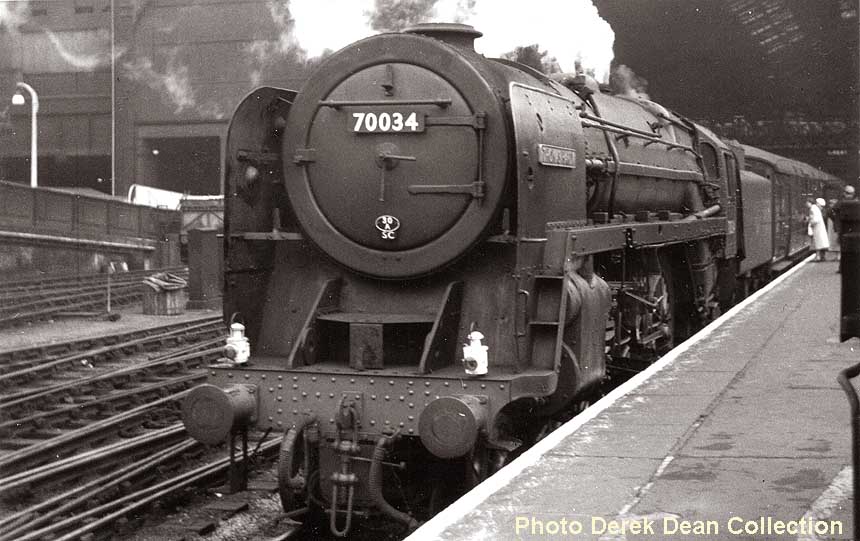
(Above) Dated May 1959, 4-6-2 70034 'Thomas Hardy' is ready for the journey northwards possibly to Norwich, sporting newly modified smoke deflectors, as seen when emerging from Doncaster Works, April 1959 also with the AWS equipment added during the same visit. The use of two clean headlamps instead of the more usual white discs suggests this is a late departure and the shedcode should be reading 32A by this time.
SERVICE RECORD: 70034 Thomas Hardy was used extensively in his first full year of service, and recorded nearly 85,000 miles hauling trains such as 'The Comet' and 'Mancunian' from Longsight shed, followed by 'The Hook Continental', 'Norfolkman' and 'East Anglian' whist allocated to Stratford MPD from July 1953; and even 'The Night Ferry' from London Victoria to Dover Marine station when on loan to the Southern Region.
70034 was also recorded as covering over 70,000 miles in 1954 and over 65,000 in 1955, so a very productive first three years, which compared very markedly with his final three years of service. 'Thomas Hardy' was seen to enter Doncaster Works five times for servicing and general repairs and to Crewe Works on at least three occasions for maintenance. 70034 is recorded as receiving two boiler changes and two tender swaps including the BR1D version in 1967. There are not any recorded accidents involving 'Thomas Hardy'.
(Below) A really fine capture by Keith Long, depicting Britannia 70034 'Thomas Hardy' at rest at York shed, but looking ready for any task with a mountain of coal in the tender. The speedometer has now been fitted; the top lamp iron is very short whereas the lower middle iron is double its size now compared to the 1955 picture. Also now displaying power warning plates at various points on the engine and tender, these to remind the crew that overhead wires were often very close by, and were required to be riveted on locomotive. Dated September 1961.


(Above) Britannia 70034 Thomas Hardy seen at Carlisle Kingmoor and recorded for posterity by B K Green. The shedcode is 12A so the date is post May 1966 and therefore 70034 is into his last year of service, but not all modifications are yet done as the tender will be switched to a BR1D type and the offside LNER Return Crank was seen to be changed for the LMSR version at a later date. Also of note; the offside exhaust pipe cover is missing from just above the cylinder; the lamp irons have been repositioned; the SR-type lamp irons (from 1953) are still prominent and of course, the nameplates have been removed for safekeeping.
SIGHTINGS: First view of 70034 was at Banbury Lane, Rugby on 12th February 1953, when just three months old, hauling 'The Comet' express service from Manchester to London Euston. Also in 1953, he was seen at Folkestone Junction with a retuning boat train while on loan to the Southern Region and displaying extra lamp irons on the smoke deflector stays to accommodate the additional white discs used extensively on SR trains, and amazingly these were still fitted when the engine was scrapped in 1967.
A powerful image was captured in September 1953 showing 70034 breasting Brentwood Bank with the down 'Easterling' which had portions for Yarmouth and Lowestoft, these being separated at Beccles station. A close-up front end shot was taken at Stratford shed which illustrates well the large 5ft 9ins boiler of the Britannia class, with a headboard announcing that 70034 was ready to haul 'The Hook Continental' from London Liverpool Street station to Harwich to connect with a boat train for Holland. The engine was flanked by a K1 class 4-6-0 and a B1 class engine, both in steam and ready for action from this very busy shed, which was home to over 420 engines at this time in 1957. In September 1962 'Thomas Hardy' was viewed at Doncaster hauling a long van train, double-headed with 70014 'Iron Duke' and looking anything but smart, but was welcomed by at least thirty youthful trainspotters on the platform at the time. The remaining views of 70034 in 1965 and 1966 reflect vividly how the engines were neglected at this time, and were described by the photographer as the worst condition that they had ever seen for any locomotive. Disposal of 70034 was at J McWilliams of Shettleston in October 1967, after four months in storage at Carlisle Kingmoor shed.
70035 Rudyard Kipling: Programme authorised 4th January 1951, built at Crewe and completed on 22nd December 1952, to Order No E483/228 costing £22,573. Withdrawn Saturday 30th December 1967 from Carlisle Kingmoor.
ALLOCATIONS: 70035 Rudyard Kipling began service at Norwich Thorpe depot (32A) under the expert eye of Bill Harvey. 70035 was selected to be stationed at March shed (31B) in June 1958, but soon returned to Norwich in January 1959 until being ousted by new diesels; moving to Immingham (40B) during October 1961, then back to March (31B) in June 1963 for a period of six months, before moving to Carlisle Kingmoor MPD (12A) to eke out the final four years of its rather short service life.
(Below) This splendid image by Dr Ian Cameron Allen shows Britannia 70035 Rudyard Kipling climbing the 1 in 131 Haughley Bank with the down 'Broadsman' from London Liverpool Street to Norwich in 1954. The junction at Haughley provided an important rail link to Newmarket on race days, and beyond to Cambridge with connections to Bletchley and Oxford, while to the east was the now-closed line to Laxfield. To visit the Transport Treasury website. Click HERE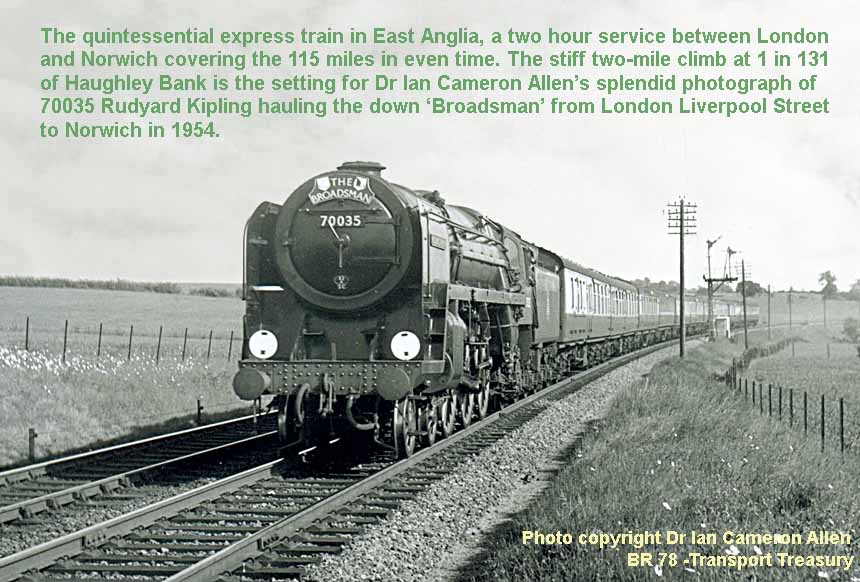
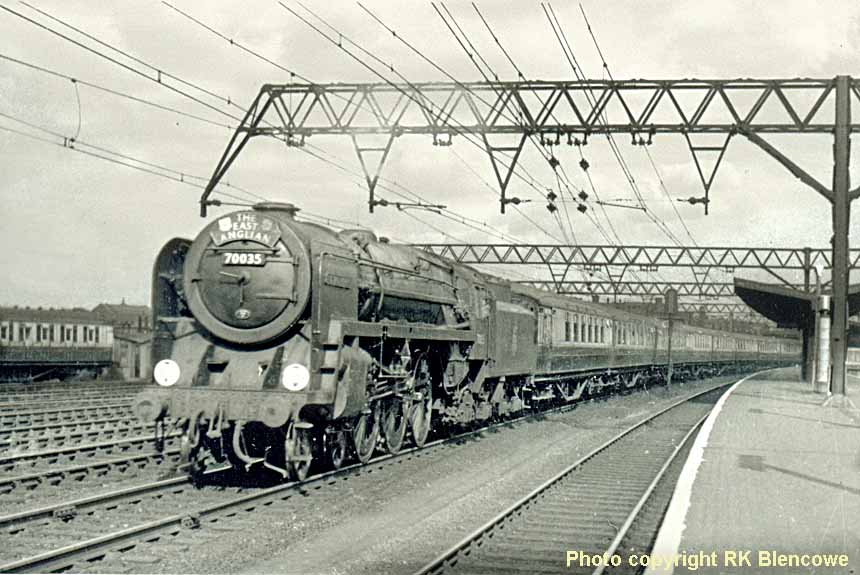
(Above-Below) Sporting a Norwich Thorpe (32A) shedplate on the smokebox door, BR Standard Pacific 70035 Rudyard Kipling sweeps through Stratford High Level Station with the 'East Anglian' in October 1955. Inaugurated in 1937, this London-Norwich express was a businessman's train entrusted to Class B17 'Sandringham' and later B1 haulage. However the GE section tended to overload these trains and the Class 5s were replaced on the heavier routes by the more powerful Class 7 BR Standard Pacifics; the arrival of the Britannias in 1951 revolutionised the Norwich service and allowed British Railways to greatly improve both the locomotive rostering and accelerate the timetable on the GE section; a new three line cast-iron headboard was introduced for the 'East Anglian'; the headboard was further embellished with both London and Norwich coat of arms in 1953. The overhead wires first appeared in 1949 for the Shenfield services. (Below) A wonderful scene in bright warm sunshine at Doncaster Works yard, is captured by BKB Green for Initial Photographics in the summer of 1957. The powerful image of Britannia 70035 Rudyard Kipling provides an excellent view of the locomotive's front end detail; the method of affixing the front step; the large washers added to the frame for spreading the load when lifting the engine and the 'BR7' applied to the buffer beam are all clearly seen. 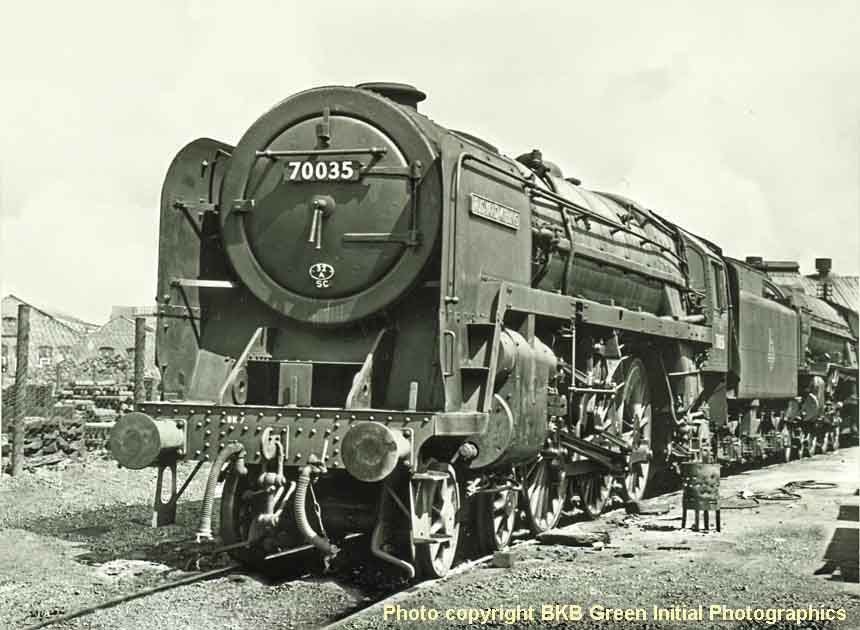
MODIFICATIONS: Due to severe post-war stringencies and a shortage of steel, 70035 wasn't completed until 14 months after 70024 Vulcan, however this delay gave the Works an opportunity to apply the necessary modifications discovered during the service period of the earlier 'Britannias'. These amounted to 5 items: item 9 - the flexible screens were fitted at this time, helping to prevent draughts at the back of the cab; item 17 - the hollow axles were 'plugged' and the wheel bearings seated correctly, however on 70035 plain bearings were used on the first and third drive axles for performance comparison; item 16 - the sand box lids were raised from new and were now three in number; item 8 - the reverser recuperating spring was contained from new; item 5 - the steady bracket was fitted to the forward rod of the regulator from new. Added to these changes, we should note that the lamp irons (item 2) were of GE type; the plain couplings (item 14) were added as part of the Axle specifications; and the tender step (item 10) was fitted from new also. At this time in the building programme a change was requested by the management to fit plain bearings to the first and third drive axles for comparison to the roller type on the centre axle; this was carried out on Britannias 70035-70039. The first viewed modification was the change of the front step (item 1) which was fitted by Doncaster in September 1956. 70035 returned to Doncaster Works following over five years of service during which the engine was virtually unaltered, but that situation changed with the smoke deflectors (item 3) being modified to LMS 1 type, having two backed cut-outs in each sheet in place of the original handrails; also the new BR emblem (item 11) was applied to the tender and the nearside lubricating rod (item 18) was shortened, as seen from May 1958. The long awaited AWS equipment (item 20) was added to 70035 during its next visit to Doncaster Works and could be seen from April 1959. It would be normal practice for the bracket for the rearmost regulator rod (item 7) to have been added by this time, but this did not appear until after the engine returned to Crewe Works for repairs in September 1962. Meanwhile in April 1960 the engine made another visit to Doncaster Works for maintenance and was fitted with a speedometer unit (item 13), which was operated via a crank lever from the nearside rear drive wheel. Just five months after, the locomotive was involved in a collision that required Works attention, and though no more details are available, it remained at Doncaster for seventeen days. Then in April 1961 the engine returned to Works following a main frame fracture, which strongly suggested that the collision was indeed a factor and 70035 spent just over three months at Doncaster to facilitate repairs. During this long visit, the LNER return crank (item 15) was modified to the LMR type of fitting, showing the four-pin fixing. Finally, the lamp irons (item 2) were repositioned for safety reasons during the early part of 1964, while the nameplates were removed during a visit to Crewe Works early in 1965. 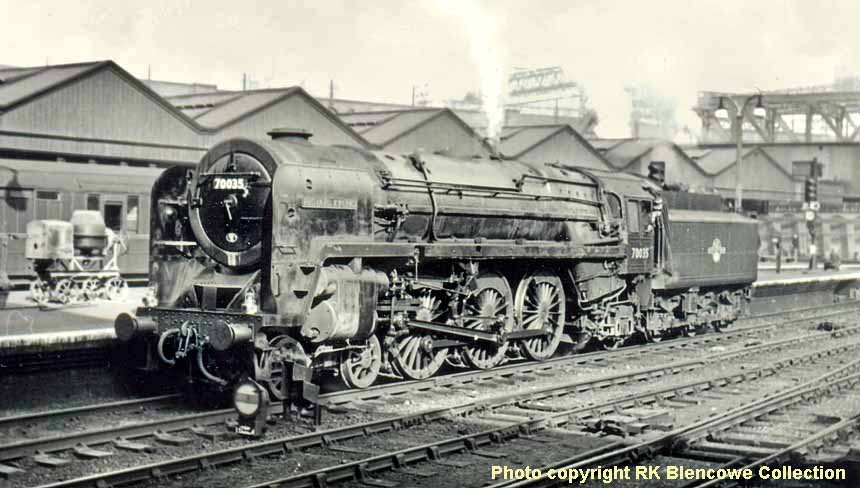
(Above-Inset-Below) After arriving at London Liverpool Street with a morning express from Norwich, BR Pacific 70035 Rudyard Kipling awaits clearance to back down to the turntable in October 1959. No 70035 looks unusually shabby for a Norwich engine, but by this time the shed had to contend with all of  Stratford's allocation,with the exception of 70042 Lord Roberts which went to the Midland. Norwich had 22 Pacifics in total, and yet the shed was prohibited from taking on any more staff to handle the extra workload. Prominent in the background is the ridge and furrow canopies which were unusual in that they continued into the covered area of the station. (Inset) Jim Oakley was fortunate enough to do what every spotter aspired; to visit Doncaster Works in the steam era where he captured this image of Britannia 70035 Rudyard Kipling awaiting testing in the works yard on 3rd June 1961 before release to traffic. 70035 was the first Pacific to go to March depot (31B) and one of 9 Britannias to move to Carlisle Kingmoor MPD (12A) during the first week of December 1963. (Below) From the huge archives of Transport Treasury comes this fine image by Dr Ian Cameron Allen, a prolific photographer of the Great Eastern section lines in East Anglia. In September 1960 he captured BR Britannia 70035 Rudyard Kipling beneath Norwich depot's unique coaling tower with the very compact coal tippler plant on the right. The Britannia was one of 22 Pacifics at Norwich Thorpe depot, where Foreman Mr Bill Harvey was held in very high regard by all those that knew him.
Stratford's allocation,with the exception of 70042 Lord Roberts which went to the Midland. Norwich had 22 Pacifics in total, and yet the shed was prohibited from taking on any more staff to handle the extra workload. Prominent in the background is the ridge and furrow canopies which were unusual in that they continued into the covered area of the station. (Inset) Jim Oakley was fortunate enough to do what every spotter aspired; to visit Doncaster Works in the steam era where he captured this image of Britannia 70035 Rudyard Kipling awaiting testing in the works yard on 3rd June 1961 before release to traffic. 70035 was the first Pacific to go to March depot (31B) and one of 9 Britannias to move to Carlisle Kingmoor MPD (12A) during the first week of December 1963. (Below) From the huge archives of Transport Treasury comes this fine image by Dr Ian Cameron Allen, a prolific photographer of the Great Eastern section lines in East Anglia. In September 1960 he captured BR Britannia 70035 Rudyard Kipling beneath Norwich depot's unique coaling tower with the very compact coal tippler plant on the right. The Britannia was one of 22 Pacifics at Norwich Thorpe depot, where Foreman Mr Bill Harvey was held in very high regard by all those that knew him.
SERVICE RECORD: Working from Norwich depot, 70035 was well used on the top expresses, such as the 'Norfolkman' and 'Broadsman' and after transfer to March depot in Cambridgeshire it was extensively used on the Liverpool to Harwich boat train, known as the 'North Country Continental'. 70035 was recorded as visiting Crewe Works on five occasions, with at least eight trips to Doncaster Works, the latter being largely responsible for the majority of modifications on this particular engine. Recorded mileages for 70035 were 86,000 for 1953, 83,500 for 1954 and nearly 78,000 miles for the year after. 70035 was the only Britannia to have one of its two mainframes changed; this work occurred in 1960, while a number of other Britannias suffered some cracking around the cylinders due to the excessive stresses involved, mainly 70007 'Coeur de Lion' which resulted in its premature demise. 70035 Rudyard Kipling was used on Rail tour duties in 1966 when it was called upon to substitute for failed Jubilee Class 4-6-0 45593 Kolhapur. No 70035 was time recorded hauling a train of 325 tons on a journey from Ipswich to Norwich by a Mr JH Turner. The engine was driven by Mr Newson of Norwich depot and the run is described by Cecil J Allen in his book 'British Pacific Locomotives', as the fastest ever made on Great Eastern metals and quotes a top speed of 94 mph over a distance of one mile at Diss, halfway through the journey; the trip took just over 39 minutes for the 46.25 miles; while between mileposts 85 to 112 the engine returned an average of more than 84 mph. 
(Above-Below) Clive IK Field captured this striking low-level shot of Britannia 70035 Rudyard Kipling in the early morning sun at London Liverpool Street Station in February 1961; the engine is awaiting departure for Norwich, a journey it will have taken countless times before during its seven years on GE metals. In 1961 70035 moved to Immingham (40B) for working the GN services between Cleethorpes and Kings Cross for a short time; the same year the engine had a main frame changed as a result of heavy cracking. (Below) Carlisle-based Britannia Pacific 70035 Rudyard Kipling makes progress onto the main line to Oxford from the branch at Kennington Junction leading to the Morris Cowley Plant, from where a consignment of new vehicles has been collected for delivery to Bathgate in Scotland. The year is 1964 and the engine looks to be in excellent health with all the expected modifications having been done. The irony of this photo is that the engine is delivering the very vehicles that will ultimately replace it. 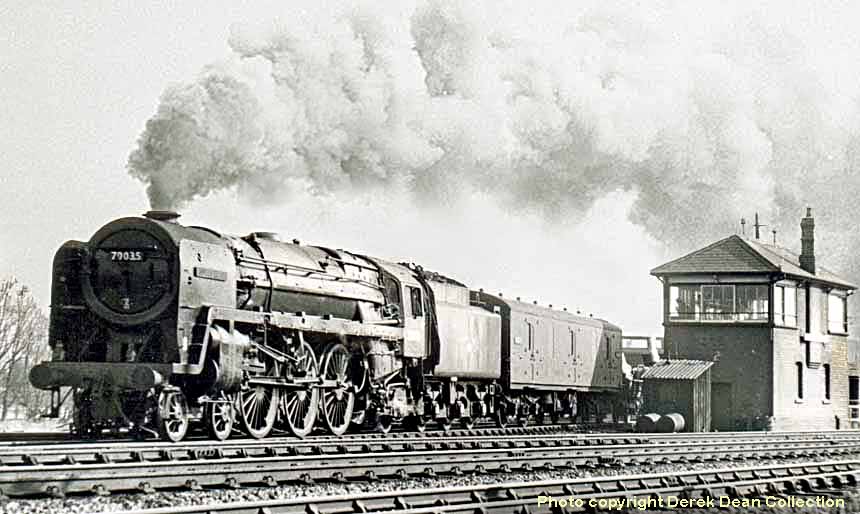

(Above-Below) An excellent close-up image from Paul Claxton, showing 70035 Rudyard Kipling at Crewe South (5B) depot; the locomotive has just been released from Crewe Works following repairs including a refurbished tender which shows the axle boxes have been repacked with a different grade of lubrication, indicated by the bright yellow endplate with a red horizontal band; also some lining still shows on the fresh paintwork. This was March 1964 and no Britannia had yet been allocated to Crewe South, although 19 members were resident at Crewe North (5A) hence they were regular visitors to South shed...click HERE to visit Paul's page with links to the Rail Pictorial website. (Below) The now-nameless 70035 is being coaled up at Bradford Manningham shed's dilapidated coal stage shortly before closure of the depot in April 1967. The poor external condition of 70035 was typical for the period, showing a grime-encrusted livery rendering the company crest invisible, but otherwise looking fit for purpose. The coaling stage at 55F was a hand-operated system and had changed very little over the years aside from the addition of electric lamps replacing the original gas ones.
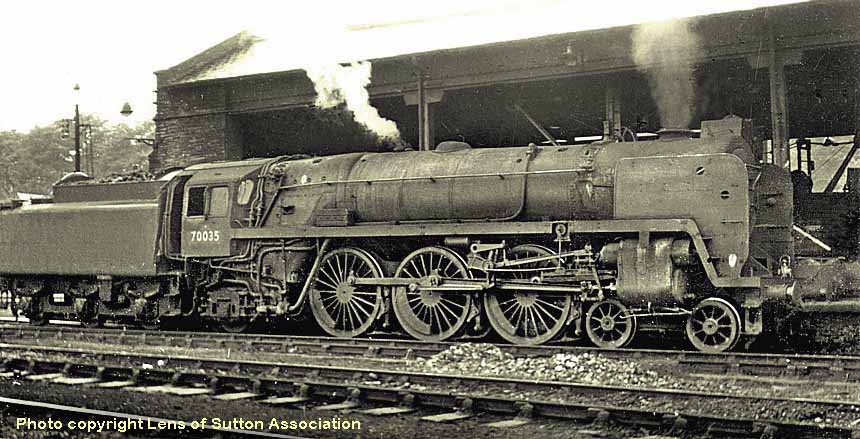
SIGHTINGS: A relatively new 70035 Rudyard Kipling was viewed hauling a Norwich express from London over the level crossing at Wymondham in July 1954. The manned crossings were a prominent feature of a railway journey across the flat Norfolk landscape. A pristine 70035 was pictured running at great speed over the water troughs at Ipswich, making very good progress with an afternoon express to London at the end of August 1957; of note was the fitting of the full front step plus the short-lived 'BR7' (left) had been applied to the front buffer beam, a feature only seen between 1957 and 1958. During the early summer of 1958, No 70035 left the familiar surroundings of Norwich shed to work from March depot, where it was used for working the Sheffield boat train on a regular basis; unofficially named 'North Country Continental', the Liverpool-Harwich Parkeston Quay boat train was routed via the electrified Woodhead route to Sheffield Victoria where steam took over for the remainder of the journey south to Suffolk. After returning to Norwich MPD in 1959, the powerful engine was noted on a mid-day Newcastle to Colchester express, leaving York double-headed with Class V2 60938 of March depot. The following year a very presentable 70035 was captured at Stratford's vast complex awaiting its next duty; it was noted that the AWS pipework had not been routed around the perimeter of the cab, the usual course, but had been directly admitted into the cab to reach the reservoir fitted below the cab floor, certainly a most unusual method. During the month of August 1964, 70035 was seen near Preston hauling a heavy 12-coach express from Kilmarnock to Blackpool, then at Dunblane with a lightweight parcels train consisting of 4 small vehicles, an occasion when the locomotive was much heavier than its load. Finally, the now-nameless 70035 was viewed storming away from Carlisle Citadel station with a Glasgow relief train in April 1965 and looked in good health due to a fairly recent Works visit.
DISPOSAL: Withdrawal took place on Saturday 30th December 1967 from Carlisle Kingmoor. 70035 was stored at Carlisle Kingmoor Viaduct yard until March 1968, and then cut up at Wards of Inverkeithing during April 1968.
ALLOCATIONS: Stratford's large and complex yard (30A) was the starting-point for 70036 Boadicea, most probably early in 1953, following testing at Crewe prior to actual delivery. Then in line with twenty one other BR Standard engines on the GE section, 70036 was reallocated to Norwich Thorpe (32A) early in 1959, continuing with much the same workings. Close on two years were spent at 32A before a move to March shed (31B) came about in November 1960; this was followed by a move to Immingham depot (40B) from October 1961, spending a period of two years and two months at the North East Lincolnshire depot. 70036 then found favour at Carlisle Upperby depot (12B), but only for 3 months prior to moving to Carlisle Kingmoor MPD (12A) where it completed its all too short service career.
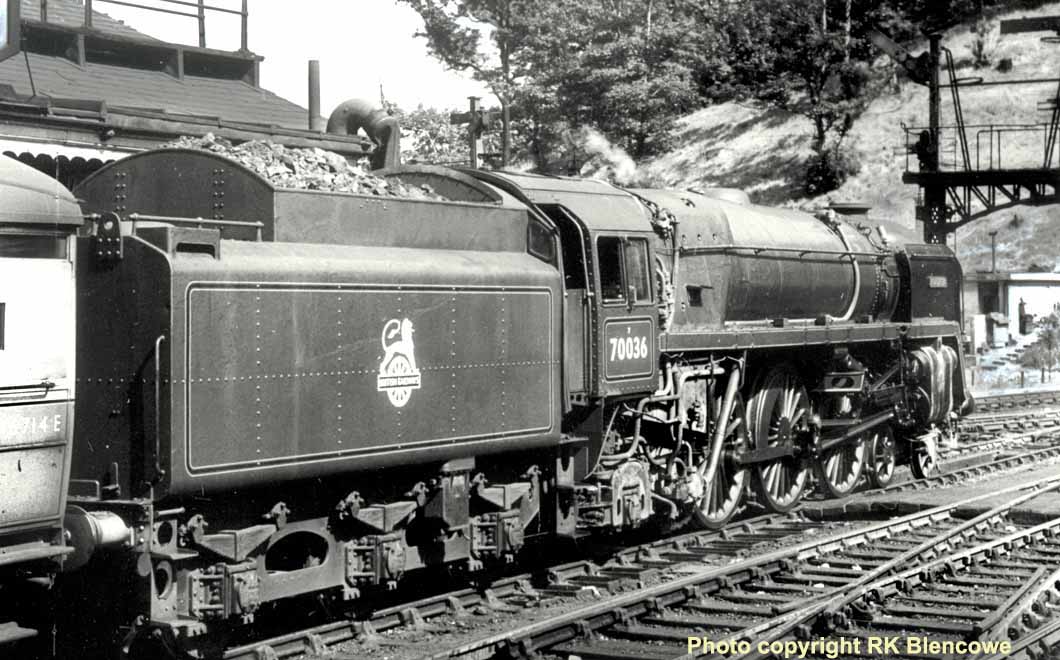
(Above-Below) This splendid shot by RK Blencowe of 7MT Britannia 70036 Boadicea getting the 'right away' at Ipswich allows us a close-up scrutiny of the BR1 tender as fitted to most of class; it clearly shows the plate frame and axle-boxes and multi-leaf semi-elliptical springs. The tender had a 7 ton coal capacity, with room for 4250 gallons of water; the deep box between the first and second axles was one of two sediment traps fitted to stop debris in the water reaching the boiler tubes and injectors. Also of note is the LMR type tender step and the early emblem showing the relative alignment of the 'British Railways' banner to the cabside number. (Below) From the large Archives of Lens of Sutton Association we have this fine low-level
 image of Britannia 70036 Boadicea awaiting its turn for coaling at Stratford Loco during 1956. No 70036 still has a weak-type front step, but is not looking its best, albeit the engine has served less than four years in service; there is damage to the cylinder casing and the exhaust cover is missing between the cylinder and the boiler walkway. There is a good view of the Britannia's front bogie wheels that match perfectly those fitted to the Coronation Pacifics, while the 3 ft diameter wheels have just 9 spokes and are very similar to those used on the early Midland 0-4-4Ts (see inset). This sturdy Midland tank class was designed and built at Derby from 1881, with many lasting in service until 1956. Here we have No 1344 which was built in 1890 of the '1823' Class and became 58056 under British Railways.
image of Britannia 70036 Boadicea awaiting its turn for coaling at Stratford Loco during 1956. No 70036 still has a weak-type front step, but is not looking its best, albeit the engine has served less than four years in service; there is damage to the cylinder casing and the exhaust cover is missing between the cylinder and the boiler walkway. There is a good view of the Britannia's front bogie wheels that match perfectly those fitted to the Coronation Pacifics, while the 3 ft diameter wheels have just 9 spokes and are very similar to those used on the early Midland 0-4-4Ts (see inset). This sturdy Midland tank class was designed and built at Derby from 1881, with many lasting in service until 1956. Here we have No 1344 which was built in 1890 of the '1823' Class and became 58056 under British Railways.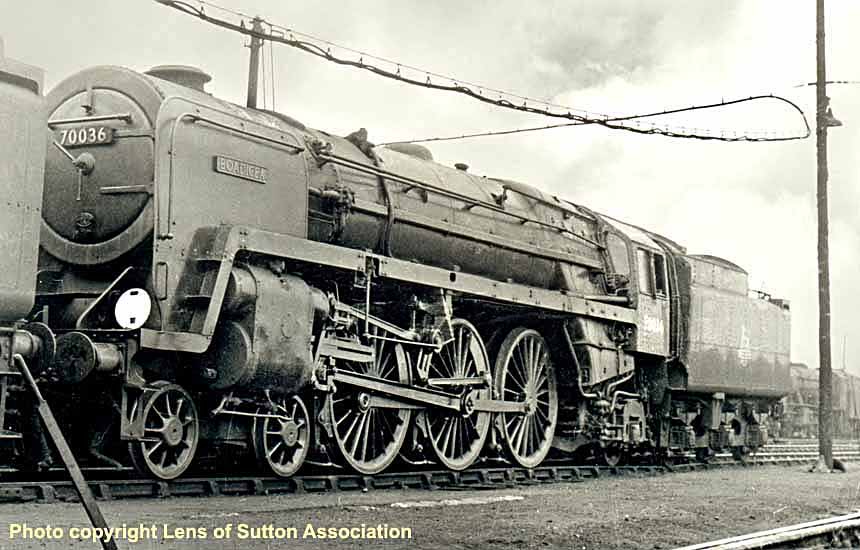
MODIFICATIONS: 70036 was completed 14 months after 70024 'Vulcan', this was quite simply down to an acute shortage of steel following World War 2, but the delay gave the Works the opportunity to apply the various modifications found necessary during the service period of the earlier engines. These amounted to 5 items: item 17 - the hollow axles were 'plugged' and the wheel bearings seated correctly; item 16 - the sand box lids were raised from new and were now three in number; item 9 - the flexible screen was fitted at this time, helping to prevent draughts at the back of the cab; item 8 - the reverser recuperating spring was contained from new; item 5 - the steady bracket was fitted to the forward rod of the regulator from new. In addition to these changes, we should note that the lamp irons (item 2) were of GE type; the plain couplings (item 14) were added as part of the Axle repairs; and the tender step (item 10) was added from new also. The LNER return crank (item 15) must have been faulty because it was changed exceedingly early, at the end of 1956 at Crewe Works. Being a regular Stratford engine, the local Works fabricated and fitted one of the temporary 'weak-type' front steps during April 1954; this was replaced in November 1957 with the full specification front step at Doncaster Works, plus the new BR emblem (item 11) was applied at the same time. 70036 is recorded as going to Doncaster Works at regular intervals during the period 1958-1962 and received the AWS equipment (item 20) in February 1959 and the modification of the smoke deflectors (item 3) during August 1959, which meant that it was one of the last five to be so treated. The power warning plates (item 19) were seen to be fitted during 1960, reminding crews of the danger of overhead electrified wiring. Eventually the speedometer (item 13) was added in September 1961, but as with many other class members, this was seen as 'too little too late', particularly in view of the mileages already covered by the locomotives without the equipment and the fact that the last ten Britannias had theirs from new. The original long lamp irons (item 2) were still fitted right up to 1964, but these then changed in length and position, although the long middle iron still persisted; also the nameplates were removed during a visit to Crewe Works in September 1964. It is worth noting that the front step (item 1) was fitted correctly at the end of 1957, but most every sighting thereafter shows the middle support to be inverted leaving a sharp edge, which should have been viewed as dangerous to crews and swiftly reset, but it was not. 
(Above-Below) With the fireman watching the road ahead, A Lathley captures two locomotives in one frame at Ipswich in March 1957. Britannia 70036 Boadicea is leaving with the 'East Anglian' for Norwich as B1 No 61233 moves in with a local off the Cambridge line. From this low angle we can pick out the 3 sand box lids on the boiler walkway, while the pipework can be followed from the superheater header connection, seen just behind the chimney, down the boiler, along the walkway and down again to the injector, sited behind the rear axle drive wheel. Click HERE to visit the Transport Treasury website. (Below) The cavernous station at Liverpool Street is the setting for this fine portrait by GB Wallis for Rail Photoprints, depicting Standard Pacific 70036 Boadicea awaiting its next duty. The locomotive is posing by the taxi ramp and displays the latest British Railways emblem, while the full modification front step has now been fitted in place of the Stratford designed weak-type step. The station was built on the site of the Bethlem Royal Hospital in 1874 and the earlier terminus at Bishopsgate became the goods warehouse and distribution centre. Click HERE to visit the 'Rail Photoprints' website. 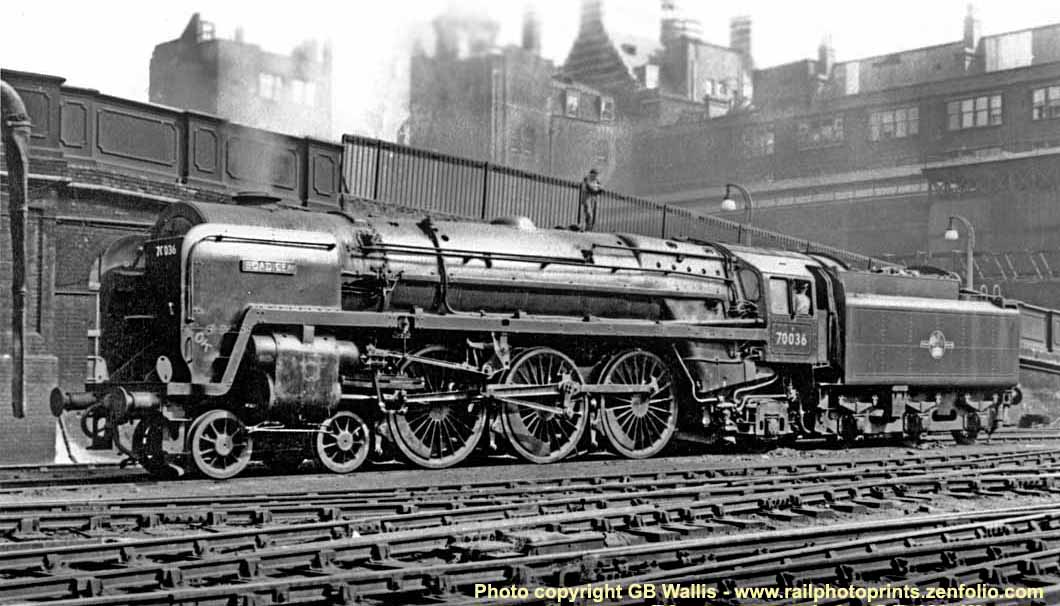
SERVICE RECORD: It was two days before Christmas 1952 when 70036 Boadicea was released from Crewe Works, so a recorded mileage of 104,459 for 1953 was quite a remarkable achievement. This was followed by 76,600 miles in 1954 and a further 85,300 in 1955 while hauling express trains such as the 'Easterling' or the 'Norfolkman' from London Liverpool Street Station to Norwich - plus many trips with the 'East Anglian' and 'Day Continental' which provided daily connections to Holland by Zeeland Ferry from Parkeston Quay. Working out of March depot from the end of 1960 meant a change of scenery for the locomotive, as it was regularly hauling Newcastle to Colchester expresses or the holiday trains from Doncaster to York and Scarborough. When allocated to Immingham depot in North Lincolnshire, 70036 was initially utilised on the express trains to London Kings Cross, joining the East Coast Route at Peterborough, but again 70036 was ousted by the influx of new diesels and more increasingly to be found working express fish trains to Manchester Ashton Moss or to Whitland in Carmarthenshire. After relocation to Carlisle the Britannia was regarded as just another second-hand engine, and with no specific treatment in its upkeep 70036 eked out its final days uncared for by many crews, some preferring a 'Black 5' instead. 
(Above-Below) Immingham based Britannia 70036 Boadicea is pictured at Chaloners Whin Junction by Cecil Ord in October 1961; the locomotive is hauling a Newcastle to Colchester express on the now-close section of the ECML between York and Doncaster via Selby; the 14¾ mile long ECML diversion was built in 1983 to enable the National Coal Board to mine a mile-wide belt of coal, and to avoid the risk of mining subsidence seriously affecting the fast InterCity service on the original line. The train will soon be crossing the River Ouse by way of the Naburn swing bridge, a credit to Victorian engineering. Opened in 1871, the swing bridge consists of two 108ft spans, and is now a part of a recognised Cycle pathway. (Below) 70036 Boadicea became the fourth Pacific at Immingham MPD, joining 70039, 70040 and 70041 while 70035, 70037 and 70038 soon followed to create a pool of 7 engines based at the depot. They were utilised on express trains to London Kings Cross from Cleethorpes, also on trains into Leeds as well as express fish trains to Whitland as far as Leicester and across to Manchester Ashton Moss. The shed was situated in the Immingham Docks, and became home to many freight types including WD class and many BR 9F class, also fifty seven B1 class 4-6-0 locomotives, one of which is seen on the left of this shot dated November 1962. 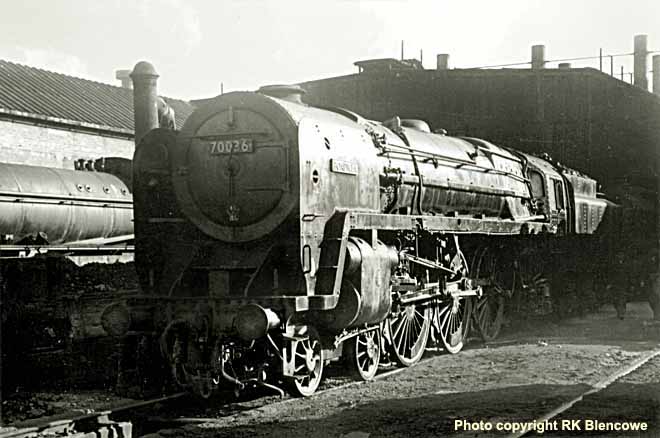
SIGHTINGS: 70036 Boadicea was seen powering its way up to Ingrave Summit Box in June 1954, hauling a ten coach London express towards Norwich, destined for Cromer and Sheringham; the locomotive was seen to be already fitted with a 'weak-type front step' to aid the crew's cause. Two years on saw the very tidy Britannia hauling the 'East Anglian' at Chelmsford, and it was noted that the full front step had yet to be fitted, also the LNER return crank had been changed to the LMR type. The passenger coaching stock appeared to be made up of repainted Gresley vehicles, while the train headboard was the newer version carrying both the London and Norwich coat of arms. On a very crisp morning in February 1958, 70036 was captured passing Norwich Trowse Junction with the early morning 'East Anglian' and getting to grips with the climb of 1 in 84 up to Trowse Upper Junction; of note was the new BR emblem now in place on the tender and the full modification of the front step. It would appear from photographs that the central support for the front step in front of the smokebox was inverted in June 1958 and remained so right up to 1964. In 1961 the March-allocated 70036 was observed departing the magnificent York Station with an afternoon Newcastle to Colchester service, and it was noticeable that AWS equipment was now fitted to the locomotive, but no speedometer was yet in place and the front step central support was still fitted the wrong way around. After its short sojourn at March (31B), 70036 landed at Immingham depot and worked the morning train from Cleethorpes to Kings Cross. Following a recent Works visit, the locomotive was seen in excellent condition leaving the London terminus with the tea-time return to the North Lincolnshire coastal town in April 1962. By the summer of 1963, 70036 was one of seven Britannias working from Immingham on the Grimsby fish trains to all parts of the country, although on occasions it hauled express passenger trains including a Scunthorpe to Blackpool holiday special in September. Three years later, the external condition of the engine could only be described as deplorable when pictured at Stonehaven in Aberdeenshire hauling a long freight towards Montrose during the summer of 1966; the paintwork was hidden under layer upon layer of soot, general grime and a combination of brown and white stains; such was the dire condition of the now nameless Britannia the photographer was 'fortunate' to be able to record the loco number.
DISPOSAL: Withdrawal took place on Saturday 15th October 1966 from Carlisle Kingmoor. The engine was stored until February 1967 then transferred to Motherwell Machinery and Scrap Company of Wishaw for cutting up.
Built at Crewe Works and completed on 24th December 1952 to order E483/228 costing £22,448; withdrawn on the 5th November 1966.
ALLOCATIONS: 70037 spent close on eleven years in service on the Eastern Region; firstly from Stratford shed (30A) followed by a transfer to Norwich MPD (32A) in January 1959; then to March MPD (31B) from late November 1960 until the end of October 1961, at which point he was out posted to Immingham depot (40B) to link up with Britannias 70035, 70036, 70038, 70039, 70040 and 70041 on the Lincolnshire coast. In December 1963, 70037 was reallocated to Carlisle Upperby shed (12B), albeit very short term…in January 1964 the Britannia joined all the others eking out their last days at Carlisle Kingmoor depot (12A).
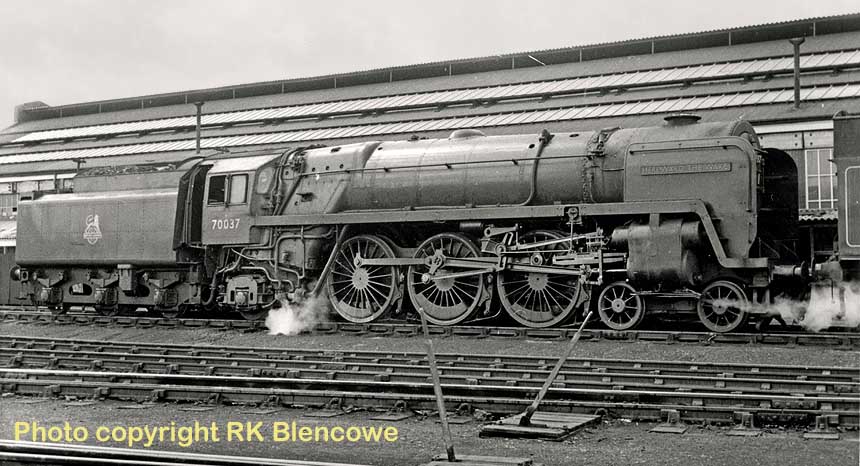
(Above) From the marvellous Archives of Rod Blencowe comes this image of 70037 Hereward the Wake, captured at Stratford Loco in steam and ready for the next job; although not looking to be in the immaculate condition that the engine has wallowed in since May 1954, the engine still looks in good condition. The burnished buffers are no longer a feature, the cylinder covers have lost their shine and the Stratford cleaning gang their best customer. Few modifications have been applied as yet, but the LNER return crank has been swapped for a LMR version at a recent visit to Crewe Works.
(Below) Definitely a good spot by Rex Conway; a Stratford engine at New Street was not uncommon in the early years of the class, being used as a running-in trip from Crewe for an ex-Works engine, though I myself cannot recall any although I started spotting there in 1957. The Britannia is at platform 3 and the photographer is standing on the long extended platform 6, making the most of the rare appearance of the Great Eastern locomotive in Birmingham. The ugly backdrop of the Queen's Hotel detracts from the stylish lines of the Pacific engine which is almost as built, being just over three years into service.

MODIFICATIONS: 70037 was completed 14 months after 70024 'Vulcan'; the delay was due to an acute shortage of steel following on from World War 2, but that said, the interim period gave Crewe Works the opportunity to apply the modifications that been found to be necessary during the service period of the other engines. These amounted to 5 items: item 17 - the hollow axles were 'plugged' and the wheel bearings seated correctly; item 16 - the sand box lids were raised from new and were now three in number; item 9 - the flexible screen was fitted at this time, helping to prevent draughts at the back of the cab; item 8 - the reverser recouperating spring was contained from new; item 5 - the steady bracket was fitted to the forward rod of the regulator from new. Allied to these changes, we should note that the lamp irons (item 2) were of GER type; the plain couplings (item 14) were added as part of the Axle repairs; and the tender step (item 10) was added from new also.
The modified sand boxes - now three in number instead of two previously - allowed easier routing of the relative pipework and gave better results in service. The first modification in service was the temporary front step that Stratford chose to fit to all of their Britannias and this was noticed early in 1955, along with the extended lamp irons (item 2) at the front, over the buffer beam. But when being 'shopped' at Crewe in April 1956, the weak step was removed along with the original twin small steps to fit the full modification (item 1) in conjunction with the regulator rear rod support bracket (item 7) and the LNER return crank (item 15) was changed to the LMR type with the four stud fixing. All of this did not much change the appearance of 70037, but after a visit to Doncaster in August 1958 the engine was seen without the dangerous handrails on the smoke deflectors (item 3) to change quite drastically the look of the Britannia.
So yet again it was Doncaster Works that modified the Britannia smoke deflectors as they did with all of the class that passed through its doors; the Plant changed a whopping 66% of the 39 engines to be converted. Also at this time the new British Railways emblem (item 11) was applied to the tender, while the speedometer unit (item 13) and the AWS equipment (item 20) were added at the next visit to Doncaster in October 1959, along with the power warning plates (item 19) affixed at strategic points over the entire locomotive. The only other change of note was that the lamp irons (item 2) were repositioned, at the front of the engine, to comply with the new directive on safety of the crew in relation to the danger of the overhead live wires. It would seem that the engine livery (item 12) was not altered as it was repainted in 1963 before the austerity measures brought in, henceforth all future Britannias were painted plain green without any lining added at all.
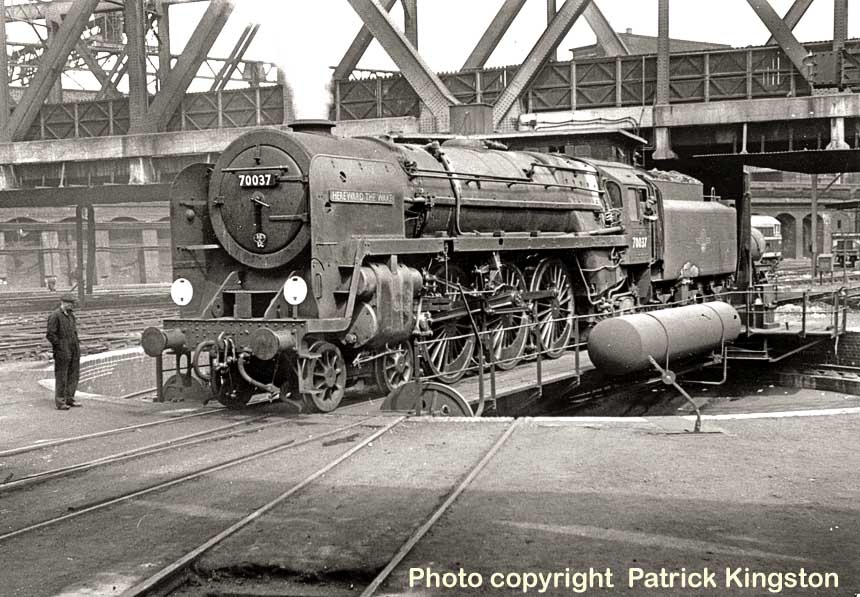
(Above) A very interesting picture from Patrick Kingston which shows the elusive turntable at Liverpool Street Station in London on Whit Monday in 1959; this table had to be lengthened when the Britannia class first arrived in 1951, as it was found to be too small to accommodate the 68 feet 9 inch overall length of the new engines. The extended table was ready in June, by which time there were 12 Britannias on the Great Eastern section, all requiring to be turned at each arrival in London. This image shows 70037 about to be turned on the vacuum operated table, which had its own reserve tank, in readiness to return to Norwich, its home depot.
SERVICE RECORD: 70037 was put to good use by Stratford MPD in 1953 and a recorded 95,700 miles was amassed which averaged out at 300 miles per day based on a six day week. Also the engine recorded 70,000 miles in 1954 and a further 58,000 in which was good for the fact that 70037 entered works on four occasions, took part in an Exhibition (see below), was involved in the RCTS 'The Fensman' tour and was generally pampered to a third degree. 70037 Hereward The Wake was selected as the engine to represent the class at the International Railway Congress Exhibition held at Willesden, so that over the next three years the engine was polished to a fault and used for special trains whenever possible, but from 1957 onwards the locomotive gradually lost its sparkle and became as grubby as the rest of them.
In October 1965, 70037 suffered Wheel Shift which is a term meaning that the alignment of the wheels has been disturbed in some way, be it the drive wheel in relation to its axle or the one axle in relation to the other two; thus breaking the coupling rod which in turn shot upwards and pierced the boiler. This was bad
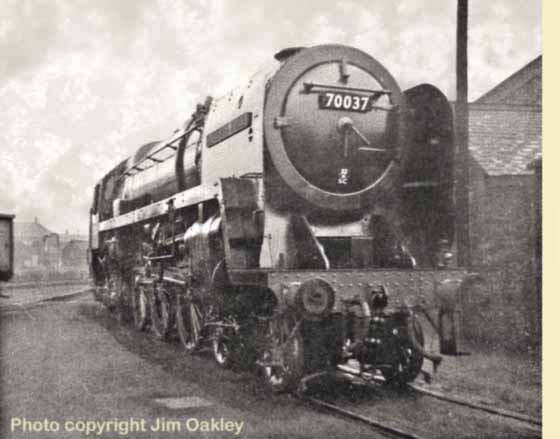 in normal circumstances, and would probably have been repaired, but in 1965 the foreseen usefulness of the steam engine in general was at a very low point and the cost simply outweighed all other considerations. Yet the engine stood at Carlisle Kingmoor yard until official withdrawal was announced on 5th November 1966 and by the time disposal was decided, the engine had stood for 26 months.
in normal circumstances, and would probably have been repaired, but in 1965 the foreseen usefulness of the steam engine in general was at a very low point and the cost simply outweighed all other considerations. Yet the engine stood at Carlisle Kingmoor yard until official withdrawal was announced on 5th November 1966 and by the time disposal was decided, the engine had stood for 26 months.(Inset-Below) A Brownie 127 shot taken by a young Jim Oakley of 70037 fresh from overhaul at Donaster Plant in 1960. (Below) A strong image of Britannia 70037 Hereward the Wake by SV Blencowe, taken at March shed in September 1961 which was shortly before its transfer to Immingham MPD (40B). The onset of the new breed of Diesel Locomotives was forcing the Authorities to find alternative work for the Britannia class and so 7 engines were allocated to work from Cleethorpes area, mainly from October 1961, until they were superceded by Diesels again and moved on to Carlisle.

SIGHTINGS: 70037 first made its bow from Stratford Loco and was soon seen on Brentwood Bank on a down Norwich express, a journey that would be usually made four times a day. In 1954 the Willesden Depot (1A) roundhouse was thoroughly cleaned, scraped and polished to hold the International Railway Congress Exhibition on the 27th May of that year. This unusual event was used to display all of the new and existing Standard Classes and amongst the ranks was 70037 'Hereward the Wake' cleaned and polished to immaculate perfection, you could see your own reflection in the mirror-like finish. The immaculate look was seen again in May 1955, when the engine was used to transport an exalted visitor to these shores: King Frederick of Denmark who was said to be seated in the Royal Saloon just behind 70037, with the engine displaying an ornate 'The Scandinavian' headboard when viewed moving towards London at Shenfield. Very soon after this event the locomotive hauled the RCTS tour 'The Fensman', starting out from Liverpool Street and taking the coaches as far as Cambridge, giving way to J17 65562 for the rest of the journey. The immaculate polished finish was still evident when 70037 was seen storming out of Liverpool Street station hauling 'The Day Continental' boat train to Harwich on the 20th June 1956. When pictured at Stratford Loco just under a year later, the engine had obviously lost all of its polish, but still looked in good order and still had original smoke deflectors in place. The general external condition of 70037 thereafter varied from grubby to downright filthy and when seen at Huddersfield Station in the summer of 1961 in readiness to take out an excursion train to the coast, the engine was in fair condition, with all modifications in place. Shortly after this sighting 70037 moved to Immingham and was seen at Grimsby Dock during March 1962 and at Kings Cross Station in September in the same year with an express from Cleethorpes. During June 1965 the engine was seen at the head of a humbling freight turn at Whitehall Junction in Leeds setting off for Carlisle, but although in a fairly shocking state it was very noticeable that the Britannia had acquired a LNER type double grab handle above the smokebox number plate in place of the normal one-piece fitment.
DISPOSAL: Withdrawal was officially said to be 5th November 1966, but the engine had not turned a wheel since early October 1965 when 70037 suffered wheel-shift. Stored at Kingmoor until December 1967, the engine was cut up at J. McWilliams of Shettleston during February 1968..
(Below) An interesting image of Britannia 70037 Hereward the Wake, showing how the ranks of the Pacific engines have dropped to more menial work, hauling what is almost certainly a Leeds to Cleethorpes train in April 1963. The train formation is of mixed stock of older Eastern Region and newer London Midland coaches, topped off with a baggage van. 70037 was just out of Crewe Works and can be seen at Hemsworth cutting on the Wakefield to Scunthorpe cross country line, actually between Fitzwilliam and South Elmsall in West Yorkshire.
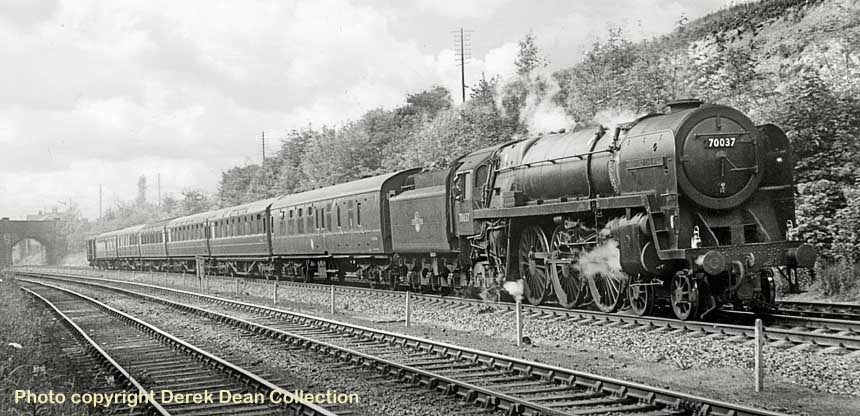
Programme authorised 4th January 1951, built at Crewe Works and completed on 29th January 1953, to Order No E483/228, costing £22,448. Withdrawn on 12th August 1967 from Carlisle Kingmoor.
ALLOCATIONS: BR Standard Pacific 70038 'Robin Hood' was allocated initially to Stratford MPD (30A) where it had a spell of six years working the Eastern Region's GE services out of Liverpool Street. This was followed by a familiar trend when 70038 was relocated to Norwich Thorpe (32A) along with other classmates during the early weeks of 1959. 70038 then moved to March depot (31B) in Cambridgeshire, but it was rather shortlived as the locomotive was then transferred in October 1961 to Immingham shed (40B) in North Lincolnshire for two years. This was followed by 'retirement' to Carlisle Upperby depot (12B) for just 8 weeks - and finally No 70038 finished up at Carlisle Kingmoor MPD (12A) until withdrawal.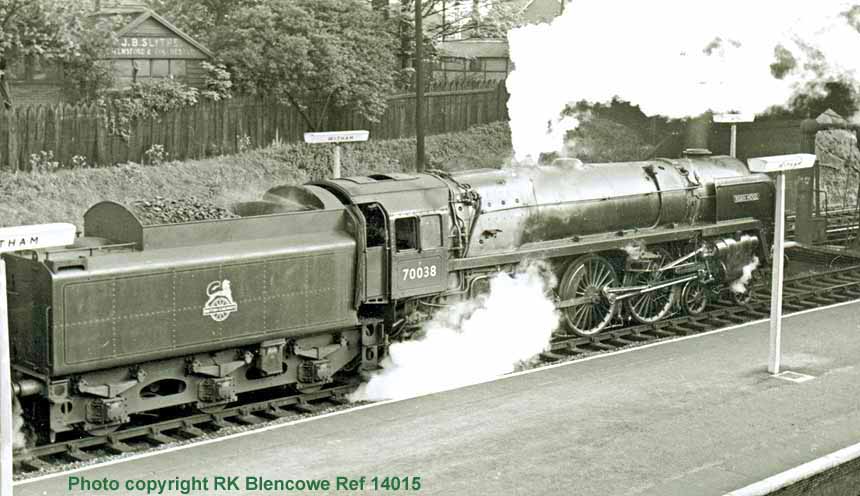
(Above-Below) Photographer RK Blencowe captures a very presentable Class 7MT Britannia 70038 'Robin Hood' restarting its train from Witham Junction in May 1957. Evidence of steam vapour emanating from the tender reveals the fireman is damping down the coal to keep the dust on the footplate down to a minimum for the remaining 38 miles to Liverpool Street station. The rural Essex station at Witham is the junction for local services on the Braintree branch. (Below) This 1961 view from Peterborough's Spital Bridge shows a profusion of trucks awaiting sorting in the vast goods yard, the East Coast Main Line through the centre and the former London Midland and Scottish Railway's branch lines to Melton Mowbray and Leicester to the right. But the main focus of our attention is Immingham's recently acquired Class 7MT Britannia 70038 'Robin Hood' at the head of a Kings Cross to Cleethorpes express; note in the right foreground the old guards van used by the local shunters as a rest-room.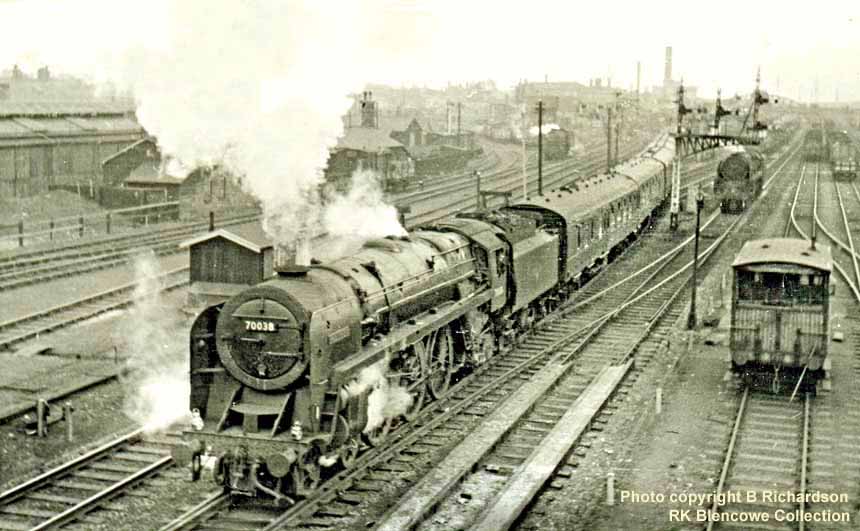
MODIFICATIONS: After resolving the problems experienced with the earlier Britannias, the construction of 70038 'Robin Hood' late in January 1953 meant that the locomotive entered traffic with the modifications installed into the build programme. These included modified axle centres (item 17) and bearings reseated; plain coupling rods (item 14); also the fitting of 3 raised sand box lids (item 16) which simplified the operation and aided the crew in refilling them. Being a Stratford depot resident the Britannia would have been fitted with a 'weak-type' front step (item 1) during 1954, before the full-blown version was fitted by Crewe Works in February 1956 during the engine's first General Overhaul; this also involved changing the original LNER return crank (item 15) to the later LMR version, retained by 4 stud bolts instead of 2 cotters; the rearmost bracket (item 7) for the regulator rodding was added along with a reconditioned boiler.
From this point forward the Britannia came under the care of Doncaster Works which it first visited in November 1957; the locomotive was next seen with a different look as the smoke deflectors (item 3) had been modified and the tender now sported a new corporate emblem (item 11). Again it was seen to be Doncaster Workshops that carried out a large proportion of the modifications for the Britannia engines working from both Norwich and March depots, and even Cardiff Canton on occasions. AWS equipment was adapted to suit 70038 in July 1959 and this was again fitted by Doncaster Shops. In all, Doncaster was responsible for equipping a total of 25 (61%) of Britannias, of which 19 (46%) were completed in 1959, compared to just 8 fitted by Crewe Works in the same year. The speedometer unit (item 13) was eventually added to the engine by October 1961 after heavy attention at Doncaster Shops and 70038 was seen to have the power warning plates (item 19) attached, for the benefit of the crews when working in the vicinity of the overhead wires. The Britannia made a return to Crewe Works early in 1964 and was given the austerity finish - no lining to the Brunswick Green paintwork. The lamp irons (item 2) were repositioned in 1963 and those lovely nameplates were removed for safe-keeping in late 1965.
(Above-Below) Resting at platform 6 beneath the cavernous roof at London Kings Cross, we find BR Pacific 70038 'Robin Hood' sharing the company with one of the new Brush Type 2 A1A-A1A diesels. By this time seven 'Britannias' had been moved from Norwich and March depots to Immingham MPD (40B) in north Lincolnshire to work the Peterborough-Spalding line; this was due to the axle loading of the LNER Pacifics being too heavy for the route, hence the Britannias on the Cleethorpes-Kings Cross service found themselves regularly 'rubbing shoulders' with the Class A1, A3 and A4 Pacifics on the East Coast Main Line. (Below) This is a good strong image by photographer Noel Machell of a grubby BR Pacific 70038 'Robin Hood' forging its way north through Hest Bank with a Manchester-Glasgow express on Saturday 4th July 1964. The stretch of line skirting Morecambe Bay between Lancaster and Carnforth is the only section of the 'West Coast Main Line' where rail passengers get anything like a brief glimpse of the said coast from the train; ten months after this picture was taken Hest Bank became the scene of a derailment involving a Glasgow to London sleeper, though no serious injuries were sustained by any of the 114 passengers.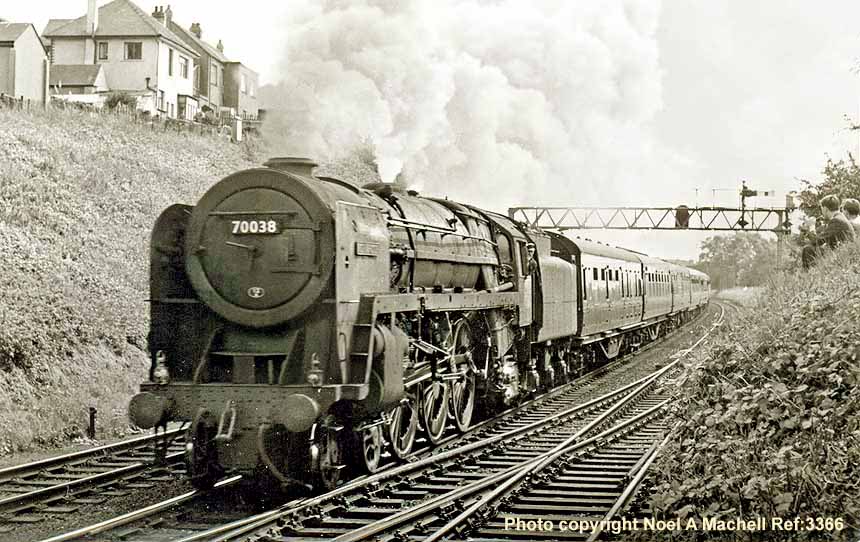
SERVICE RECORD: Rather little to report for the unremarkable career of 70038 'Robin Hood' since only three years-worth of mileages are recorded, with no accidents known and just a solitary Rail Tour to its credit. The all too short career of BR Britannia 70038 was interrupted by 5 visits to Crewe Works and 10 trips to Doncaster Shops, although 3 of those were basically for minor adjustments. 85,000 miles were logged for 1953, while the subsequent year returned a reduced 72,000, due in part to two trips to Crewe Works but this was followed by a good average of 86,000 for 1955. Regardless of the fact that no more mileages are available, 70038 continued to give an excellent account for itself in service and availability on GE main line services right the way through to 1961. The engine was available for service at the start of February 1953, two years after the arrival of the first Britannia, hence it was relatively easy to slot 70038 into the Stratford timetables; it was well used on the express services from Liverpool Street, including the 'Norfolkman' and 'East Anglian' trains, plus the 'Essex Coast Express' from 1958. The Britannia was selected for a Rail Tour in 1967, hauling a train from Stockport to York (see under 'Sightings' below).
SIGHTINGS: In May 1953 a very new and sparkling Britannia 70038 'Robin Hood' was viewed leaving the very long main platform at Cambridge Station; the four month old locomotive was returning to Liverpool Street having taken a morning express to Norwich, possibly the 'Norfolkman' which continued onto Cromer and Sheringham. A wonderfully evocative image was recorded at Liverpool Street station in April 1954, as 70038 awaited departure with a Norwich express from platform 10 on the west side of the large Great Eastern terminus. The Pindar Street taxi ramp was an absolute favourite location for photographers and avid loco-spotters. Following the engine's first General Overhaul at Crewe Workshops in 1956, a pristine engine was observed standing out like a sore thumb in the vast expansive yard at Stratford MPD. A couple of months later a somewhat less than immaculate engine displaying a full front step and a rather grubby exterior - due in part to the usual April weather - was seen at Shenfield hauling the 'East Anglian' towards Liverpool Street; the weather had also affected the condition of the headboard,which was almost completely covering the Norwich coat of arms with layers of grime. The route from Norwich to Doncaster Works and vice-versa, was not an easy one for a Britannia going for repairs or maintenance, some heading back via the West Coast Main Line to Euston and then via the North London line to the GE section; alternatively some Britannias were observed working a light freight along the East Coast route to Peterborough and then via Ely to their home depot at Norwich. The latter was the case as a gleaming 70038 'Robin Hood' was discerned gliding along through a serene wooded cutting south of Barkston, between Newark and Grantham, returning home after overhaul in July 1959, having all the modifications completed except for the addition of the speedometer (1961). Transfer to March depot took place the following year, by which time the general external condition of the Britannia class had deteriorated due to a total lack of any cleaning - a trend that continued throughout the early 1960s to the ultimate and final curtain in 1967. Viewings of 'Robin Hood' during this period showed a grime-encrusted and run-down engine, basically neglected because the end of steam was in sight, a situation only enlightened when the preservation movement gained momentum and many Railway Societys organised special rail tours. One such tour saw a very smartly turned-our 70038 'Robin Hood', with hand painted nameplates, hauling an enthusiasts special train from Stockport to York, having taken over from an AC Electric locomotive in July 1967.
(Above) The exceedingly clean condition of BR Britannia 70038 Robin Hood is all down to a group of ardent steam enthusiasts who put in a good deal of elbow grease to get the locomotive into such an excellent state. BKB Green's photograph was taken at York during the Stephenson Locomotive Society (Midland Area) Electric-Steam Tour on 2 July 1967. An AC Electric was responsible for both outward and return legs between Birmingham New Street and Stockport, while 70038 was in charge of the run over the Pennines via the Standedge to York and back. A comment posted on the excellent 'Six Bells Junction' website HERE states that it was a 'tardy' run for 70038; the brakes had come on 2 or 3 times during the journey, presumably from a loss of vacuum pressure within the train consist.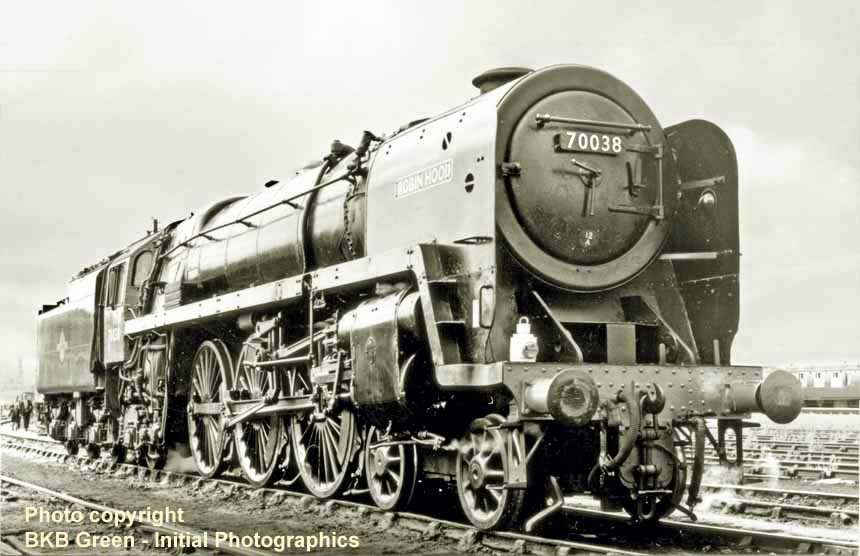
DISPOSAL: Following withdrawal on 12th August 1967 from Carlisle Kingmoor, 70038 was stored there until the end of the year when it was transferred to J.McWilliams of Shettleston to be cut up. Shettleston is a suburb of Glasgow, being just over three miles to the East of the City Central.
Programme authorised 4th January 1951, built at Crewe Works and completed on 9th February 1953, to Order No E483/228, costing £22,448. Withdrawn on 12th September 1967 from Carlisle Kingmoor.
ALLOCATIONS: As with nine other Britannias, 70039 Sir Christopher Wren began his service working from Norwich Thorpe MPD (32A), but the engine was soon moved along to Stratford (30A) in June 1953, continuing a long association with the Great Eastern section. The well-worked Britannia was transferred back to Norwich shed in January 1959, after the decision was taken to congregate all the class working on the GE rails, at the same depot, so that maintenance could be intensified there. 70039 was one of seven Britannias that were transferred over to Immingham depot (40B) between December 1960 and September 1961, with 70039 being one of the first to arrive. The locomotive stayed at the North East Lincolnshire depot for almost exactly three years before moving on to Carlisle Upperby MPD (12B) for three months, and then ultimately onto Carlisle Kingmoor shed (12A) to complete his service.

(Above) As mentioned earlier, 70039 was completed at Crewe Works on 9th February 1953, costing £22,448. However fast-forward to 13th April 2013 - a month short of 60 years - and one of 70039's nameplates (measuring 70" long, the front repainted; the back in fine original condition) went under the hammer at a famous Great Central Railwayana Auctions for £13,000…more than half the original cost of the locomotive! Click HERE to visit the GCRA website.
(Below) 7MT Britannia 70039 Sir Christopher Wren slows for the stop at Ipswich on a London Liverpool Street express during August 1955. The Stratford engine would often make the London to Norwich return trip twice in one day, notching up 460 miles regularly. Behind a smart looking engine is a rake of rather ancient teak coaches, which were commonly seen on these types of trains in the early years of the Britannias on the Great Eastern section. Image from the large Archive of Rod Blencowe.

MODIFICATIONS: 70039 was completed 16 months after 70024 'Vulcan', this was quite simply down to an acute shortage of steel following on from World War 2, but this allowed Crewe Works the opportunity to apply the modifications that had been found to be necessary, during the service period of the other engines. These amounted to 5 items: item 17 - the hollow axles were 'plugged' and the wheel bearings seated correctly; item 16 - the sand box lids were raised from new and were now three in number; item 9 - the flexible screen was fitted at this time, helping to prevent draughts at the back of the cab; item 8 - the reverser recouperating spring was contained from new; item 5 - the steady bracket was fitted to the forward
 rod of the regulator from new. Allied to these changes, we should note that the lamp irons (item 2) were of the GE type i.e. longer variety to accommodate the large white discs that were commonly seen on SR and GE section trains, also the wheel coupling rods (item 14) were of plain section from new, giving added stability and strength.
rod of the regulator from new. Allied to these changes, we should note that the lamp irons (item 2) were of the GE type i.e. longer variety to accommodate the large white discs that were commonly seen on SR and GE section trains, also the wheel coupling rods (item 14) were of plain section from new, giving added stability and strength. The first seen modification was the weak-type front step (item 1) which would have been fitted by Stratford Works, possibly late in 1954, or certainly early in 1955. The temporary step was replaced with a deeper and stronger fitment altogether when at Doncaster Works during September 1956, thus giving a safer platform for the crew to stand on when adding the train's headboard. 70039 continued to be maintained at Doncaster and so most of the modifications in service were performed there. This included the smoke deflectors (item 3) which were modified in February 1958 to type LMR 1, indicating the handrails were removed and two backed handholds used instead. So yet again it was Doncaster Works that modified the Britannia smoke deflectors as they did with all of the class that passed through their doors; they changed a whopping 66% of the 39 engines to be converted. Also at this time the new British Railways emblem (item 11) was applied to the tender, while the AWS equipment (item 20) was added by Doncaster the following year, in 1959. The speedometer (item 13) was added by Doncaster Works in August 1961, which now seems ludicrously late given that the final ten Britannias were fitted up when built in 1954, but again highlighting the vagaries of the modifications of the class. Then along with the power warning plates (item 19) affixed to the locomotive, the LNER return crank was changed to the LMR type at Crewe Works in August 1962 (below).
The only other change of note was that the lamp irons (item 2) were repositioned, at the front of the engine, to comply with the new directive on safety of the crew in relation to the danger of the overhead live wires. It would seem that the engine livery (item 12) was repainted in 1964 as the austerity measures brought in, meant that all future Britannias were painted plain green without any lining added at all.
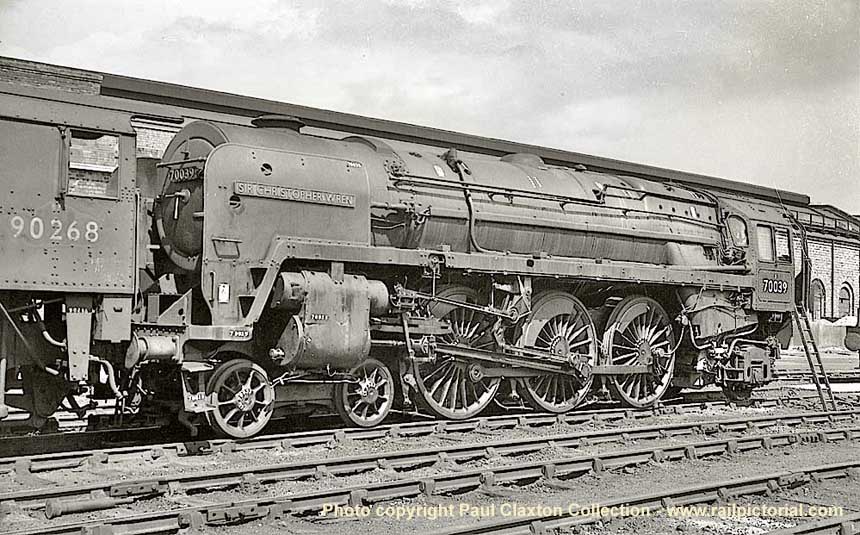
(Above-Below) 70039 at Crewe Works: An opportunistic photograph from the Collection of the intrepid Paul Claxton, depicting 7MT Britannia 70039 Sir Christopher Wren prepared for entry into Crewe Works in July 1962 and showing stencilled numbers on all parts to be removed. Prominent is the nameplate which was the longest of the Class (except for 70048) and all the modifications are seen to be done but for the LNER return crank, which was altered to LMR type at this visit. There would have been an issue with the position of the step ladder in this day and age, but no-one took notice of such things back then. (Below) Clive IK Field has captured this image for posterity; Britannia 70039 Sir Christopher Wren wheels its train into Kings Cross Terminus Station, dated October 1962 in the period of the allocation of seven Class 7MT locomotives at Immingham depot (40B) on the North East Lincolnshire coast. The longest nameplate of all the Britannias (except 70048) is prominent on the smoke deflectors, as the fireman surveys the scene at the busy station.
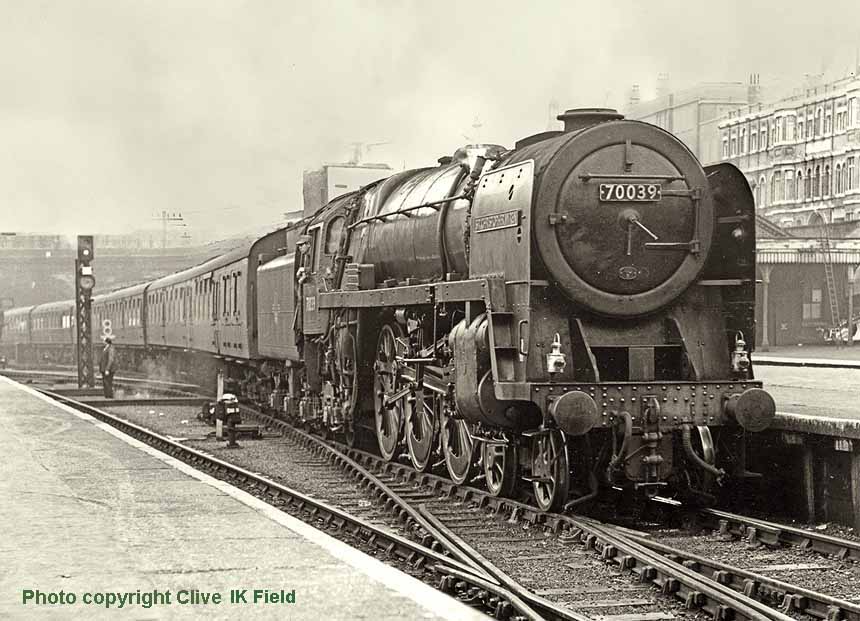
SERVICE RECORD: Being built in 1953 meant that the recorded mileage figure of 60,600 miles for 70039 was quite high, but the following year's figure of 104,200 miles was extremely high when compared with a measly reading of 25,300 for 70004 William Shakespeare (extreme example) and was more than twice the average mileages of the Western Region Britannias. In 1954 70039 recorded a further 87,500 miles which reflected the excellent availability and usage of the Britannias on the Great Eastern section. The figure of more than 104,000 miles equates to 334 miles per day, day in and day out based on a six day working week. A special train, booked to run non-stop from Norwich to Liverpool Street, was recorded by a Locomotive Inspector: Mr PW Howard, to assess the possible speeds over the normal route of the express trains to London. According to Cecil J Allen's book 'British Pacific Locomotives' published by Ian Allan Ltd, the engine used was 70039 hauling nine coaches, a load of 330 tons, and the Britannia was manned by a Stratford crew: Driver SJ Elgram and Fireman P Rhodes, with the driver using 40% of regulator cut-off pretty much the whole of the journey, including the climb to Trowse Upper Junction, Bentley and also Ingrave summit. A top speed of 90 mph was recorded through Diss and Stowmarket, but many signal checks were suffered caused by a poorly running Class B1 4-6-0 in front of them. It was calculated from the recorded figures that the net time for the trip of 115.05 miles was 105 minutes, which was no less than 17 minutes inside the allotted time (continued below).
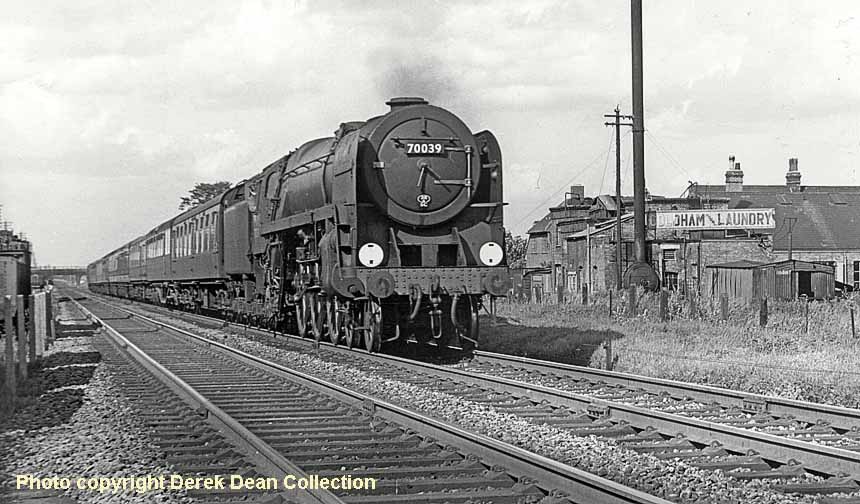
(Above-Below) During August 1958 Britannia 70039 races towards Cambridge with a Norwich express and would continue to Ely and Thetford, the route often used because it avoided the 'switchback' line through Colchester and Ipswich. Prominent on the locomotive are the large white discs, preferred to lamps in daylight hours, and highlights on the numberplate and also the shedcode which serve to show up the rather work-stained engine. (Below) An imposing image from A Scarsbrook, courtesy Initial Photographics, shows Class 7MT 70039 Sir Christopher Wren powering its way North at New Southgate with an express from Kings Cross to Cleethorpes on the coast of Lincolnshire. Having being ousted from the Great Eastern Lines by the new Diesels, the engine was facing an uncertain future before moving to Immingham depot (40B) in December 1960 to find favour there, whilst spotters on the Great Northern Route were happy to see some different engines from other Regions.

The locomotive suffered a very serious wheel slip in service in 1956, but the problem was simply a lack of clearance within the horn guides and when the drive axle was deflected upwards the axle stuck, completely losing traction on the rails. Working from Stratford depot, in the main, 70039 would have been a regular performer on the 'East Anglian' and 'Norfolkman' and would usually have made the journey from London Liverpool Street to Norwich and back, twice in the same day. The locomotive was also a regular on 'The Essex Coast Express' service, the Liverpool Street to Clacton express which was only inaugurated in 1958, but became almost the last regular steam-hauled service from London Liverpool Street.
70039 Sir Christopher Wren was recorded as entering Stratford Works one time only, with six visits to Crewe Works and on eight occasions was seen to enter Doncaster Works, who were responsible for 90% of the modifications to the locomotive. After transfer away from the Great Eastern section, 70039 worked many expresses from Cleethorpes to London Kings Cross and would have been one of first of the class seen with regular trains into the Eastern Region terminus station.
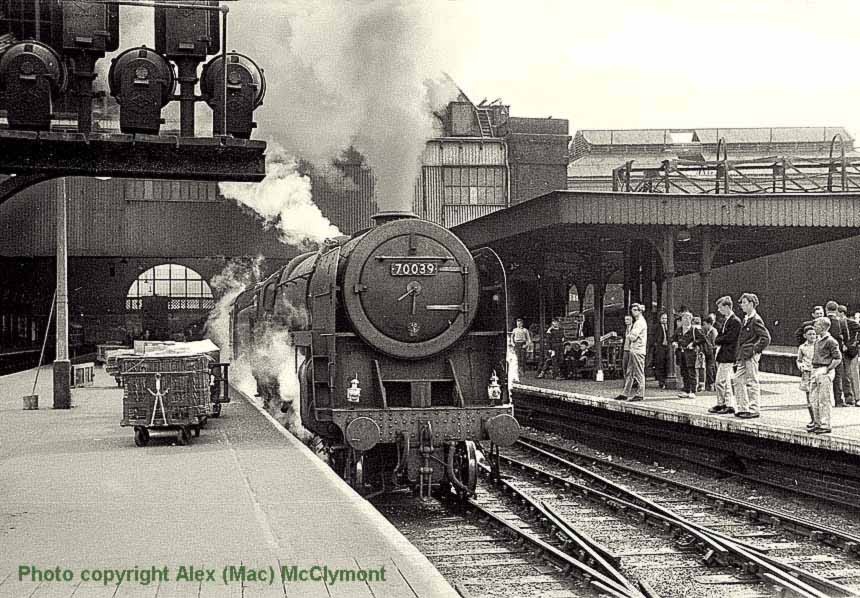
(Above) 70039 at Kings Cross:Alex McClymont chose to record this scene at Kings Cross terminus, for which we are eternally grateful. I wonder if any of the twenty-odd spotters can identify themselves, many watching as the 7MT Britannia 70039 Sir Christopher Wren sets out for Cleethorpes (most probably) in the summer of 1962. Seven Britannias were chosen to go to (40B) because of the weak bridge restrictions on the Peterborough to Spalding line. By the end of the year the Britannia was ousted by diesels again, but was found other work by Immingham depot for the following 12 months, before being allocated to Carlisle sheds
SIGHTINGS: 70039 was first viewed entering Liverpool Street station with the up 'East Anglian' and showing that the weak type front step, with narrow support, had been fitted; whilst another Britannia Pacific was awaiting departure from the adjacent platform with a down express in August 1956. Also during 1956 the tender less locomotive was espied at Doncaster Works without its centre drive wheels awaiting spares and this relates to the wheel slipping incident mentioned about ten lines above. Two years later the engine was seen at Colchester Station with an express for Norwich, having modified smoke deflectors and a fully modified front step. A young uniformed schoolboy admires the scene and one wonders if he could have appreciated the gentle curve of the whole station or the wonderfully distinctive canopy trim which served to decorate the full length of the station roof. Shortly after that view, 70039 Sir Christopher Wren was to be seen in rather grubby condition, but going very well up Brentwood Bank (1 in 103 climb) hauling a train of old ER stock carriages on an express towards Colchester. When the engine was outposted to Immingham depot (40B), 70039 was often seen hauling express trains of LMR stock into London Kings Cross Station and generally found to be kept in decent condition by the shed staff, who also applied some white paint to highlight the smokebox door hinges, the shedcode and the front number plate, as seen in April 1961 at Kings Cross terminus. In June 1962 70039 was pictured on a Grimsby train, but was threading the tunnel at Wood Green and powering its way Northwards, still looking in very smart condition, with the longest single line nameplate of the class very prominent. Whilst In 1963 70039 was spotted at the head of an excursion train from Immingham to Blackpool, travelling along the Calder Valley and was now looking very work-stained and slightly down at heel. Later, in 1964, the Britannia was viewed passing Mauchline Station south of Kilmarnock, with a southbound relief to the 'Thames-Clyde Express' and was to be seen in a condition that denied any attempt to see the colour of the once-green paintwork. On 5th February 1967, a now nameless 70039 was captured at Ais Gill on a return working from Edinburgh to South Wales, taking Rugby supporters back home; Wales having lost 11 points to 5 at Murrayfield the previous day. The locomotive was in the usual condition for the period, but at least was putting on a strong performance with a full head of steam.
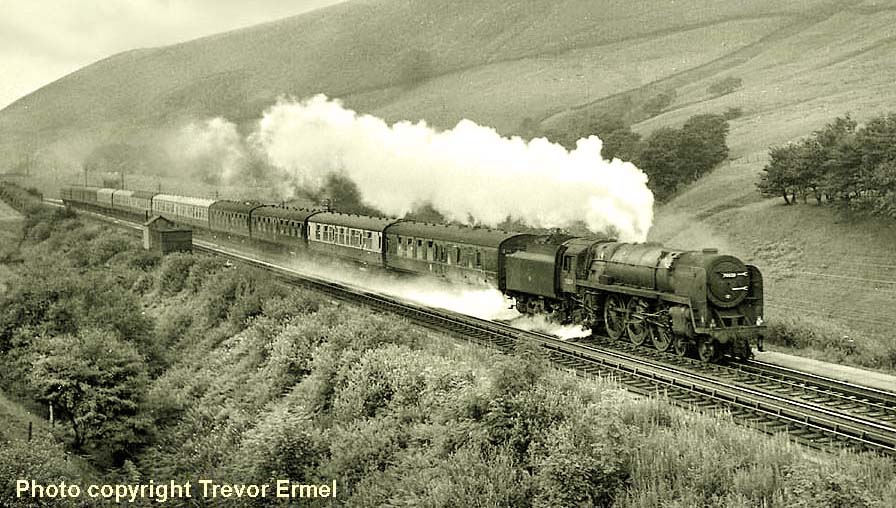
(Above) 70039 on Dillicar troughs...a wondrous sight captured by the remarkable Trevor Ermel, of Britannia 70039 Sir Christopher Wren running over the southbound troughs in the Lune Gorge, hauling an express from Glasgow. The troughs were over 500 yards long and took about 7- 8 minutes to refill fully.
DISPOSAL: 70039 was withdrawn from service on Saturday 23rd September 1967, stored at Carlisle Kingmoor yard until the end of January 1968 and then transferred to J.McWilliams of Shettleston to be cut up. Shettleston is a suburb of Glasgow, being just over three miles east of the City Centre
Programme authorised 4th January 1951, built at Crewe Works and completed on 21st March 1953, to Order No E483/228 costing £22,337. Withdrawal was on Saturday 15th April 1967 from Carlisle Kingmoor.
ALLOCATIONS: 70040 Clive of India was released to traffic at the end of March 1953 and initially allocated to Norwich depot (32A) where it joined ten Britannias, but by June No 70040 was reallocated to Stratford MPD (30A). Late into January 1959, the locomotive returned to Norwich (32A), helping to create a pool of 22 Britannia Pacifics there, but this lasted only two years. In mid-December 1960 70040 moved to Immingham depot (40B) along with 70039 Sir Christopher Wren and 70041 Sir John Moore. Three years later the engine was allocated to Carlisle Upperby shed (12B) from December 1963, but just three months later moved to Carlisle Kingmoor MPD (12A) from 1st March 1964 until withdrawal in April 1967.
(Below) London Liverpool Street station's platform 8 is the scene of this outstanding image by RK Blencowe depicting BR Britannia No 70040 Clive of India about to leave the old Great Eastern terminus with the down 'Norfolkman' in 1956.The titled train was initiated in September 1948, departing London at 09.30 am and arriving 11.30 in Norwich where the train reversed before continuing to Cromer and Sheringham. Of note is the locomotive's weak-type front step that Stratford added to aid engine crews with the fitting of the heavy titled-train headboards on the topmost lamp iron.


(Above-Below) Seen on the 70 foot turntable at Norwich (32A) is Britannia Pacific 70040 Clive of India, now facing the correct way for its return to London (white discs still fitted) on the 10th June 1956. This turntable was installed in 1935 to supplement the smaller (1909) table at the top of the yard close to Carrow Road Bridge. The locomotive is in a poor external state, but during the summer months the fleet of Britannias were kept very busy and shed staff was allowed little time for such work as cleaning to be carried out. (Below) Soot-blackened overhead wires and roof awnings dominate this view of a very unkempt BR Standard 7 No 70040 Clive of India backing onto a Liverpool Central-Harwich boat train at Sheffield Victoria's platform 4 in May 1960; known as the 'North Country Continental' the train had a long history dating back to 1885. The overhead wires were installed in 1954 as part of electrification of the route between Manchester and Sheffield via Woodhead.
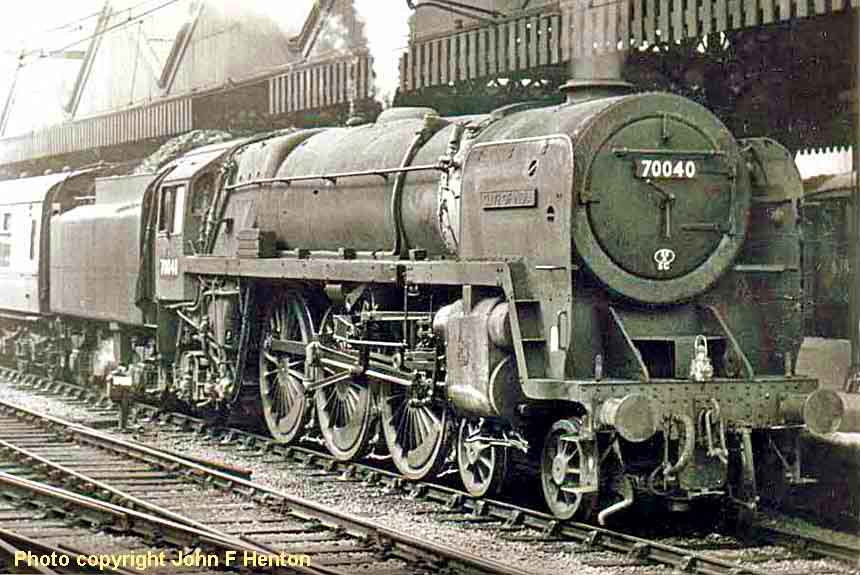
MODIFICATIONS: Heeding the lessons learned from the first batch of Britannia engines, 70040 Clive of India was constructed with plugged axles (item 17), correctly seated wheel bearings and plain coupling rods (item 14); also the engine began service with 3 raised sand box lids (item 16); a pair of tender steps (item 10) and the flexible cab sheets (item 9) in place. Around 1955 a temporary front step was added by Stratford Works to aid engine crews in the fitting of the heavy cast titled train headboards used extensively on the Great
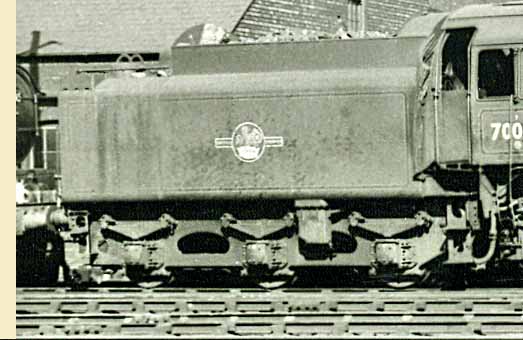 Eastern section. The full modification front step (item 1) was duly fitted by Doncaster Works in January 1957 and on the next visit in May/June 1958, the smoke deflector handrails (item 3) were replaced by LMR type 1 handholds incorporating backing cups, two on each side. At the same time the new British Railways emblem (item 11) was added to the tender, but the right-hand side crest was facing the wrong way (see inset right); this was not initially noticed, but strict Heraldic rules maintain that the rampant lion must always face to the left. The regulator rod support bracket (item 5) was fitted from new and it would be safe to say that the bracket for the rearmost rod (item 7) ought to have been added around the 1957-59 period, but it never was fitted. It was noticed also at this time that the nearside lubrication pump operating rod (item 18) had been shortened by Doncaster to produce more atomised oil to the valves and cylinder.
Eastern section. The full modification front step (item 1) was duly fitted by Doncaster Works in January 1957 and on the next visit in May/June 1958, the smoke deflector handrails (item 3) were replaced by LMR type 1 handholds incorporating backing cups, two on each side. At the same time the new British Railways emblem (item 11) was added to the tender, but the right-hand side crest was facing the wrong way (see inset right); this was not initially noticed, but strict Heraldic rules maintain that the rampant lion must always face to the left. The regulator rod support bracket (item 5) was fitted from new and it would be safe to say that the bracket for the rearmost rod (item 7) ought to have been added around the 1957-59 period, but it never was fitted. It was noticed also at this time that the nearside lubrication pump operating rod (item 18) had been shortened by Doncaster to produce more atomised oil to the valves and cylinder. The following year the AWS equipment (item 20) was applied by Doncaster Works, showing again that the majority of the Britannia Class (27 of 41) had to wait until 1959 before receiving this important safety system. In 1960, from mid-January, 70040 was in receipt of a General Overhaul at Doncaster Works, including fitment of a speedometer unit (item 13) and also a boiler replacement was carried out. The power warning plates (item 19) were applied at the same time, giving the crew due warning of the danger of live-wires overhead at a number of locations. The LNER return crank (item 15) lasted out until April 1962 when it was modified by Doncaster Works to the LMR type, which was recognisable by the four securing bolts, instead of the two cotter pins as previously fitted. The lamp irons (item 2) were originally the long GE type to accommodate the white discs, which were used extensively for daytime running, but were a mix of long and short irons when allocated to the LMR from the end of 1963; the nameplates were removed after a visit to Crewe Works in the summer of 1964. Unusually for one of the former Great Eastern engines, 70040 did have a tender swop late in 1964 which resulted in the locomotive completing its service coupled with No 70022's tender complete with the Great Western type dome fitted over the water scoop.
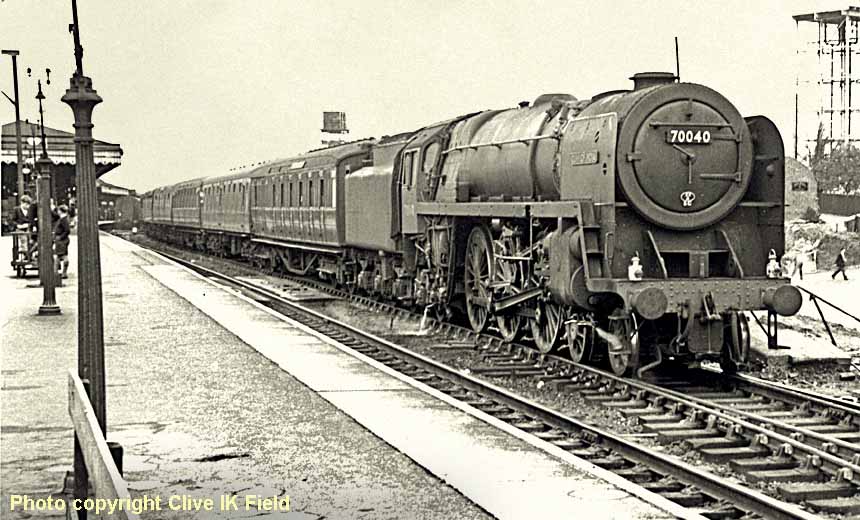
(Above-Below) The outstanding feature of Colchester station, built in 1843 by the Eastern Counties Railway, was the long sweeping platforms and ornate roof canopies; but all that changed in 1962 when a new clinical station was completed. This view by Clive Field shows BR Standard 70040 Clive of India ready to continue its journey to Norwich on Saturday on 3rd September 1960; note the group of young spotters awaiting the next express to roll into Colchester North, as it was known locally, to differentiate from Colchester Town which was nearer to the town centre. (Below) Britannia Pacific 70040 Clive of India forges south through Chesterton Junction with a morning express for London Liverpool Street. Geoff Sharpe captured the image from the safety of the East Side signal box, which controlled the junction with the St Ives branch line on the left and the goods traffic from the Permanent Way Depot, just off to the right of the branch; the depot supplied concrete sleepers and such to many parts of the system. Along the branch was Histon where many tons of fruit was transported to the Chivers jam factory each and every year.
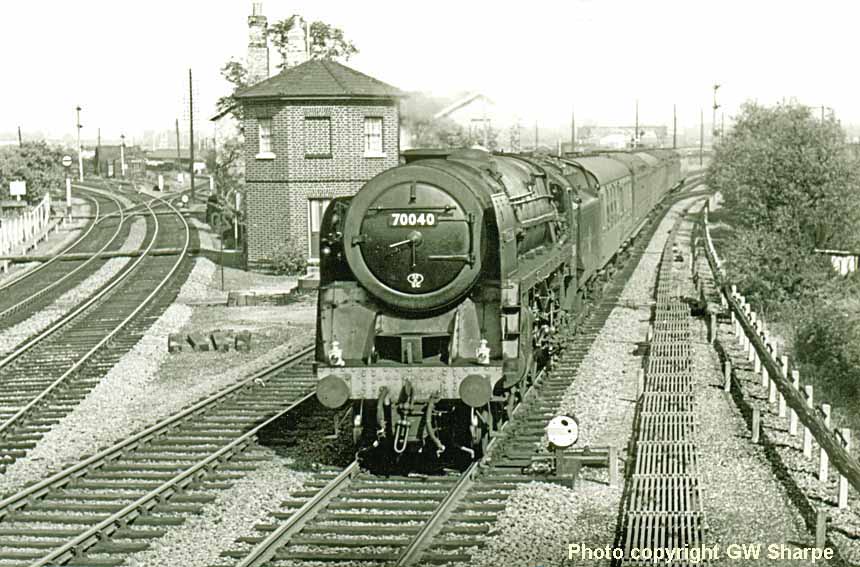
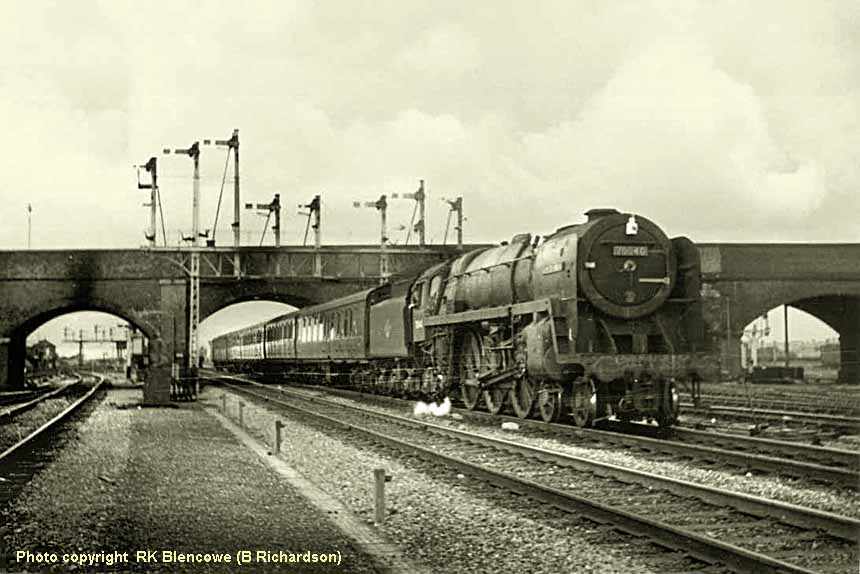
(Above-Below) From the splendid Negative Archives of Rod Blencowe comes this lovely image by B Richardson, who captured BR Pacific 70040 Clive of India approaching Peterborough station with a local service from Cleethorpes; this must have been a very easy trip for the fireman…all that level ground to cover and only level crossings to worry about. The Immingham-based engine is passing the extensive goods yards at the north end of the station and the New England coaling tower can be discerned at the rear of the train - the neatness of the lineside ballast is commendable. (Below) Local Photographer, AG Forsyth has captured this image for Initial Photographics, showing BR Standard Pacific 70040 Clive of India forging its way north through Greenwood with a Kings Cross-Cleethorpes express in the spring of 1961. 70040 took part in speed trials on this route, resulting in 20 minutes being cut from the schedules for the 155 miles to the North Lincolnshire coast. The sparklingly clean lamps provide a stark contrast to the soot covered engine, although the white-painted highlights on the smokebox add some relief.
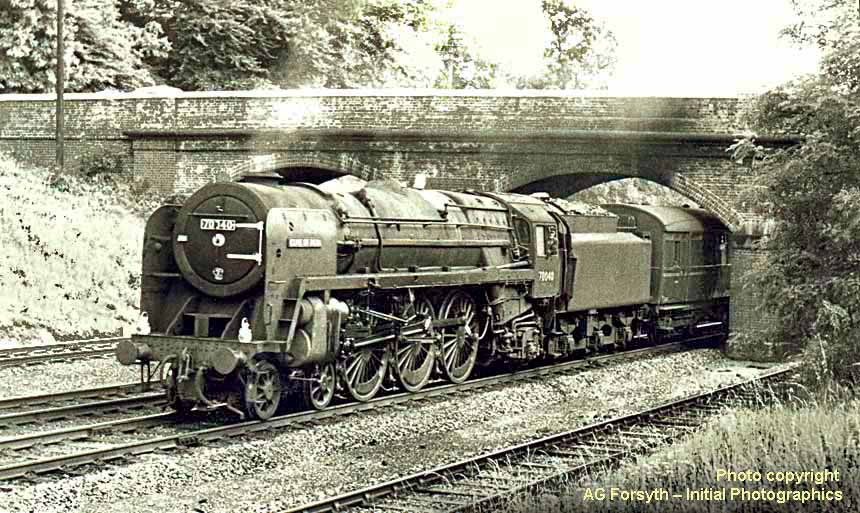
SERVICE RECORD: 70040 was easily slotted into the many Norwich duties, as the crews were very familiar with the operation of the Pacifics already in service; typically this involved hauling the 'East Anglian' or the 'Broadsman' from Norwich Thorpe to London Liverpool Street Station, then after two more trips to Norwich, a late-night parcels or freight to complete the diagram for the day. After switching to Stratford depot, 70040 could be seen hauling the 'Day Continental' or the 'Scandinavian' boat-trains which provided connections to Holland via steamships from Parkeston Quay. Other titled-trains at the time were the 'Norfolkman' and the 'Butlin Express' for Clacton, the latter having a large circular headboard that covered the entire smokebox. Of interest is the GE section's decision to use the title 'Butlin Express' whereas the headboards on the GN section out of Kings Cross carried the name 'Butlins Express'. No 70040 also featured on the 'Essex Coast Express', a new service inaugurated in June 1958 between London and Clacton in a time of 86 minutes. After its transfer to Immingham depot in North Lincolnshire, 70040 was involved with speed trials between Kings Cross and Peterborough early in 1961; these were arranged to establish how much time could be cut from the journey based on Class B1 haulage and a train loaded to 12 bogies; a time of 79 minutes was recorded, resulting in an average of 20 minutes being trimmed from the schedules on both up and the down trains. Recorded mileages for 70040 was 63,700 for 1953 (9 months), followed by a terrific 102,700 miles for 1954, yet a comparative low of 68,000 in 1955, although a visit to Crewe Works was squeezed into this schedule. 70040 Clive of India entered Stratford Works once for minor attention, but was recorded as visiting Doncaster Works on 8 occasions, with five more noted at Crewe Works, but again it was Doncaster that did the lion's share of the modifications.
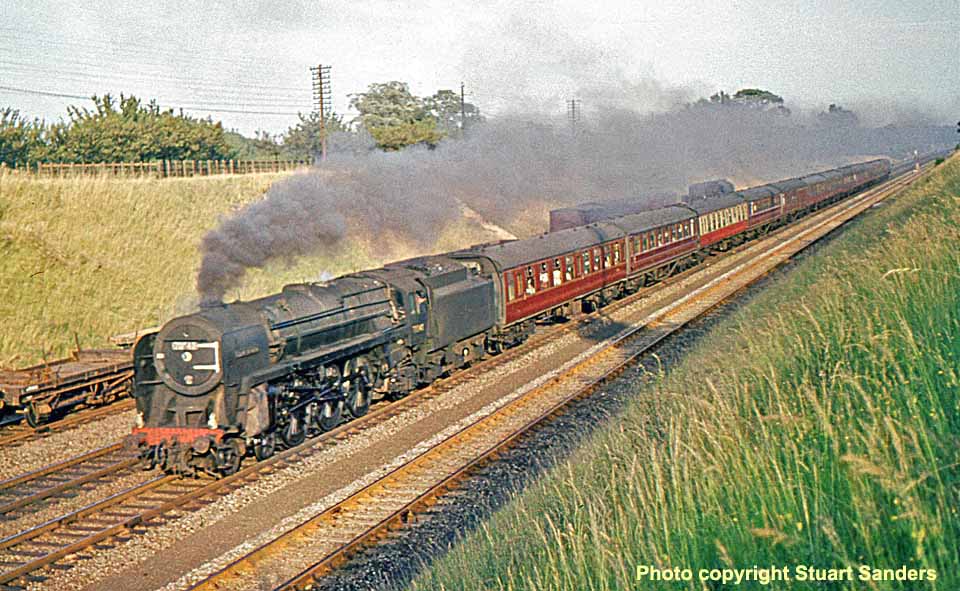
(Above-Below) Seen running fast down the gradient between Stevenage and Hitchin, Britannia Pacific 70040 Clive of India of Immingham depot (40B) was captured by Stuart Sanders in the early part of 1961. This Britannia was one of seven that were reallocated to North Lincolnshire from Norwich depot after the new diesels took over GE services; the Britannias were used for the Cleethorpes-King Cross trains and express fish trains to Manchester and Whitland in South Wales. These rosters were once dominated by Class B1 4-6-0 types, although Gresley V2s and Peppercorn A1 Pacifics were observed on the Kings Cross trains previously in the 1950s. Also of note is the BR Standard WD on the Up slow line with some bolster wagons. (Below) This fine action image from AG Forsyth for Initial Photographics, shows BR Standard Britannia No 70040 Clive of India storming the climb to Potters Bar on the East Coast Main Line during the summer of 1962. The locomotive looks to be in very good order and has now all the expected modifications except for the second bracket on the regulator rodding. The first coach appears to be a Newton steel-bodied brake end with opaque elliptical window fitted to the toilets.


(Above-Below) The fine lines of Immingham-based Britannia 70040 Clive of India are shown to good effect in Clive Field's shot at King Cross Station on Saturday 20th September 1962; the locomotive is awaiting reversal out of platform 7 for servicing after bringing in an excursion from Cleethorpes. No 70040 looks in good condition due to a recent overhaul at Doncaster, although the drive axle tyres are now somewhat worn. In the background lurks one of the new breed of transport in the form of a diesel multiple unit for suburban services out of Kings Cross. (Below) The mainly freight depot at Immingham (40B) was situated in the Docks complex, six miles upstream from Grimsby; it was considered by many to be a strange choice for seven Britannias to be allocated at an average period of 25 months each. Rod Blencowe's fine image inside the eleven-track straight shed shows BR Pacific 70040 Clive of India displaying a specially made headboard to mark the occasion of the last steam hauled Cleethorpes to Kings Cross before the new diesels took over in early November 1962.
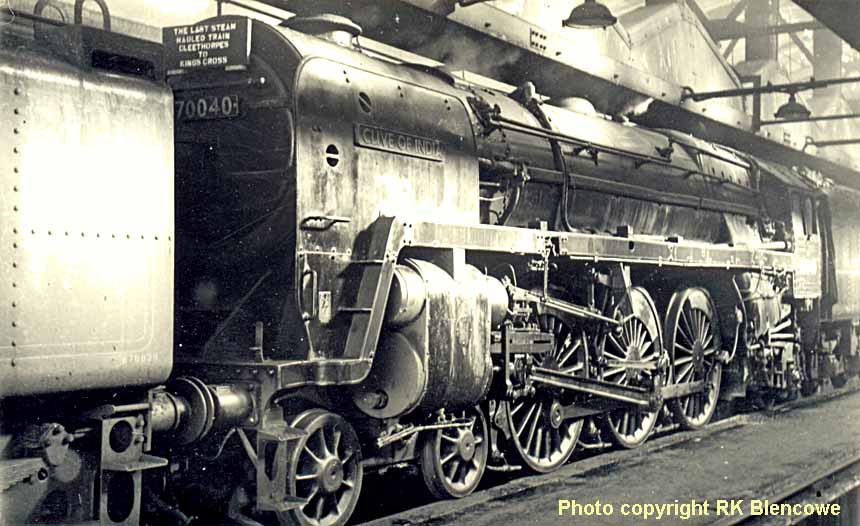
SIGHTINGS: 'Britannia' 70040 Clive of India was just five months old when captured hauling a Norwich-London express across the Trowse swing bridge, one of five such structures in the Norfolk Broads area. The following year, the engine was viewed in poor external condition and very much work-stained at Liverpool Street's West side awaiting passage onto the turntable. In contrast, a very clean BR 'Britannia' 70040 Clive of India was recorded storming the stiff 1 in 70 incline at Bethnal Green Station, a short distance from London Liverpool Street, with a morning train to Norwich early in 1957. Then in September 1958, not long after the smoke deflector modification had been carried out at Doncaster, 70040 was pictured on the west side of London Liverpool street station with an evening express for Clacton, but its general external condition was rather grubby albeit the engine displayed a full head of steam. In 1960, Liverpool Street's platform 11 was the scene of another view of 70040 at Liverpool Street awaiting departure with the 'Hook Continental' boat train on the evening of 28th June. On this occasion the train headboard had been placed over the buffer beam and not in the usual position on the topmost lamp iron. In close attendance was the immaculately kept, east side station pilot, Class J69 No 68619, with its fireman glancing at the powerful, but rather grubby 'Britannia' alongside. Following transfer to Immingham depot, 70040 was seen at Spalding Town station at the head of the morning express from Cleethorpes to King Cross on a hot day in June 1961; it was noticeable that the driver's side cab sheet had been torn away at the top end. During its three years stay at Immingham depot, the engine was generally kept in good order most of the time; indeed in March 1961, a very clean-looking 70040 was viewed leaving Grimsby Town station at the head of a long freight from March sidings to the West Marsh terminal on the East Coast; the engine had been bulled-up by shed staff with highlighted ironwork on the smokebox, including the shedplate and numberplate; it showed someone cared. In 1965, a reasonably tidy 70040 was captured awaiting the arrival of an 'up' train at the southern end of Carlisle Citadel Station, but by this time the now-nameless engine was in the company of Type 4 'Peak' class D20 - one of the new breed of traction entrusted with all the better turns, leaving the once-proud 'Britannias' feeding off scraps.
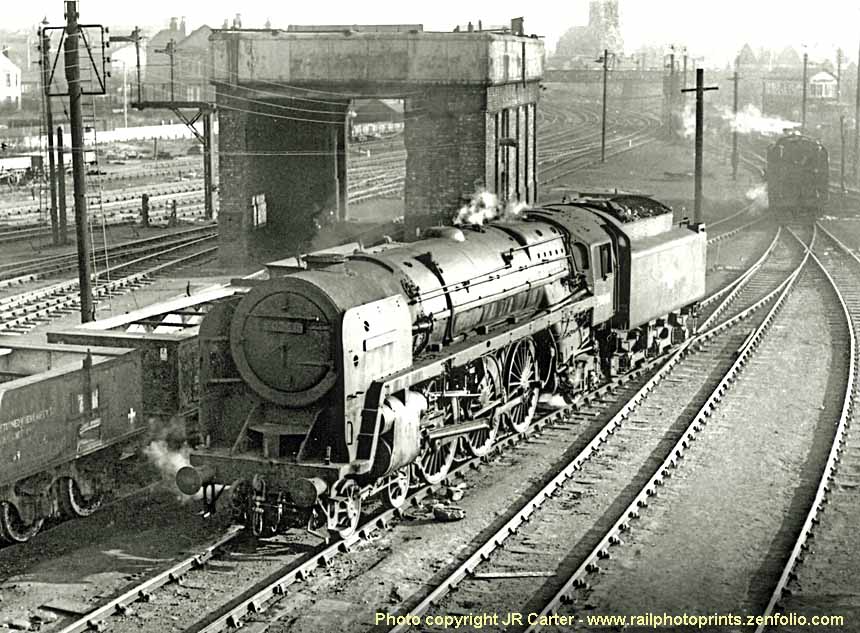
(Above) Footplate Cameraman, Jim Carter, took many photographs of his home shed at Patricroft (26F) in Manchester during his firing days, and here we can see BR Standard 70040 Clive of India moving towards the so-called 'New Shed' which was completed in 1903. The front of the engine displays a strange mixture of lamp irons, with the extremely long centre one contradicting the more normal top iron and the other two showing a step bracket, which steadied the lamp somewhat. The old 'coal 'ole' takes centre stage, beyond which is the east to west main line, and the Saint Andrews Church, Eccles dominating the skyline.
DISPOSAL: Withdrawal took place on Saturday 15th April 1967 from Carlisle Kingmoor. The engine was stored until November 1967 then transferred to J.McWilliams of Shettleston to be cut up. Shettleston is a suburb of Glasgow, being just over three miles to the east of the city centre.
Programme authorised 4th January 1951, built at Crewe Works and completed on 20th March 1953, to Order No E483/228, costing £22,337. Withdrawn 15th April 1967 from Carlisle Kingmoor.
ALLOCATIONS: 70041 was new to Stratford MPD (30A) where it remained for just short of six years before joining twenty-one other Britannias on 25th January 1959 at Norwich Thorpe (32A) depot thus pooling the Britannias' resources for the Great Eastern section. 70041 was one of the first of seven Britannias transferred to Immingham depot (40B) between December 1960 and September 1961. The locomotive stayed at the North East Lincolnshire depot for almost three years before moving on to Carlisle Upperby MPD (12B) for just seven weeks, and then ultimately onto Carlisle Kingmoor shed (12A) to complete his service from 25th January, 1964.
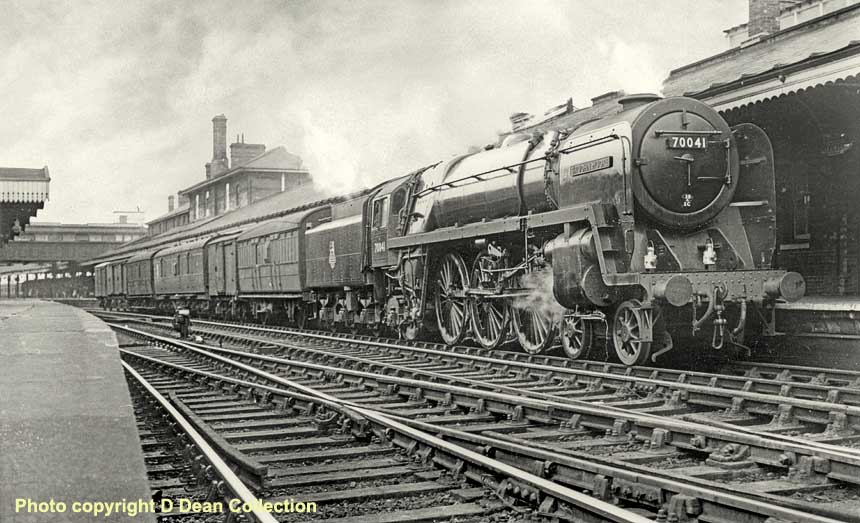
(Above-Below) A short van train, headed by a resplendent Class 7MT 70041 Sir John Moore, waits for a signal to proceed southwards from platform two at Ipswich Station towards Stratford depot, and after light repairs at Crewe Workshops, in December 1954, the locomotive looks to be in beautiful and original condition. A prominent feature of the Station's original buildings was the ornate chimney stacks, which were about fourteen in number; also to be admired were the decorative delights of the platform canopies, which were outstanding. (Below) Just a few miles into its journey is Britannia Class 7MT 70041 Sir John Moore, heading an express for London past livestock pens at Trowse, near to Norwich. The engine is viewed in original condition, being just two years old, and appears to be in very tidy condition when photographed by Rod Blencowe. The famous factory of J.J.Coleman was on the left-hand side beyond the row of cattle trucks and brought rise to the many bright yellow enamel signs seen around many stations, declaring Coleman's Mustard for sale; these days you can buy Colman's Mustard Chocolate Bar, made with fine plain chocolate and mustard powder.
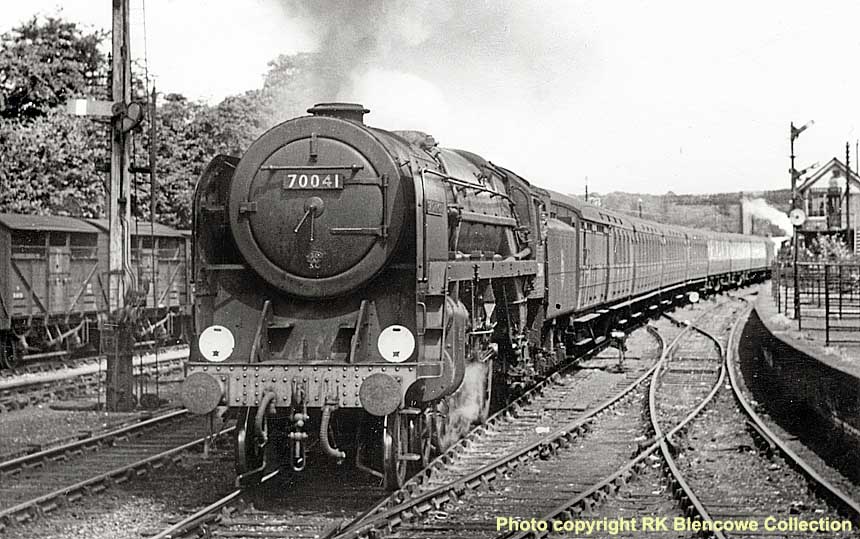
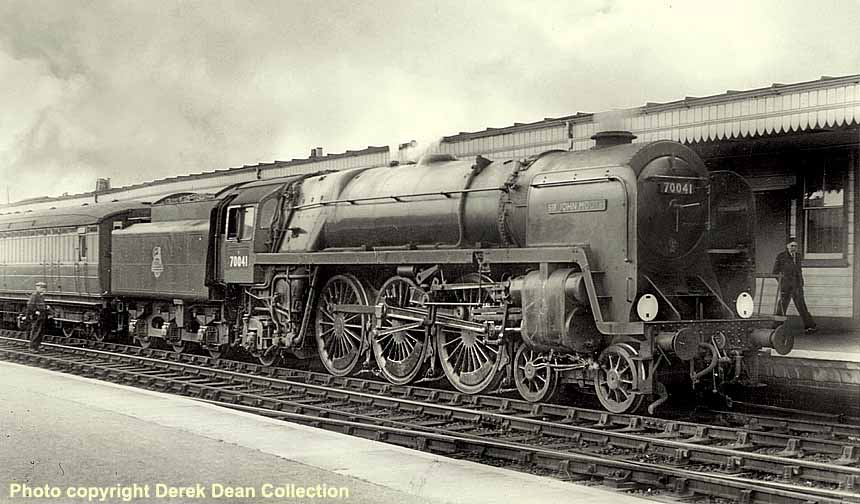
(Above-Below) In April 1955, Britannia 70041 Sir John Moore is seen at Ely Station in Cambridgeshire, ready to move on towards London Liverpool Street with an express service from Norwich Thorpe. Ely was an important location with branch lines to Newmarket and Huntingdon to the South and to March, Lincoln and King's Lynn to the North. (Below) Another wonderful image from BKB Green for Initial Photographics depicting a splendid looking Britannia 70041 Sir John Moore easing away from Ipswich Station on Friday 24th February 1956, a day which was obviously rather cold and wet, not at all agreeable to a cameraman awaiting his next capture. One notable change to the engine was the addition of a weak-type front step, as fitted by Stratford Works to all of its thirteen allocated Britannias. Beyond the locomotive and the island platform were the carriage sidings which amounted to eight tracks and usually required the attentions of a station pilot.
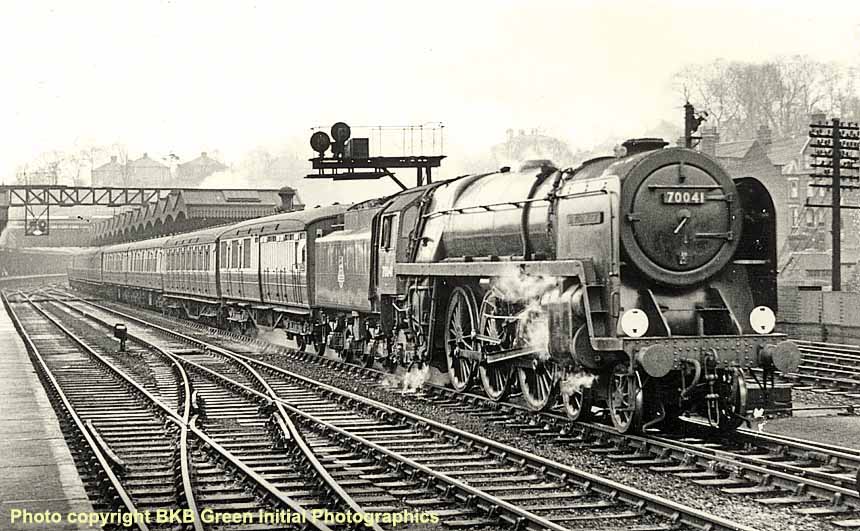
MODIFICATIONS: 70041 was completed over 17 months after 70024 'Vulcan'; this was quite simply down to the shortage of steel following on from World War 2, but this time scale allowed Crewe Works the opportunity to apply the modifications that had been found necessary during the service period of the earlier Britannia locomotives. These amounted to 5 items: item 17 - the hollow axles were 'plugged' and the wheel bearings seated correctly; item 16 - the sand box lids were raised from new and were now three in number; item 9 - the flexible screen was fitted at this time, helping to prevent draughts at the back of the cab; item 8 - the reverser recuperating spring was contained from new; item 5 - the steady bracket was fitted to the forward rod of the regulator from new. Allied to these changes, we should note that the lamp irons (item 2) were of the GE type i.e. longer variety to accommodate the large white discs that were commonly seen on SR and GE section trains, also the wheel coupling rods (item 14) were of plain section from new, giving added stability and strength.
The first modification was the weak-type front step (item 1) which was fitted by Stratford Works, possibly in April 1955, although the temporary step was replaced with a deeper and stronger fitment during a visit to Doncaster Works in January 1957; this modification gave a safer platform for the crew to stand on. During the same visit, the LNER return crank (item 15) was changed for the LMR version, which could be identified by the four set-pins used to secure it to the centre drive wheel.
Further visits to Doncaster Plant continued and 70041 emerged from there in June 1959, with modifications to LMR Type 1 smoke deflectors (item 3) and addition of the AWS equipment (item 20), with the pipework along the outside. Also the new BR emblem (item 11) was added to the tender, whereas the support bracket (item 7) for the rear rod of the regulator control and the speedometer unit (item 13) were not added until a visit to Doncaster Works during December 1961. This was late in the extreme given that the last ten Britannias were completed with their brackets and speedometer in place.
In 1962, during his time at Immingham depot 70041 had the lamp irons (item 2) changed; the long Great Eastern type were removed and unique irons were fitted left and right, which were elongated and stepped; while the centre iron was somewhat shorter. During 1964, 70041 lost all the lining from the locomotive livery (item 12) and later in the year, the nameplates were removed for safekeeping.
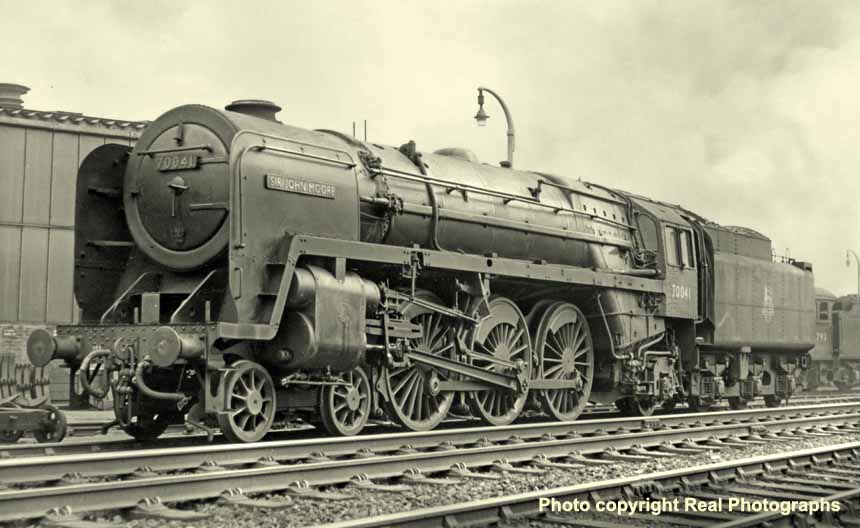
(Above-Below) A well posed Britannia image from Real Photographs, depicting 70041 Sir John Moore at rest at Stratford MPD yard in a somewhat grubby condition during September 1957, and displaying clearly the plain coupling rods, with the fluted connecting rod on the outside of those. The engine now has a full front step, replacing the weak-type fitted by Stratford in 1955, and the lubrication operating rod has been shortened to give more rate of atomisation to the valves and the single cylinder. (Below) A wonderful J.A.Coltas image, depicting Britannia 70041 'Sir John Moore' standing on platform 10 at Liverpool Street Station, having just arrived from Norwich Thorpe with an afternoon express. The locomotive is now a Norwich resident, having recently been transferred from Stratford depot, to pool all the GE Britannias together at the one location and maximise their effect on services. The long exposure time under the cavernous roof has created two apparitions to add interest to the scene and of note is the hydraulic oil container on the adjacent track buffer stops.

SERVICE RECORD: In his first year of service, 70041 Sir John Moore was recorded as covering 75,800 miles, which was an excellent return given that the locomotive was not completed until 20th March 1953. For 1954 the figure was 81,000; while in 1955 the figure was 80,000 miles, which was very good for the fact that the engine was out of action due to a 'hot-box' on the centre drive wheels; this was caused by bearing failure, either from lack of lubrication or due to metal fatigue. Maintenance records show that 70041 entered Doncaster Works at least nine times, and Crewe Works on at least three occasions, while the engine was known to visit Stratford Workshops at least twice. Apart from these occasions, 70041 returned a very high availability average and would have often been viewed on expresses to Norwich, such as 'The Broadsman' and 'East Anglian' or 'Norfolkman' which began in September 1948 to service Ipswich, Cromer and Sheringham. On Saturday 30th August 1958, 70041 set out from London with a relief excursion train bound for Glasgow, not anticipating that the engine would in due course haul the train the whole way to Glasgow and was seen the following day at Darlington on its way back South. When allocated to Immingham depot in North Lincolnshire, the engine was initially utilised on the express trains to London Kings Cross, joining the East Coast Route at Peterborough, but eventually 70041 was more increasingly used on express fish trains to Manchester Ashton Moss or to Whitland in Carmarthenshire. After relocation to Carlisle the Britannia was regarded as one of a crowd, no specific treatment was given and it was generally left to its own devices. The once proud locomotive would most likely be seen on fitted freight turns or the occasional passenger express, possibly from Glasgow to Manchester and Liverpool or an excursion to Blackpool once in a while.
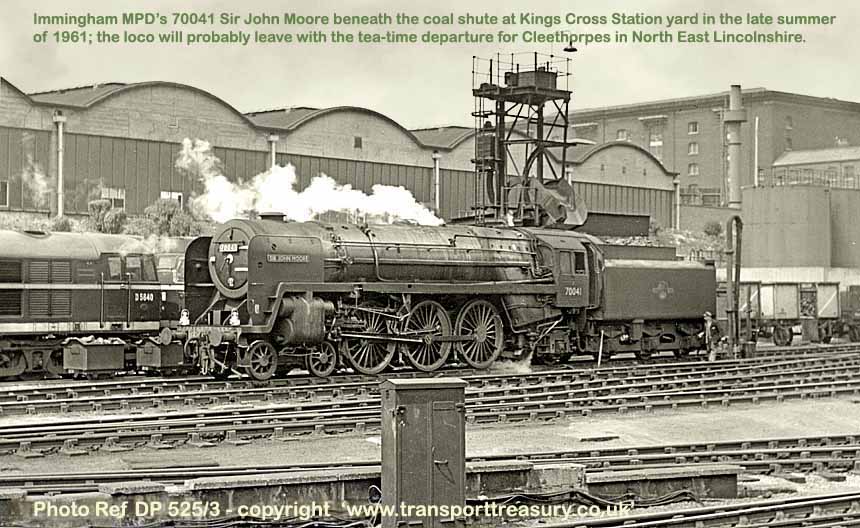
This lovely image from Transport Treasury HERE shows how the Britannias were turned out by Immingham
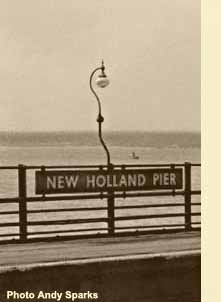 MPD (40B), with 70041 Sir John Moore ready to turn at Kings Cross Station yard in the late summer of 1961, and would probably leave with the tea-time departure for Cleethorpes in North East Lincolnshire. The depot eventually had use of seven of the Pacifics until the end of 1963, with 70041 being one of the first three to arrive, all coming from Norwich Thorpe. (Below) On the South bank of the River Humber, a pier station built in 1848 to provide a service for ferry passengers to and from Kingston upon Hull, lasted right up to the Humber Bridge being opened in 1981. After closure the lines were lifted but the station was converted to a bulk grain import and export business. In 1962, the crew of Britannia 70041 Sir John Moore were awaiting the signal to move off to Cleethorpes and onwards to London, away from this rather remote part of North Lincolnshire. Worthy of note are the ornate LNER lamps used over the full length of the west-side platform. This is another fine image from the huge negative archives belonging to Photographer Rod Blencowe.
MPD (40B), with 70041 Sir John Moore ready to turn at Kings Cross Station yard in the late summer of 1961, and would probably leave with the tea-time departure for Cleethorpes in North East Lincolnshire. The depot eventually had use of seven of the Pacifics until the end of 1963, with 70041 being one of the first three to arrive, all coming from Norwich Thorpe. (Below) On the South bank of the River Humber, a pier station built in 1848 to provide a service for ferry passengers to and from Kingston upon Hull, lasted right up to the Humber Bridge being opened in 1981. After closure the lines were lifted but the station was converted to a bulk grain import and export business. In 1962, the crew of Britannia 70041 Sir John Moore were awaiting the signal to move off to Cleethorpes and onwards to London, away from this rather remote part of North Lincolnshire. Worthy of note are the ornate LNER lamps used over the full length of the west-side platform. This is another fine image from the huge negative archives belonging to Photographer Rod Blencowe.
SIGHTINGS: When new, 70041 Sir John Moore was photographed outside the paintshop at Crewe Works obviously looking resplendent and it was noticeable that the cab sheet was not attached at the back of the cab, but on closer inspection the bracket for the flexible sheet was fitted to the back handrail, meaning that the last coat of varnish had to be completely dry before fitment of the sheet.
However, just over two years later a very different picture was viewed at Stratford, where 70041 had all wheel rods removed to enable the middle axle to be dropped out for repairs; the engine looked in a shocking state, consistent with recovery to Stratford and being left outside in bad weather. Still all was very much as you were when seen at Stratford depot in September 1955, looking in excellent condition and now with a weak-type front step fitted. In the summer of 1956 the engine was spotted charging up Lakenham Bank on the outskirts of Norwich at the head of the Down 'East Anglian', and with the locomotive looking in fine condition hauling an eight coach load of old Eastern Region stock sporting roof mounted destination boards. Sometime later 70041 was seen at rest at Kings Cross Station in March 1961, but ready to dash 155 miles to Grimsby with the afternoon express via the East Coast Main Line to Peterborough, then Spalding and Boston, before reaching Grimsby Town.
70041 was one of seven Britannias allocated to Immingham MPD for employment on the Cleethorpes to London services and was viewed again in August 1962 at Wymondley near Hitchin, hauling a long express towards the Capital and looking in resplendent condition with added highlights on the smokebox, a feature of Immingham depot at this time. During his time at Carlisle Kingmoor, 70041 Sir John Moore was photographed at Shap Wells hauling a 13-coach load towards the summit and although grubby externally, the locomotive was seen to be going very well, therefore mechanically sound.

(Above) In late September 1965 at Carlisle Kingmoor depot, along with seventeen other Britannia Pacifics, we find a rather grubby 70041, formerly Sir John Moore, at rest among the ranks of mainly former express engine types, all eking out time on more mundane duties. From April 1965, 70041 could be seen with a much smaller BR emblem on the tender; most likely this is the tender from 70003 John Bunyan, as the two engines were at Crewe Works at the same time.
DISPOSAL: 70041 Sir John Moore was withdrawn from service on Saturday 15th April 1967, stored at Carlisle Kingmoor yard until 12th September 1967 and then transferred to J. McWilliams of Shettleston, a suburb just over three miles to the east of Glasgow city centre, where it was cut up in October. The company was responsible for the disposal of over 40% of the Britannia class. (still under construction)
Programme authorised 4th January 1951, built at Crewe Works and completed on 9th April 1953, to Order No E483/228, costing £22,337. 70042 was withdrawn on 13th May 1967 from Carlisle Kingmoor.
ALLOCATIONS: 70042 began his service career from Stratford MPD (30A) and worked over five years on the Eastern Region's Great Eastern section. It is widely reported that 70042 was the last engine to be allocated to the Great Eastern and the first to leave. Wrong on both counts! Lord Roberts arrived well before 70030 William Wordsworth and left some time after 70014, 70004 and the Western Region pairing of 70015 and 70016 moved away. 70042 was transferred away from the GE to the Midland Division at Kentish Town MPD (14B) on 14th June 1958, becoming the one and only Britannia to do so, but very soon after it moved to Trafford Park depot (9E) and settled there until late December 1960 when it was allocated to Willesden MPD (1A). After almost two and a half years at 1A, he spent two years at Crewe North (5A) followed by a very short two weeks at Crewe South yard (5B) before spending five months at Holyhead MPD (6J) from early July 1965. 70042 became the only Britannia at Holyhead after 70046 Anzac moved away in September and then he left for Carlisle Kingmoor depot (12A) in early December 1965 to join the throng gathering there.
(Below) Seen in the yard at Willesden on 17 Aprril 1962, Britannia 70042 Lord Roberts looks ready for anything in a classic 'rods down' pose by the redoubtable Peter Groom. In this sumptuous image all the modifications are seen to have been done now including the roller bearing trailing truck as identified by the new looking yellow/red painted end caps, and the nearside lubrication operating rod is seen to be short to increase the rate of delivery of oil to the valves and the cylinder.
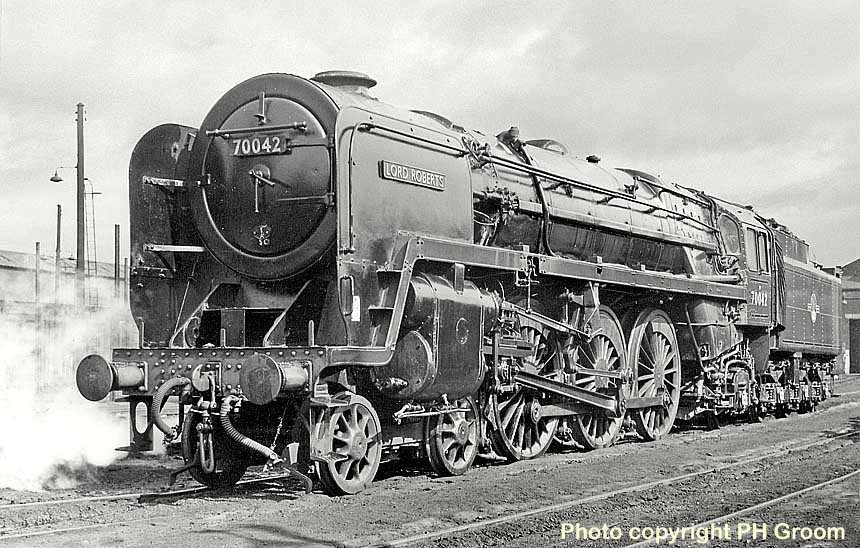
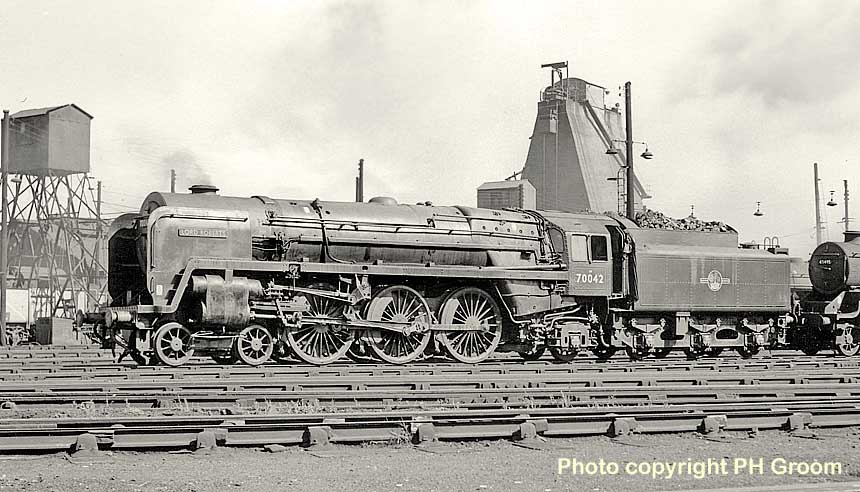
(Above) Another lovely image from Peter Groom that captured the light perfectly on the boiler of Britannia class No 70042 Lord Roberts, at Willesden shed yard on 9 September 1962 The photo not only highlights the length of these engines, the three power warning plates can be picked out on the side, which was the norm. The dangerous handrails remained on the smoke deflectors to the end of service and 70042 was the only long-term Great Eastern engine that was not modified in that respect.
(Below) This 44½" long nameplate was sold at a Great Northern Railwayana Auctions.co.uk. 70042 was named after Lord Roberts of Kandahar, a 50-year career soldier in India, Afghanistan and South Africa. He was awarded a VC, amongst his many other honours. The background of the plate has been painted red over black, and the letters lightly polished.

MODIFICATIONS: 70042 was in the second batch of Britannia engines Nos 70025-70044; construction of this batch started almost 12 months after 70024 'Vulcan' went into service. This was quite simply down to an acute shortage of steel following on from World War 2, but that said, the interim period gave the Works the opportunity to apply the modifications that were found necessary during the service period of the earlier Britannias. These amounted to 5 items: item 9 - the flexible screen was fitted at this time, helping to prevent draughts at the back of the cab; item 17 - the hollow axles were 'plugged' and the wheel bearings seated correctly; item 16 - the sand box lids were raised from new and were now three in number; item 8 - the reverser recuperating spring was contained from new; item 5 - the steady bracket was fitted to the forward rod of the regulator from new. Allied to these changes, we should note that the lamp irons (item 2)
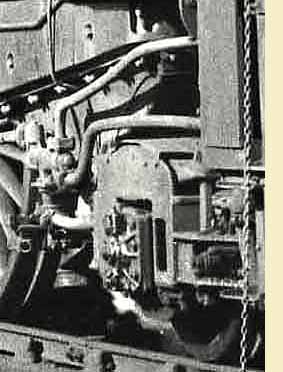 fitted to 70042 Lord Roberts were of GE type; the plain couplings (item 14) were added as part of the Axle repairs; and the tender step (item 10) was added from new also.
fitted to 70042 Lord Roberts were of GE type; the plain couplings (item 14) were added as part of the Axle repairs; and the tender step (item 10) was added from new also.The balance weight on the centre drive wheel is smaller than on previous engines; covering seven wheel-spokes instead of eight as previously seen. Also the modified sand boxes - now three instead of the previous two - allowed for easier routing of the relative pipework. It is worth noting here that Britannias 70040-70049 were built with plain bearings on the drive axles and trailing truck axle (under the cab).
However, 70042 had the trailing truck replaced with a normal roller bearing type, this being identifiable by the end cap used; it was the only one of the ten locomotives to be modified. (Comparisons can be made between the trailing truck of 70047 (left) and 70042 (below).
The first noted modification to 70042 was the fitment of the weak-type front step in addition to the original small plates; this was
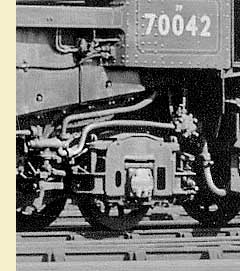 added by Stratford to all their Britannia class engines from 1954 onwards. The full front step (item 1) modification was carried out by Crewe Works in February 1957 in conjunction with the switch from the LNER Return Crank (item 15) with the twin cotter pins, to the LMSR type having a four-stud fixing. The new British Railways emblem (item 11) first appeared in 1956, but it was late 1961 before 70042 was seen carrying this on the tender; it also sported '7P' on the cabside upgraded from the normal '7' notification, one of only five engines to do so. The smoke deflectors (item 3) were not ever altered on 70042 and therefore it became the only Great Eastern allocated engine to avoid having the dangerous handrails removed. 70042 Lord Roberts was one of only two Britannias, 70004 William Shakespeare was the other, not to be fitted with either the Automatic Warning System (item 20) - or the Western Region original ATC type - or a speedometer unit (item 13) all of which seems rather strange when considering the large numbers of passengers that were carried by two express engines that worked solely for British Railways through the early fifties and into the sixties. The power warning plates (item 19) and the rear regulator rod support bracket (item 7) were both added in December 1961 which was pretty much the last of the visible modifications to 70042.
added by Stratford to all their Britannia class engines from 1954 onwards. The full front step (item 1) modification was carried out by Crewe Works in February 1957 in conjunction with the switch from the LNER Return Crank (item 15) with the twin cotter pins, to the LMSR type having a four-stud fixing. The new British Railways emblem (item 11) first appeared in 1956, but it was late 1961 before 70042 was seen carrying this on the tender; it also sported '7P' on the cabside upgraded from the normal '7' notification, one of only five engines to do so. The smoke deflectors (item 3) were not ever altered on 70042 and therefore it became the only Great Eastern allocated engine to avoid having the dangerous handrails removed. 70042 Lord Roberts was one of only two Britannias, 70004 William Shakespeare was the other, not to be fitted with either the Automatic Warning System (item 20) - or the Western Region original ATC type - or a speedometer unit (item 13) all of which seems rather strange when considering the large numbers of passengers that were carried by two express engines that worked solely for British Railways through the early fifties and into the sixties. The power warning plates (item 19) and the rear regulator rod support bracket (item 7) were both added in December 1961 which was pretty much the last of the visible modifications to 70042.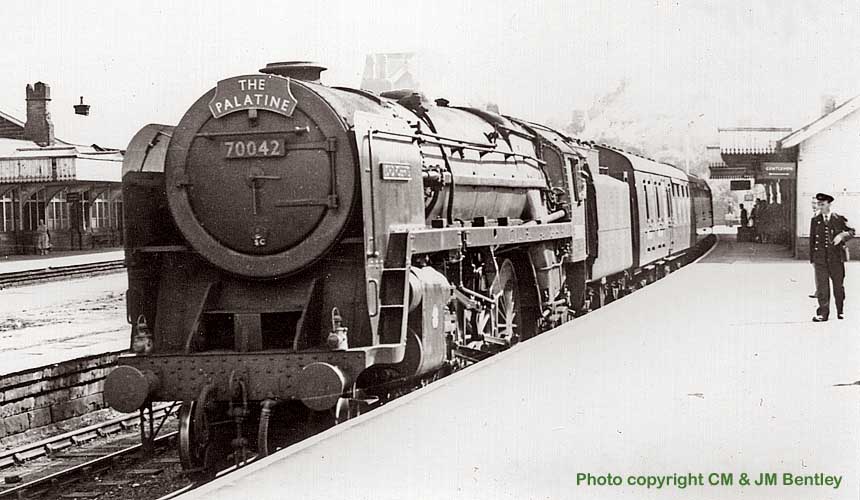
(Above) The Palatine was the name given to an express passenger train, introduced by the London Midland and Scottish Railway in 1938: the 10.00 from Manchester Victoria to London St. Pancras is seen here at Millers Dale in 1960. This train took almost four hours for the journey with stops at Chinley, Millers Dale, Matlock, Derby and Leicester. Britannia 70042 is waiting to continue south and was a regular performer on this train which lost its name in 1964 and was discontinued in 1966.
SERVICE RECORD: 70042 Lord Roberts started proceedings with no less than five visits to Crewe Works for Non-classified work all within the first two months of service, taking 18 days, 17 days, 13 days, then 2 days twice suggesting some major issue with this particular engine, but I've found no information on the matter. The engine was then able to start earning some revenue on the Great Eastern lines, with many runs to Norwich with 'The Broadsman' and 'The East Anglian' from Liverpool Street station in London. In 1954 a recorded mileage of 85,250 showed that there were few problems with 70042 after its difficult start and also amassed 83,500 miles in 1957, even though the engine was in Doncaster Works for the first five weeks of that year, the only time that 'Lord Roberts' visited there. 70042 was recorded as visiting Stratford Works just the once, and all other Works visits being to Crewe; which was the reason why the smoke deflectors were not altered in any way, as Crewe Works plainly did not see any problem with the original design. After moving to the Midland Division, 70042 could often be seen hauling 'The Palatine' express service from Manchester Central to London St. Pancras, and such trains as 'The Comet' or 'The Mancunian' after moving to the London Midland Region at Trafford Park shed in Manchester.
SIGHTINGS; 70042 Lord Roberts was viewed sweeping up Brentwood Bank with a down express and seen in presentable condition although only three months into service from Stratford depot. The following year he was captured in sparkling condition having been treated to a thorough cleaning by the 'gang' at Stratford shed yard including burnished buffers and clearly displaying a weak front step and much extended lamp irons at the front, right and left. But when seen at Norwich Thorpe station in September 1955 on an up express for London, 70042 was looking distinctly grubby; also different lamp irons could be seen and unusually the white train indicator discs were not properly aligned. Although this was not the case when pictured ready to leave Liverpool Street station during May 1957 because the engine was clean and the white discs were correctly displayed; also 'BR7' could clearly be seen on the buffer beam, a short-lived exercise that would seem to go under the banner of... 'seemed a good idea at the time'.
On another occasion, in 1958, 'Lord Roberts' was seen hauling 'The Hook Continental' from London Liverpool Street station to Harwich to connect with a boat train for Holland. Sometime later 70042 was viewed on the down 'Mid-Day Scot' at Shap Wells in a condition best described as 'work worn' which would be about average for the period - July 1964.
DISPOSAL: was by J. McWilliams of Shettleston in October 1967, after four months of storage at Carlisle Kingmoor yard.
Construction programme was authorised on 4th January 1951, but due to a severe lack of steel available following World War 2, 70043 was not completed until 4th June 1953, under Order No E483/228, at a total cost of £22,395. Withdrawal came relatively early, on Saturday 7th August 1965.
ALLOCATIONS: It has been stated that 70043 and 70044 were predestined for the Great Eastern section, but 70043 was allocated new to Longsight MPD (9A) and Nos 70030 and 70034 were sent to the Eastern Region instead. Although 70043 remained at Manchester until the end of September 1961, it was seen to go to Derby for fitment of air brake equipment and then to Toton for actual road testing at different times. 70043 was relocated to Birmingham's Aston depot (21D) for a nine-month period, before returning to Longsight for three months, then in June 1962 it returned to Aston once again, remaining there until late April 1963 at which point the engine was allocated to Willesden MPD (1A). It spent fourteen months at this major LNWR depot followed by twelve months at Crewe North shed (5A). When 5A closed in June 1965, 70043 found favour at Crewe South MPD (5B), but that proved to be last move for the locomotive, as it was withdrawn in early August 1965, thus its length of service was a mere twelve years and two months.

(Above-Below) G Newall caught this scene of Britannia 70043, as yet unnamed, but officially known as Lord Kitchener, backing out of Manchester London Road Station in 1955; the loco is assisting the station pilot with the removal of coaching stock to Longsight carriage sidings for servicing. In 1955 Longsight shed (9A) had an allocation of 5 Britannias, 9 Patriots, 12 Jubilees and 16 Royal Scots for their express services, but all was soon to change when the station was rebuilt from September 1960 and Type 4 diesels began to appear on the LMR. (Below) Rail Cameraman ER Morten captures an ungainly-looking Britannia Pacific 70043, as yet unnamed, but soon to carry the name of Lord Kitchener, leaving Macclesfield Central Station and heading for Manchester with an express from London in April 1957. The line from Cheadle Hulme to Colwich, was basically a Crewe by-pass that boasted twenty four stations, five tunnels and two viaducts on the 48 mile route.
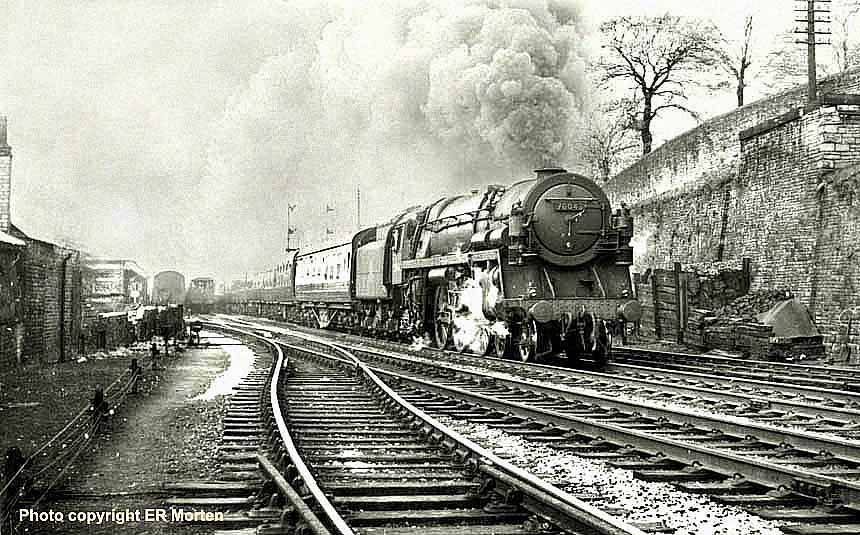
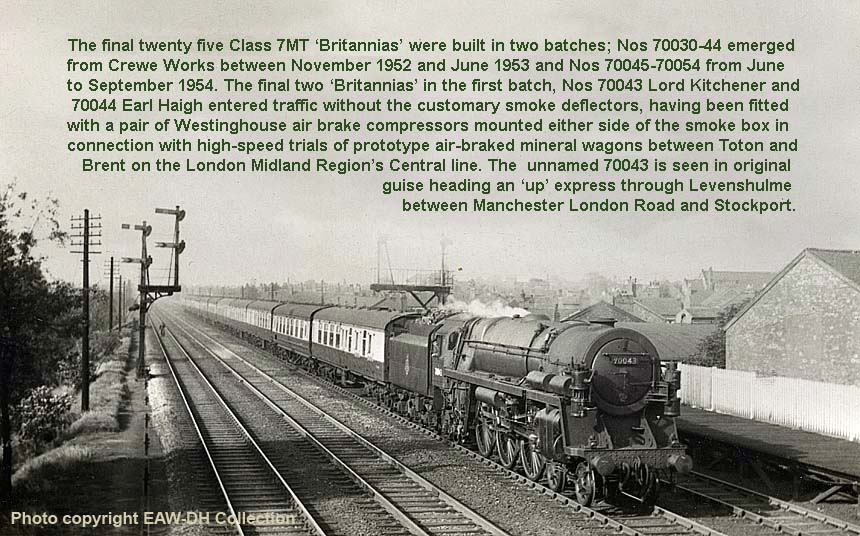
MODIFICATIONS: Together with 70044 Earl Haig, 70043 Lord Kitchener was fitted with Air Brake equipment in order to compare with the normal Britannia engines' vacuum brakes, but this continued for a long time and with no conclusive outcome. 70043 was the penultimate locomotive to receive a BR1 tender and was able to benefit from the various updates and modifications that were discovered during the service of the first group of Britannias, mainly concerning the drive axle centres (item 17), bearings and coupling rods (item 14). The locomotive was not fitted with a cab sheet (item 9) when built, but this was seemingly added by Crewe Works later in the same month. 70043 began in service with three raised sand box lids (item 16), a tender step (item 10) added to each side of the tender, also the coupling rods (item 14) were plain from the outset and remained so all the way through its service history. Little changed over the ensuing four years, not until the air brake testing was completed and the Air Brake equipment was removed during April 1957, when finally a more conventional looking Britannia appeared from Crewe Works with the newly fitted smoke deflectors (item 3) in situ and, although without any ceremony, the nameplates were fitted at this time with apparently no sign of the previous fitments of the air brakes. It is also worth noting that the lower grab handle, which would normally be fitted to the lower portion of the smoke deflector, for the crew to pull themselves onto the front buffer bar, had to be fitted on the bar itself while the Air Brake fittings were in place, but resorted to normal position after addition of the deflectors. At the same visit to Crewe, a speedometer unit (item 13) was fitted; the original front step (item 1) was modified to a full platform, helping the crew to reach into the smoke box for cleaning purposes. The LNER designed return crank (item 15) was modified to the LMR type, recognised by its four pin fixing, at a further visit to Crewe Works during January 1958, but the old BR emblem (item 11) remained on the tender until updated at another visit to Crewe Workshops in October, also in 1958 which was fully two years and four months after the emblem first appeared. Following a six weeks long visit to Crewe Works, 70043 reappeared in July 1959, with the AWS equipment (item 20) fitted into the engine frame, and as a fully modified Britannia it was now a very far cry from the aesthetic disaster that was seen from new. Also at that time the rearmost bracket was added to the regulator rod (item 7), while a short time later the power warning plates (item 19) were affixed to the engine, although not in the usual position as the most forward of them were added higher up on the deflectors. Because the locomotive was withdrawn at least a couple of years earlier than the average for the BR Standards, the lamp irons (item 2) were not repositioned, but it was noted that from 1959 the top iron was a long version whereas the other three were short. Also of note was that the locomotive livery (item 12) kept its lining and that the nameplates were not removed whilst in service.
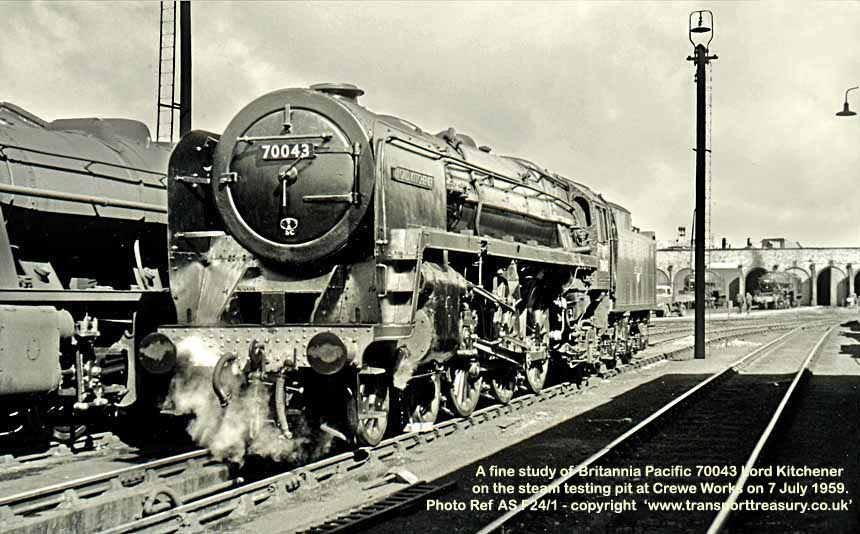
(Above) From the wonderful archives of Transport Treasury HERE we find this image of Britannia Pacific 70043 Lord Kitchener on the steam testing pit at Crewe Works on 7th July 1959, in company with a 2-8-0 8F and in the background, a Jubilee and a Black 5. The unconventional appearance of the original engine is now a forgotten memory as the smoke deflectors and nameplates were added just over two years prior. Allocated to Longsight depot the chances of remaining in pristine condition for much long were quite slim; of note were the long top iron coupled with three short ones on the buffer plate and the nearside lubrication operating rod was now of short length.
SERVICE RECORD: Initially 70043 went to Derby Mechanical and Engineering Department for the fitment of Air Brake Equipment, which included two main air pressure tanks; two reserve tanks; two air compressors (steam driven) and cab controls. These were fitted under the support of the 'Ideal Stocks Committee' which was set up by British Railways to modernise wagon stocks. The strange manoeuvres of 70043 between Manchester and Derby, then down to Cricklewood hauling long coal trains from the Nottinghamshire coalfields prevented the locomotive building up a good service mileage, but reasonable figures were recorded just the same. The figures for the four years with Air Brake equipment fitted were at an average of 53,000 miles, whereas the following four years, as a conventional engine, a returned average of 55,000 miles was noted, which was lowered slightly by a poor return for 1958. Crewe Works visits amounted to twelve, with another five noted as Derby Works, although these were mainly for 'brake fittings', although one other occasion was for repairs to actual damage to the locomotive, recorded as August 1955, but no other details are known. The engine was a regular on London turns, but was rarely seen with a headboard in place, certainly not in the period with the air tanks fitted, which was also the reason that the engine was never cleaned; the lack of smoke deflectors caused much soot to cover the front end and access to same was extremely difficult. After the smoke deflectors were fitted, 70043 could be spotted with the 'Mancunian' headboard in prime position, but following relocation to Aston and then Crewe sheds there were really no opportunities to carry any other train title. Condition of the locomotive was good following its last visit to Crewe Works in June 1962, but by 1964 the engine was seen to be in a deplorable external state and desperately needing a further overhaul, but for some reason that was not forthcoming.
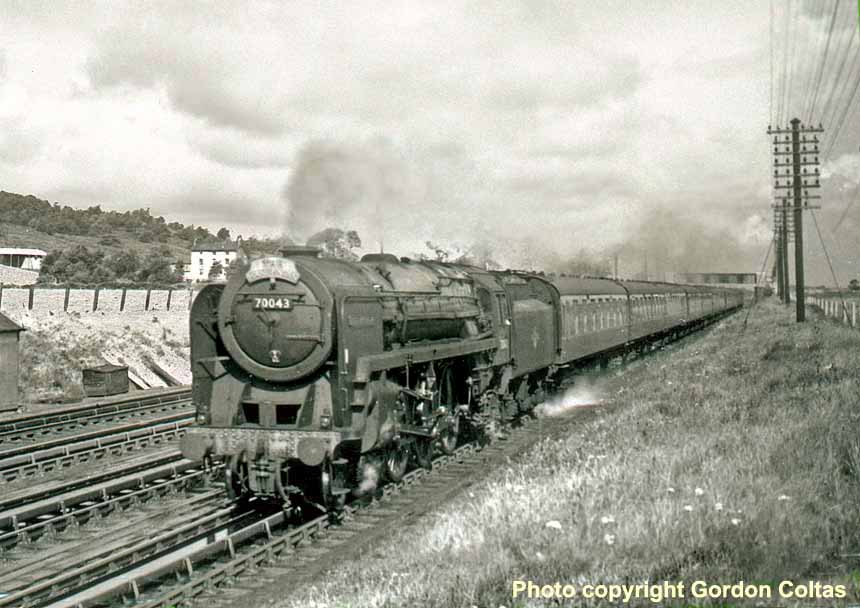
(Above-Below) With little over two years to go before the installation of electrification masts on the WCML south of Crewe, this evocative image was captured by Gordon Coltas of BR 7MT Pacific 70043 Lord Kitchener heading the 'Mancunian' towards London in August 1960. The fireman is dipping the scoop to take on water at Whitmore troughs situated at the summit of the climb between Crewe and Stafford. The man behind the idea (ie engine crews picking up water at speed, rather than stopping at water columns along the route) was Todmorden-born John Ramsbottom (1814-1897) as far back as 1860; water troughs were in use for over a century. The LNWR main line out of London Euston had the most generous provision of troughs spaced at intervals of approximately 35 miles; having replenished an engine's tender, the time taken to refill a 563 yard-long water trough is said to take 4-8 minutes. (Below) 7MT Britannia 70043 Lord Kitchener leans into the curve as it enters Wellingborough Midland Station on the Up main line with an express from Manchester to London St Pancras in May 1961, shortly before transfer to Aston (21D). This fine image from Les Hanson captures the train threading the Mill Road Bridge and passing the 48-lever signal box, which controls all movements in and out of the station including the five track sidings, just to the left of the picture.
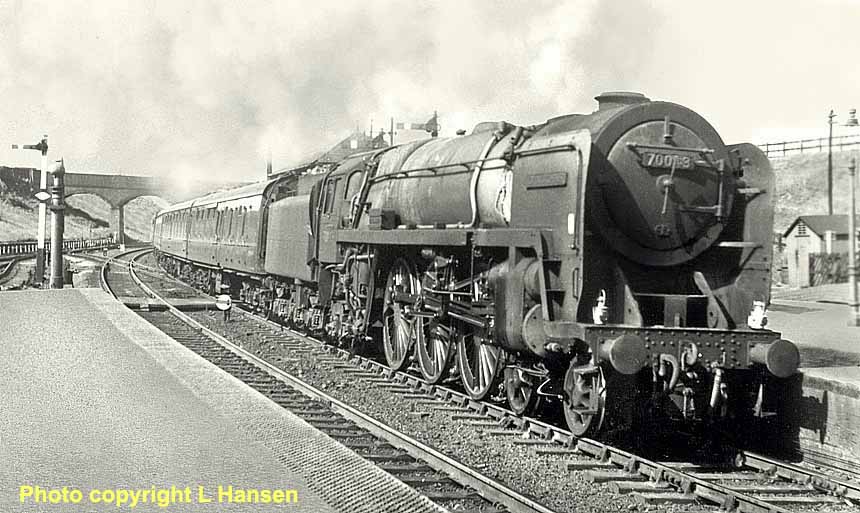
SIGHTINGS: First sightings of 70043 would have been a shock to the system, many questions would have been asked of this new engine, an aesthetic monstrosity of epic proportions replacing the normal clean cut lines of a Britannia. This was the image that was photographed in the yard at Crewe Works; the engine would have been to Derby and returned to Crewe for the painting of the additional tanks, before being released into service. During September 1954, 70043 was part of the Derby Works Open Day event, for which the engine had been well turned out, but that was just after Derby Works had carried out repairs to accidental damage to the locomotive. Any other images from the next three years reflect a very similar picture, until the Air Brake tanks and associated equipment were removed; one of a very dirty engine and an unnerving sight, not resembling the normal view expected of a Britannia Class 7. But as seen in April 1958, hauling the early afternoon service from London Euston to Manchester, the locomotive was a normal looking Britannia coping well with a 14-coach load on the Trent Valley Line. 70043 was still a Longsight (9A) resident when captured in the Works yard at Crewe, awaiting final checks and attention to detail, pictured without its tender, which was the normal practice for engines under repair in the Works. The Britannia must have looked a picture during the ensuing months, but in August 1961 a very grubby engine was spotted at Stoke Junction on its way from Manchester London Road to London Euston with an afternoon service. 70043 was reallocated soon afterwards, but Aston shed must have despaired when they received it and promptly saw it off to Works, so a very presentable engine was viewed at Kirkham and Wesham Station heading for Blackpool with an Illumination Special from Birmingham on Saturday 8th September 1962. The engine's usefulness was certainly in decline in this period, but was still capable of hauling Birmingham to Manchester trains while at Aston shed, or London to Wolverhampton expresses when allocated to Willesden depot, as seen at Birmingham New Street in July 1963, awaiting departure north, with a full head of steam in the boiler. After the engine was outshopped from Crewe, it remained in reasonable condition for some time and that's how it was when working an engineers train in the Canley area of Coventry, with the loco working backwards, utilising the inset tender sides for better vision. Also when at Willesden 70043 was loaned by the Central Division to haul the afternoon semi-fast train from Nottingham Victoria to Marylebone Station in London and was to be seen changing crews at Leicester Central Station before continuing southwards.
DISPOSAL: Withdrawal came early, on 7th August 1965 from Crewe South MPD, was stored there until 27th October 1965, then moved to T.W.Wards of Beighton, in Sheffield for cutting up in November 1965.
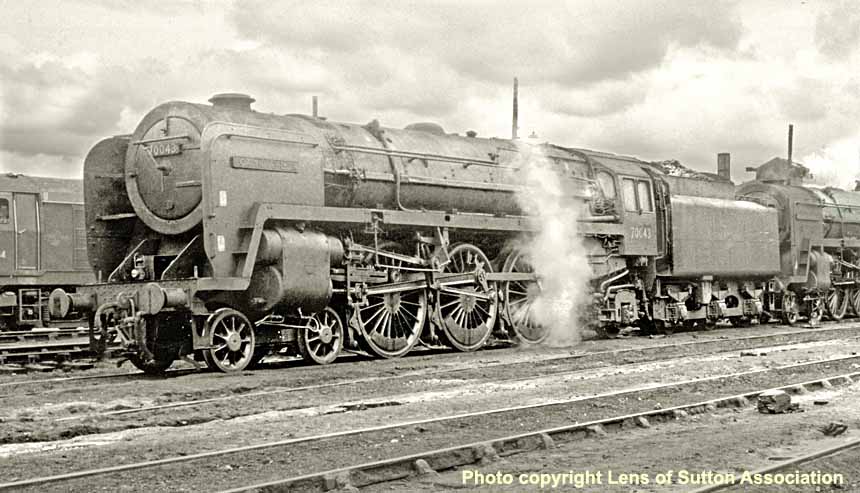
(Above) 7MT Britannias 70043 Lord Kitchener and 70004 William Shakespeare share the yard at Willesden MPD (1A) with EE Co Class 20 No D8044 (built 11/59). The two Pacifics would have passed this way many, many times in their rather short careers with 70043 seemingly in need of a fair bit of attention at this time, but little prospect of receiving any at this late stage, whereas 70004 lasted another 28 months longer and was observed in much improved condition for a number of Rail Tours.
Built at Crewe Works under Order No E483/228 and completed on 4th June 1953 at a cost of £22,395. 70044 was the last engine of the second batch to be constructed; the programme was authorised on 4th January 1951. Withdrawal came relatively early, on 24th October 1966.
SIGHTINGS: First sightings of 70043 would have been a shock to the system, many questions would have been asked of this new engine, an aesthetic monstrosity of epic proportions replacing the normal clean cut lines of a Britannia. This was the image that was photographed in the yard at Crewe Works; the engine would have been to Derby and returned to Crewe for the painting of the additional tanks, before being released into service. During September 1954, 70043 was part of the Derby Works Open Day event, for which the engine had been well turned out, but that was just after Derby Works had carried out repairs to accidental damage to the locomotive. Any other images from the next three years reflect a very similar picture, until the Air Brake tanks and associated equipment were removed; one of a very dirty engine and an unnerving sight, not resembling the normal view expected of a Britannia Class 7. But as seen in April 1958, hauling the early afternoon service from London Euston to Manchester, the locomotive was a normal looking Britannia coping well with a 14-coach load on the Trent Valley Line. 70043 was still a Longsight (9A) resident when captured in the Works yard at Crewe, awaiting final checks and attention to detail, pictured without its tender, which was the normal practice for engines under repair in the Works. The Britannia must have looked a picture during the ensuing months, but in August 1961 a very grubby engine was spotted at Stoke Junction on its way from Manchester London Road to London Euston with an afternoon service. 70043 was reallocated soon afterwards, but Aston shed must have despaired when they received it and promptly saw it off to Works, so a very presentable engine was viewed at Kirkham and Wesham Station heading for Blackpool with an Illumination Special from Birmingham on Saturday 8th September 1962. The engine's usefulness was certainly in decline in this period, but was still capable of hauling Birmingham to Manchester trains while at Aston shed, or London to Wolverhampton expresses when allocated to Willesden depot, as seen at Birmingham New Street in July 1963, awaiting departure north, with a full head of steam in the boiler. After the engine was outshopped from Crewe, it remained in reasonable condition for some time and that's how it was when working an engineers train in the Canley area of Coventry, with the loco working backwards, utilising the inset tender sides for better vision. Also when at Willesden 70043 was loaned by the Central Division to haul the afternoon semi-fast train from Nottingham Victoria to Marylebone Station in London and was to be seen changing crews at Leicester Central Station before continuing southwards.
ALLOCATIONS: It has been stated that 70043 and 70044 were predestined for the GE section of the Eastern Region, but 70030 and 70034 were sent there as replacements instead. Although 70044 remained at Manchester until the end of November 1958, it was seen to go to Derby for fitment of Air Brake equipment and to Toton for actual road testing at different times. The next allocation was Leeds Holbeck shed (55A) where 70044 joined the shed's two other 'Britannias' Nos 70053 and 70054 on the Glasgow to St Pancras trains north of Leeds. In June 1962 70044 moved to Crewe North MPD (5A) and then very briefly to Crewe South depot (5B) in June 1965, only to be relocated to Newton Heath depot (26A) in July of the same year. But after only ten months 70044 Earl Haig was off again to a final destination of Stockport Edgeley MPD (9B) and was one of only two Britannias withdrawn from there.
(Below) An interest-filled image by BKB Green, capturing the departure of 'The Mancunian' from Manchester London Road Station headed by Britannia class 4-6-2 Pacific 70044 Earl Haig, seen in March 1957 with the normal smoke deflectors after almost four years fitted with Air Brake equipment. Much activity in the station is apparent and the array of lineside equipment is only adding to a very busy scene, but it was all changed in 1960 when the station was rebuilt and renamed Manchester Piccadilly.
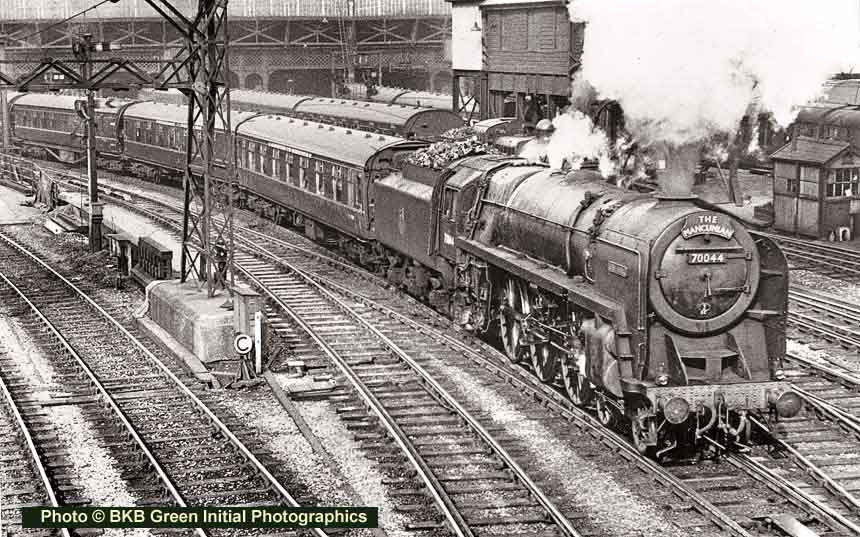
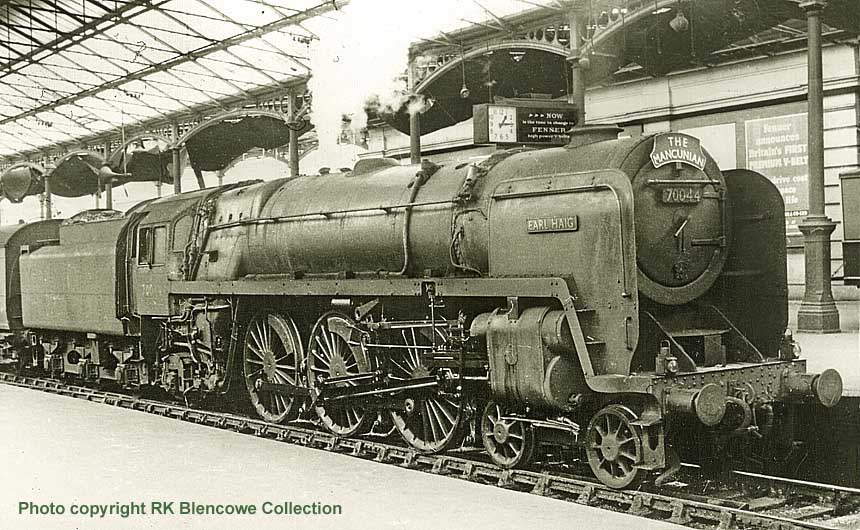
(Above) From the Photo Archive of Rod Blencowe a scene much repeated through the years as Britannia 4-6-2 Earl Haig stands at the buffer stops at Euston Station in May 1958 waiting for the passengers to disembark and for the signal to reverse out to Camden loco to refuel. 70044 is seen in poor external condition, much like the magnificent station roof which was facing demolition in the near future.
MODIFICATIONS: 70044 was, along with 70043 Lord Kitchener, fitted with Air Brake equipment as test cases and to compare with the normal Britannia engine with its vacuum brakes, but this continued for a long time and with no conclusive outcome. 70044 was the final locomotive to receive a BR1 tender and was able to benefit from the various updates and modifications discovered during the service of the first group of Britannias; this mainly concerned the drive axle centres (item 17), bearings and coupling rods (item 14). The locomotive was not fitted with a cab sheet (item 9) when built, but this was seemingly added by Derby Works in October 1954, and in the following year the speedometer unit (item 13) was fitted by Crewe Works becoming the first engine to receive the equipment in service. During the following year the front step (item 1) was modified at Crewe, but the Air Brake gubbins was still left in place until March 1957, when finally a proper looking Britannia appeared from Crewe Works with newly-fitted smoke deflectors (item 3), albeit without nameplates, these being fitted two weeks later...at this time apparently there was no signs of the previous fitments of the air brakes. The LNER return crank (item 15) was changed at Crewe in July 1958, but the smoke deflectors (item 3) were left alone until Doncaster Works modified them to type LMR 1, seen in July 1960, in conjunction with the AWS equipment (item 20); the new BR emblem (item 11); and the power warning plates (item 19). This pretty much completed the changes to 70044 except for the lamp irons (item 2) which differed from the norm: although 70044 began on the London Midland, the irons were the much longer Great Eastern type and these survived through to 1965.
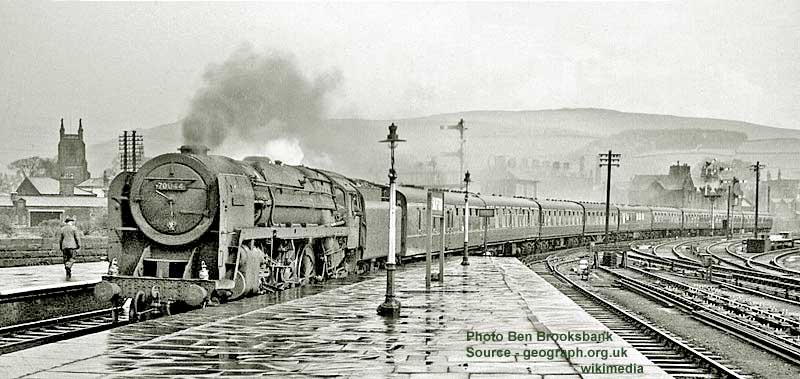
(Above) From the trusty camera of Ben Brooksbank, this image shows Britannia 70044 Earl Haig drawing into Skipton Station with the Thames-Clyde Express in April 1961, having taken over the train at Leeds Station some twenty miles away. The engine was nearly four years at Leeds Holbeck and would have made this journey to Scotland many times over the remote but picturesque Settle and Carlisle Railway route.
SERVICE RECORD: Because of the decision to fit Air Brakes, 70044 had an unusual start to its career; I have to assume that no smoke deflectors were fitted from new, or at least not seen outside of Crewe Works, so that a slightly strange looking Britannia was passed over to Derby Mechanical and Engineering Department for the fitment of Air Brake Equipment, which included two main air pressure tanks; two reserve tanks; two air compressors (steam driven) and cab controls. These were fitted under the support of the 'Ideal Stocks Committee' which was set up by British Railways to modernise wagon stocks. The fact that 70044 had no smoke deflectors, probably meant that smoke may well have hampered the driver's visibility, but no adverse comments have been found and the only noticeable effect was the blackened front of the engine, compared to a normal Britannia. Apparently the engine worked some trains from Derby to St Pancras Station and back to Nottingham while undergoing tests from Derby, but most usually the locomotive could be seen hauling 'The Mancunian' or 'The Comet' up to London Euston, from Manchester London Road Station. Intermingled with these runs, would be test-trains of loaded coal wagons with modified brakes to and from Toton and Brent, double-headed with 70043, which was likewise air brake fitted. When all the air brake fittings were removed and the smoke deflectors added, the Britannia was said to be indistinguishable from any other and that no trace of the previous equipment could be viewed; this suggests strongly to me that the smokebox was changed, otherwise some trace of ten rivet holes on the front edge would be discernable. Having moved to Leeds Holbeck, which was part of the NER, 70044 was regularly to be seen working 'The Thames-Clyde Express' covering the section over the Settle and Carlisle Railway and on to Glasgow St Enoch, plus 'The Waverley' into Edinburgh. Recorded mileages for 70044 were relatively low due to Air Brakes being fitted and the subsequent tests thereafter, with only 32,000 miles showing for 1954, a much improved 68,000 miles logged for 1955, then 54,000 in 1956, but a better reading of 71,000 for both 1957 and 1959. The engine was seen to enter Derby Works on one occasion, visited Crewe Works seven times and also was shopped at Doncaster Works on four occasions. It was reported that 70044 suffered from a 'hot-box' in 1959, this is a reference to the bearings of the drive axle; and again was under repair with a similar problem in August 1965; this would be very unusual, as one occurrence is rare, twice is extreme.
(Below) Intrepid photographer Paul Claxton probably visited Preston Station most days in the early 1960's and captured many such images as this shot of Britannia 70044 on a Euston to Carlisle working, in August 1963. The low angle highlights the 5'9" diameter of the Britannia smokebox and the huge size of the station train-shed and buildings. The train is standing on the Down Main at Platform 5.
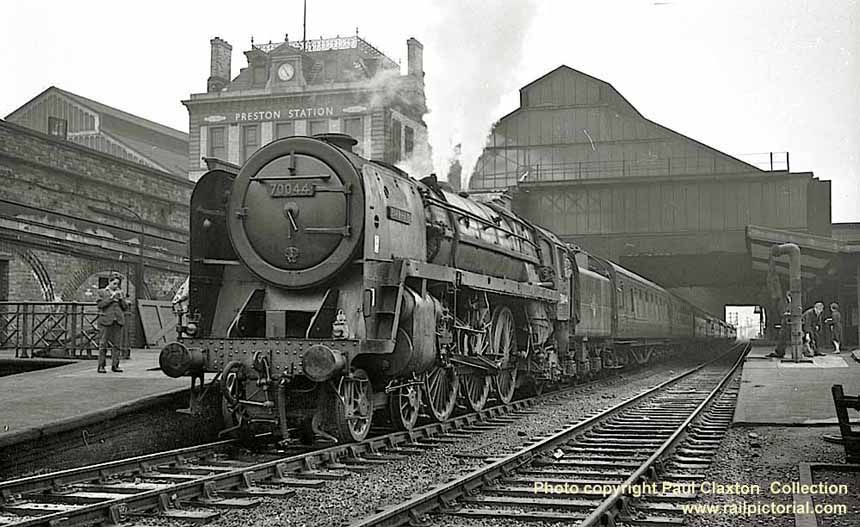
SIGHTINGS: First views of 70044 all show the locomotive without smoke deflectors, but with the unsightly Air Brake equipment seemingly hanging on to every spare bit of space around the front of the engine. Not only was the loco unattractive, but work space was limited at the front of the engine when it
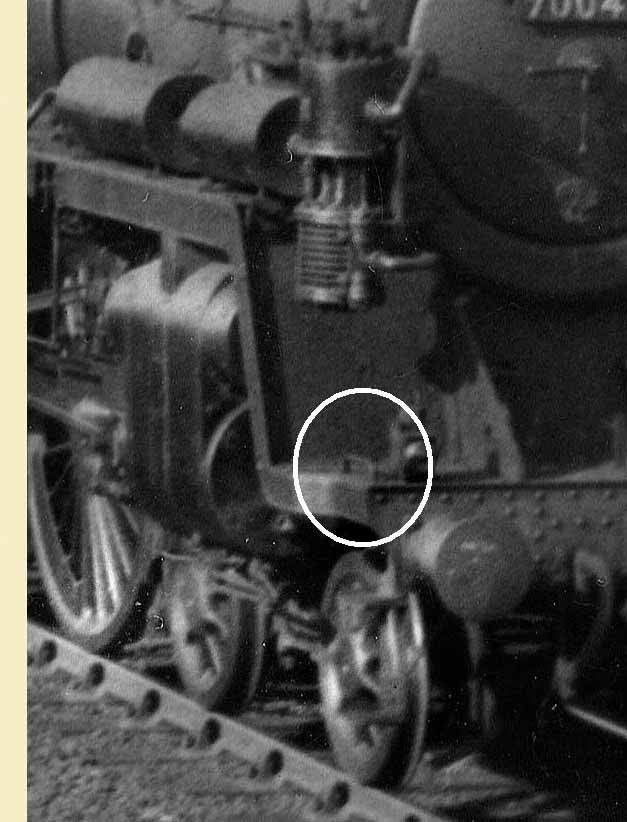 came to cleaning out the ash from the smokebox and the two grab handles (small and large, as fitted to the smoke deflectors) were not available. To compensate for this a small grab handle was fitted either side actually on the buffer beam platform. (See inset right).
came to cleaning out the ash from the smokebox and the two grab handles (small and large, as fitted to the smoke deflectors) were not available. To compensate for this a small grab handle was fitted either side actually on the buffer beam platform. (See inset right).Also the wide open surfaces of the smokebox valances, left and right, were a strange sight to Britannia admirers, who were used to seeing the smoke deflector accompanied by two small steps on the outside, attached to the valance.
Once the smoke deflectors were fitted many photographs were taken, the majority showing the engine hauling titled-trains. 70044 was seen at Euston in February 1959 in excellent condition having hauled 'The Mancunian' from Manchester. Also in 1959 the engine was pictured at Dumfries Station, with a Glasgow St Enoch to Leeds train, looking in good condition and what was noticeable on the cabside was the driver's name clearly displayed in the bracket designed for the purpose.
During March 1961, 70044 was viewed at Leeds City station ready to leave with 'The Waverley' over the Settle and Carlisle route and onto Edinburgh, a journey made many times by the engine whilst shedded at Leeds Holbeck (55A) from late 1958 into August 1962.
Later, by April 1962, the engine was starting to be used south from Leeds and was espied at Kentish Town MPD (14B) in full steam and ready to travel back up north along the Midland Main Line, but the external condition was now looking decidedly shabby and in need of attention. Having moved over to Crewe North shed, 70044 could be viewed on many varied duties; seen at Oxford on a parcels duty in 1963; hauling a Carlisle to Euston passenger train at Wigan during June 1963, in fair condition, or for the period - very good.
The engine was in good condition on this occasion, but was seen in terrible external condition at Carlisle Upperby shed in July 1965; the livery was not visible, the offside cylinder damaged and nameplates recently removed. Shortly afterwards the engine was viewed with the middle axle missing, after suffering a hot-box and awaiting a return to service at Carlisle Upperby in the open Yard.
(Below) Birmingham New Street: From the vast Photo Archives of the Transport Treasury HERE comes this image of 70044 Earl Haig at Birmingham New Street Station, in May 1964, seen in the bay platform 1A on an empty coaching stock working and viewed in typically run down condition with no identifying number plate on the smokebox; a sharp contrast to the pristine DMU alongside. Of note is the Holiday Poster offering a 'South Seas Adventure' in the Caribbean, certainly a far cry from this dark scene.
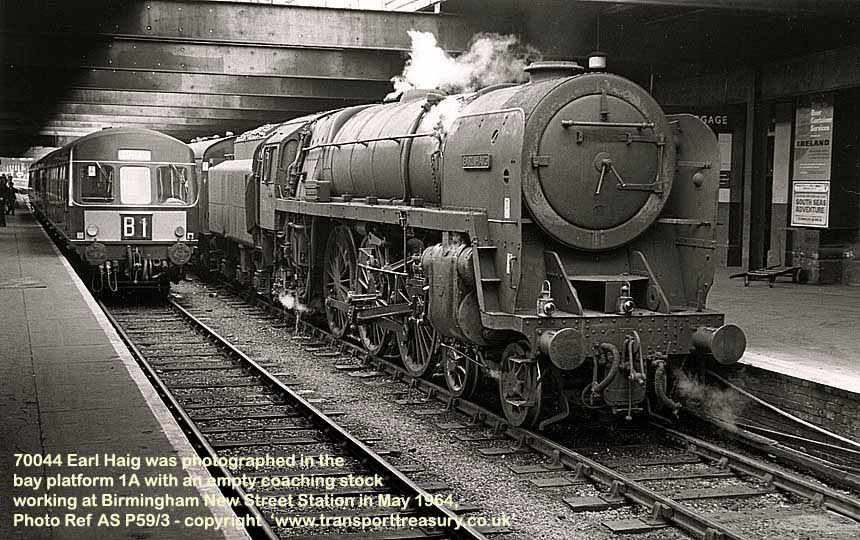
DISPOSAL: 70044 was withdrawn from Stockport Edgeley in October 1966, stored there until December 1966, and then moved to T.W.Wards of Beighton for cutting up in February 1967.
Programme authorised 29th November 1951, built at Crewe Works and completed on 16h June 1954, to Order No E479/220 costing £20,025. Withdrawal was on Saturday 30th December 1967 from Carlisle Kingmoor.
ALLOCATIONS: 70045 (Lord Rowallan) was the first BR1D-tendered Britannia allocated to Holyhead MPD (6J) and remained on the strength there until November 1959, when it was allocated to Chester (Midland) (6A), albeit for a short two weeks. No 70045 then became one of the first class members to be received by Crewe North (5A), but just three weeks later the loco was relocated to Camden depot (1B). But yet again this move was short-lived as the engine followed the path of its two classmates Nos 70048-49 with a move to Newton Heath depot (26A). After ten months No 70045 was transferred to Neasden shed (14D) in September 1961, then found favour at Aston MPD (21D) in Birmingham. Following these shenanigans the engine settled back at Holyhead depot (6J) for what proved to be a long stint between December 1962 and June 1965. It was then transferred to Wolverhampton Oxley shed which had recently been switched from Great Western Region ownership (84B) to the London Midland Region (2B). This lasted until the end of the summer season when the engine was relocated to Banbury depot (2D) from October 1965 until the new year dawned and 70045 joined its many classmates at Carlisle Kingmoor (12A) until retirement.
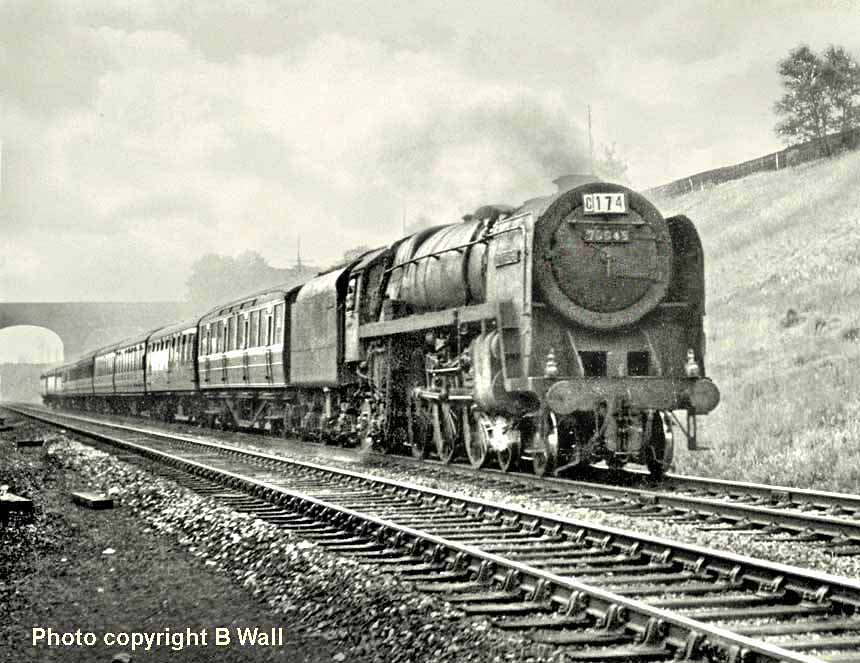
(Above-Below) Seen on the rather lonely and desolate Coppull Moor near Preston, BR Standard Britannia No 70045 'Lord Rowallan' is captured by Brian Wall on the 18th June 1960, as the train forges its way from Manchester Victoria to Blackpool, where it is hoped the weather will be better than it appears in this image. The external condition of the engine reflects the almost complete lack of staff for any cleaning duties at this time, while the first coach appears to be a Gresley non-corridor type of some vintage, first built in the 1920s. (Below) A summer Saturday spent at a very busy station such as Chester General would have been a rewarding one for young spotters. Here, Footplate Cameraman, Jim Carter, a Patricroft fireman who passed as a driver in 1962, regularly chose a high vantage point to photograph the everyday scene, in this case the signal box which provides a good view of the 3 raised lids to the sand boxes on the boiler walkway of a begrimed 70045 'Lord Rowallan' which is easing into the station with a train from North Wales, possibly a Bangor to Crewe working.
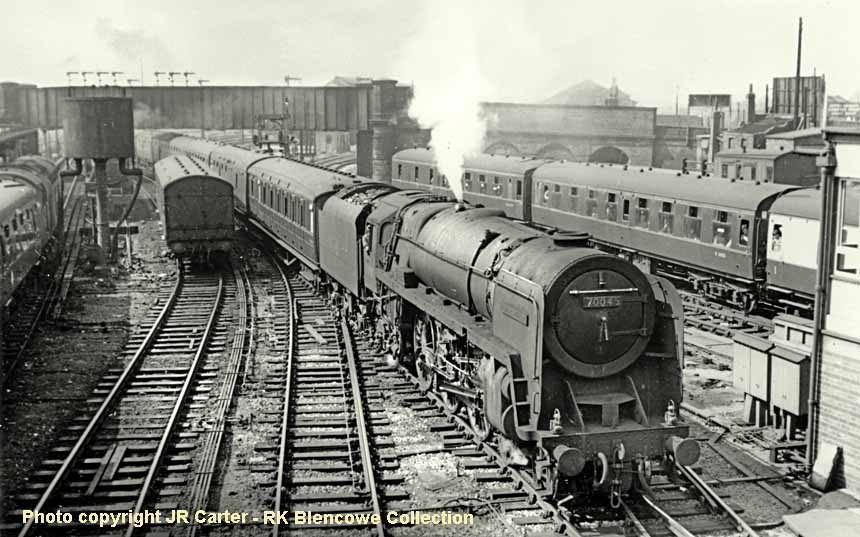
MODIFICATIONS: 70045 (Lord Rowallan) was the first engine of the third (and final) batch of Britannia Class 7MT locomotives, hence it was the first to be coupled with a larger capacity BR1D tender, capable of holding 9 tons of coal, with 4,725 gallons of water and not requiring a tender step (item 10) or a flexible cab sheet (item 9) at any time. The prior modifications had been integrated into the construction programme in 1952 and as the smoke deflectors (item 3) were not ever altered, there were just 8 items that saw any change. The first notable modification was the full version of the front step (item 1) to aid the crew to reach up to fit the heavy train headboards on the top lamp iron on the smokebox door. This was completed by Crewe Works after a Light Intermediate repair was effected, followed by the addition of the new Company crest (item 11) to the sides of the tender, also the nameplates were added and unveiled at a ceremony in June 1957. During this same visit to Crewe, the nearside lubrication operating rod (item 18) was shortened to give a better supply of atomised oil to the valves and cylinder. Belatedly the AWS equipment (item 20) was added by Crewe Workshops during October 1959, with in-frame pipework, meaning that it was not visible along the edge of the boiler walkway as with a number of other Britannias. The original LNER return crank (item 15) lasted out until the end of 1960, when it was replaced with the LMR type which was secured with 4 studs instead of two cotter pins for the original. The power warning plates (item 19) were added in 1961, the lamp irons (item 2) were repositioned in 1963 and the nameplates were removed for safekeeping in 1965. The latter-day condition of Britannia 70045 made it extremely difficult to see with any certainty when the engine was repainted without any lining applied, but it would seem to have occurred at the end of 1963.
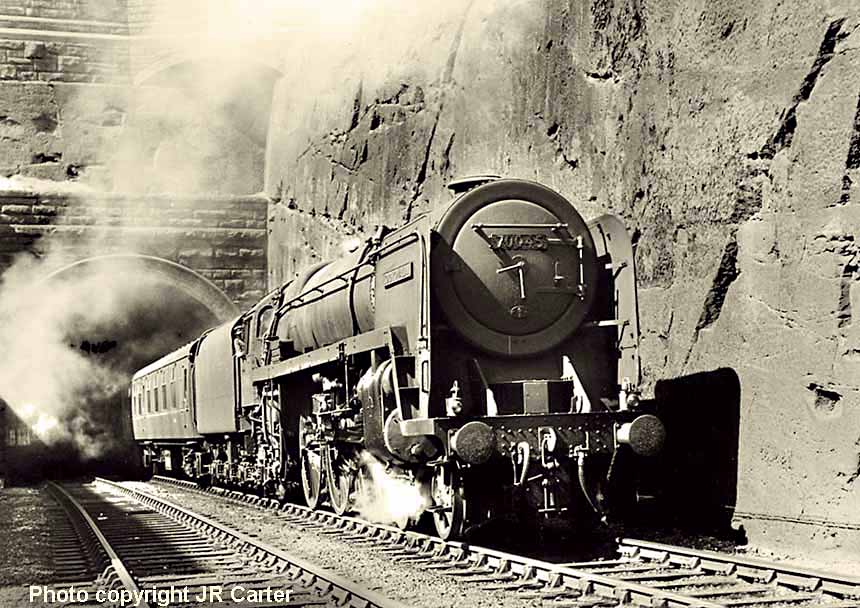
(Above-Below) Another fine shot by Footplate Cameraman, Jim Carter, who captured many such images at Chester while working from Patricroft on the Manchester-Chester turns. Here a grimy BR Standard Pacific No 70045 'Lord Rowallan' threads the short curved tunnel beneath Northgate Street, just one of 19 tunnels on the Holyhead to London route along which the Britannia was used many, many times during its eight years at the Anglesey depot. The total figure does not include Conway Bridge or Britannia Bridge, both constructed under the guidance of Robert Stephenson, as large steel tubes across the relevant watery divide. (Below) Britannia 70045 makes good progress with the 09.30 Manchester-Glasgow at Patricroft in 1964. Dubbed the 'Morning Scot' by railwaymen, it's a shame this Anglo-Scottish express was not given an official title; 70045 would not have carried much above three different headboards throughout its all too short career; mainly the 'Irish Mail', but on occasions the 'Welshman' and the 'Emerald Isle Express' all seen in the early part of its career.
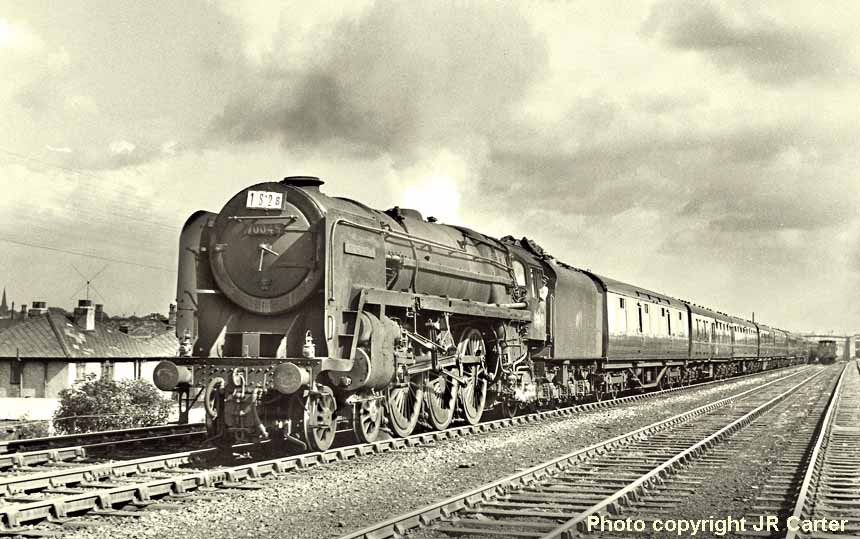
(Below) A very creditable image of BR Standard Pacific No 70045, formerly 'Lord Rowallan' working on the Western Region for the first time in its career; the wholesale scrapping of the WR's 4-6-0s created a large shortage of express locomotives for this type of turn, necessitating the transfer of seven BR Britannia Pacifics with the larger tender to Oxley depot, enabling trips to be completed without refuelling. Here 70045 is moving an express from Wolverhampton (High Level) to Minehead on a Summer Saturday in 1965.
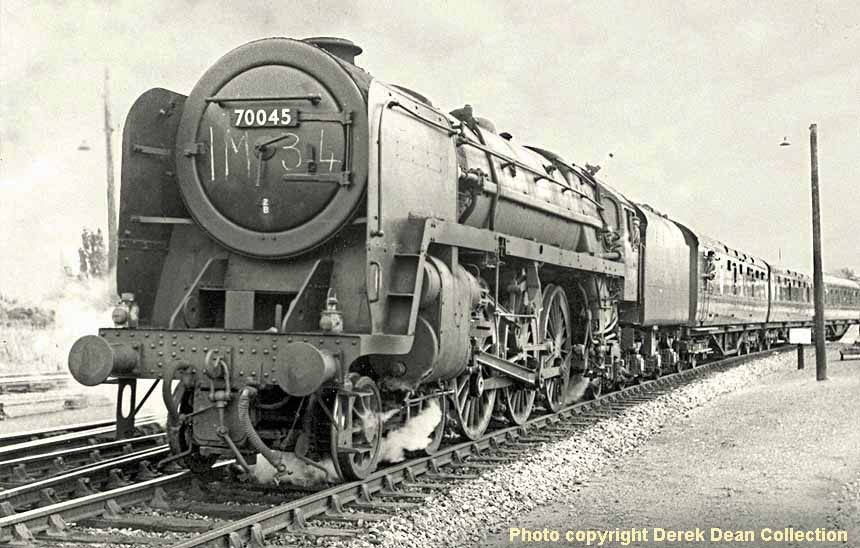
SERVICE RECORD: 70045 'Lord Rowallan' gave excellent service to Holyhead depot and very often hauled the 'Irish Mail', the late-night boat train to London Euston, also returning with the early morning departure for passenger connections to the sailing from Holyhead to Dun Laoghaire in Ireland. Also the locomotive would have been in charge of the 'Emerald Isle Express' which ran a similar course to the 'Mails', but only initiated in 1954. The stud of five Britannia Pacifics, which had taken the work of seven 'Royal Scots', were themselves ousted from Anglesey by the new stock of EE Co Type 4 diesel-electric locomotives and very soon three of them resided at Crewe North, though only briefly, as 70045 was reallocated with 70048 and 70049 to Camden shed, a depot which had a minimal allocation of Britannia Pacifics of its own, but was used by the Britannia Pacifics from Holyhead depot, as well as visiting engines from all points north. The three classmates were also grouped together at the old Lancashire and Yorkshire depot at Newton Heath in Manchester for a period of 19 months from February 1960. The fact that No 70045 was allocated to an ex-Lancashire & Yorkshire shed, an ex-Great Central Railway depot, two ex-Great Western locations; not to mention an ex-Caledonian MPD, reflects the wide usage of these Pacifics, but also shows the reason why only three locomotives in the class were considered to be true London Midland Britannias: Nos 70031 'Byron', 70032 'Tennyson' and 70033 'Charles Dickens'. The reason for the allocation at Wolverhampton Oxley along with Nos 70047 and 70053 (Moray Firth) was to cover the Great Western Region Summer services to Minehead and Kingswear after the wholesale withdrawals of the GW 4-6-0s in 1963 and 1964, leaving precious few available engines. Eight Britannia Pacifics were allocated to newly coded Banbury depot (2D) from October 1965; these were 70045, 70046, 70047, 70050, 70051, 70052, 70053 and 70054, all of which were transferred to Carlisle Kingmoor by the end of January 1966. Recorded mileages for the first six years in service were very good, showing that 70045 was a very capable and reliable member of the class, except for some issues in 1956 with the drive axle bearings running hot on two separate occasions. From the summer of 1954, the figure was almost 32,000 miles; 68,000 for its first full year in 1955; a somewhat lower figure of 56,000 for the troublesome year in 1956, but this was followed with a good return of 66,000 for 1957 and a steady 56,000 miles for the subsequent year. These figures were only bettered by a recorded 71,694 miles travelled during 1959, which also allowed for a four-week visit to Crewe Works in October. All repair and maintenance was attended by Crewe Works and fourteen occasions were noted, including 'hot box' repairs in April and June 1956. It is interesting to note that 70045 was in service for thirteen years and six months, but entered Crewe Works at least fourteen times, so averaging one visit for each year in service.
Interestingly, the locomotive was recorded on the 'Irish Mail' express hauling 515 tons from Holyhead to Euston by Ronald Nelson, who travelled on the footplate and noted the relevant output from the engine. The report was published by Ian Allan in 1979 in 'Locomotive Performance - A Footplate Survey' and described the number of delays that blighted the ability of the crew to keep to the scheduled time. Briefly the train suffered eight delays on route; initially the express was nine minutes leaving Holyhead while the Britannia Bridge was the first speed-check as the sharp curve into it was difficult; a permanent-way check at Old Colwyn reduced the train speed from 72 to 53 mph; then on the approach to Chester signals were unfavourable, most likely due to its late running; a second permanent-way check at Norton Bridge was more severe than the first while loading delays at Rugby Station caused a slightly late departure; a signal-check at Roade brought the train to a stand and recovery from that was hard work, but Wembley was reached travelling at 77 mph; yet another signal-check, this time on Camden Bank slowed progress, but Euston was reached half a minute early. The performance of 70045 was quite some achievement given the problems in running, though this was helped slightly by good work by staff at Chester Station and then again at Crewe. The maximum recorded power output was 1,442 horsepower at the approach and climb to Whitmore summit, soon after leaving Crewe Station, also 1,289hp was noted on the coast-line from Rhyl to Shotton, near Queensferry, when the train maintained 68-69 mph.

(Above) This low-angled shot of Britannia Pacific 70045 coasting down Shap bank with a southbound fitted freight in 1966 shows the locomotive's newly fitted oval buffers; these replaced the usual round ones following 70045's involvement in a heavy collision. 70045 is reported to have worked the 1.10pm Carlisle to Skipton on the penultimate day of 1967, then moved light engine to Rose Grove where it hauled a coal train to Wigan on January 1st 1968 before actually being withdrawn.
(Below) A pair of Type 4 diesels read the last rites for the now unnamed BR Class 7MT No 70045, leaving the dishevelled and generally run down locomotive to feed off the scraps left by the new breed of modern traction which were monopolising all the top express turns. For the record, No 70045 was only the second Britannia to be named after a living person, the first being No 70001 Lord Hurcomb. The photograph was taken at Leeds Holbeck depot by Bill Wright, whose 'Rail Cameraman' page can be found HERE with links to his superb 'Barking Bill' Flickr website.
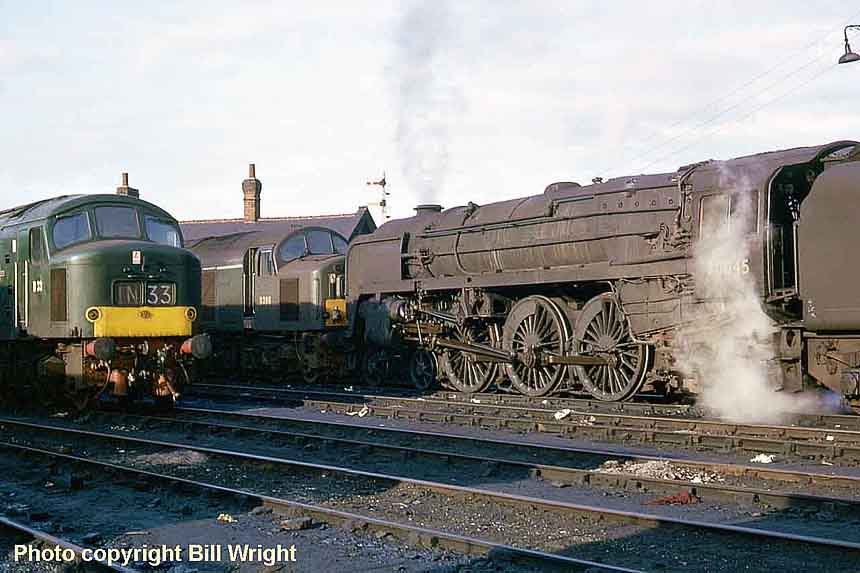
SIGHTINGS: In July 1955, No 70045 was viewed at Camden depot in North London, having brought a Boy Scout excursion from the North West and the n/s/r view clearly displayed the immense bulk of the BR1D tender which was two tons heavier than the more usual BR1 version. The following year unnamed Britannia 70045 was seen at Bangor station awaiting departure with a local to Chester, looking in very clean condition, but on closer inspection the rather heavy layer of grime still remained on top of the boiler and smokebox where the headboard had been placed. Britannia 70045 was chosen to be named after Thomas Godfrey Polson Corbett, better known as Chief Boy Scout, Lord Rowallan and a special naming ceremony was arranged at London Euston station on 16th September 1957. The engine was well prepared and cleaned at Kentish Town depot, with the new, pristine nameplates and the latest BR totem applied to the tender. However a very different looking engine was witnessed several weeks later exiting Conway station with the 'Irish Mail' for London, moving through the impressive gateway to Conway Castle; it had probably not been treated to anything like a cleaning rag in the interim. At Rugby station the unkempt engine was captured waiting patiently for the start signal to continue south to London with the 'Irish Mail' in July 1959 and it was noted that the new BR company logo was still facing the wrong way (forward) having being applied two years earlier. Some two years later the very grime-encrusted 70045 was photographed leaving Tebay with a heavy Manchester to Glasgow train consisting of fifteen bogies, and requiring the assistance of a banker for the 1 in 75 climb to Shap summit. The Britannia had moved from Newton Heath depot to Aston in Birmingham and returned to Holyhead shed for a couple of years when observed leaving Chester station with an express for Crewe, but displaying the depth of layers of grime that would defeat even the most devout 'spotter'. Alas the grubby encrusted condition of the locomotive was typical for the period.
DISPOSAL: Withdrawal took place on Saturday 30th December 1967 from Carlisle Kingmoor. The engine was stored until the end of February 1968 then transferred to Wards Beighton, Sheffield for cutting up from March 1968.
The 1953 building programme was authorised on the 20th November 1951, but delayed due to shortages of steel. The Order No was E486/234 and the total cost £24,837, 70046 was built at Crewe Works and completed on 22nd June 1954. With the engine barely 13 years old, withdrawal came from Carlisle Kingmoor depot on Saturday 8th July 1967.
ALLOCATIONS: 70046 'Anzac' was, from the outset, predestined to work from Holyhead depot (6J) to assist in operating the important boat trains along with classmates 70045, 70047, 70048 and 70049; the stud of five engines worked from there until November 1959. The engine was then moved around the main LMR depots and except for two more full years at Holyhead (6J), 70046 did not settle for very long; first spending three months at Crewe North MPD (5A) followed by 19 months at Longsight (9A) up to September 1961. The engine then found favour at Willesden depot (1A), but only for one week, before being transfered to Carlisle Kingmoor MPD (12A), spending four weeks there before returning to Willesden for a stint of six months only. Aston depot (21D) was next on the horizon, spending a little over seven months from May 1962 until a return to Holyhead beckoned for a fraction more than two years, then landing back at Crewe where more than half of the Britannias were resident in 1965. Following closure of Crewe North (5A) to steam in May 1965 all but two resident Britannias were reallocated to Crewe South MPD (5B) including 70046 'Anzac'. All previous allocations had been strictly LMR depots, but the engine then moved over to the ex-GWR shed at Banbury (2D) which had been transferred from WR to LMR in September 1963, joining seven other class members in September 1965, but only for the remainder of that year as it was relocated the first day of 1966 to Carlisle Kingmoor (12A) where it ended its rather short career at the graveyard of so many engines.
(Below) Holyhead allocated BR Standard Pacific No 70046 poses alongside Norwich based 70012 'John of Gaunt' outside the paintshops at Crewe Works on a very cold morning in December 1955. No name has yet been chosen for the relatively new 70046 and the locomotive had to wait almost another four more years before the 'Anzac' plates were applied. Meanwhile, having clocked up 350,000 miles during four years of service on Great Eastern lines, 'John of Gaunt' has just received its first General Overhaul, including a boiler refit.
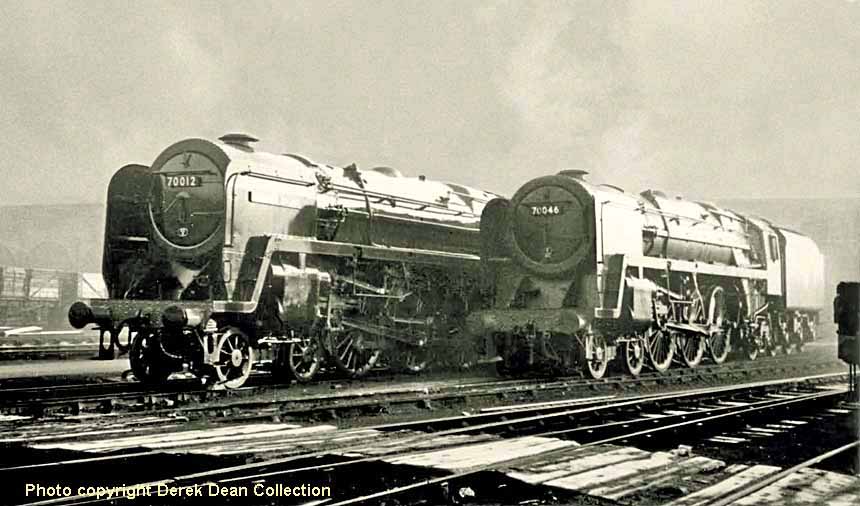
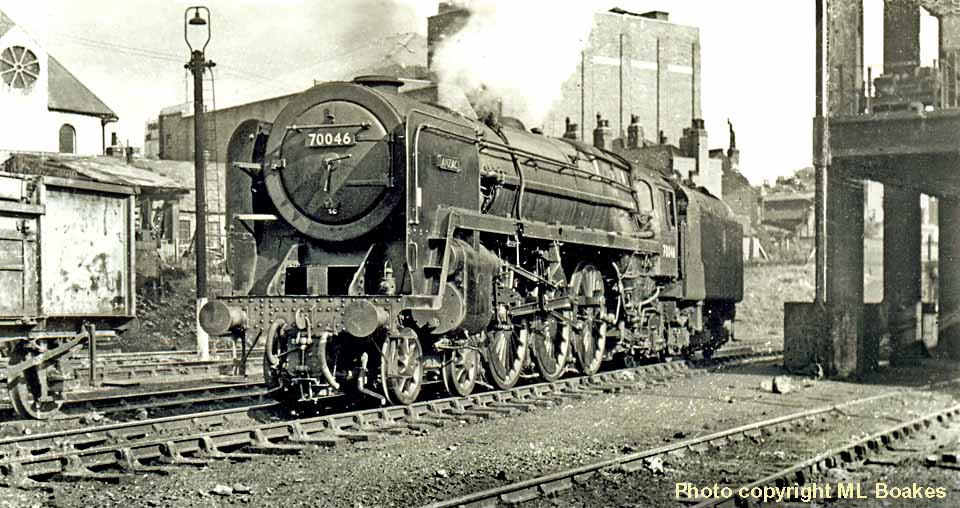
(Above-Below) This strong image from the camera of ML Boakes depicts a fine looking BR Standard Pacific 70046 Anzac at Kentish Town depot in London in 1960. At this time the engine was allocated to Longsight depot in Manchester; indeed the only Pacific allocated to Kentish Town shed (14B) was 70042 'Lord Roberts', but a number of Britannias came in for servicing after working services from the Northwest. The 1940 coaling tower is to the right of the picture and the left background is dominated by Kentish Town Parish Church. (Below) In 1963 BR Standard Pacific 70046 'Anzac' is involved in engineering works on the West Coast Main Line at Winwick Junction, where preparations are underway for electrification of the route to Glasgow, much of it necessitating the lowering of the track to ensure the overhead wires had sufficient clearance beneath the numerous road over bridges. The Britannia has just been released by Crewe Works who have added the AWS equipment and repositioned the lamp irons to comply with new regulations.
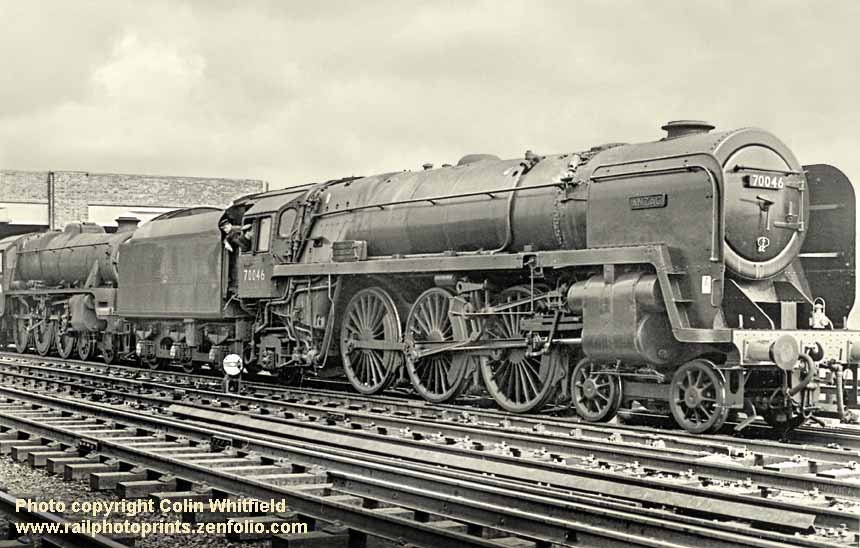
(Below) Having waited more than five years for its nameplates BR Standard Pacific 70046 (Anzac) has now lost its identity when photographed at Willesden depot (1A) in North London in 1965; the depot boasted a 12-road straight shed and a roundhouse, which lasted until September that year. The red paint has been added to the buffer beam very recently which rather argues with the remainder of the faded paintwork on the Britannia. In 1965, 70046 was serving its third stint at Holyhead (6J).

MODIFICATIONS: 70046 'Anzac' was the second member of the third batch of engines coupled to a BR1D tender with a steam operated coal-pusher, which did not require a cab sheet (item 9) or a tender step (item 10) to be fitted. The Britannia was modified as deemed by a number of updates to the build programme, which included axle repairs (item 17) and plain coupling rods (item 14), also because the engine remained under the control of Crewe Works throughout its career the smoke deflectors (item 3) retained their handrails right to the very end. The last batch of ten engines was built with a speedometer (item 13) fitted and three raised sand box lids (item 16) to aid filling and help the engine when setting off, especially on wet rails, via the use of the steam operated sanders. Only eight items from the full list of twenty-one were seen to be modified or added during the service life of 70046 'Anzac' beginning with the full platform front step (item 1) when the engine received Intermediate repairs at Crewe Works, in July 1957, coupled with a shortening of the nearside lubrication operating rod (item 18) to increase output. The subsequent Works visit was a Heavy Intermediate which was carried out in April 1959 and resulted in three changes; the LNER return crank (item 15) was modified to a LMR version, the new BR emblem (item 11) was applied and the AWS equipment (item 20) was added with in-frame pipework. After transfer to Longsight depot, the power warning plates (item 19) were added to warn crews of the dangers of overhead wires and in 1961 a Class Power Rating of '7P' was noted over the cabside numbers, this being only added to five Britannias in total. Following the engine's last visit to Crewe Works the lamp irons (item 2) were repositioned in-line with safety measures concerning electrified overhead wires.
(Below) Another capture by BKB Green for Initial Photographics shows Britannia 7MT No 70046 - now minus its Anzac nameplates and in a somewhat dilapidated state - in residence at Carlisle Kingmoor shed in September 1966 where a total of 30 Britannia Pacifics were allocated at the time. Of note is the fact that the speedometer is disconnected, the exhaust flange cover is missing from above the cylinder and the driver's name bracket is still in position over the last two digits of the cabside number.
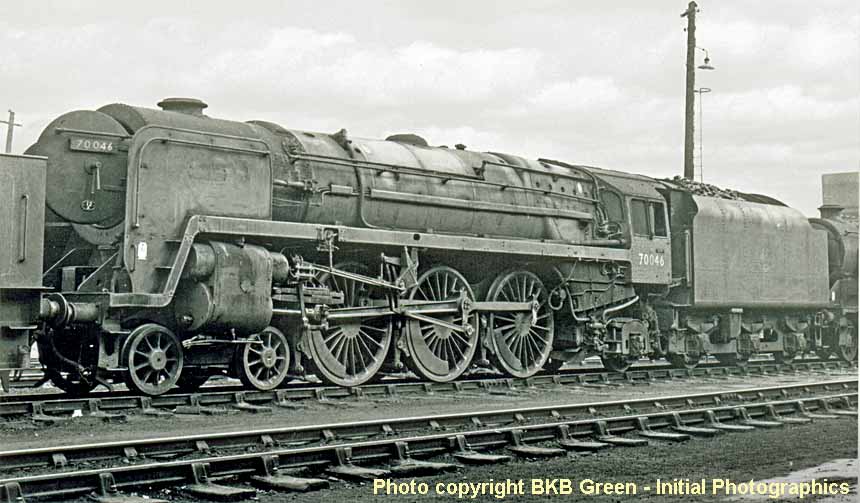
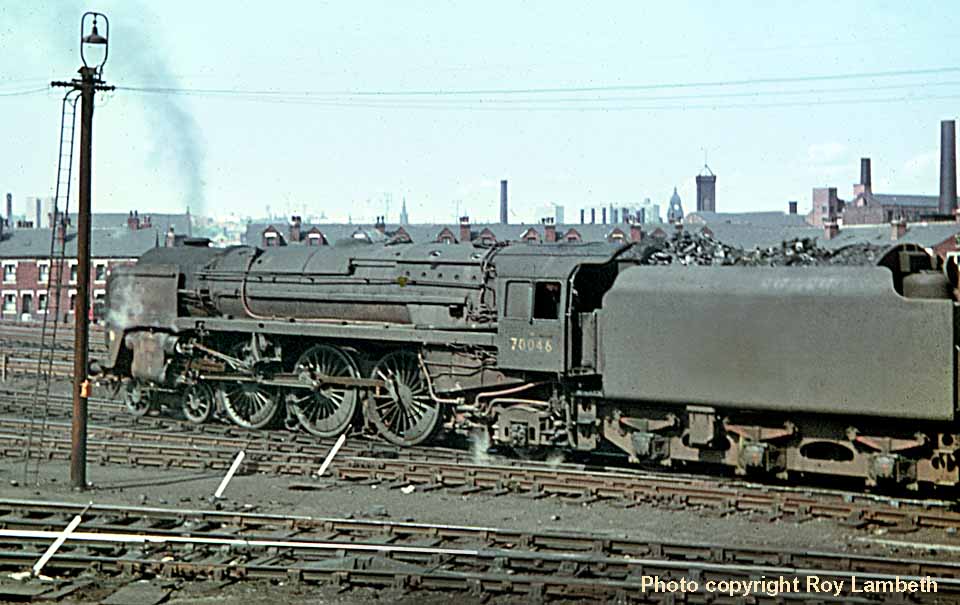
(Above) While driving through Leeds on 29th May 1967, Roy Lambeth just happened to pass Holbeck shed and snatched a couple of photos over the wall, including this one of a scruffy 70046. The unkempt condition of the locos was typical of BR's stock during the final years of steam.
SERVICE RECORD: As mentioned earlier, 'Anzac' spent its entire life under the regime of Crewe Works, where it was admitted on eleven occasions for maintenance, repairs and modifications. The Anzac name is derived from the acronym of 'Australian and New Zealand Army Corps' which was formed in Egypt in 1915; the name was bestowed in honour of their collective efforts in WW1. The nameplates were not added to 70046 until September 1959, hence the engine worked nameless from Holyhead depot for almost all its time there; its classmates Nos 70045, 70047, 70048 and 70049, were also unnamed at first, which meant all five worked from North Wales for three years without displaying a name. The Britannia was very commonly seen on the 'Irish Mail' express, often loaded to 16 vehicles, including 4 full brake vans for the excessive amounts of luggage; this was about the limit of the power available to the BR Class 7 Standard Britannias. The five Holyhead Pacifics were all transferred away in preference to the new English Electric Type 4 Diesel-Electric locomotives in early November 1959. From early 1962, 70046 was a regular performer on the car-carrier train to Scotland, which started operating from Sutton Coldfield station in 1960 and initially accommodated 20 vehicles and 84 passengers making the outward journey on Sundays and Wednesdays, and then returning on Mondays and Thursdays. The recorded mileages for the engine produced a good average, although a return of 46,000 miles for 1955 was on the low side for a new locomotive, the subsequent four years yielded an average of over 59,000, falling to 40,000 miles for 1960, with a maximum figure of 64,500 posted for 1957, for which 70046 had six weeks at Crewe for repairs, this being one of its eleven visits to Crewe Works.

(Above) A nameplate from the BR Standard Britannia Class 4-6-2 No 70046 Anzac went under the hammer for £8,000 at a great Central Railwayana Auction in April 2011. Built at Crewe and named in September 1959, No 70046 was allocated new to Holyhead in July 1954 and later Crewe North, Longsight, Willesden, Aston, then back to Holyhead again, before being transferred to Banbury and finally Carlisle Kingmoor from where it was withdrawn during the first week of July 1967. It was sold to Campbells, Airdrie on 3 October 1967. The loco takes its name from the Australian and New Zealand Army Corps formed during WW1.
(Below) A superb DJH 0 gauge model of Class 7MT 70046 Anzac built by Ian Mathews. Since a high number of railway modellers use this page as a source of reference I feel obliged to point out a couple of minor errors which are scarcely noticeable to the casual observer. Five items should be considered: 1 - the middle lamp iron should be aligned with the upper iron; 2 - the (SC) plates were not seen after 1962; 3 - the lubrication rod offside should be long not shortened; 4 - the BR emblem is a shade low: 5 - the smoke deflector handrail is not aligned with the boiler rail. However these minor inaccuracies do not detract from what is a beautifully weathered example of the locomotive's final years, and perhaps the best model I've ever seen. Click HERE to visit the excellent range of 0 gauge locos on the DJH website
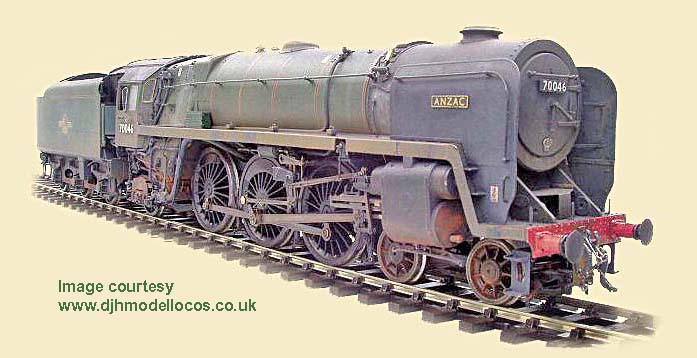
SIGHTINGS: Very few images have come my way to illustrate the unnamed '70046' working from Holyhead in the period up to the latter part of 1959; possibly this is due to a Britannia without a name having low appeal, although there were many occasions when 70046 was diagrammed to the 'Night Mail' train for the 263 mile trip to London Euston. The unnamed engine was seen outside the paintshops at Crewe Works during December 1955, the first occasion that the engine had returned to its birthplace. Nearly four years later, following extensive repairs at Crewe, the pristine 70046 was observed at rest on Newton Heath depot in an excellent condition; fully lined out, including the cylinder casings. It was noticeable that the AWS equipment had been added, although the record book states 1961 and the LMR return crank had been substituted for the original type. The scene for another image of Britannia 70046 was the cramped and blackened Birmingham New Street station, where the engine was photographed passing the small signal box situated between the Aston and Derby lines on the approach to platform 6, to form the afternoon train for Manchester and Liverpool Lime Street. In 1962 the Aston-allocated 70046 was observed in fine fettle at Sutton Coldfield Terminal awaiting departure with the regular car-carrier train to Stirling in Scotland. But later photographs depict a very run down, scruffy engine, including an unnamed 70046 travelling very fast on the down fast line through Prestatyn station with the 'Irish Mail' in July 1965; the engine was also missing its numberplate, so identification must have been tricky, but the cameraman noted the train was running exactly on time despite working to Type 4 diesel timings, no mean feat.
DISPOSAL: Withdrawal took place on Saturday 8th July 1967 from Carlisle Kingmoor. The engine was stored at Kingmoor until the end of the year before transfer to Campbells of Airdrie for cutting up (still under construction)
Programme authorised 29th November 1951, built at Crewe Works and completed on 25th June 1954 to Order No E486/234; total cost £24,837. Withdrawn Saturday 29th July 1967 from Carlisle Kingmoor.
ALLOCATIONS: No 70047 was initially allocated to Holyhead MPD (6J) joining 70045, 70046, 70048 and 70049 to create a stud of five Britannias for the next five years until relocation to Crewe North depot (5A) from November 1959. However, whilst the following sequence of moves are fairly typical for the period, they are also confusing in that two returns to Holyhead were mixed in with three moves to Willesden (1A), interspersed with three weeks at Carlisle Kingmoor (12A) in late 1961 and 21 months at Aston (21D) from March 1962 to the end of 1963. A third swift visit to Willesden was followed by a short third posting at Holyhead (17 months) before a move to the ex-GWR shed at Wolverhampton Oxley (84B) in the summer of 1965; 70047 was then shunted out to Banbury (ex-84C) in October and finally to Carlisle Kingmoor MPD (12A) from January 1966 for the last 19 months of service.
(Below) Photographed in 1960, unnamed Britannia No 70047 is seen at Bushbury MPD alongside an 'older generation' LNWR G2 class 0-8-0 freight engine, of which there were many examples allocated in the West Midlands area. The scruffy Pacific was based at Crewe North at this time, being just one of a crowd of 'Britannias' at 5A, rather than among the select few when stationed at Holyhead during the previous five years. Bushbury's eight-track shed was designated both 3B then 21C in 1960, but a mere six years later, despite the depot building receiving a new roof in 1959, the shed facilities were closed. A link to the excellent Transport Treasury archives can be found at the bottom of the page.
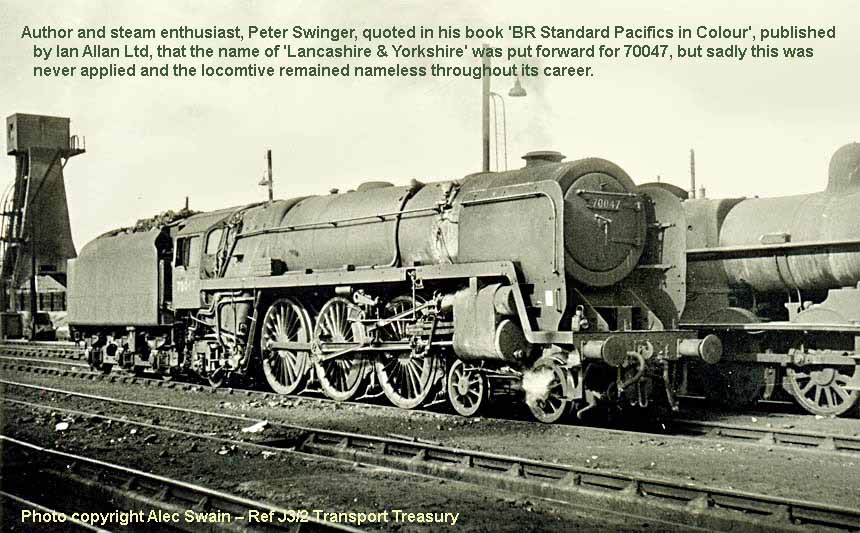
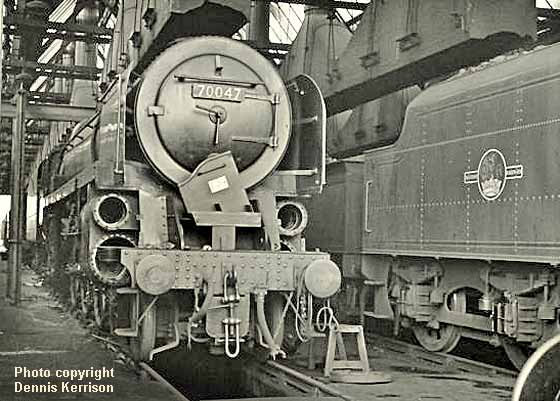
(Above) With thanks to Geoff Poole and John Hobbs of the excellent '6g nwrail' website HERE, we can view this unusual image of Britannia Pacific No 70047 as captured by Dennis Kerrison of Prestatyn. The regular maintenance of renewing the Britannia Pacifics' piston rings was a lengthy, though fairly straightforward task performed by shed staff three or four times a year, dependent on the mileage of the locomotive involved. The heavy connecting rod had to be disconnected from the piston rod before the 20in. diameter piston could be drawn forward for repairs; this work was best described as a 'kitchen sink' job not involving much specialist tools except for the use of a 'de-glazer' which was applied to the cylinder lining to improve the seal of the rings.
MODIFICATIONS: 70047 was the third engine of the third batch of Britannia Pacifics Nos 70045-70054 and ultimately became 'the anonymous one' although two names were rumoured to be strongly linked with the engine. Since the locomotive was coupled to the larger BR1D tenders it did not require a tender step (item 10) or a cab sheet (item 9). Also the modifications fitted from new included the speedometer (item 13); the modified Axles (item 17), plain coupling rods (item 14) and three raised sand box lids (item 16) on each side of the engine. In addition, the Crewe Works hierarchy decided that changes to the smoke deflectors (item 3) were unnecessary, thus just eight subsequent modifications were relevant to 70047 during its rather short career. The raised platform front step (item 1) put in an appearance in March 1957 and the engine was also fitted with the LMR type return crank (item 15) replacing the original LNER version. Following the 'Polesworth Crash' in November 1951, the fitting of the Automatic Warning System (AWS) was considered a safe and proven addition to the braking system, but the equipment (item 20) was not applied until December 1959, by which time the Britannia had covered over 322,000 miles. Crewe Works fitted the new BR emblem (item 11) to the sides of the BR1D tender which revealed a higher centre line compared to the emblem fitted to the BR1/BR1A types. Soon after its works visit the power warning plates (item 19) were added at Crewe North (5A) at much the same time as the overhead power lines were being erected on the West Coast Main Line. During another visit to Crewe Works in 1964, 70047 had its central lamp iron on the buffer beam (item 2) moved to a new position in alignment vertically with the topmost lamp iron, which for safety reasons, was moved to a lower position on the right hand side of the smokebox door; this avoided the need for engine crews to reach up to chimney height in the vicinity of overhead electrified wires.
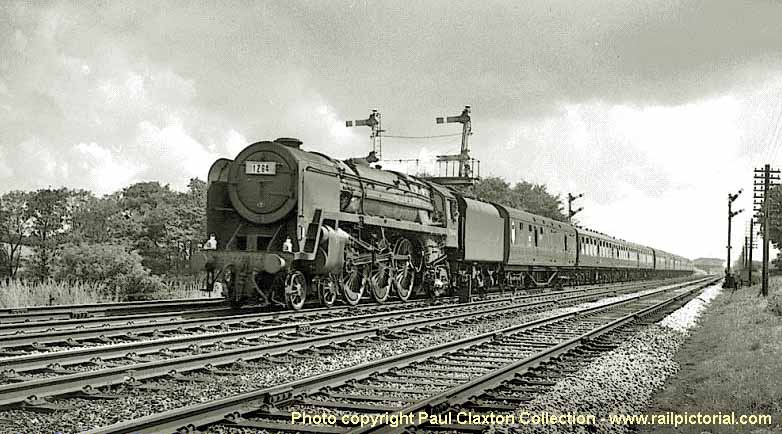
(Above-Below) Aston allocated Britannia 7MT No 70047 sprints through Dowbridge near Treales and Kirkham with a Smethwick (West Midlands) to Blackpool Central excursion in August 1962. This section of four-track main line between Preston and the Fylde coast resort was one of Paul Claxton's favourite spots for photographing steam engines doing some of their best work away from the West Coast Main Line. A link to the excellent Rail Pictorial website can be found on Page 46; see left-hand menu. (Below) Before the advent of the motor car had taken over people's travel plans, Britannia Pacific 70047, the only unnamed one, was captured by Paul Claxton at Collins Green at the head of a race special for the famous 'Grand National Day' at Aintree Racecourse in March 1964. The original Liverpool and Manchester Railway line was constructed under the guidance of the remarkable George Stephenson and a station was opened at Collins Green in 1831, though it closed relatively early in 1951.

SERVICE RECORD: The initial reaction to the arrival of Britannias Nos 70045-49 at Holyhead from June 1954 was one of apathy by railwaymen; this was caused by the failure of Holyhead's earlier Britannias Nos 70030 to 70033 which were allocated to 6J from November 1952. Both Nos 70030 and 70032 were given the task of hauling the 'Irish Mail' trains between Holyhead and London, but on occasions the locomotives were found to be running very low on coal; indeed in some extreme cases a stop off at Rugby MPD was required to collect more fuel. The loading of the 'boat trains' was such that up to four extra vans might be required for passengers' luggage; this created a lengthy train very close to the upper limits of the Pacifics' power and the additional vehicles stretched the 7 ton coal capacity of the early BR1 tenders to the limit. However, the extra two ton capacity of the later BR1D tenders alleviated that problem. 70047 was shown to be an efficient performer and recorded good mileages for its first six years in service, averaging just over 57,000 miles per annum. The main duties for the Britannia class engines at Holyhead shed was the 'Irish Mail' boat trains connecting passengers to Ireland from London. No 70047 was ousted from Holyhead depot by the new EE Co Type 4 diesels (Class 40) in November 1959. Following a purge of the WR's main line engines which left the Region short of motive power, 70047 was relocated at Banbury along with seven other Britannia class engines to help with the Western Region's summer services. All recorded Works visits were to Crewe for repairs, service, updates and modifications, with ten entries noted. 70047 had a very difficult 'time-line' therefore it is hard to pin down a relevant date based on modifications, or for works visits and general condition, and since no nameplates were ever fitted it is difficult to guide our judgement of the appropriate year. 70047 was one of ten to be constructed with plain roller bearings on the trailing bogie axle and three drive axles; this feature could be easily identified by the endplate showing prominent web castings. The slightly more expensive plain bearings were fitted to Nos 70040-70049 for comparison and evaluation, though it was noticed that they did not prevent problems in service, albeit they were marginally more reliable than roller bearings. Having spent a total of over 7½ years at Holyhead depot, the 'Irish Mail' was a regular duty for 70047, but no other headboard would seem to have been carried by the engine during its all too short career, though in 1962 it was observed at Mold Junction with an express designated the 'Welshman' - a Portmadoc to London Euston summer-only train, albeit on this occasion the locomotive was not displaying a headboard.
(Below) This shot of a very clean BR Standard No 70047 backing onto its train at Chester General station was captured by Footplate Cameraman, Jim Carter, reproduced courtesy Rail Photoprints; a link to the Rail Photoprint's website can be found at the bottom of the page. The train is probably a morning Bangor-Euston express brought in by a local 4-6-0 engine, of which there were very many at this time. After the station opened in 1848, the ancient City of Chester quickly became the hub of the rail network in the North West, providing a gateway for the LNWR to the North Wales coastal resorts and the Great Western Railway access to Birkenhead Dock.

SIGHTINGS: Having spent several years allocated to Holyhead depot, 70047 was a common sight at Chester where it was photographed at rest inside the eight-tracked LNWR running shed (6A) in 1955. The shed was briefly the home to just two Britannia Pacifics Nos 70045 & 70049 late in 1959. 70047 was viewed heading the 'Irish Mail' at Aber on the North Wales coastline in the summer of 1959; the locomotive looked in excellent condition, sporting a modified front step and the new BR emblem on the tender. After relocating to Crewe North MPD, a rather grubby 70047 was observed further afield at the head of a Glasgow to Birmingham express at Kirkpatrick in Scotland very close to the English border in June 1960. During its subsequent five years of service the general condition of the Britannia did deteriorate, as most other steam locomotives did at that time, but it was noticeable that the security of the protective channelling for the steam pipes to the exhaust ejector unit became increasingly displaced, insecure and eventually sections went missing. In July 1963 a very forlorn-looking No 70047 was captured struggling to lift its train on the climb to Shap summit even though sterling assistance was being provided by a Tebay banker. The scruffy, neglected Aston-allocated engine was 'priming' badly, which means that water had carried over into the cylinders and steam was billowing out from every conceivable outlet. In November 1965, the locomotive was rather fortunate to receive a late 'shopping' which resulted in a very presentable Britannia being viewed at Crewe South (5B) early in 1966 and revealing that Crewe Works had cut no corners in their rectifications; the nearside lubrication pump (item 18) must have been changed because the operating rod was now back to its original length, the pathetic looking pipe channelling along the boiler had been completely reset with the three missing pieces replaced and it was noticeable that the livery lining had not been applied.
DISPOSAL: Withdrawal took place on Saturday 29th July 1967 from Carlisle Kingmoor. The engine was stored until November 1967 then transferred to Campbells, Airdrie for cutting up from December 1967 (still under construction)
Built at Crewe and completed on 8h July 1954 to Order No E486/234; costing £24,837, the Building Programme was authorised on 24th November 1951. Withdrawal came on Saturday 6th May 1967 from Carlisle Kingmoor.
ALLOCATIONS: 70048 began life at Holyhead MPD (6J) as part of a small stud of engines to operate both the 'Irish Mail' day and night turns, and this was done successfully until November 1959 when 70048 was among the first Britannias to be allocated to Crewe North (5A), although this only lasted 5 weeks before relocation to Camden depot (1B) in North London. The following two years became a succession of moves around the London Midland Region, starting at Newton Heath shed (26A) from February 1960 to September 1961, then in quick turn: Neasden (34E), Annesley (16D), Willesden (1A) and Llandudno Junction (6J) up to April 1963 when 70048 moved to Aston shed (21D) in Birmingham. By the end of that year the engine was on the move yet again, first returning to Willesden (1A) for a period of 10 months until late 1964, then on to Carlisle Kingmoor (12A), but for a mere four weeks before finding favour at Carlisle Upperby (12B) for just over two years, then returning to Carlisle Kingmoor (12B) for the final six months of service.
(Below) To commemorate the 50th anniversary of the founding of the TA, Britannia No 70048 was named 'The Territorial Army 1908-1958' in honour of the heroic efforts of the men who fought hard for our country as a Volunteer Force. The two-line nameplates were unveiled by the Duke of Norfolk at a ceremony held at London Euston station in July 1958. In this capture by Barry Hilton the yet unnamed locomotive hauls an express consisting of 'crimson and cream' coaches through Chester General Station heading back to Holyhead just as the engine would have done many times during its five year allocation to Holyhead depot. The front step was added in 1957 so this would seem to date the image likewise.
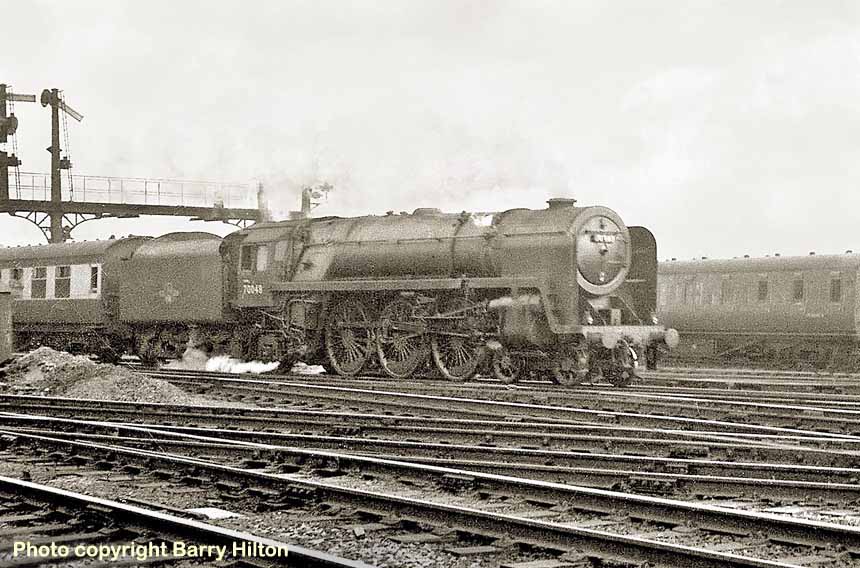
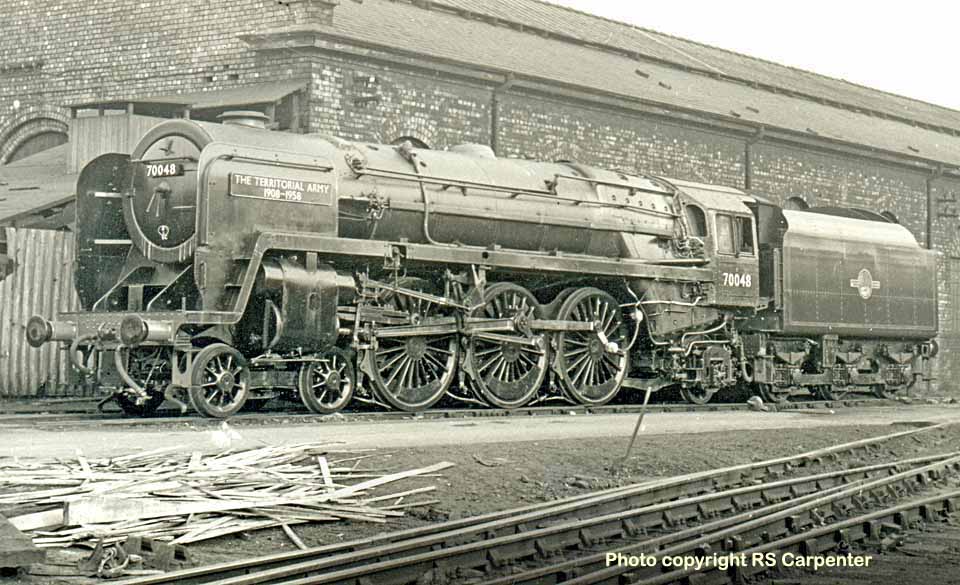
(Above-Below) Roger Carpenter's superb view of 70048 The Territorial Army 1908-1958 affords us the opportunity to see the pristine Brunswick Green paintwork coupled with its two-line cast-aluminium nameplate. The engine was pictured at Crewe Works on 8th November 1959 following a Light Intermediate repair, which indicates a partial repaint would have been done; also we should note the front bogie wheels had 9 spokes, class identification is still a '7' but would be upgraded to '7P' at the next repair and the centre line of the BR emblem is some way higher than that of the cabside number. (Below) Former Annesley fireman Chris Ward has created an excellent website devoted to his railwaymen colleagues at Annesley shed (16D) near Kirby-in-Ashfield in Nottinghamshire HERE. Chris's site provides this strong image from 1962 of 7MT Britannia No 70048 'The Territorial Army 1908-1958' during its spell at 16D. The AWS battery box is prominent, along with the extra large vacuum cylinder for the system, on the boiler walkway; also the height of the BR emblem compared to that of the cabside number should be noted; plus the classification '7P' above the number, which was only seen on five Britannias. The six-track shed closed early in 1966 and later demolished.
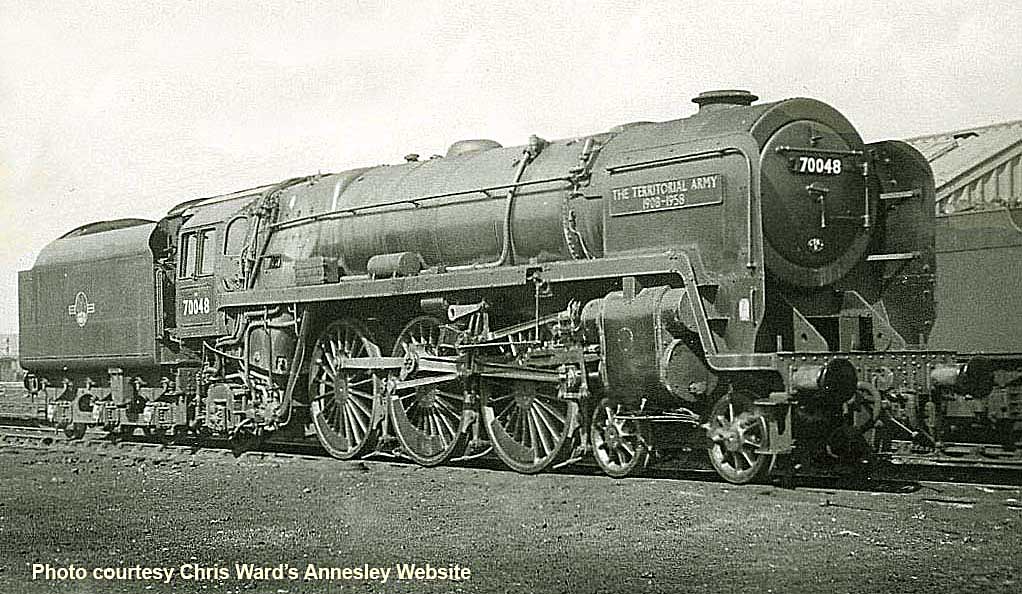
MODIFICATIONS: The delays in starting the last build programme were caused by a lack of available steel at that time, but this delay gave the Works the opportunity to apply the modifications that had been found to be necessary during the service of the other engines. These amounted to 5 items: item 17 - the hollow axles were 'plugged' and the wheel bearings seated correctly; item 16 - the sand box lids were raised from new and were now three in number, giving better delivery to the drive wheels; item 8 - the reverser recuperating spring was contained from new; item 5 - the steady bracket was fitted to the forward rod and the rear one (item 7) of the regulator from new. With the larger and heavier BR1D tender there was no need for a cab sheet (item 9) or the tender steps (item 10) to be added, so that the first modification to be noted was the front step (item 1), which meant that the original small twin steps were discarded and replaced with a large supported plate between the engine frames and this not only made the fitting of those rather heavy titled-train headboards easier, but also helped the crew to reach right the way into the smokebox for cleaning purposes. The step was altered at Crewe Works during December 1956, while the following year, the LNER return crank (item 15) was changed, during May and June at Crewe Works, discarding the two cotter-pin fixings in preference for the four-pin fixings of the LMSR type. The speedometer had been fitted to 70048 when constructed, but the Britannia had to wait until the very last weeks of 1959 before the AWS equipment (item 20) was added during another visit to Crewe Works, which coincided with the locomotive's transfer to Crewe North MPD (5A) greatly reducing the engine's opportunity to regular day to day passenger work. No picture is available to show otherwise, but in 1961, in addition to the normal AWS equipment, there was a larger vacuum reservoir fitted on the offside boiler walkway situated just in front of the AWS battery box. An interesting feature of the failsafe system was that the reset button was not operated by a downward press, but rather by a 'press and release' action so that, if the driver collapsed onto the button there was little chance of resetting it by accident. The power warning plates (item 19) were also added in 1961, while the nameplates were removed for safekeeping early in 1965, along with the repositioning of the lamp irons, to conform to Health and Safety rulings regarding overhead wiring.

(Above-Below) The ebullient Jim Carter captured this image of Britannia Pacific 70048 heading a mixed freight to Holyhead through the tunnels beneath Upper Northgate Street in the ancient City of Chester during the summer of 1961. The rather grimy engine is almost hiding its true identity under a layer of dirt and dust, but the two line nameplate could be spotted 'a mile away' as the saying went. 70048 is running on the Western Region 'up' lines out of the city, however had it been running on the London Midland Region's North Wales Coast lines to the left, the train would have been a 'down' freight, interestingly. (Below) This is the actual plate mentioned above; named to commemorate the 50th anniversary of the founding of the TA, the nameplates were unique in that they were the only double-liners fitted to the class and they were also unusually made of aluminium. Measuring 69½" x 11" the face has been restored, the lettering and rim lightly polished only, whereas the back is in ex-loco condition with a scrawled letter 'L', indicating that this was from the left hand side of the loco. The nameplate went under the hammer for £11,200 at a Sheffield Railwayana Auction in June 2008.

SERVICE RECORD: 70048 The Territorial Army 1908-1958 was unique in two ways; firstly, and quite obviously, the nameplate was the largest of the class, by some measure, and secondly the plates were made from cast-aluminium rather than cast in brass. The usual daily run for the Holyhead Britannias was a trip up to London, a distance of just over 263 miles, so a nice round journey of 526 miles. The recorded mileages for 70048 reflect a good average of 72,000 miles for the period of its allocation to Holyhead, but dropping to around half of that figure for the following five years. 70048 was always maintained by Crewe Works, visiting there on eight occasions, thus the smoke deflectors (item 3) were not altered at any time. In 1961, an addition to the normal power classification '7' appeared over the cabside number, but even then only to '7P' while '7P6F' was a very rare sighting indeed. Possibly the only titled headboard carried by the engine was the 'Irish Mail' which included the 'day' train and also the 'night' run, the latter leaving London Euston at 20.50 hrs. 70048 did well in service from Holyhead MPD because it was coupled to one of the larger BR1D tenders which could hold nine tons of coal and 4,725 gallons of water; the tender was also fitted with a steam operated coal-pusher to help the fireman during long continuous trips. This was thought to be the minimum requirement after some failures by Nos 70030-33 (as mentioned earlier on the page) whilst hauling the Irish Mail from Holyhead to London from late 1952. When allocated to Crewe North, Camden and Willesden, 70048 could well be seen on passenger turns, but similarly was just as likely to be seen on fitted freight or parcel trains and as time moved along the reverse of that situation became the norm.

(Above-Below) In the summer of 1964, 13 Britannia class engines were allocated to Willesden depot in North London and many more visited from other sheds, especially on sporting days such as the FA Cup Final. In May 1964 the Wembley Final was contested by West Ham United and Preston North End, and many extra trains ran that day. 70048 was recorded as receiving a light service at Crewe Works in June that year, hence the external state of the engine suggests that this photo from Lens of Sutton Association was taken during the earlier part of 1964. (Below) Carlisle Kingmoor based No 70048, now devoid of nameplates, draws a fitted freight from Carlisle into Ulverston Station. The station's splendid architecture has recently been restored; the mono-pitched glass canopies and fine clock tower are prominent features in the Cumbrian town; all a credit to the Furness Railway and the English Heritage.
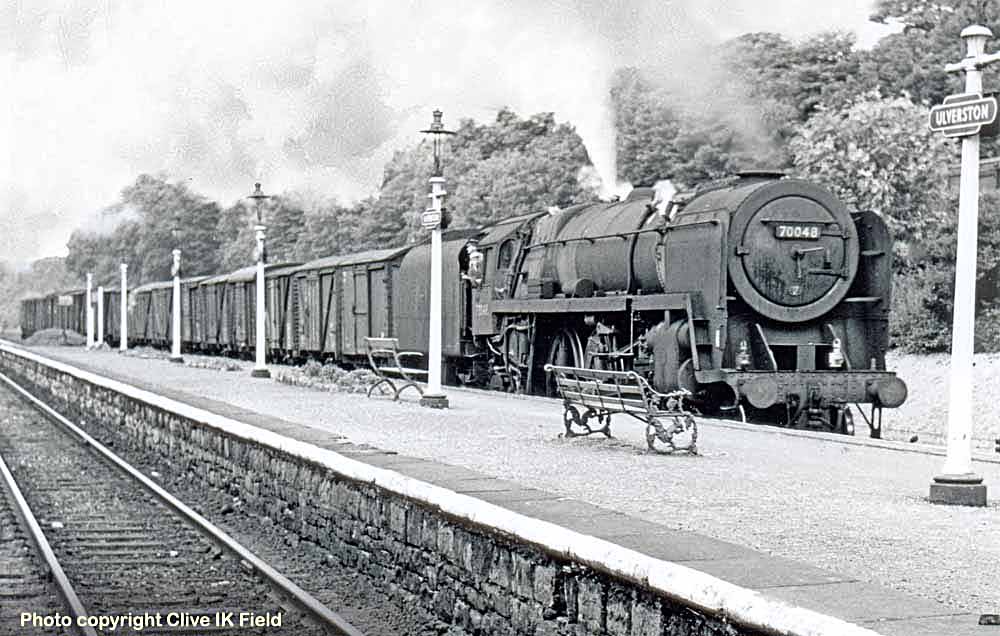
SIGHTINGS: Any early images reflect a clean, nameless engine hauling the 'Irish Mail' in the North Wales environs; as was the case early in 1955 when 70048 The Territorial Army 1908-1958 was pictured leaving Bangor tunnel, hauling the 'Day Mails' towards London with many early 'crimson and cream' liveried carriages in tow. Also of note was the large signal box tucked up against a backdrop of natural stone which stretched up to over a hundred feet, towering above the whole scene and making one realise how the Victorian railway builders toiled for many years when the Chester and Holyhead Railway first began in 1840. Later that year at Camden depot in North London, 70048 was observed inside the shed awaiting attention before returning to Holyhead; the loco was fitted with the 'Irish Mail' headboard, but the shocking state of the locomotive certainly suggested that no cleaning had been done since earlier sighting months before. The selected name for 70048 was applied to cast-aluminum plates which were fitted and announced at a ceremony on 22nd July 1958 held at London Euston Station and photographed for posterity reflecting an immaculate engine that had left Crewe Works just two weeks previous. The Sunday working of the 'Irish Mail' was bestowed the title of the 'Emerald Isle Express' which was seen in the charge of the now-named 70048 leaving Chester for London Euston in May 1959, hauling a very heavily-loaded train of new BR Mk1 stock. In 1961, the engine worked from Neasden then Annesley depots and was seen leaving Aylesbury for London Marylebone one bright day in February 1962, however the rather scruffy engine was leaking steam from the cylinder glands and as it still faced the stiff climb at Wendover, this would have been of some concern for the crew. A year later the Britannia was pictured at Willesden depot in north London and presented a powerful image although somewhat work-stained, and it was noticeable that the nameplate was backed with black paint and looked extremely tidy; while the engine classification above the cabside number was still showing '7P', also the nearside lubrication operating rod (item 18) had been shortened to give more delivery of atomised oil to the cylinder, pistons and relevant moving parts. Late in 1964 the still named engine was captured on film in the company of 70029 Shooting Star at Carlisle Upperby depot, where the weak winter sun produced an illusion of a gold-painted locomotive; it also highlighted the detail of the engine very accurately showing how thin the tyres were; yet another indication of the austerity measures being prevalent at this bleak time for BR's remaining steam locomotives.
(Below) Photographed by Bill Wright at Oxenholme station - check out Bill's Flickr photostream HERE - Carlisle Upperby-based Britannia 70048 hauls a fitted freight towards Grayrigg and Carlisle. The external condition of the locomotive would seem to be typical for 1966, but the engine has a full head of steam in the boiler as the pressure relief valves do their job.


(Above) A sad end to an all-too-short career; former BR signalman Keith Long - aka 'Cabsaab900', check out his Flickr photostream HERE - records this sad image of 70048 awaiting its fate in Carlisle Kingmoor yard in June 1967; at this time there were still 30 Britannias remaining in service, but only two were left by the end of the year, with Nos 70000 Britannia and 70013 Oliver Cromwell mercifully being selected for preservation.
DISPOSAL: Withdrawal was on Saturday 6th May 1967 from Carlisle Kingmoor. After being withdrawn from service, 70048 was stored at Carlisle Kingmoor until the end of September 1967, then transferred to J.McWilliams of Shettleston, a suburb just over three miles to the east of Glasgow city centre, where it was cut up in March 1968. The company was responsible for the disposal of over 40% of the Britannia class.
Constructed at Crewe Works and completed on 28th August 1954. The 1953 building programme was authorised 20th November 1951, but delayed due to shortages of steel. The Order No was E486/234 and the total cost £24,837; withdrawal came on the 9th September 1967, barely 13 years old.
ALLOCATIONS: A number of Britannias made just four or five moves in their careers, and conversely there were those that saw many more; 70049 was one of the latter, making sixteen moves in total. The new engine joined its numerical neighbours at Holyhead (6J) linking up with 70045, 70046, 70047 and 70048 to create a useful stud of Pacifics for the London turns. After a stint of a little over five years, the locomotive moved to Chester (Midland) (6A) depot, but only for two weeks, moving on to Crewe North (5A). Transfers abounded at this time; 3 weeks at 5A, 5 weeks at Camden (1A), 3 weeks back at Crewe North (5A) before settling a while at Newton Heath (26A) from February 1960 to September 1961, but then short stays at Neasden (14D) for 9 months, Annesley (16D) just 12 weeks, Willesden (1A) only 11 weeks, preceded one week at Llandudno Junction (6G) and then a second spell at Holyhead shed (6J) from the end of 1962 until May 1963. Aston depot (2J), in the Birmingham area, was the next location for 70049, until a return to Crewe North (5A) came about in November 1963, followed by three more moves in 1964; Willesden depot (1A) from March, Carlisle Kingmoor (12A) from early October, but only for 5 weeks, before settling at Carlisle Upperby MPD (12B) from early November 1964 right up to December 1966. The by now unnamed 70049 still had another year left in service and that was eked out at Carlisle Kingmoor (12A) in company with 37 other class members for a while, but the numbers were trimmed all through 1967.
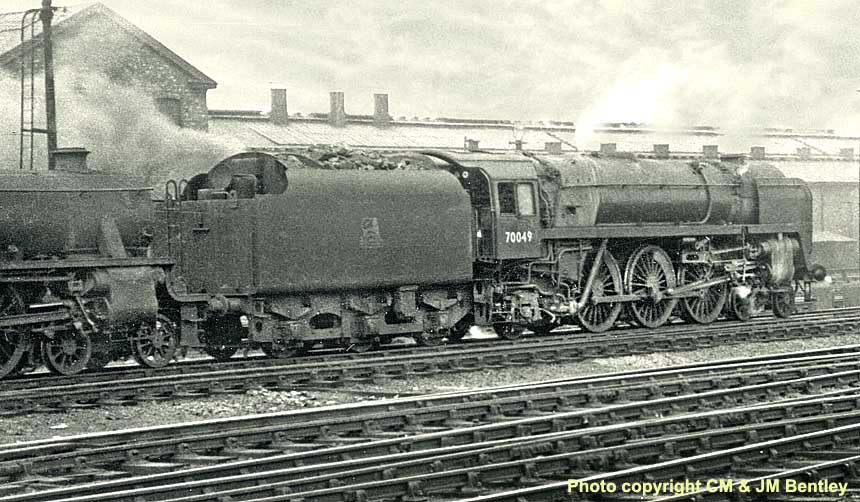
(Above-Below) This opportunistic picture by CM & JM Bentley captures the passage of Britannia 70049, as yet nameless, away from Crewe Station towards North Junction, coupled to a Class 5 4-6-0 and heading back to its home depot at Holyhead following remedial work at Crewe Works in September 1955. The Grand Junction Railway's original 1837 station at Crewe developed rapidly to become the LNWR's largest junction station, and one of the busiest in the country. (Below) Entering Chester General Station is 7MT Britannia 70049, still unnamed, at the head of the up 'Irish Mail' in May 1956; the ensemble is seen passing beneath the A56 road bridge at the North West end of this very busy station. A signal box was positioned just out of picture to the right, while on the left adjacent to the Great Western side of the station appears to be a 'Black Five' and a Stanier 2-6-4T awaiting their next duties.

MODIFICATIONS: The delays in starting the last build programme gave the Works the opportunity to apply the modifications that been found to be necessary during the service period of the other engines. These amounted to 5 items: item 17 - the hollow axles were 'plugged' and the wheel bearings seated correctly; item
 16 - the sand box lids were raised from new and were now three in number; item 8 - the reverser recuperating spring was contained from new; item 5 - the steady bracket was fitted to the forward rod and the rear one (item 7) of the regulator from new. With the larger and heavier BR1D tender there was no need for a cab sheet (item 9) or the tender steps (item 10) to be added, so that the first modification to be noted was the front step (item 1), which meant that the original small twin steps were discarded; but replaced with a large supported plate between the engine frames and this not only made the fitting of those rather heavy titled-train headboards easier, but also helped the crew to reach right the way into the smokebox for cleaning purposes. The step was altered at Crewe Works during March 1956, while the following year, the LNER return crank (item 15) was modified to the LMR version, as seen affixed with four studs instead of two cotter pins, and the new BR emblem (item 11) was applied to the sides of the tender. Because 70049 was always maintained at Crewe Works, the smoke deflectors (item 3) remained the same throughout, but the Automatic Warning System equipment (item 20) was fitted to the still nameless engine during March 1959, with the related pipework routed along the frame to reach the pick-up at the front of the locomotive. The Solway Firth nameplates were eventually fitted at Crewe Works during May 1960 and first seen, apparently, from 25th of the month, although the choice of name was a strange one, given that the engine had never worked in Scotland and would only have reached Carlisle rarely before late 1964. Also the nameplates were removed in 1965, which means that they were only fitted for little five years, and the lamp irons (item 2) were repositioned to prevent incidents with the overhead power lines. The nearside lubrication rod (item 18) was shortened in 1957 and seems to have remained that way right to withdrawal, yet the offside rod stayed in its original state all its career; which was most unusual.
16 - the sand box lids were raised from new and were now three in number; item 8 - the reverser recuperating spring was contained from new; item 5 - the steady bracket was fitted to the forward rod and the rear one (item 7) of the regulator from new. With the larger and heavier BR1D tender there was no need for a cab sheet (item 9) or the tender steps (item 10) to be added, so that the first modification to be noted was the front step (item 1), which meant that the original small twin steps were discarded; but replaced with a large supported plate between the engine frames and this not only made the fitting of those rather heavy titled-train headboards easier, but also helped the crew to reach right the way into the smokebox for cleaning purposes. The step was altered at Crewe Works during March 1956, while the following year, the LNER return crank (item 15) was modified to the LMR version, as seen affixed with four studs instead of two cotter pins, and the new BR emblem (item 11) was applied to the sides of the tender. Because 70049 was always maintained at Crewe Works, the smoke deflectors (item 3) remained the same throughout, but the Automatic Warning System equipment (item 20) was fitted to the still nameless engine during March 1959, with the related pipework routed along the frame to reach the pick-up at the front of the locomotive. The Solway Firth nameplates were eventually fitted at Crewe Works during May 1960 and first seen, apparently, from 25th of the month, although the choice of name was a strange one, given that the engine had never worked in Scotland and would only have reached Carlisle rarely before late 1964. Also the nameplates were removed in 1965, which means that they were only fitted for little five years, and the lamp irons (item 2) were repositioned to prevent incidents with the overhead power lines. The nearside lubrication rod (item 18) was shortened in 1957 and seems to have remained that way right to withdrawal, yet the offside rod stayed in its original state all its career; which was most unusual.
(Above-Below) This lovely sharp image from SV Blencowe shows a smartly turned out 7MT Britannia 70049 Solway Firth easing through the Station at Quainton Road, situated just five miles west of Aylesbury in Buckinghamshire. The date is Thursday 30th August 1962, just a month after the locomotive was transferred to Annesley depot (16D); 70049 was reallocated following closure of its previous shed at Neasden. For the record, Quainton Road station was once part of the Metropolitan Railway and Great Central route into London, but after closure in 1966 it became the centre for the Buckinghamshire Railway in 1971. (Below) This is a lovely action shot by the redoubtable Keith Long (aka Flickr 'Cabsaab900') and shows Britannia Pacific 70049 Solway Firth leaning to the curve at Hest Bank as it speeds northwards with a Glasgow express in the summer of 1960. The locomotive was then based at Newton Heath depot in Manchester, and had only just been graced with its nameplates, however 70049 looks in a very work-worn condition. This stretch of the WCML alongside Morecambe Bay is the only section that is in fact coastal; the train is passing beneath the main A5105 road bridge beyond the footbridge, named as Marine Drive.
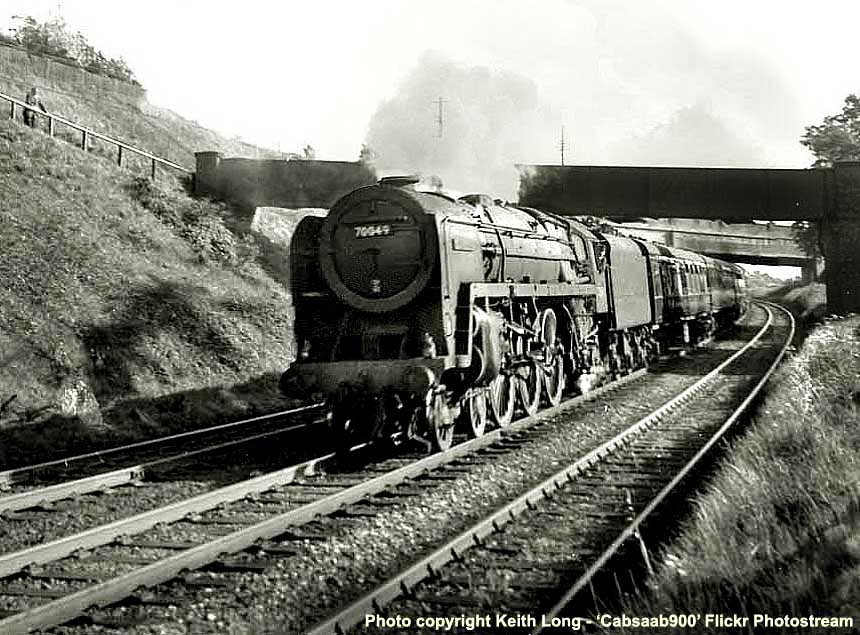
SERVICE RECORD: 70049 began in service from Holyhead MPD because it was coupled to one of the larger BR1D tenders which could hold nine tons of coal and 4,725 gallons of water and fitted with a steam
 operated coal-pusher. This was thought to be the minimum requirement after some failures by 70030-33 hauling the Irish Mail from Holyhead to London and running out of coal. Thus the small stud of five Britannias were used on both the day and nightime Irish Boat Trains that linked Dublin and London Euston, but it is recorded that 70049 failed on the 'Irish Mail' on the 23rd October 1954, though no details are available. The recorded annual mileages were quite good in the early years of service when running from Holyhead depot, but thereafter dwindled as the locomotive moved around so very much. Highest mileage noted was during 1958 with a figure of 69,000, then an average of 63,000 miles over the years 1955, 1956 and 1959, after which a figure of 30,000 was averaged. Fourteen visits to Crewe Works were recorded and just one other Works visit shown to be St. Rollox in 1961, when the engine was allocated to Newton Heath depot. As with many other Britannias maintained throughout by Crewe, the smoke deflectors (item 3) remained unchanged as the management did not see any reason to alter the original design.
operated coal-pusher. This was thought to be the minimum requirement after some failures by 70030-33 hauling the Irish Mail from Holyhead to London and running out of coal. Thus the small stud of five Britannias were used on both the day and nightime Irish Boat Trains that linked Dublin and London Euston, but it is recorded that 70049 failed on the 'Irish Mail' on the 23rd October 1954, though no details are available. The recorded annual mileages were quite good in the early years of service when running from Holyhead depot, but thereafter dwindled as the locomotive moved around so very much. Highest mileage noted was during 1958 with a figure of 69,000, then an average of 63,000 miles over the years 1955, 1956 and 1959, after which a figure of 30,000 was averaged. Fourteen visits to Crewe Works were recorded and just one other Works visit shown to be St. Rollox in 1961, when the engine was allocated to Newton Heath depot. As with many other Britannias maintained throughout by Crewe, the smoke deflectors (item 3) remained unchanged as the management did not see any reason to alter the original design.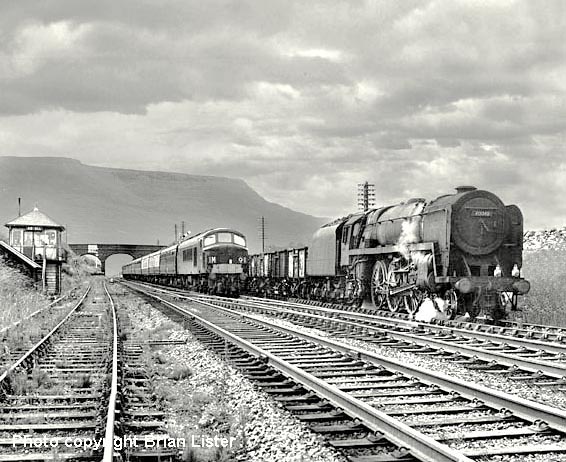
(Above-Below) Brian Lister has captured a down-at-heel Britannia Pacific 70049, formerly Solway Firth, waiting in the 'up' loop at Ais Gill summit for the passage of a southbound express headed by a 'Peak' Type 4 class, one of the new breed of express passenger engines. The bridge in the distance marks the border of North Yorkshire and Cumbria (what used to be Westmorland) and following closure of the signal box the structure was moved to the Midland Railway Centre at Butterley for restoration. Dated July 1967, the locomotive is just thirteen years old and had no chance of reaching fourteen, although it did see service to the end of steam. (Below) Another image from the aspiring Brian Lister who set about the task of capturing the last throes of the Pacific locomotives in this country before virtual extinction took place...the results of his search can be found in a superb book, 'In Pursuit of the Last Pacifics published in 1999 by Rail Art Publications. Here we see Britannia 4-6-2 70049 on a typical duty for the period: coal empties returning home across the remote expanse of Blea Moor towards Ribblehead Viaduct; the steam cocks have been opened to scare sheep which had strayed onto the line. Behind the train is a short goods train approaching Blea Moor signal box (1941) and the accompanying water tank (original to the Settle & Carlisle line).

SIGHTINGS: First sighting of 70049 was at Crewe North depot, seen in sparkling condition, after some running in duties before delivery to Holyhead MPD, and it was noted that the speedometer (item 13) had indeed been fitted from new. When sighted at Chester in August 1955, having just passed the Racecourse, 70049 was seen hauling an express for London and noted as in reasonable condition, but showing signs of recent hard work and not having troubled the cleaners for a while. Later, in August 1958, the engine was seen on Holyhead depot ready to haul the daytime 'Irish Mail' up to London and pictured in quite clean condition on this occasion. Hauling a Liverpool to Edinburgh express, a now named 70049 was pictured powerfully breasting Beattock summit with at least thirteen coaches in tow, but was espied in extremely dirty condition, no doubt disguising the blue-backed nameplates, quite recently fitted. 70049 Solway Firth probably did not see a cleaner's cloth after the fitting of its nameplates in 1960, and so it was when viewed at the former Grand Central Railway shed at Neasden, in North-West London, the locomotive was very grubby with only a little of the green paintwork showing through the grime. The engine was shopped at Crewe just weeks before this sighting, so the condition of the engine shows how quickly the exterior had deteriorated, but was seen in good condition again at Worsley near Manchester hauling an express from Liverpool to Manchester Victoria Station, in the summer of 1962. 70049 was seen at rest in Patricroft MPD late in 1963, and was noted in reasonable condition, while the lamp irons had now been repositioned for reasons of safety. The nameplates and smokebox numberplate were removed in 1965 and thereafter was seen with a false plate on the front, as seen at Barrow in Furness at the head of a Sleeping-Car train from London Euston in August 1967.
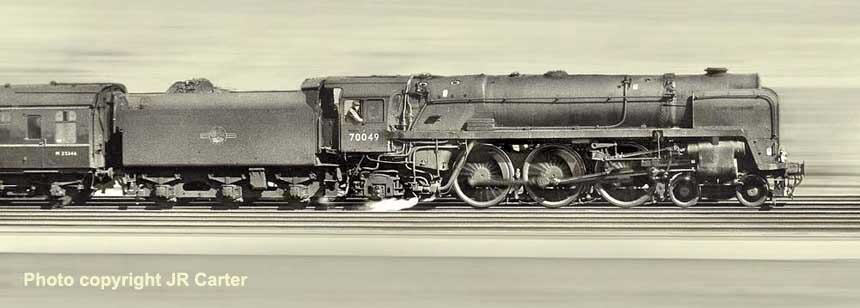
DISPOSAL: After being withdrawn from service, 70049 was stored at Carlisle Kingmoor until the end of February 1968, then transferred to J.McWilliams of Shettleston, a suburb just over three miles to the east of Glasgow city centre, where it was cut up in March 1968. The company was responsible for the disposal of over 40% of the Britannia class. (still under construction)

(Above) A nameplate measuring 44¾" long, the front repainted, from the BR Standard Class 7 Britannia 4-6-2 No 70049 Solway Firth, went under the hammer for £12,500 at a Great Central Railwayana auction in July 2013. Allocated new to Holyhead on 28 July 1954, 70049 was named week ending 28 May 1960, thus it had the distinction of being the last steam engine named by BR. 70049's final three years were spent in Carlisle at both Upperby and Kingmoor, being withdrawn from Kingmoor in December 1967. It was cut up by JMcWilliams at Shettleston in March 1968.
1953 Programme authorised 29th November 1951, built at Crewe Works and completed on 4th August 1954, to Order No E486/234 costing £25,331. Withdrawal Saturday 6th August 1966 from Carlisle Kingmoor.
ALLOCATIONS: 70050 was the first Britannia allocated to that 'Holy Grail' of shed allocations at Glasgow Polmadie MPD (66A), where it remained until relocation to Corkerhill depot (67A) in April 1962, but for only for a six month period; 70050 moved to Crewe North MPD (5A) at the end of October 1962. When (5A) closed to steam in June 1965 the engine moved to Crewe South depot (5B), but was soon relocated to Banbury in October 1965 joining seven other Britannias 70045-47 and 70051-54 there. The ex-GWR Banbury depot (84C) was transferred from the WR to the LMR in September 1963 and recoded 2D. 70050's stay at Banbury was short-lived as it soon joined another 24 Britannia engines at Carlisle Kingmoor MPD (12A) for a period of six months leading to ultimate extinction.
(Below) On a rather smoky August morning in 1956, 7MT 'Britannia' 70050 Firth of Clyde is spotted by cameraman Rod Blencowe at Polmadie MPD, in Glasgow, in the company of a Standard Class '5' 4-6-0. The Class 7MT engine was one of 19 Pacifics on the strength at this date; with nine Coronation Class locomotives, five Britannias and also five Clan Class '6' engines being the mainstay of the 160-strong stock at 66A. The two year-old engine already looks to be in poor external condition, with no apparent cleaning being done in between Works visits.
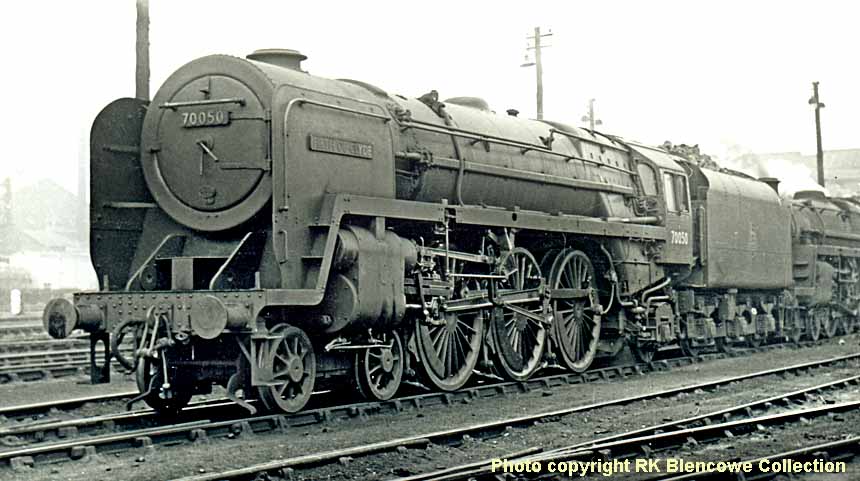
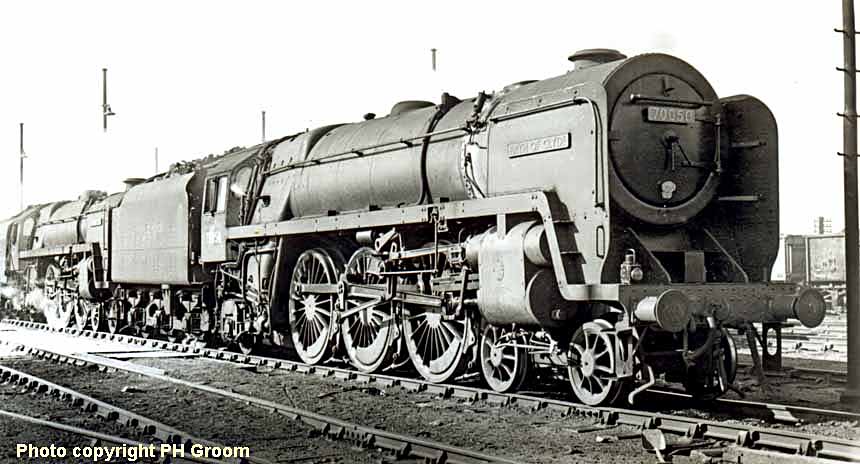
(Above-Below) A nicely posed picture of BR Standard 4-6-2 70050 Firth of Clyde by Peter Groom showing the engine at Polmadie depot (66A) in the company of one of the five resident Clan Class '6' locomotives, late in August 1957. The rather grubby engine is by now three years old, but shows little difference from new; though a front step has been fitted, albeit this was rarely used in respect of fitting headboards, but it would have helped the crew to reach into the smokebox for cleaning purposes. (Below) A smokebox numberplate, 70050, from the BR Standard Class 7 'Britannia' 4-6-2 Firth of Clyde went under the hammer at a UK Railwayana Auction in January 2014. Allocated new to 66A Polmadie and named 'Firth of Clyde' in March 1962, the locomotive moved to 67A Corkerhill, 5A Crewe North, 2D Banbury and finally 12A Carlisle Kingmoor from where it was withdrawn and stored in August 1966 after a working life of only twelve years. It was cut up at GH Campbell, Airdrie, in December 1966. The front of the plate has been repainted, though the back is in original condition. Click HERE to visit the UK Railwayana Auction's website.

MODIFICATIONS: 70050 was only modified on a minor scale when compared to other classmates, as the final batch were built with modified axles (item 17); with speedometer (item 13) added; also both the support brackets (items 5 & 7) for the regulator rodding in place, as well as having plain coupling rods (item 14) from first to last, leaving 8 items that were altered in service. Also being fitted with a BR1D tender eliminated the need for the flexible cab sheets (item 9) and the tender step (item 10) was not needed either. First seen modification was the full specification front step (item 1) which was fitted at Crewe Works during its first Light Casual repair in February 1956. At the same visit an early problem with the Doncaster designed LNER return crank (item 15) was detected and the LMR types were duly fitted. The next Works visit for 70050, in April 1957, revealed no visual changes although safety links were added between the engine and tender at this time, following concerns over the dependency on the security of the one original towing pin. Because 70050 was only maintained and repaired at Crewe Works, the smoke deflectors (item 3) saw no alterations at all throughout its rather short service life and after another visit to Crewe in April 1959, the only notable change was the addition of the BR emblem (item 11) on the sides of the BR1D tender. Although the fitment of the British Railways Automatic Warning System was recommended in the wake of the Polesworth crash in 1952, many express engines were not so equipped, including 14 Britannias. But 70050 did receive the safety equipment at Crewe Works in May 1961, along with the power warning plates (item 19). In what was destined to be the last and final visit to Crewe Works, 70050 was subject to a full repaint in September 1963 with full lining to the Brunswick Green livery (item 12) and seemingly kept that lining right through to withdrawal.
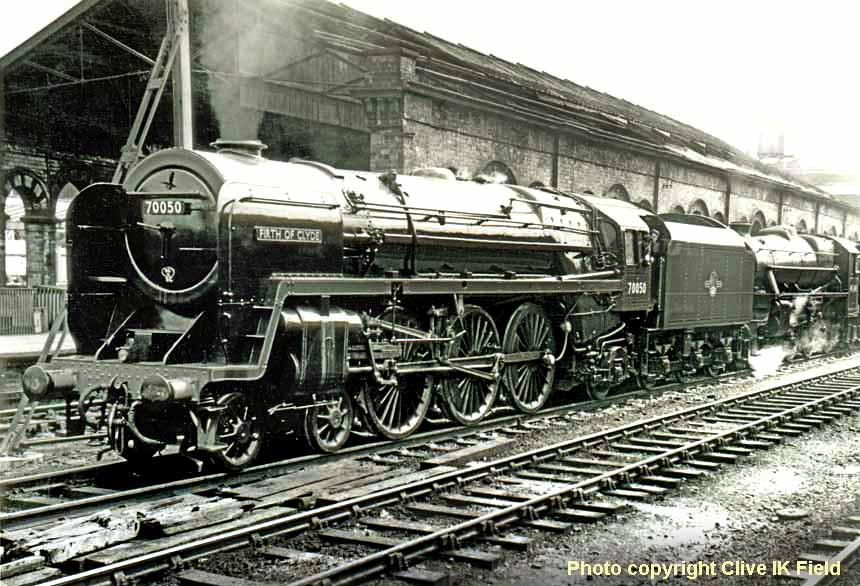
(Above-Below) No better sight to a spotter than a pristine engine fresh from the Works, painted to perfection, varnished with at least two coats to protect that carefully applied finish, be it Brunswick Green or standard Black. A steady stream of engines could be viewed at Crewe or any of the other main centres, such as Swindon or Doncaster. A beautifully turned out 'Britannia' No. 70050 Firth of Clyde, now with new BR emblem, heads for Crewe South depot in the company of Black '5' No 45242, an Edge Hill (8A) favourite, as captured by Clive IK Field in May 1959. (Below) Later in 1959, CM & JM Bentley recorded this scene at Crewe Station for posterity, showing BR Standard 'Britannia' 70050 Firth of Clyde waiting for the signal to start its journey northwards and back to its home base at Polmadie (66A). Crewe North MPD was home to 19 Pacifics throughout most of 1959, but no 'Britannia' engines until 70048 appeared in the first week of November and only then for a short stay, although 34 of the class did return to Crewe, mainly from May 1965.
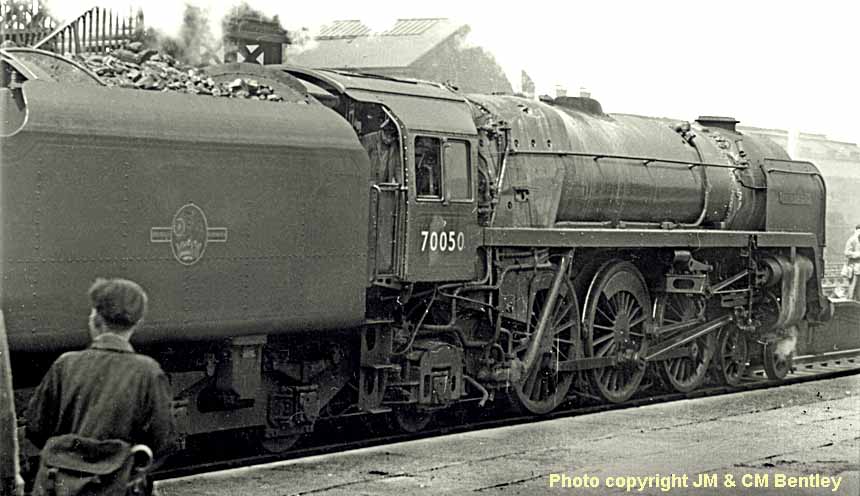
SERVICE RECORD: Construction of the final batch of the Britannia Class Nos 70045-54 was badly delayed due to a shortage of steel which followed on from World War 2, but that does not explain the mere 12 years in service of 70050 Firth of Clyde. The engine was not named until 19 January 1955 apparently because of a lack of suitable names and 'North Stafford' was initially nominated, but the six 'Firths' were settled upon and 70050 was selected as 'Firth of Forth' and the nameplates fitted at St. Rollox Works. The choice of Glasgow Polmadie depot for allocation of the Britannias did little to enhance their reputation; this had been established by their feats in East Anglia and in South Wales, but the five engines were utilised as replacements for the 'Clans' on the heavy Glasgow to Manchester and Liverpool express trains and were also regular performers on Glasgow to Birmingham New Street trains. That said the opportunities to carry any titled-train headboard were few and far between; Britannias were rarely seen on the 'Royal Scot' and only for a short time at Holyhead did 70050 have the chance to haul the 'Irish Mail'. Recorded mileages for 70050 Firth of Clyde were of a good average, but there was not the intensity of a busy timetable that was found in other areas; over the six years from 1955 to 1960 inclusive, an average of 50,100 miles was maintained, with a maximum of 57,000 credited in 1955. Apart from the one short trip to St. Rollox Works all others were to Crewe Works where five visits were recorded. The early demise of 70050 is not recorded, but it was seen at Carlisle Kingmoor depot with the nearside piston removed, no parts lying nearby and the engine had the look of abandonment about it; the poor condition of 70050 was clear evidence of the strict economies of that period when the locomotive was deemed only fit for scrap.
(Below) From the extensive Rod Blencowe Negative Archive, we find this image of 'Britannia' 70050 Firth of Clyde at rest at Carlisle Kingmoor MPD, still showing a (66A) shedplate in March 1961 and although the speedometer was fitted from new, the engine has not yet received the AWS equipment, which offered automatic brake application in certain situations. The locomotive is seen with a snowplough close by and a Coronation Class 'Duchess' behind, which must have been in service although missing some relevant parts from the front of the cylinder.
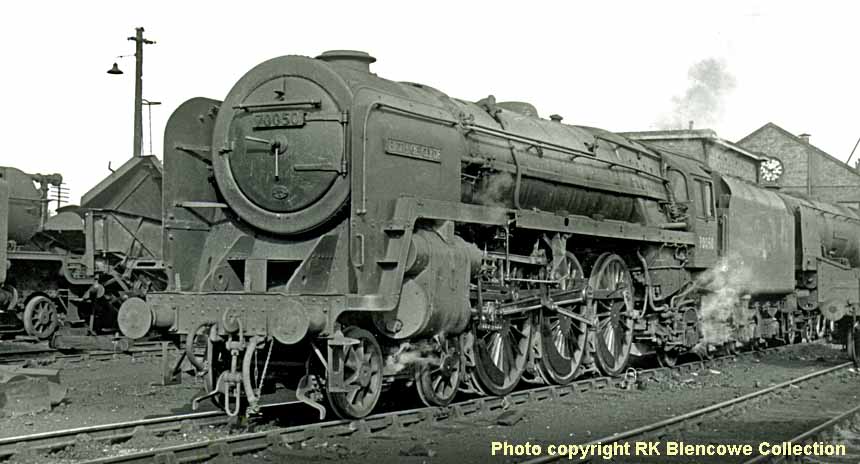
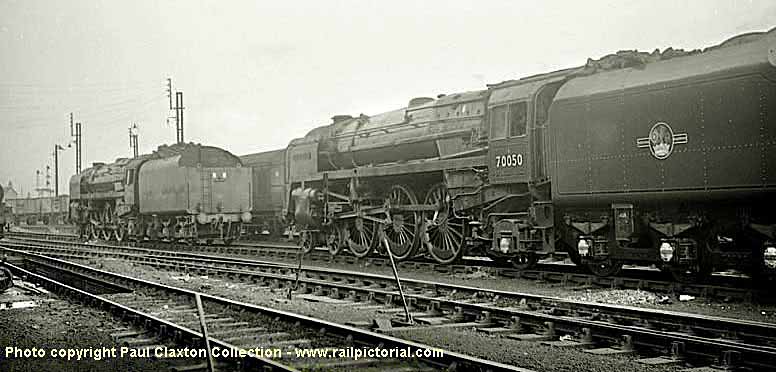
(Above-Below) The former Lancashire and Yorkshire Railway shed at Blackpool Central was the scene of this capture by Paul Claxton, displaying BR Standard Pacific 70050 Firth of Clyde at rest in the yard, just opposite Bloomfield Road Football ground. The locomotive had recently received a Works overhaul and looked to be in very good order along with classmate 70054 'Dornoch Firth', both bringing special trains to Blackpool, a favourite holiday destination in the North West; indeed the station's fourteen platforms were used to capacity throughout the summer season and well into October for visitors to the Illuminations. Both photos are reproduced courtesy of Mike Claxton, who has created a lovely website 'Rail Pictorial' in memory of his younger brother, Paul, who sadly passed away in April 2009. Mike's commitment is a credit to him; the photographic quality is quite superb and a visit HERE is highly recommended. (Below) Yet another first-class photo by ace cameraman Paul Claxton of BR Standard 'Britannia' 70050 Firth of Clyde, this time breasting the 1 in 98 climb of Lancaster Bank south of Lancaster Castle station, with an the IM23 Edinburgh to Birmingham train in May 1964. The engine is seen in the usual early 1960's condition; paintwork hidden by layers of grime and soot, stained, battered and bent, with the offside front badly twisted and a damaged handrail on the smoke deflector. The strongly reinforced wall to the right of the picture was built to protect the Roman Fort, dating back to 34 AD.

SIGHTINGS: Initial view of 70050 was at Carlisle Citadel Station awaiting its train before returning north to Glasgow; the nameless, but pristine engine was seen in the middle road with express headlamps already in their relative positions. Having received its nameplates early in 1955, 70050 Firth of Clyde was pictured leaving Carlisle Station hauling a 14-coach express for Manchester and Liverpool in May 1956; the locomotive was in beautiful external condition following a recent visit to Crewe Works when the engine was fitted with a front footstep to aid crewmen with the fitting of heavy titled train headboards. During 1957 the engine was observed double-heading with Fowler 4-4-0 40694 on a southbound train for the run up to Shap; both locomotives were working hard at Clifton on the lower slopes of the seven mile 1 in 125 climb, hauling what must have been an overloaded train from Glasgow Central for Manchester and Liverpool. In a beautifully posed photograph, 70050 was pictured at the wonderfully evocative Glasgow Central station awaiting departure with the 4.30pm to Manchester and Liverpool train in May 1961; it was noticed that the AWS equipment was now fitted, plus the power warning plates were also applied to warn crews of the overhead wires now present in some areas. It was also noticeable that the offside smoke deflector handrail was bent; this was a common occurrence due to the handrails being used to support the heavy piston when shed staff were changing the piston compression rings. In July 1962, the work-stained engine was pictured beneath the huge concrete coaling tower at Leeds Holbeck depot sporting an excursion headcode, but no shedcode, which should have been 67A for Corkerhill (Glasgow). A pristine 70050 was recorded at Crewe Works in September 1963 fitted with a 5A shedcode as the engine was allocated to Crewe North from January 1963 and at this late stage, the lining was particularly well applied including red lining on the cylinder casing. But, of course, the polished look did not last long and in August 1964 a very grime-encrusted engine was observed heading through Conway Castle station with an 'up' relief to the Irish Mail.
DISPOSAL: Withdrawal took place on Saturday 6th August 1966 from Carlisle Kingmoor. The engine was stored until November 1966 then transferred to G H Campbell of Airdrie for cutting up.
Programme authorised 29th November 1951, built at Crewe Works and completed on 11th August 1954, to Order No E486/234 costing £25,331. Withdrawal came on Saturday 14th January 1967 from Carlisle Kingmoor.
ALLOCATIONS: 70051 was the second Britannia to be allocated to the major Scottish depot at Polmadie MPD (66A). The first was classmate No 70050 - in fact, the allocations of both engines were exactly traced, the only difference between them is that 70050 retired first. 70051 moved west from Glasgow centre to Corkerhill depot (67A) in April 1962 for a period of 6 months, before heading south to Crewe North (5A) for 6 weeks only; it was then relocated to Holyhead depot (6J) in December 1962. By May 1965 a move to Crewe South shed (5B) beckoned; (5A) had just closed to steam; this was followed by 70051's transfer to Banbury (2D) in September 1965 and Carlisle Kingmoor (12A) in January 1966, its final destination.
(Below) The arrival of the Britannia Pacifics at Polmadie MPD (66A) from 1954 must have brought inevitable comparisons with the shed's allocation of nine 'Princess Coronation' class Locomotives, particularly as both classes were called upon to haul like-for-like trains. With its larger 9 ton coal space, the BR1D curved-sided tenders created the overall illusion of a larger-looking locomotive compared to the earlier engines (Nos 70000-70044 in the fleet) which were coupled to BR1 tenders with inset sides. Barely six-months old, Polmadie's 70051 'Firth of Forth' awaits its next turn of duty in the shed yard on a misty February morning in 1955.


(Above-Below) There was always a chance of bagging a prized 'cop' when an engine made a rare appearance a long way from its home shed; this is the case here as Britannia Pacific 70051 'Firth of Forth' heads north through Watford Junction in July 1960. The engine looks in fine condition and shows little visual change from new, except for the step and BR logo, but the speedometer unit is missing at this time. (Below) This excellent image from Keith Long's Flickr photostream reflects a presentable BR Britannia No 70051 'Firth of Forth' at Carnforth Motive Power Depot (24L) in May 1960. Carnforth's original 1874 Midland Railway roundhouse was replaced by a straight shed in December 1944; the new shed came about as a result of the Government's 1942 initiative to aid the War effort in the area and the original MR site was sold to a private buyer. The six-track shed remained in use by BR until August 1968, after which the building was utilised by a preservation group and the name Steamtown applied to the site.
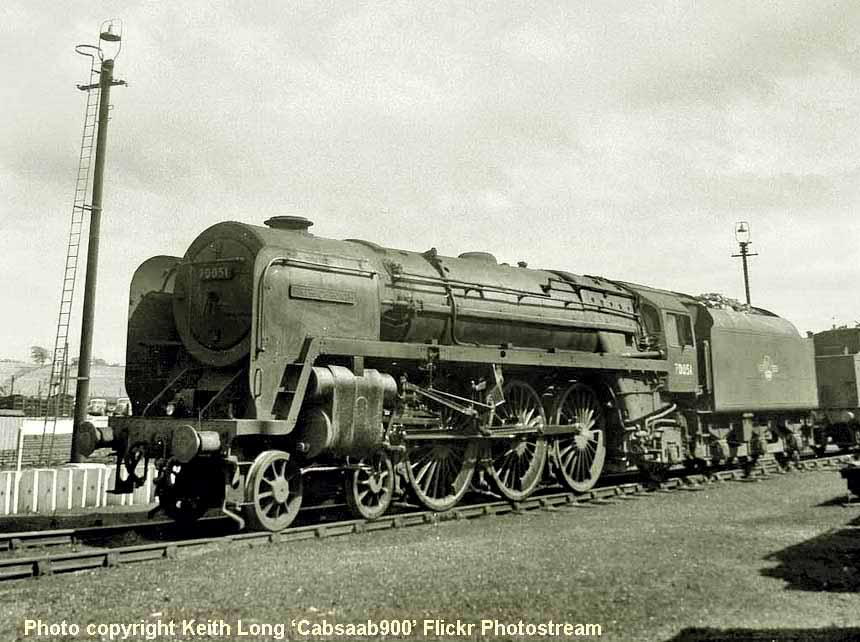
MODIFICATIONS: 70051 'Firth of Forth' had its nameplates fitted at St Rollox Works in January 1955. No 70051 was the seventh engine to be built in the final batch Nos 70045-70054, by which time twelve of the twenty one modifications had been incorporated into the construction program, therefore no changes were deemed necessary until June 1956 when the front step (item 1) was modified at Crewe Works; indeed the locomotive came under the regime of Crewe Works throughout its entire service life, therefore the smoke deflectors (item 3) were never changed; Crewe believed the removal of handrails was not required despite what 'Swindon' was saying. Two years later in April 1958, 70051 received major repairs at Crewe Works, including a boiler change and appeared later in May with the new corporate logo (item 11) applied and the original LNER return crank (item 15) modified to the LMR version. The speedometer (item 13) was fitted from new in August 1954, but this was missing during 1959 and 1960, presumably awaiting spares before reappearing later. It seems strange that some Britannias were fitted with speed recording equipment for the whole of their service, the majority (33) had only 6 years of usage and yet 12 engines never had the unit fitted at all. The power warning plates (item 19) were applied during 1961, reminding crews of the dangers of working in areas equipped with overhead wires. Also during the early part of 1964 the offside BR emblem (item 11) still had the lion facing the wrong way as ruled by strict Heraldic rules maintaining that the rampant lion must always face to the left. The AWS equipment (item 20) was eventually fitted after a further visit to Crewe Works during the early part of 1963, while the lamp irons were moved in August 1964 and the nameplates were taken off for safe keeping the following year.
(Below) From the river flats of the lower Annan valley, northbound trains on the WCML are faced with the long climb of Beattock bank to the high watershed of the Annan and Clyde rivers. Dropping off the bottom of Beattock bank amidst pleasant countryside, BR Class 7MT No 70051 Firth of Forth slows for its stop at Beattock on 31 May 1961; the ex-Caledonian lower quadrant signal on the right controlled the 2 mile-long single-line branch from Moffat trailing in from the east. The branch lost its passenger service in 1954 and finally closed to freight in 1964.
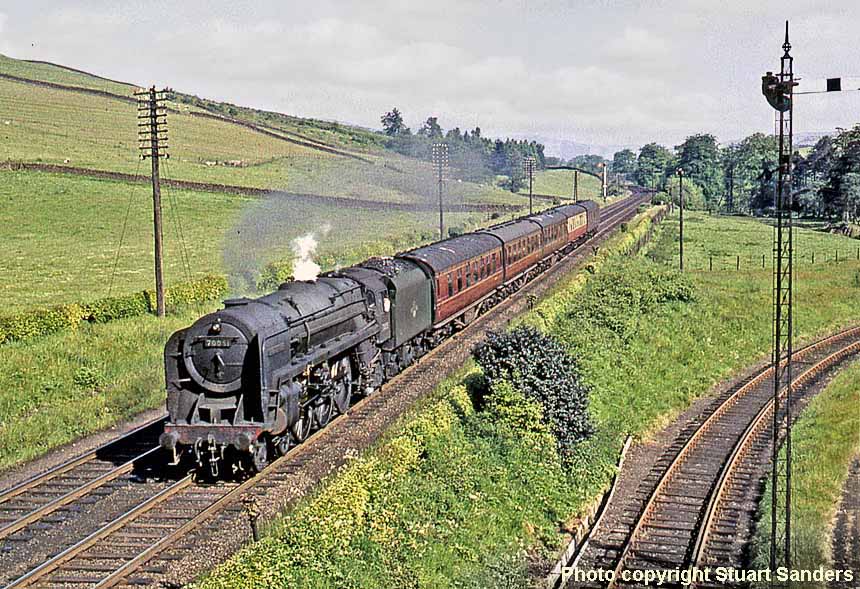

(Above-Below) This low level shot of Crewe North's Britannia 7MT No 70051 'Firth of Forth' at Camden MPD shows off the Pacific's huge proportions to good effect; the viewpoint is looking south towards the footbridge at the bottom of the yard where a Princess Coronation Class engine is waiting to be coaled. Only four Britannias were ever allocated to Camden (1B). Lurking in the background is English Electric Type 4 D329, introduced to traffic in January 1961, and one of many Type 4s ousting the Pacifics from the WCML's premier expresses. Shortly after this image was recorded the depot closed to steam in September 1963. (Below) Another fine image from the Rail Photoprints archive HERE is this carefully posed photograph by stalwart railway cameraman, Jim Carter, who, during his time in the footplate grade based at Patricroft depot (26F), regularly endeavoured to extract the best from the available light by using the ash plant to gain the required height to take photographs; here he brings off an excellent picture of BR Standard 70051 'Firth of Forth' on the turntable. No Pacifics were ever allocated to Patricroft, but many were resident in the Northwest and a large number called in to be serviced during the mid-1960s. The 1903-built eight track engine shed can be seen beyond the high wall, while the old ten track shed is to the right.
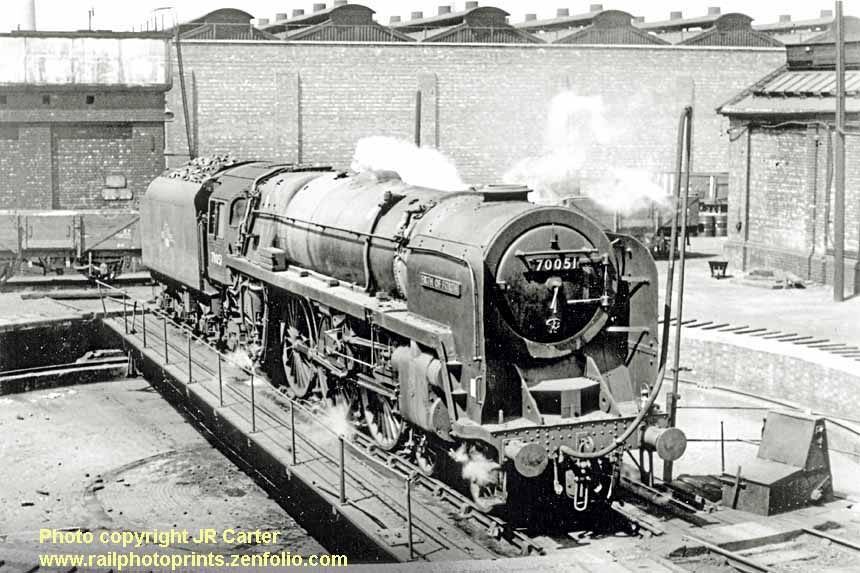
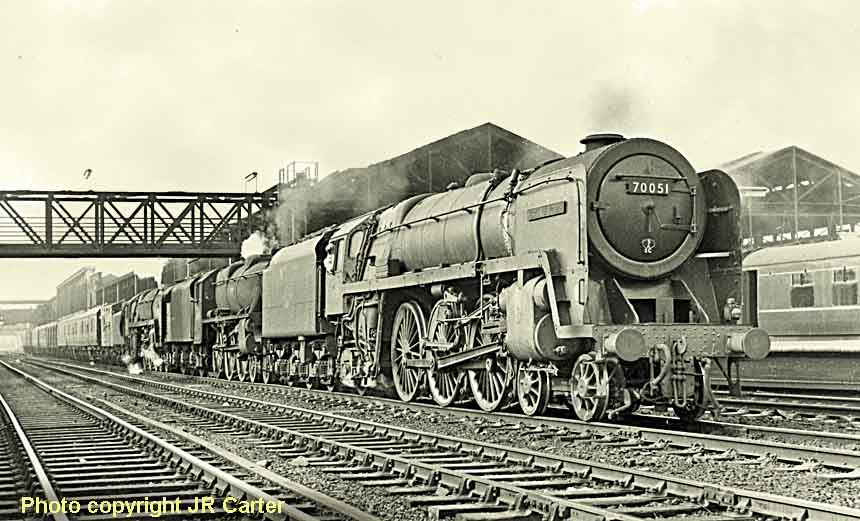
Above) This unique triple-header is a real eye-opener; an accumulative 88,855 lbs of available tractive effort on one train. Or is it? Well, in terms of hauling a parcels train through the centre lines at Chester General Station this is very unlikely; the most plausible answer is that the first two engines are being repositioned in readiness to haul other trains out of Chester and the lamp on 70051 Firth of Forth does show a light engine code. This scene was captured by Footplate Cameraman, Jim Carter, in September 1964. The platforms to the right served the Western Region lines to Birkenhead and Shrewsbury.
SERVICE RECORD: A tragic incident occurred at Winsford in Cheshire In June 1965 when Britannia 70051 Firth of Forth suffered a fatal 'blow-back'. Sadly the valiant driver, Mr Wally Oakes, lost his life after suffering 80% burns. Mister Oakes was posthumously awarded the George Cross Medal in recognition of his great courage in bringing his train to a safe and controlled stop. The circumstances of the blow-back came about because the shroud below the chimney came adrift and dropped onto the blastpipe below thus causing serious back pressure, not unknown, but a rare occurrence.
The choice of Glasgow Polmadie depot for the last five Britannias did little to advance the reputation of the class which had been established by Eastern Region crews on the GE section and the great efforts of the Cardiff Canton shed staff in South Wales. The five ScR Class 7MTs were utilised as replacements for the Class 6P5F 'Clans' on the heavy Glasgow to Manchester and Liverpool express trains; they also performed regularly on the Glasgow to Birmingham New Street trains. However there were few opportunities to carry any titled-train headboards as the Britannias were rarely seen on the 'Royal Scot' and only for a short time at Holyhead did 70051 have the chance to haul the 'Irish Mail'. Despite the absence of a busy timetable as found in other areas, the recorded mileages for 70051 Firth of Forth were of a good average; over the six years from 1955 to 1960 inclusive, an average of just below 50,000 miles was maintained, with a maximum of 59,500 recorded in 1955, but a rather poor return for 1956 brought the average down. Apart from the one visit to Cowlairs and two trips to St. Rollox Works all others were to Crewe Works where eleven visits were recorded.
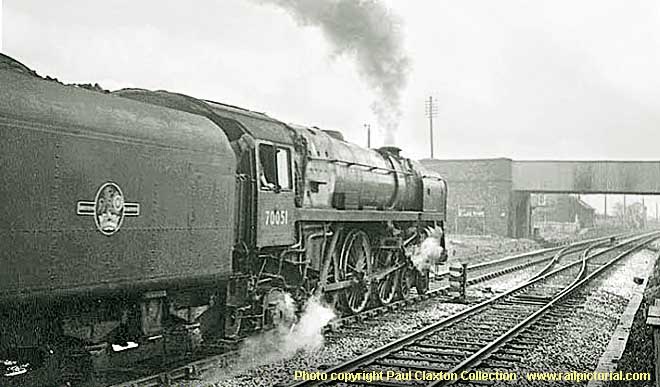
(Above-Below) This excellent capture of Britannia 70051 'Firth of Forth' shows the new Corporate Emblem was still being displayed in the wrong manner almost five years after the error was spotted; the incorrect application of transfers to the right-hand side of engines occurred on all the BR Regions. Heraldic Rules lay down that the 'Lion' must always face to the left, although logic might well say differently, but this was not realised until late in 1959. This photograph is reproduced courtesy of Mike Claxton, proprietor of the Rail Pictorial website HERE, a superb collection created by Mike in memory of his younger brother Paul, who sadly passed away in April, 2009. (Below) Another fine image from the Rail Pictorial website shows 70051 Firth of Forth heading an Aberdeen to Manchester express at Farington Curve Junction in July 1963. This section of the West Coast Main Line is situated between Preston and Warrington, where the junction provides a link to both Liverpool and Blackburn, and also a direct link to Lostock Hall depot (24C). Note the charabanc in the background, most likely with returning Blackpool day trippers en route to Manchester.
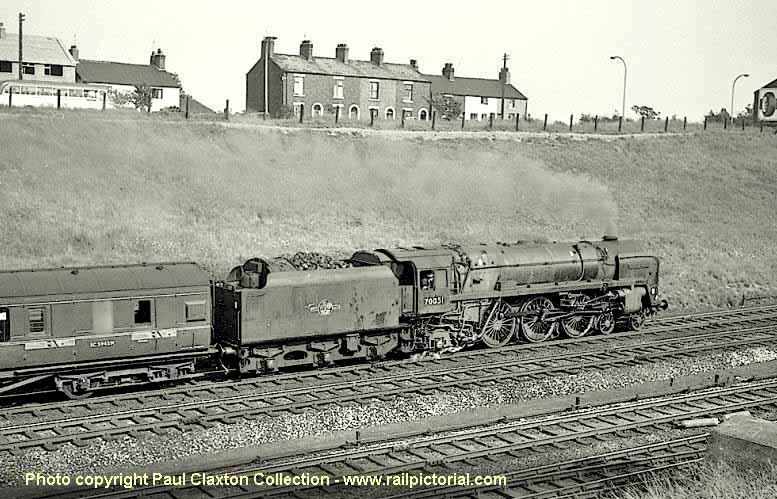
SIGHTINGS: Due to delays in selecting suitable names for the latest batch of Britannia engines, 70051 Firth of Forth was initially put into service unnamed; the plates were fitted when a smart-looking 70051 was observed being prepared for duty in the yard at Glasgow Polmadie MPD in March 1955. At Golborne on the West Coast Main Line, 70051 Firth of Forth was pictured powering a train for Birmingham towards Warrington and Crewe in August 1957, a typical duty for a Polmadie-based Britannia. The locomotive was still showing the original emblem; also the front step had been modified even though its use was limited to helping the crew to clean out the smokebox or affixing a named-train headboard. 70051 was photographed just north of Gretna Junction, close to Quintinshill signal box, hauling a 13-coach load towards Glasgow and although the locomotive looked well in control of its train, the crew would most probably have called for a banker engine for the arduous climb to Beattock Summit. The engine was normally seen between Manchester and Glasgow while based in Scotland, but on occasions it found itself south of Crewe working trains to London Euston during the early 1960s. In October 1961 the Britannia was in a shocking state when observed leaving Carlisle for the south; the front number plate was filthy, the cabside number was patently invisible and the company logo was hidden under many layers of grime. In addition to the grime the buffer beam was extremely shabby with much damage visible to the front-end fallplate and the front end cover was missing from the offside cylinder, a situation frowned upon by many shed foremen. And if that wasn't enough to contend with, steam was seen leaking from four different parts of the engine and the offside smoke deflector handrail was slightly damaged, giving an overall impression of a breakdown in maintenance procedures. But in better times a presentably clean engine was captured at Bangor Station in North Wales, with a very long parcels train, so long in fact that the signal man had to leave his post and call the engine forward to clear the crossover at the north end of the station. Also in 1963, a very clean 70051 Firth of Forth, now sporting a fully covered roof for the first time, was caught on camera in Tring Cutting heading a return FA Cup Final special following the game between Manchester United and Leicester City at Wembley Stadium. Finally the ex-Works engine was seen passing Warrington Dallam shed (8B) in fantastic condition during the early part of 1966, with the crew posing for all their worth!
DISPOSAL: Withdrawal took place on Saturday 16th December 1967 from Carlisle Kingmoor. The engine was stored until March 1968 then transferred to J.McWilliams of Shettleston, a suburb just over three miles to the east of Glasgow city centre, where it was cut up in March 1968. The company was responsible for the disposal of over 40% of the Britannia class.
Built at Crewe Works, completed on 21st August 1954. Withdrawal took place on 1st April 1967.
ALLOCATIONS: 70052 operated mostly in Scotland, serving Polmadie MPD (66A) from August 1954 to April 1962; then briefly at Corkerhill shed (67A) before being transferred to Crewe North MPD (5A) in October 1962. Next 70052 found employment at Crewe South shed (5B) between May and September 1965; this was followed by a move (along with seven other Britannias) to Banbury MPD (84C) (ex-GWR) now assigned to the Midland Division and recoded (2D), but this too was a short-lived exercise, as 70052 made its way in January 1966 to Carlisle Kingmoor shed (12A), where it saw out its rather short career.
(Below) On 5th February 1955, 70052 Firth of Tay is seen on a fill-in local trip at Slateford in Edinburgh. The Britannia is less than six months old, but already seems to be having steaming problems. Of note is the Caledonian semaphore route indicator on the front, showing what I think is an all-station local to Carstairs on the West Coast main line. Photograph from the archives of Rod Blencowe.
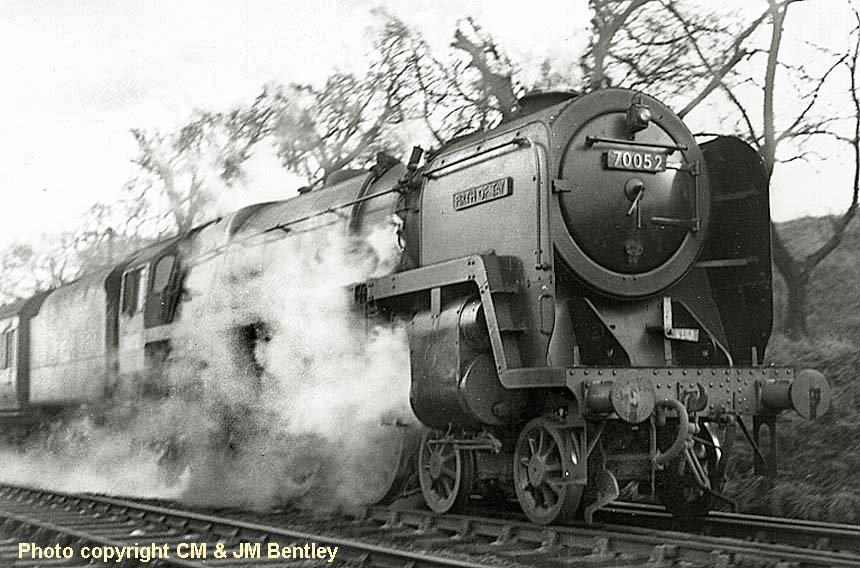
MODIFICATIONS: Because 70052 appeared much later in the build programme, the lessons learned from the early Britannias were utilised in the third group of engines, also some modifications were 'built in'. Thus the plain coupling rods (item 14) were fitted from new; the Axle repairs (item 17) were built into the construction; the regulator front rod and rear rod support brackets (items 5/7) were added from new; also the cab sheet (item 9) was not required with a BR1D tender, nor was the tender step (item 10).The larger BR1D tender was 5 tons and 7 cwt heavier than the original BR1 version; carried an extra 500 gallons of
 water and a further 2 tons of coal. The reverse rod return spring cover (item 8) was being fitted from No. 70025 onwards; 3 sand box lids (item 16) were being fitted to newly constructed engines, beginning with No. 70030. The third group of engines; 70045 to 70054 were fitted with a speedometer (item 13) from new, thus leaving us with eight modifications that were made in service; in May 1956, 70052 entered Crewe for its first major overhaul and was seen after with a modification to the front step (item 1) and the LNER Return Crank (item 15) changed to the LMSR version. Smoke deflector handrails (item 3) were not removed, not ever altered on 70052, and this reflects the fact that it was maintained by Crewe Works and they did not think that any change was required in any way. So the next modification seen was the new British Railways emblem (item 11) viewed on 21st March 1960 in conjunction with the power warning plates (item 19) which were also added at this time. In October 1961 70052 had a full repaint with lining and '7P' was added onto the cab sides, also the Automatic Warning System equipment (item 20) was added and it was noticeable that the pipework was fitted in the frame, which was very rare except for new engines.
water and a further 2 tons of coal. The reverse rod return spring cover (item 8) was being fitted from No. 70025 onwards; 3 sand box lids (item 16) were being fitted to newly constructed engines, beginning with No. 70030. The third group of engines; 70045 to 70054 were fitted with a speedometer (item 13) from new, thus leaving us with eight modifications that were made in service; in May 1956, 70052 entered Crewe for its first major overhaul and was seen after with a modification to the front step (item 1) and the LNER Return Crank (item 15) changed to the LMSR version. Smoke deflector handrails (item 3) were not removed, not ever altered on 70052, and this reflects the fact that it was maintained by Crewe Works and they did not think that any change was required in any way. So the next modification seen was the new British Railways emblem (item 11) viewed on 21st March 1960 in conjunction with the power warning plates (item 19) which were also added at this time. In October 1961 70052 had a full repaint with lining and '7P' was added onto the cab sides, also the Automatic Warning System equipment (item 20) was added and it was noticeable that the pipework was fitted in the frame, which was very rare except for new engines.(Below) Britannia Pacific 70052 Firth of Tay is seen at rest at Carlisle Kingmoor shed on 13th April 1957. Pictured in good clean condition, and now with a front step in position and the original LNER return crank replaced by a LMR version with the four stud fixing on the centre drive axle. Photograph from the excellent archives of Rod Blencowe.
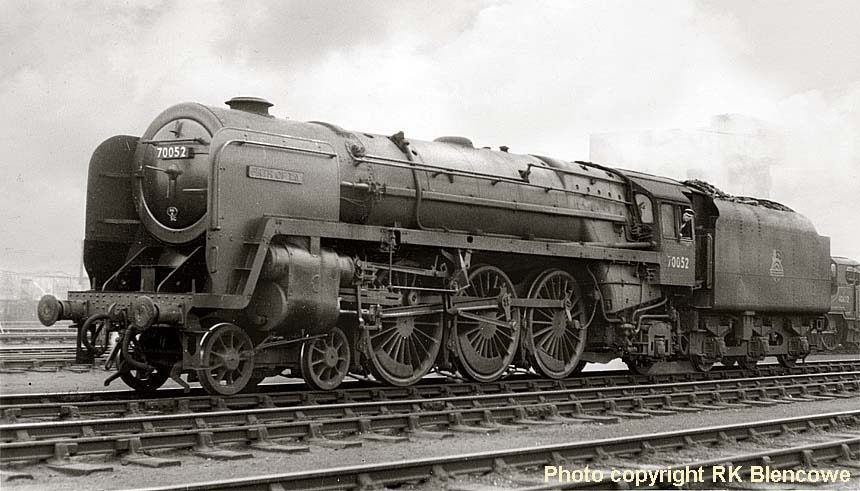
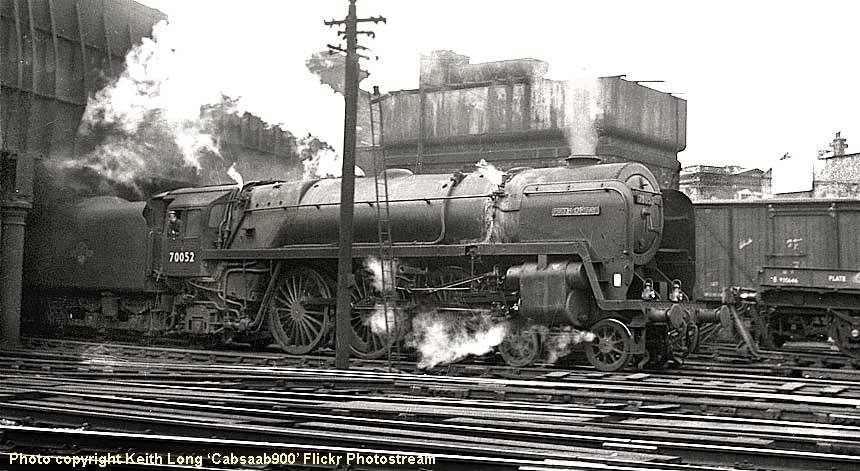
(Above) Rail Cameraman Keith Long took this shot of 70052 Firth of Tay departing from Manchester Victoria with empty coaching stock to Miles Plating after arriving with a train from Glasgow Central 4th June 1961. Check out Keith's page 60 with links to his excellent Flickr site.
SERVICE RECORD: When allocated to Polmadie, 70052 Firth of Tay was used almost exclusively on Glasgow to Manchester and Liverpool express trains, and was not required to work on other routes or trains, apart from occasional local trips from Glasgow and Edinburgh stations. 70052 became the second Britannia engine to be involved in a fatal accident when hauling a Glasgow St Enoch to London St Pancras sleeper train on the 20th January 1960; it was a stormy snowy evening when the train set out at 9.05 pm from Glasgow. The engine had been checked over by a fitter at Corkerhill shed and the driver did his normal checks, but a mechanical problem developed which only became worse as the journey progressed.
The driver stopped to investigate the noise at Garsdale station, but in the dark and armed with only a small torch he could not find any fault and carried on for another 25 miles to Hellifield station, where again he took time to find the source of the knocking noise, but to no avail. As the train moved on and passed Hellifield signal box, the signalman was obliged to comment on the 'knocking noise' that he could hear coming from the engine, but as the way forward was a down gradient the driver thought that steady
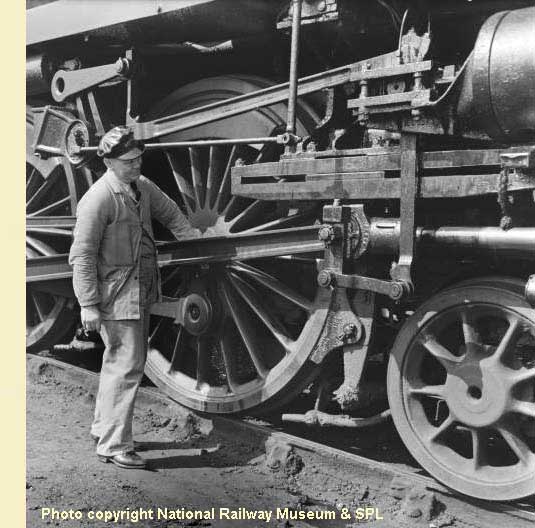 progress could be made, travelling at about 25 mph.
progress could be made, travelling at about 25 mph. However, the fireman passed a comment that the track ballast was being thrown up against the cab, which prompted the driver to make a full brake application, but just at that moment a freight train was passing on the climb up the gradient; the freight derailed and struck the sleeper train with fatal results. Five people lost their lives, with a further eight persons injured; the fatalities were all in the third coach of the train which was hit severely by the derailed engine.
The problem with 70052 was the offside slidebar assembly (see inset right) which carried the full weight of the piston crosshead and therefore also the connecting rod from the centre drive wheel. This had become insecure over a period of time and broke away causing the con-rod to drop into the track ballast and completely disrupt the security of the opposite track. The ensuing enquiry did not criticise the driver of 70052, but did point to the insecurity of the slidebar bolts and strongly recommended a better way should be found in order to ensure there was no repeat of this awful accident. Records do show that some engines were modified, but certainly not all Britannias were so treated.
(Below) David was reluctant to post this fuzzy Brownie 127 shot he took of a forlorn-looking 70052 at Crewe Works, but since it shows the loco awaiting repairs following the accident described above he conceded.
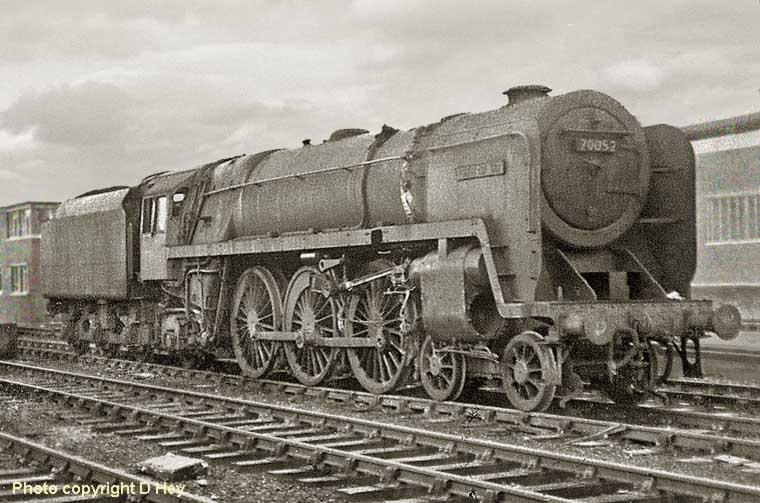
SIGHTINGS: Early views reflect the use of 70052 on Glasgow to Manchester trains; seen at Carstairs in August 1956, on such a trip and showing a new front step in position, but with the support inverted (wrong way round). Again seen at Carstairs station, this time in July 1958, 70052 was hauling an express to Perth, and again has the inverted support to the front step, suggesting that this was the case right the way through to 1960. On Friday 13th July 1962 'Firth of Tay' was pulling a Starlight Special which was the name given to a cheap fare train to London, on a day that was known as 'Glasgow Fair Friday'. 70052 was selected for a LCGB Special in April 1965, nominated as the 'Notts and Lincs' Railtour, and was seen at Nottingham Midland station, in pristine condition as befits a Railtour engine. Disposal was from Carlisle Kingmoor in October 1967, having been withdrawn on 1st April 1967, and was cut up at Campbells of Airdrie scrapyard, in November 1967.
(to be continued)
Programme authorised 29th November 1951, built at Crewe Works to Order E486/234 and completed on 3rd September 1954, costing £25,331. Withdrawn on 15th April 1967, the same day as 70040 and 70041, both being constructed eighteen months earlier in the second batch Nos 70025-70044. Indeed just as the second programme had been delayed, construction of the third and final batch of engines Nos 70045-70054 could not be started due to a shortage of steel.
ALLOCATIONS: 70053 was allocated initially to Glasgow Polmadie MPD (66A) and in the company of classmates 70050-52/54 was used on expresses to the South for the most part. After a little over four years the locomotive was reallocated to Leeds Holbeck shed (55A) along with 70054, working there for close on four years before being transferred to Crewe North depot (5A) in August 1962; rather surprisingly there were only other two other Britannias at 5A at that time. After a good stint of nearly two years at Crewe 70053 moved on to Holyhead depot (6J) in North Wales for twelve months before an ignominious move in June 1965 to the ex-Western Region shed at Wolverhampton Oxley shed, recoded from 84B to 2B on the London Midland Region. But 70053's stay lasted only four months before a move beckoned to Banbury depot, another ex-WR shed (recoded 84C to 2D in the Regional reshuffle). Again the allocation lasted a mere four months. The final act of this sorry tale was to end up at Carlisle Kingmoor MPD (12A) from February 1966 until withdrawal took place fourteen months later.
(Below) We are again indebted to Rod Blencowe's extensive negative archive for this beautiful shot of 7MT Britannia 70053 Moray Firth at the buffer stops on platform 1 at London Euston Station. Note both the chalked 5A lettering and shedcode plate on the smokebox door which indicates the engine had recently been allocated to Crewe North shed. The image gives an excellent view of the three sandbox lids on the boiler walkway, along with the large box containing the battery for the AWS equipment. Of note on the extreme right edge of the picture, is one of the many Austin A40 Farinas, a very popular vehicle in its day and over 340,000 were built from 1958.
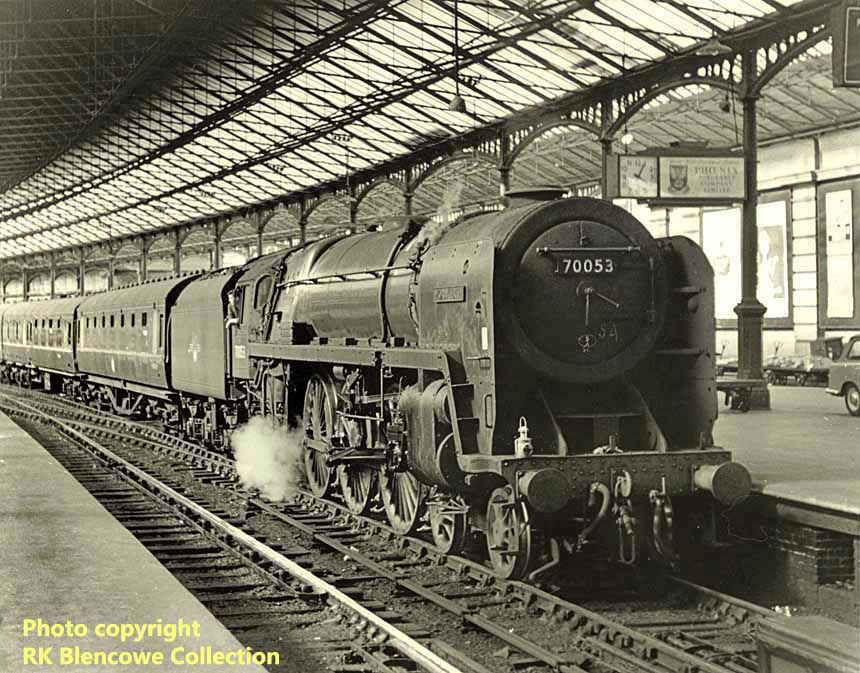
MODIFICATIONS: As the penultimate engine of the Britannias, 70053 Moray Firth was constructed with a large number of the modifications already added, leaving only nine items to be affected. The larger BR1D type tender fitted to the last ten engines, had no need for a tender step (item 10) nor a cab sheet (item 9); also a speedometer unit (item 13) was added in the building programme, in conjunction with the three sand boxes, which gave better results because the pipework was simplified and allowed for easier delivery to the drive wheels. The first notable change to 70053 was the original front step (item 1) being modified to a full specification platform type at Crewe Works during April 1956. On the next visit to Crewe, in November 1957, the locomotive had the LNER return crank (item 15) modified to the LMR type which was secured to centre drive wheel with four studs instead of the two cotter pins, which was a feature of the Doncaster design team.
The next overhaul for 70053, done almost two years later in early October 1959, was performed by Doncaster Works; this was because the engine was allocated to Leeds Holbeck at that time and resulted in the smoke deflectors (item 3) being modified to LMR 1 type, and the AWS equipment (item 20) was added, with pipework along the lower edge of the boiler walkway, but only visible as far as the lubrication pump; from there the pipe was set back to the engine frame and on to the front of the engine. The new BR emblem (item 11) was also added at the same visit, and it was quite noticeable that this was set higher on the BR1D tender than those seen on the more usual BR1 and BR1A with their inset coal bunkers, because the emblem was set centrally to the available space. The nearside lubrication operating rod (item 18) was shortened, as seen in 1958, to give more rate of lubrication than before, and this was still the same when seen in 1962. Power warning plates (item 19) were fitted between 1961 and 1962, and were out of the ordinary, as the only plate on the smoke deflector was set high, above the horizontal grab handle and the rearmost plate was positioned behind the grab rail, instead of the more usual site just above the rail. Furthermore after anther Crewe Works visit, a second power warning plate was added to the smoke deflector sheet, but below the original one and the plate on the side of the firebox was removed and reset to the usual position, which was above the rail.

(Above) A sleeping giant arouses at Carlisle Kingmoor MPD as Britannia 70053 Moray Firth is prepared for its next duty in May 1958. The engine was allocated to Glasgow Polmadie for just over four years, but it is doubtful that the locomotive ever ventured anywhere close to its namesake in the northeast of Scotland. This particular image shows a rather grimy, work-stained Pacific, captured by Rod Blencowe.
SERVICE RECORD: 70053 began in service unnamed, but entered St Rollox Works in Glasgow to have the nameplates fitted. The engine is recorded as never having a boiler change during its rather short service life, which is feasible, but at the same time somewhat dubious because of the time taken to completely overhaul a boiler of that size. The locomotive is recorded as entering St. Rollox Works twice, but only for minor issues, into Crewe Works three times and seen in Doncaster Workshops also on three occasions. 70053 Moray Firth was used on Royal Train duties on 3 July 1956, when the Royal party journeyed from Tarbolton in Mauchline to Ardrossan on the Ayrshire West Coast. The recorded annual mileages for 70053 were at best 58,000 miles, with an average of 50,000 over the first six years in service, then decreasing somewhat in the 1960's. The Britannias allocated to Scotland from 1954 were nominally called 'The Scottish Firths' and they were mostly used on expresses from Glasgow to Manchester/Liverpool and to Birmingham also, or even on rare occasions, 'The Royal Scot'. But after relocation to Leeds Holbeck, 70053 could be found as a regular performer on 'The Waverley' and 'Thames-Clyde Express' between Glasgow and Leeds.
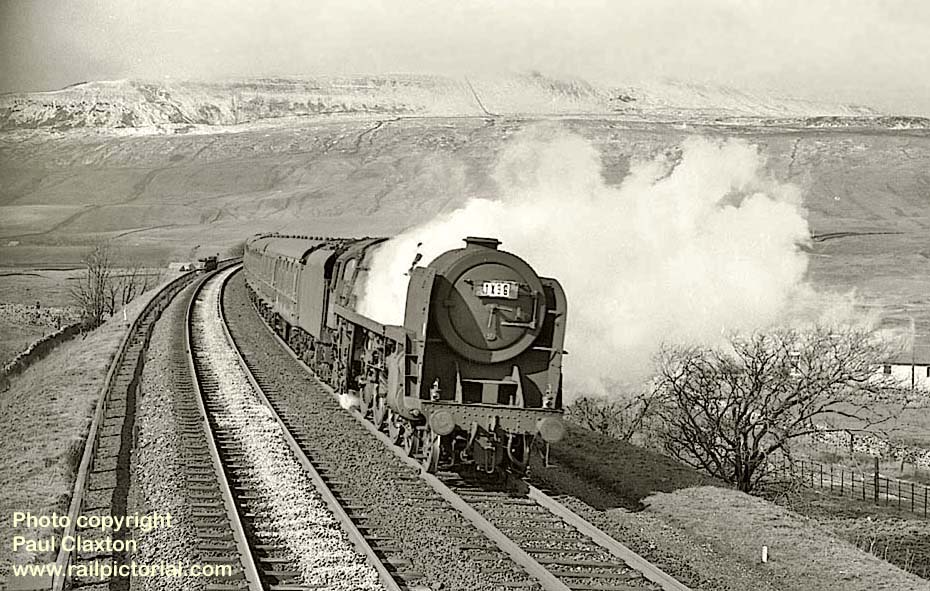
(Above) From the Paul Claxton Collection we have this late image of 7MT Britannia 70053, formerly named Moray Firth, but as with all surviving 35 class members still in service at that time the nameplates had been removed for safekeeping in 1965. The locomotive is pictured coasting downgrade off Ribblehead Viaduct in March 1967 and seems to be suffering from a cracked steampipe between the smokebox and the offside cylinder, but as the engine was in its last month of service, no action would have been taken by the running shed staff at Carlisle Kingmoor. Paul's superb collection of railway photographs can be found on his brother Mike Claxton's website www.railpictorial.com...a visit is highly recommended.
(Inset) A cast brass nameplate for No 70053 went under the hammer at a Railway Auctions UK Ltd sale at Stafford in January 2007. Built at Crewe under order E486 and paired to BRID 4725 gallon tender no 987, No 70053 entered traffic on 3rd September 1954. Shedded at 66A Polmadie,
 55A Leeds Holbeck, then 5A Crewe North, 6J Holyhead, 2B Oxley, 2D Banbury, and 12A Kingmoor. Withdrawn 15th April 1967, stored at Kingmoor until September 1967 and cut up at Shettleston, Glasgow in October 1967. The plate front is restored, back ex-loco condition.
55A Leeds Holbeck, then 5A Crewe North, 6J Holyhead, 2B Oxley, 2D Banbury, and 12A Kingmoor. Withdrawn 15th April 1967, stored at Kingmoor until September 1967 and cut up at Shettleston, Glasgow in October 1967. The plate front is restored, back ex-loco condition.(Below) During the summer of 1965, three Britannias were transferred to the ex-Western Region depot at Wolverhampton Oxley; the shed came under the control of the London Midland Region in January 1963 gaining the code 2B; although principally a freight engine depot, the operating department was required to find locomotives for holiday trains to the West Country. After the shed lost five 'Castle' class engines in February of that year it transpired that 70045, 70047 and 70053 found themselves on Saturday excursions to Kingswear, Paignton and Ilfracombe, but as evidenced by SV Blencowe's image, the external condition of 70053 was setting a bad impression on the holidaymakers.
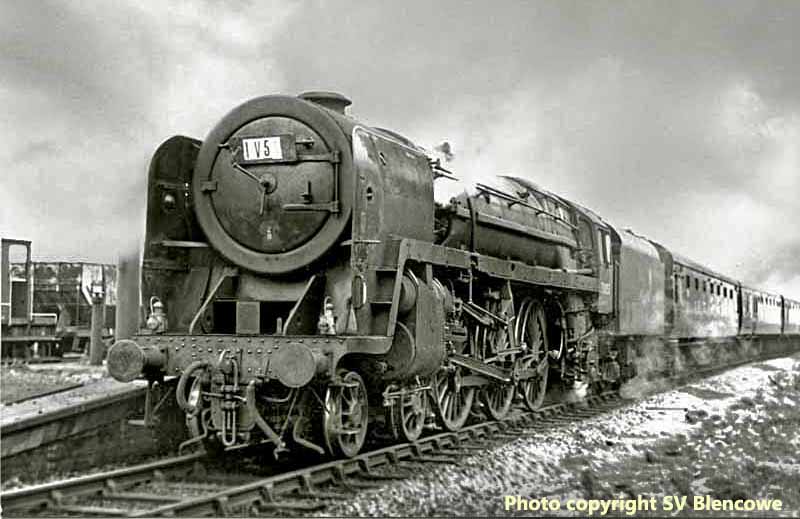
SIGHTINGS: 70053 was first viewed at Crewe Works in September 1954, with speedometer already fitted, but showing no nameplates on the smoke deflectors or a shedcode on the smokebox. The nameplates were soon added and the engine was photographed in very good order and with a full head of steam, ready to move off Polmadie MPD during March 1955 prior to hauling another southbound express.
While allocated to Leeds Holbeck, 70053 was observed in good clean condition departing Scarborough Station with a westbound express in December 1958. The following summer, a rather work-stained engine was seen heading the northbound 'Thames-Clyde Express' at Gargrave Station between Skipton and Hellifield. The next sighting was on the turntable at New England depot in October 1959, and doubtless the ex-works engine would have set pulses running high amongst the local spotters in Peterborough.
However, it was a different story in July 1960, by which time the sorry state of 70053 - begrimed and badly stained, with no semblance of the green livery that was surely there - was recorded passing Dore and Totley Station with the southbound 'Thames-Clyde Express'. Later in July 1963 the engine, having been through Works, was in a very presentable condition at Willesden depot, and it was noticeable that the power warning plates had been added, but certainly not in their usual positions at all.
70053's allocation to Wolverhampton Oxley depot in 1965 was made to give the Western Region more power for their summer Saturday Specials to the West Country resorts, and the locomotive was viewed on various dates with trains to Ilfracombe, Kingswear and Paignton, but the external condition of the engine was far from the standards set long ago by the Western Region depots. After this rush of activity, 70053 was transferred to Banbury MPD for use on semi-fast trains from Nottingham to London Marylebone; the locomotive was pictured there in a very work-stained condition despite having had a recent Works visit.
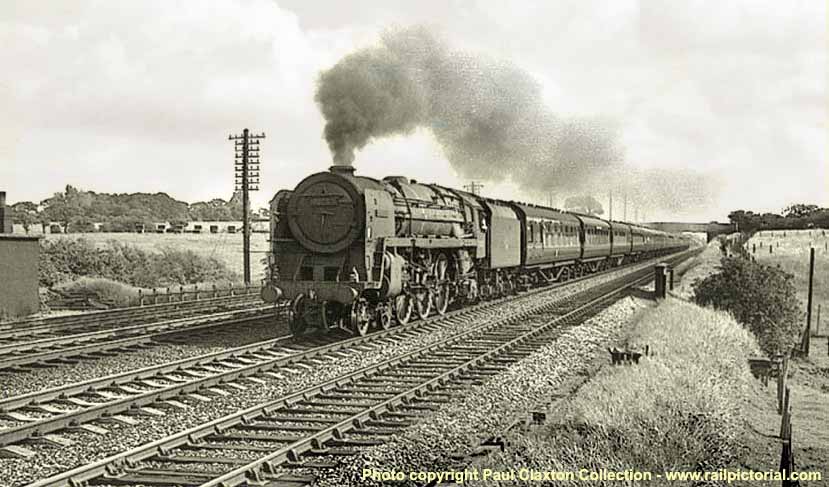
(Above) This scintillating picture is typical of the high standard of railway photographs to be found in the Paul Claxton Collection HERE - Britannia 70053 Moray Firth is captured hauling the down 'Lakes Express' near Broughton, just a few miles north of Preston on 26th July 1963. The train consisting of 13 coaches has four separate portions; five coaches to Windermere, four for Whitehaven, a three-coach portion to Keswick and Workington, with the final carriage going forward to Barrow.
DISPOSAL: 70053 Moray Firth was withdrawn from service on Saturday 15th April 1967, stored at Carlisle Kingmoor yard until 12th September 1967 and then transferred to J.McWilliams of Shettleston, a suburb just over three miles to the east of Glasgow city centre, where it was cut up in October. The company was responsible for the disposal of over 40% of the Britannia class.
Constructed at Crewe, completed on 13th September 1954, just 3 months short of the four years since No 70000 'Britannia' was built, and costing rather more at £25,331. The Order No E486/234 was authorised on 24th November 1951, but construction was delayed due to steel shortages. Withdrawn from Carlisle Kingmoor on 26th November 1966 and disposed of at Motherwell Machinery & Scrap Co, Inslow Works, Wishaw.
ALLOCATIONS: As with all the other 'Firths', 70054's first allotted shed was Glasgow Polmadie (66A) where it spent just over four years. 70054 then moved to Leeds Holbeck MPD (55A) at the start of November 1958, along with 70053 Moray Firth, spending 3 years and nine months there before moving on to Crewe North MPD (5A) in August 1962. When Crewe North closed at the end of May 1965, 70054 was among 26 Britannias
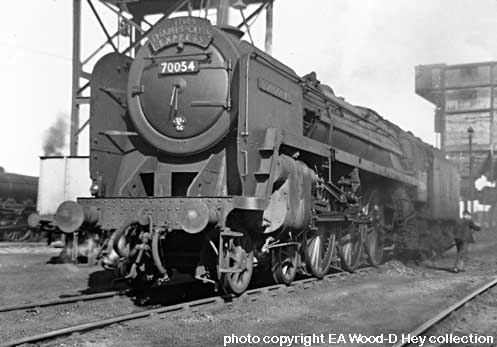 to move the short distance to Crewe South MPD (5B) before being allocated to Banbury MPD (2D) in October 1965. The final move for 'Dornoch Firth' was to Carlisle Kingmoor MPD (12A) at the end of January 1966, but it never saw the year out having succumbed to withdrawal in November.
to move the short distance to Crewe South MPD (5B) before being allocated to Banbury MPD (2D) in October 1965. The final move for 'Dornoch Firth' was to Carlisle Kingmoor MPD (12A) at the end of January 1966, but it never saw the year out having succumbed to withdrawal in November.(Left-Below) This splendid image from EA Wood of 70054 at Holbeck MPD (55A), shows well the large boiler of the Britannias. Having just been coaled, the driver will 'oil round' and the engine will be ready for its next task. Of note, the nearside lubrication drive rod is rather short, and the cover is missing from the exhaust joint above the cylinder. Date would be early 1959. (Below) Following arrival at Leeds Wellington Street station with the southbound 'Thames-Clyde Express' on 8th May 1959, the crew of 70054 Dornoch Firth await signals before backing out of the platform for Holbeck shed. All Anglo-Scottish expresses reversed at the Leeds terminus; in the background a 'Jubilee' class is awaiting the arrival of another train.
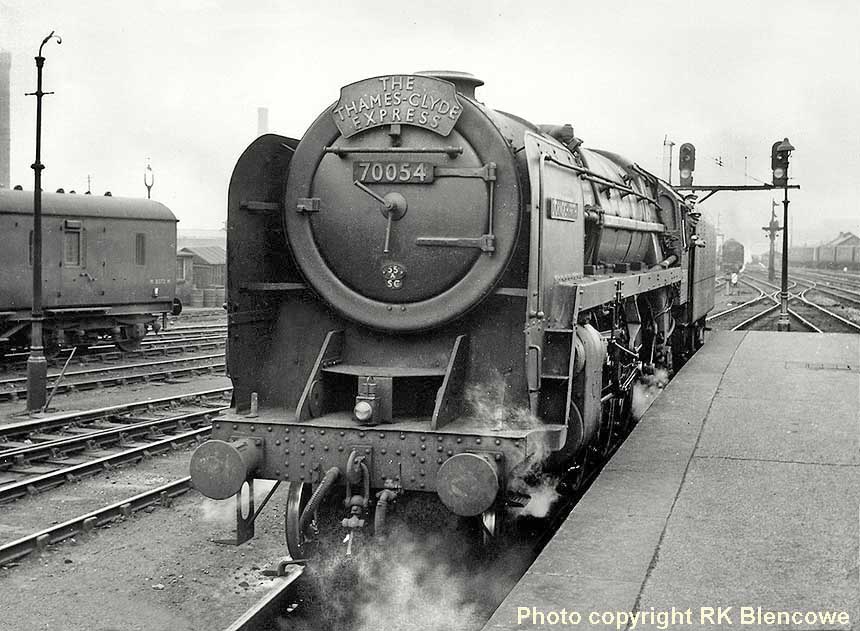
MODIFICATIONS: Because 70054 appeared much later, the lessons learned from the early Britannias were utilised in the third group of engines, also some modifications were 'built in'. Thus the plain coupling rods (item 14) were fitted from new; the Axle repairs (item 17) were built into the construction; the regulator front rod and rear rod support brackets (items 5/7) were added from new; the exhaust ejector (item 4) was not
 altered in any way; also the cab sheet (item 9) was not required with a BR1D tender. The dome cover (item 6) had been corrected from No 70007 onwards; the vacuum pipe (item 21) was modified after No 70018; the reverse rod return spring cover (item 8) was being fitted from 70025 onwards; the tender step (item 10) was not required on the BR1D tender; 3 sand box lids (item 16) were being fitted to newly constructed engines, beginning with No. 70030. The third group of engines; 70045 to 70054 were fitted with a speedometer (item 13) from new, thus leaving us with nine modifications that were made in service. In May 1956, 70054 was modified with a new front step (item 1) and the LNER Return Crank (item 15) was also changed; in August 1959 'Dornoch Firth' was sporting new smoke deflectors (item 3), along with a new British Railways emblem (item 11) on the tender. The next modification was the fitment of the Automatic Warning System (item 20), and its relevant pipework and battery box; this was closely followed by the power warning plates (item 19) which were seen to be 'doubled-up' on the smoke deflectors (see image). The lamp irons (item 2) were repositioned for safety reasons, as seen in the last photo of 70054 at Shrewsbury in 1965, when also the nameplates were removed for safekeeping.
altered in any way; also the cab sheet (item 9) was not required with a BR1D tender. The dome cover (item 6) had been corrected from No 70007 onwards; the vacuum pipe (item 21) was modified after No 70018; the reverse rod return spring cover (item 8) was being fitted from 70025 onwards; the tender step (item 10) was not required on the BR1D tender; 3 sand box lids (item 16) were being fitted to newly constructed engines, beginning with No. 70030. The third group of engines; 70045 to 70054 were fitted with a speedometer (item 13) from new, thus leaving us with nine modifications that were made in service. In May 1956, 70054 was modified with a new front step (item 1) and the LNER Return Crank (item 15) was also changed; in August 1959 'Dornoch Firth' was sporting new smoke deflectors (item 3), along with a new British Railways emblem (item 11) on the tender. The next modification was the fitment of the Automatic Warning System (item 20), and its relevant pipework and battery box; this was closely followed by the power warning plates (item 19) which were seen to be 'doubled-up' on the smoke deflectors (see image). The lamp irons (item 2) were repositioned for safety reasons, as seen in the last photo of 70054 at Shrewsbury in 1965, when also the nameplates were removed for safekeeping. (Below) Seen in somewhat parlous state, 70054 Dornoch Firth heads the 10am Leeds-Glasgow at Sheriff Brow just north of Settle on the 1 in 100 climb to Ais Gill Summit in 1961. Of interest to modellers is the catch point in the foreground; this safety device has a single switch blade (other examples had a full turnout) and this is used to derail any runaways on the downward gradient. Of course, any northbound traffic can pass over the point safely by pushing the switch blades into the appropriate position; then once the wheels have passed the blade is forced back into the derailing position by spring. The hand-operated lever enables permanent way engineers to temporarily override the catch point and allow safe passage for traffic in such cases as single-line working.

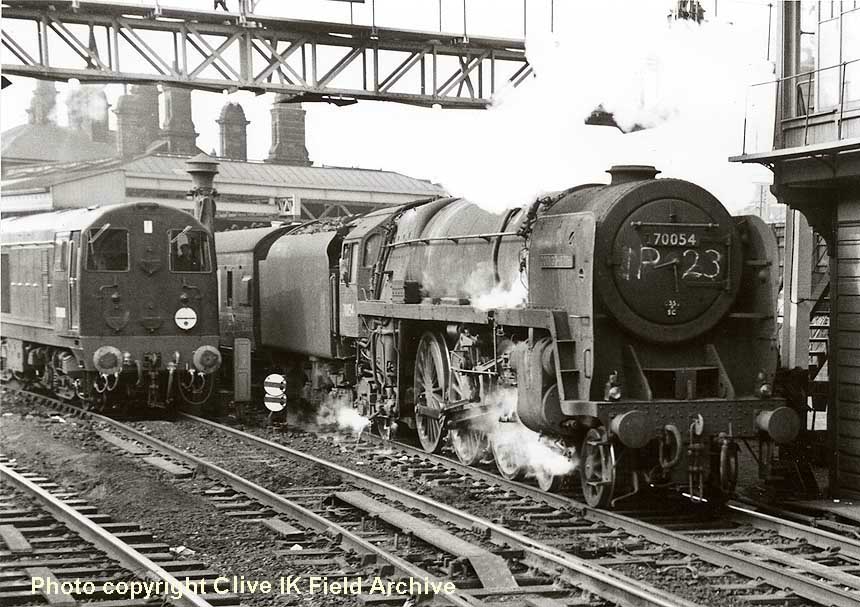
(Above) Seen at Sheffield Midland Station on Wednesday 30th August 1961, 70054 waits for the off with a northbound express. Clive IK Field has chosen the right moment to open the shutter and capture the scene before the engine slowly draws forward past the signal box; the shabby state of the engine belies the power available to the driver.
SERVICE RECORD: Because 70054 was allocated to Glasgow Polmadie, 'Dornoch Firth' was used on express trains to Carlisle via the Glasgow South Western Railway line through Kilmarnock and Dumfries, or on Crewe to Perth trains; also the 'up' 'Royal Scot' to London, and Glasgow to Birmingham expresses. When allocated to Leeds Holbeck MPD (55A), 70054 was used extensively over the Settle and Carlisle route, hauling 'The Thames-Clyde Express' from Leeds City to Glasgow St. Enoch. Because the likes of 70054 did not have extensive diagrams to operate, the Polmadie Britannias did not run up a lot of yearly mileages, but in 1956, 'Dornoch Firth' covered a recorded 55,065 miles, and during 1960 a total of 52,900 miles.
When new 70054 entered St. Rollox Works to have the nameplates fitted, and had, in fact, re-entered Crewe Works when only one day in service, it is recorded to have spent two weeks there for a 'Rectification'. In service 70054 visited Crewe Works a recorded eight times, and Doncaster Works just three times; on one occasion for the repair of a damaged 'Big End' (coupling rod joint) during January 1961. It should be noted that 70054 worked on the Scottish Region; the North Eastern Region; the London Midland Region; the Grand Central; and also did travel over Western Region tracks on a number of occasions.
(Below) Crewe North shed (5A) was a favourite photographic location for the late Jim Carter. Here we have a shot of a very clean 70054 Dornoch Firth, surely taken from the coaling plant stairway, dated 1963. It is worth noting the position of the simplified sand boxes, three fitted from 70030 onwards, instead of two previously.

SIGHTINGS: Pictured in July 1955, 70054 'Dornoch Firth' was seen climbing Beattock Bank in the Southern Uplands of Scotland, hauling a Manchester to Glasgow express service; also viewed, shortly after this date, at rest on Polmadie shed, side-on and showing how much better positioned the newly arranged sand boxes were, giving more direct access to the driving wheels. In 1956, 70054 was captured leaving Edinburgh Princes Street Station with a stopping train to Carstairs via the 'Waverley Line', and having been transferred to Leeds Holbeck for the sole purpose of hauling the 'Thames-Clyde Express'.
Dornoch Firth was seen in May 1959 coasting along with such a train at Skipton, and looking resplendent; similarly when observed at Whitehall Junction, again hauling the 'Thames-Clyde Express' in March 1961. 70054 was captured on film in ex-works condition at Crewe, dated October 1962, so the engine still had the full lined-out livery. Shortly after this 70054 was spotted in sparkling condition powering a Carlisle to London meat train at Yealand in Lancashire, dated November 1962, and showing distinctly the yellow axle covers to the tender and rear bogie, which marked the change to Timken Roller Bearings, using light grease lubrication instead of oil. 'Dornoch Firth' did enter works twice after 1962; once in 1963, including a boiler change; and again in 1965, this for the last time, but the engine would not stay clean for long, the external condition of 70054 deteriorated rapidly; as seen at Willesden MPD in 1965, when the state of the engine was described as 'deplorable'...disposal came at the Motherwell Machinery & Scrap Co's Inslow Works in Wishaw during November the follwing year..
(Below) 70054 Dornoch Firth awaits departure at Shrewsbury Station, before continuing south to Wolverhampton, hauling what I think is 'The Pines Express' which would continue forward via Birmingham Snow Hill to reach Oxford and beyond. The Crewe North engine looks in fine fettle, and has had the lamp irons recently repositioned; the nameplates have been removed for safekeeping. Dated June 1965.
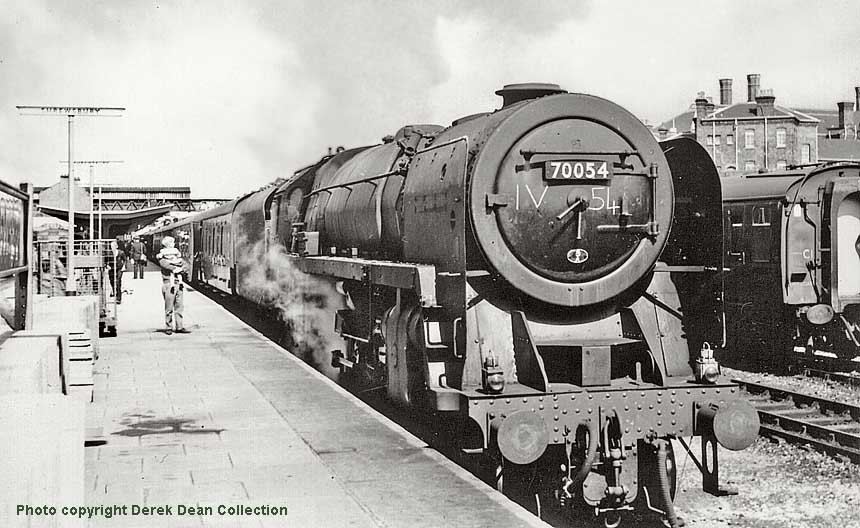
1. FRONT STEP; 2. LAMP IRONS; 3. SMOKE DEFLECTORS; 4. EXHAUST EJECTOR MOD; 5. FRONT REGULATOR ROD SUPPORT BRACKET; 6. DOME COVER; 7. REAR REGULATOR ROD SUPPORT BRACKET; 8. REVERSE ROD RETURN SPRING COVER; 9. CAB SHEET MOD; 10.TENDER STEP; 11.NEW BR TOTEM; 12.LIVERY; 13.SPEEDOMETER; 14.COUPLING RODS; 15.LNER-LMSR RETURN CRANK; 16.SANDBOX LIDS; 17.AXLE; 18.LUBRICATION PUMP OPERATING ROD; 19.POWER WARNING FLASHES; 20.ATC/AWS and 21.VACUUM PIPE.

(Below) In all fairness to 'Rail Camerman' Keith Long, here is the original photo of 'Britannia' Class 7MT No 70004 William Shakespeare at Willesden shed on 16th September 1961. Built at Crewe Works and delivered in March 1951, 70004 was exhibited at the Festival of Britain, then allocated to Stewarts Lane until 1958; she worked the 'Golden Arrow' on a regular basis and continued to carry the fixing bolt holes for the ornamental arrow in her smoke deflectors until early in 1965 when accident damage to the offside smoke deflector meant that a new sheet and stays were fitted at Darlington Works. After leaving the SR she spent time at Trafford Park, Willesden, Crewe North and Stockport until been allocated to her final shed at Kingmoor in 1967. Withdrawn in December 1967 she was scrapped at TW Ward of Inverkeithing in April 1968...check out Keith Long's superb 'Rail Camerman' Page 47 on the left-hand menu.
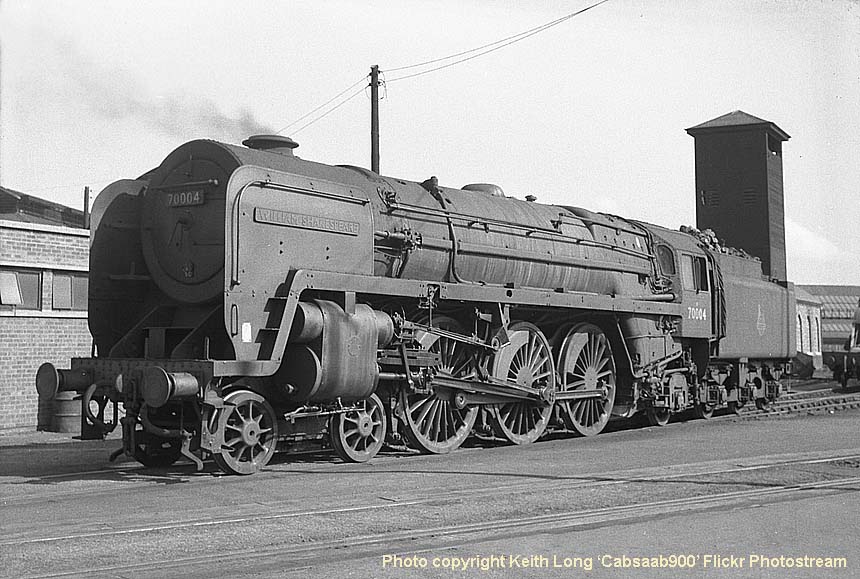
Please note this is not a 'clickable' link via Outlook Express...you will have to email manually.
This page also features photographs supplied by Stewart Blencowe, who has a superb archive of black & white postcard-sized photographs of locomotives from both the pre-Grouping and 'Big Four' eras. Many pictures are from his own negative collection and can only be purchased direct from him, either by visiting his website HERE or via selected railway book fairs, auctions and Open Days…these venues are listed on his website. Stewart has more than forty years of successful trading in all manner of railway items from secondhand books, photos and timetables to ephemera and railway minutia, relics, tape recordings models and miscellania. Postcard size prints can be ordered at £1.50 each including packing and postage.
Stewart's email address is - stewart.blencowe@btopenworld.com - Please note this is not a 'clickable' link via Outlook Express...you will have to email manually..
This page also features a number of BR Class 7 'Britannia' photographs selected from the superb photographic archive of Initial Photographics - the contact address is shown below…
Initial Photographics (C Stacey) 25 The Limes, Stony Stratford, Milton Keynes, MK11 1ET.
The Transport Treasury collection of railway photographs is a privately owned archive of images comprising over 300,000 photographic negatives and transparencies of railway, bus, and tram photographs for publishers and enthusiasts. The company produces traditional photographs, hand-printed in a conventional darkroom. The Transport Treasury's huge archive of high-quality original negatives and slides are entrusted to the company by like-minded railway and transport enthusiasts…to visit the website HERE
Colour-Rail is one of the premier sources of high quality images of road and railway transport, available in a range of formats including online downloads, high quality photographic prints, duplicate slides and in large format pictures for gifts. The Colour-Rail archive contains photos of steam, diesel and electric trains as well as buses, trams and trolleybuses in both colour and black & white, from 1900 to the present day. Click HERE to visit the Colour Rail website containing photographs of stations, signal boxes, tunnels and bridges as well as glimpses of contemporary cars and fashions…a priceless record of times gone by.
The 'Rail Photoprints' photographic archive is of primary interest to railway enthusiasts, but you'll be surprised by what you will find, with some images dating back to 1923 in the files. All photographs are reproduced using modern digital 'wet' production processes on Fuji crystal archive paper. The images are scanned to an image size of A4 (roughly 12ins x 8ins) at 300dpi suitable for both photo and traditional print production. Click HERE to visit the 'Rail Photoprints' website.
Several railway photos on this page were taken by the late Paul Claxton. They are reproduced here courtesy of Mike Claxton, proprietor of www.railpictorial.com. This is a superb site created by Mike in memory of his younger brother Paul, who sadly passed away in April, 2009. I'm sure Paul's photos will connect with everyone and a visit to Mike's site here is highly recommended.
Meanwhile, I continue to seek photos of BR Standard Class 'Britannias' to illustrate this page. All photos published will be treated with the utmost respect and include a copyright notice identifying the owner. If you have suitable photos for this page please contact the email address at the foot of the page.
Great Central Railwayana Auctions....click here.
Railwayana.net.................................click here
Polite notice: All text and photographs are protected by copyright and reproduction is prohibited without the prior consent of the © owners. If you wish to discuss using the contents of this page the email address is below. Please note - this is not a 'clickable' mail-to link via Outlook Express. You will have to email manually.
britclass7@hotmail.co.uk
dheycollection@ntlworld.com
CLICK ON PREVIOUS PAGE FOR AN IN-DEPTH STUDY OF BRITANNIA CLASS Nos 70000-70024




